EX-99.1
Published on June 4, 2021
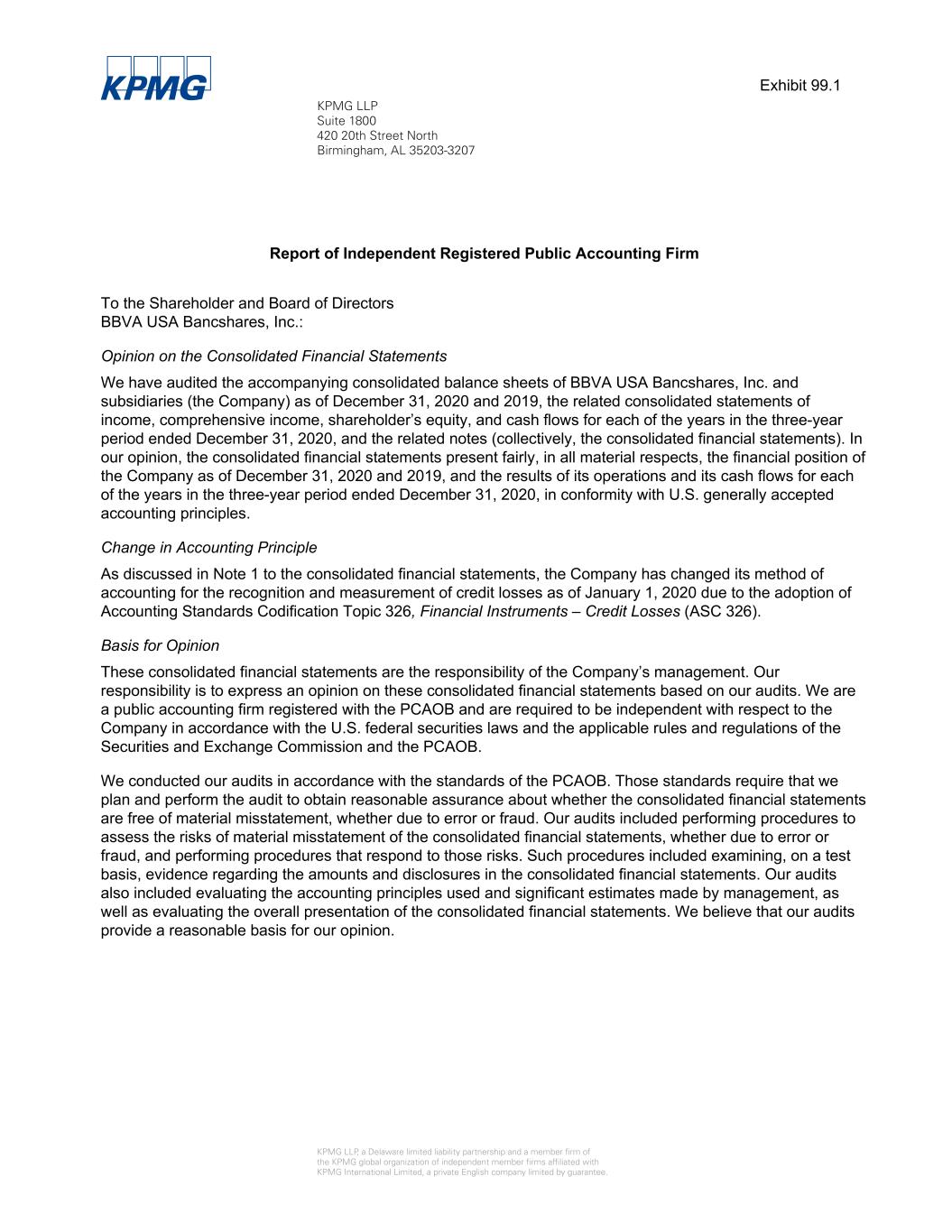
KPMG LLP Suite 1800 420 20th Street North Birmingham, AL 35203-3207 KPMG LLP, a Delaware limited liability partnership and a member firm of the KPMG global organization of independent member firms affiliated with KPMG International Limited, a private English company limited by guarantee. Report of Independent Registered Public Accounting Firm To the Shareholder and Board of Directors BBVA USA Bancshares, Inc.: Opinion on the Consolidated Financial Statements We have audited the accompanying consolidated balance sheets of BBVA USA Bancshares, Inc. and subsidiaries (the Company) as of December 31, 2020 and 2019, the related consolidated statements of income, comprehensive income, shareholder’s equity, and cash flows for each of the years in the three-year period ended December 31, 2020, and the related notes (collectively, the consolidated financial statements). In our opinion, the consolidated financial statements present fairly, in all material respects, the financial position of the Company as of December 31, 2020 and 2019, and the results of its operations and its cash flows for each of the years in the three-year period ended December 31, 2020, in conformity with U.S. generally accepted accounting principles. Change in Accounting Principle As discussed in Note 1 to the consolidated financial statements, the Company has changed its method of accounting for the recognition and measurement of credit losses as of January 1, 2020 due to the adoption of Accounting Standards Codification Topic 326, Financial Instruments – Credit Losses (ASC 326). Basis for Opinion These consolidated financial statements are the responsibility of the Company’s management. Our responsibility is to express an opinion on these consolidated financial statements based on our audits. We are a public accounting firm registered with the PCAOB and are required to be independent with respect to the Company in accordance with the U.S. federal securities laws and the applicable rules and regulations of the Securities and Exchange Commission and the PCAOB. We conducted our audits in accordance with the standards of the PCAOB. Those standards require that we plan and perform the audit to obtain reasonable assurance about whether the consolidated financial statements are free of material misstatement, whether due to error or fraud. Our audits included performing procedures to assess the risks of material misstatement of the consolidated financial statements, whether due to error or fraud, and performing procedures that respond to those risks. Such procedures included examining, on a test basis, evidence regarding the amounts and disclosures in the consolidated financial statements. Our audits also included evaluating the accounting principles used and significant estimates made by management, as well as evaluating the overall presentation of the consolidated financial statements. We believe that our audits provide a reasonable basis for our opinion. Exhibit 99.1
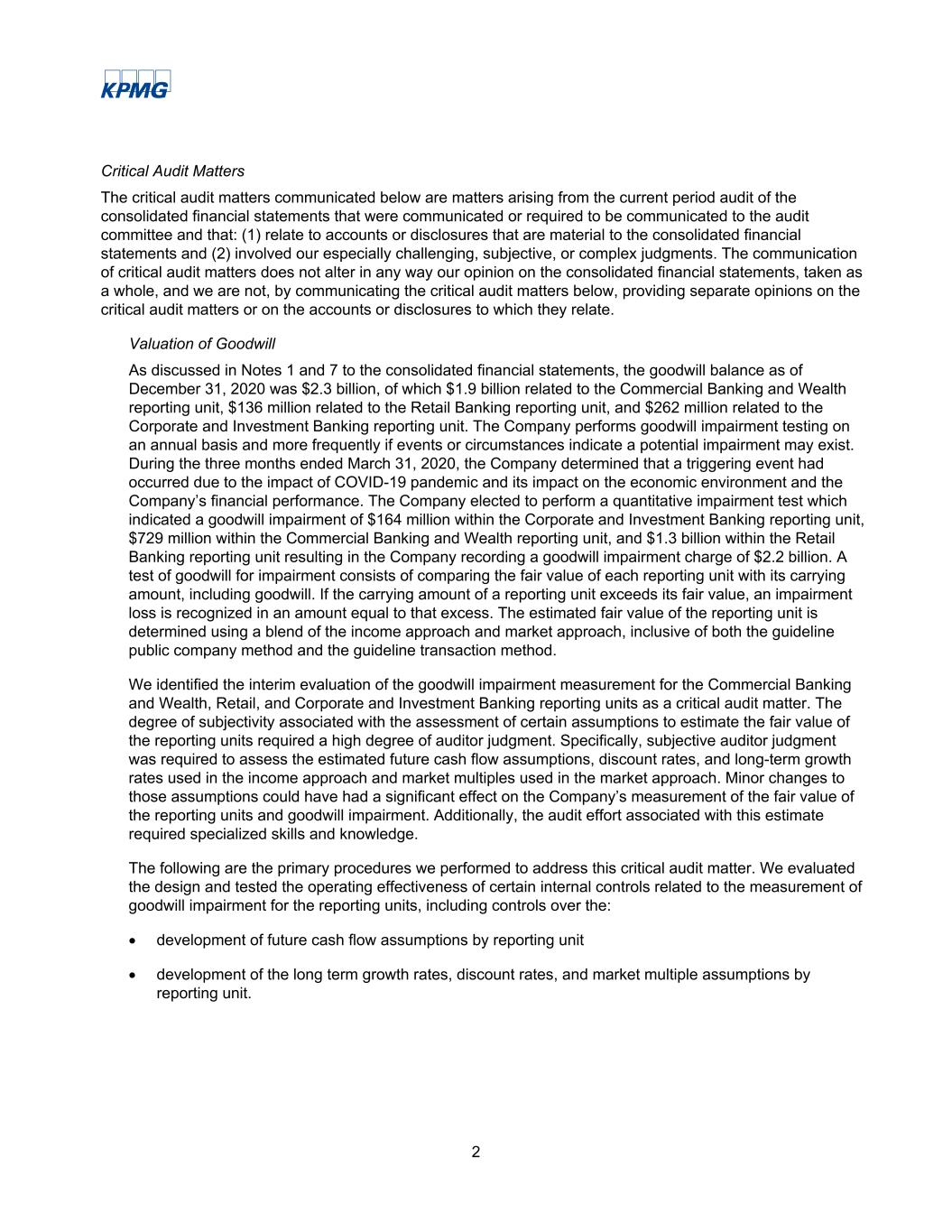
2 Critical Audit Matters The critical audit matters communicated below are matters arising from the current period audit of the consolidated financial statements that were communicated or required to be communicated to the audit committee and that: (1) relate to accounts or disclosures that are material to the consolidated financial statements and (2) involved our especially challenging, subjective, or complex judgments. The communication of critical audit matters does not alter in any way our opinion on the consolidated financial statements, taken as a whole, and we are not, by communicating the critical audit matters below, providing separate opinions on the critical audit matters or on the accounts or disclosures to which they relate. Valuation of Goodwill As discussed in Notes 1 and 7 to the consolidated financial statements, the goodwill balance as of December 31, 2020 was $2.3 billion, of which $1.9 billion related to the Commercial Banking and Wealth reporting unit, $136 million related to the Retail Banking reporting unit, and $262 million related to the Corporate and Investment Banking reporting unit. The Company performs goodwill impairment testing on an annual basis and more frequently if events or circumstances indicate a potential impairment may exist. During the three months ended March 31, 2020, the Company determined that a triggering event had occurred due to the impact of COVID-19 pandemic and its impact on the economic environment and the Company’s financial performance. The Company elected to perform a quantitative impairment test which indicated a goodwill impairment of $164 million within the Corporate and Investment Banking reporting unit, $729 million within the Commercial Banking and Wealth reporting unit, and $1.3 billion within the Retail Banking reporting unit resulting in the Company recording a goodwill impairment charge of $2.2 billion. A test of goodwill for impairment consists of comparing the fair value of each reporting unit with its carrying amount, including goodwill. If the carrying amount of a reporting unit exceeds its fair value, an impairment loss is recognized in an amount equal to that excess. The estimated fair value of the reporting unit is determined using a blend of the income approach and market approach, inclusive of both the guideline public company method and the guideline transaction method. We identified the interim evaluation of the goodwill impairment measurement for the Commercial Banking and Wealth, Retail, and Corporate and Investment Banking reporting units as a critical audit matter. The degree of subjectivity associated with the assessment of certain assumptions to estimate the fair value of the reporting units required a high degree of auditor judgment. Specifically, subjective auditor judgment was required to assess the estimated future cash flow assumptions, discount rates, and long-term growth rates used in the income approach and market multiples used in the market approach. Minor changes to those assumptions could have had a significant effect on the Company’s measurement of the fair value of the reporting units and goodwill impairment. Additionally, the audit effort associated with this estimate required specialized skills and knowledge. The following are the primary procedures we performed to address this critical audit matter. We evaluated the design and tested the operating effectiveness of certain internal controls related to the measurement of goodwill impairment for the reporting units, including controls over the: • development of future cash flow assumptions by reporting unit • development of the long term growth rates, discount rates, and market multiple assumptions by reporting unit.
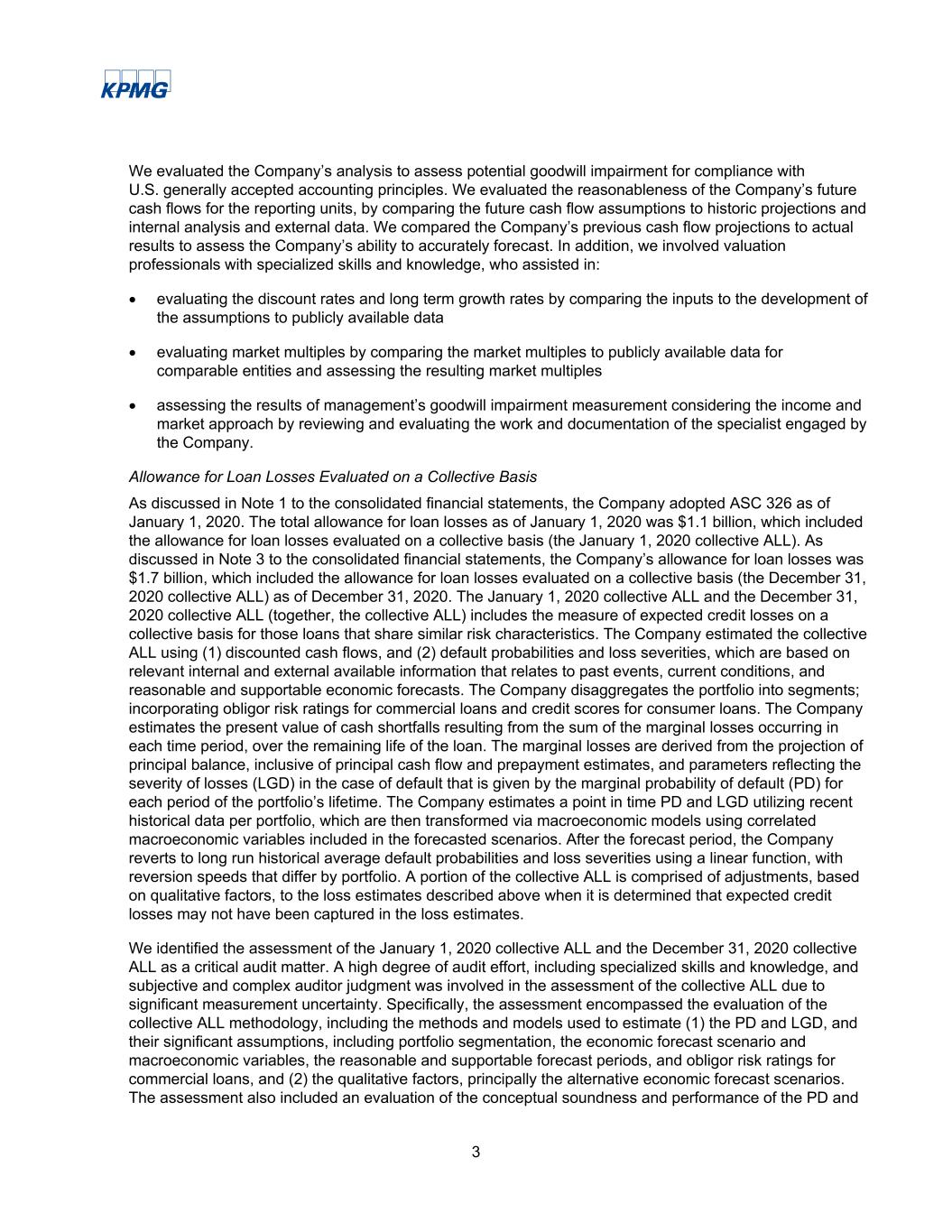
3 We evaluated the Company’s analysis to assess potential goodwill impairment for compliance with U.S. generally accepted accounting principles. We evaluated the reasonableness of the Company’s future cash flows for the reporting units, by comparing the future cash flow assumptions to historic projections and internal analysis and external data. We compared the Company’s previous cash flow projections to actual results to assess the Company’s ability to accurately forecast. In addition, we involved valuation professionals with specialized skills and knowledge, who assisted in: • evaluating the discount rates and long term growth rates by comparing the inputs to the development of the assumptions to publicly available data • evaluating market multiples by comparing the market multiples to publicly available data for comparable entities and assessing the resulting market multiples • assessing the results of management’s goodwill impairment measurement considering the income and market approach by reviewing and evaluating the work and documentation of the specialist engaged by the Company. Allowance for Loan Losses Evaluated on a Collective Basis As discussed in Note 1 to the consolidated financial statements, the Company adopted ASC 326 as of January 1, 2020. The total allowance for loan losses as of January 1, 2020 was $1.1 billion, which included the allowance for loan losses evaluated on a collective basis (the January 1, 2020 collective ALL). As discussed in Note 3 to the consolidated financial statements, the Company’s allowance for loan losses was $1.7 billion, which included the allowance for loan losses evaluated on a collective basis (the December 31, 2020 collective ALL) as of December 31, 2020. The January 1, 2020 collective ALL and the December 31, 2020 collective ALL (together, the collective ALL) includes the measure of expected credit losses on a collective basis for those loans that share similar risk characteristics. The Company estimated the collective ALL using (1) discounted cash flows, and (2) default probabilities and loss severities, which are based on relevant internal and external available information that relates to past events, current conditions, and reasonable and supportable economic forecasts. The Company disaggregates the portfolio into segments; incorporating obligor risk ratings for commercial loans and credit scores for consumer loans. The Company estimates the present value of cash shortfalls resulting from the sum of the marginal losses occurring in each time period, over the remaining life of the loan. The marginal losses are derived from the projection of principal balance, inclusive of principal cash flow and prepayment estimates, and parameters reflecting the severity of losses (LGD) in the case of default that is given by the marginal probability of default (PD) for each period of the portfolio’s lifetime. The Company estimates a point in time PD and LGD utilizing recent historical data per portfolio, which are then transformed via macroeconomic models using correlated macroeconomic variables included in the forecasted scenarios. After the forecast period, the Company reverts to long run historical average default probabilities and loss severities using a linear function, with reversion speeds that differ by portfolio. A portion of the collective ALL is comprised of adjustments, based on qualitative factors, to the loss estimates described above when it is determined that expected credit losses may not have been captured in the loss estimates. We identified the assessment of the January 1, 2020 collective ALL and the December 31, 2020 collective ALL as a critical audit matter. A high degree of audit effort, including specialized skills and knowledge, and subjective and complex auditor judgment was involved in the assessment of the collective ALL due to significant measurement uncertainty. Specifically, the assessment encompassed the evaluation of the collective ALL methodology, including the methods and models used to estimate (1) the PD and LGD, and their significant assumptions, including portfolio segmentation, the economic forecast scenario and macroeconomic variables, the reasonable and supportable forecast periods, and obligor risk ratings for commercial loans, and (2) the qualitative factors, principally the alternative economic forecast scenarios. The assessment also included an evaluation of the conceptual soundness and performance of the PD and
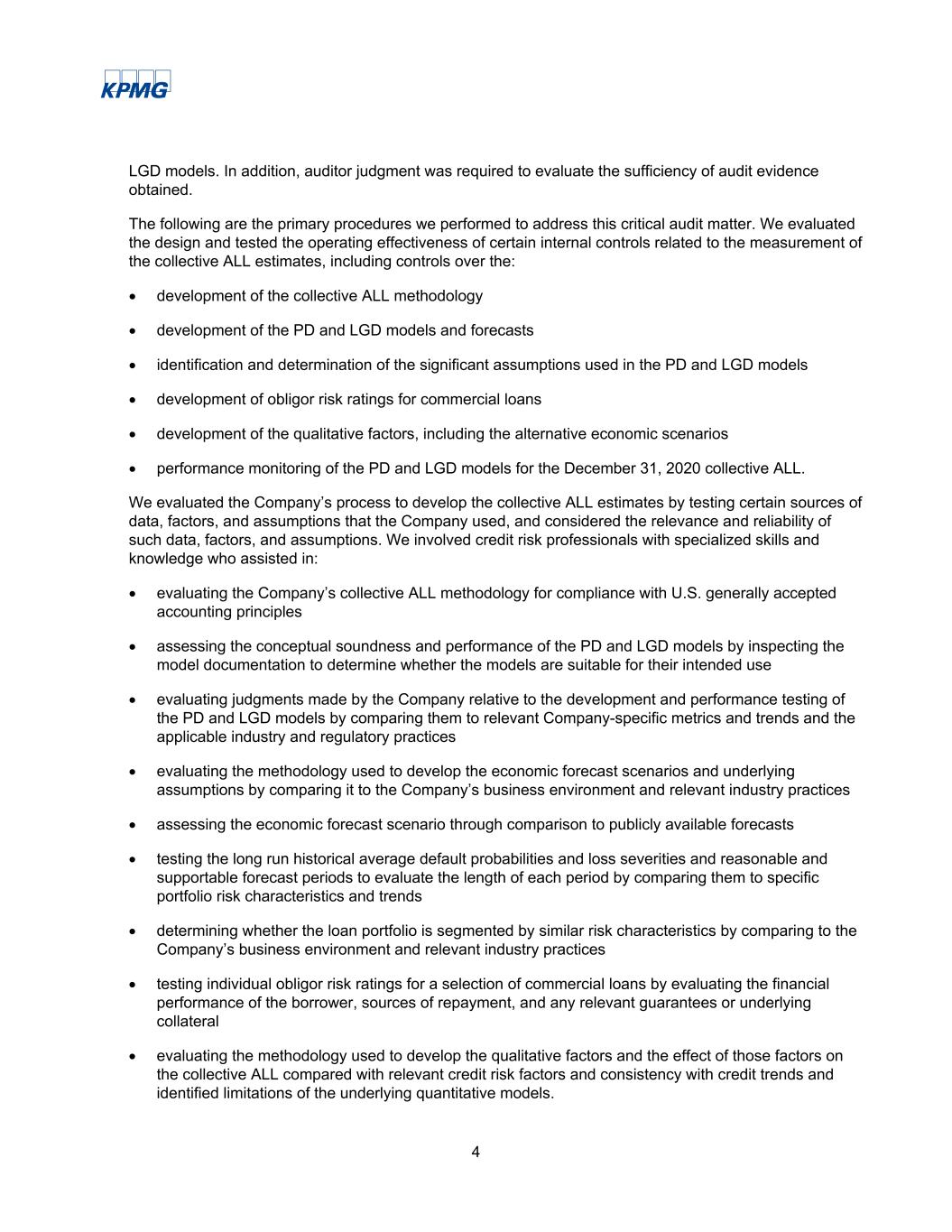
4 LGD models. In addition, auditor judgment was required to evaluate the sufficiency of audit evidence obtained. The following are the primary procedures we performed to address this critical audit matter. We evaluated the design and tested the operating effectiveness of certain internal controls related to the measurement of the collective ALL estimates, including controls over the: • development of the collective ALL methodology • development of the PD and LGD models and forecasts • identification and determination of the significant assumptions used in the PD and LGD models • development of obligor risk ratings for commercial loans • development of the qualitative factors, including the alternative economic scenarios • performance monitoring of the PD and LGD models for the December 31, 2020 collective ALL. We evaluated the Company’s process to develop the collective ALL estimates by testing certain sources of data, factors, and assumptions that the Company used, and considered the relevance and reliability of such data, factors, and assumptions. We involved credit risk professionals with specialized skills and knowledge who assisted in: • evaluating the Company’s collective ALL methodology for compliance with U.S. generally accepted accounting principles • assessing the conceptual soundness and performance of the PD and LGD models by inspecting the model documentation to determine whether the models are suitable for their intended use • evaluating judgments made by the Company relative to the development and performance testing of the PD and LGD models by comparing them to relevant Company-specific metrics and trends and the applicable industry and regulatory practices • evaluating the methodology used to develop the economic forecast scenarios and underlying assumptions by comparing it to the Company’s business environment and relevant industry practices • assessing the economic forecast scenario through comparison to publicly available forecasts • testing the long run historical average default probabilities and loss severities and reasonable and supportable forecast periods to evaluate the length of each period by comparing them to specific portfolio risk characteristics and trends • determining whether the loan portfolio is segmented by similar risk characteristics by comparing to the Company’s business environment and relevant industry practices • testing individual obligor risk ratings for a selection of commercial loans by evaluating the financial performance of the borrower, sources of repayment, and any relevant guarantees or underlying collateral • evaluating the methodology used to develop the qualitative factors and the effect of those factors on the collective ALL compared with relevant credit risk factors and consistency with credit trends and identified limitations of the underlying quantitative models.
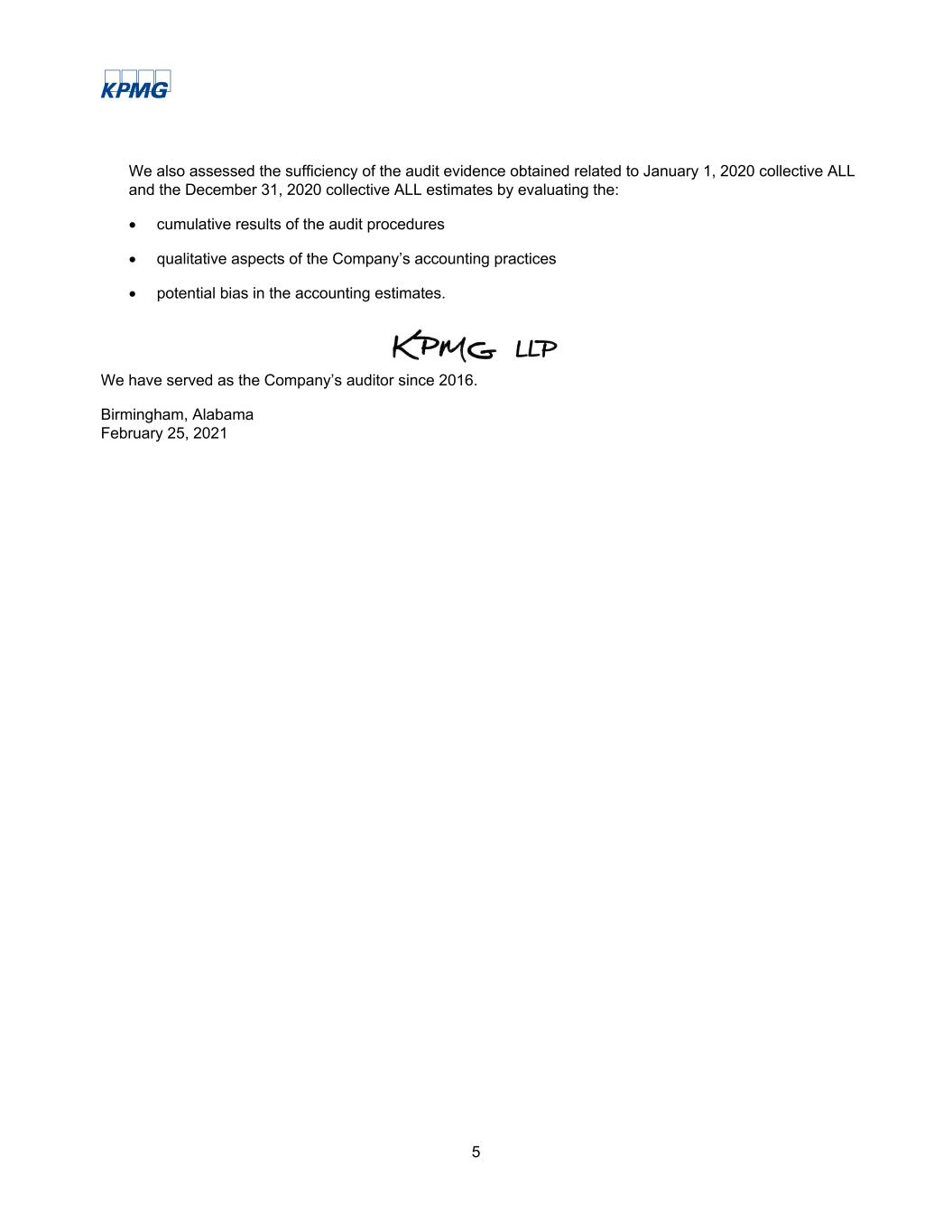
5 We also assessed the sufficiency of the audit evidence obtained related to January 1, 2020 collective ALL and the December 31, 2020 collective ALL estimates by evaluating the: • cumulative results of the audit procedures • qualitative aspects of the Company’s accounting practices • potential bias in the accounting estimates. We have served as the Company’s auditor since 2016. Birmingham, Alabama February 25, 2021
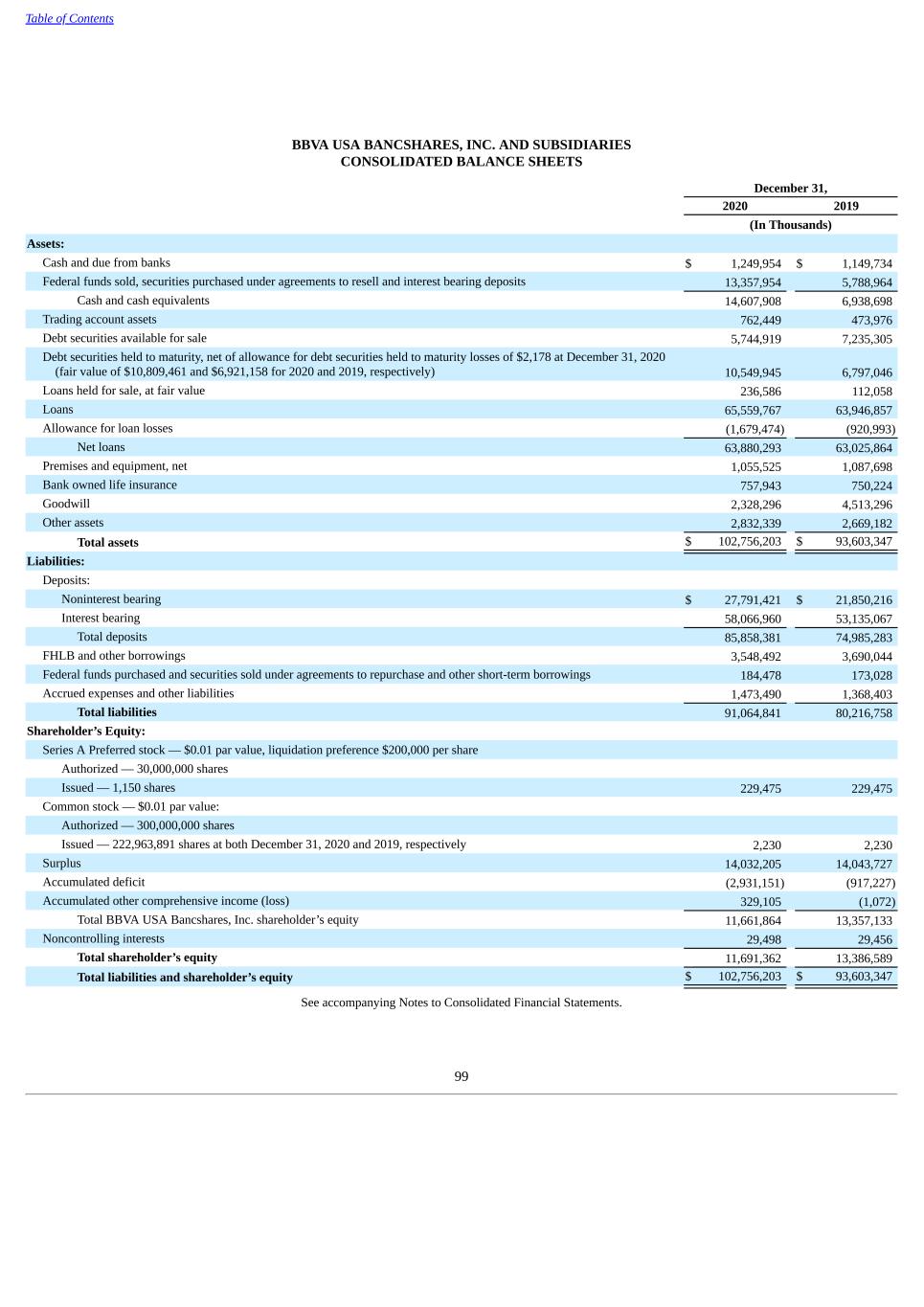
Table of Contents BBVA USA BANCSHARES, INC. AND SUBSIDIARIES CONSOLIDATED BALANCE SHEETS December 31, 2020 2019 (In Thousands) Assets: Cash and due from banks $ 1,249,954 $ 1,149,734 Federal funds sold, securities purchased under agreements to resell and interest bearing deposits 13,357,954 5,788,964 Cash and cash equivalents 14,607,908 6,938,698 Trading account assets 762,449 473,976 Debt securities available for sale 5,744,919 7,235,305 Debt securities held to maturity, net of allowance for debt securities held to maturity losses of $2,178 at December 31, 2020 (fair value of $10,809,461 and $6,921,158 for 2020 and 2019, respectively) 10,549,945 6,797,046 Loans held for sale, at fair value 236,586 112,058 Loans 65,559,767 63,946,857 Allowance for loan losses (1,679,474) (920,993) Net loans 63,880,293 63,025,864 Premises and equipment, net 1,055,525 1,087,698 Bank owned life insurance 757,943 750,224 Goodwill 2,328,296 4,513,296 Other assets 2,832,339 2,669,182 Total assets $ 102,756,203 $ 93,603,347 Liabilities: Deposits: Noninterest bearing $ 27,791,421 $ 21,850,216 Interest bearing 58,066,960 53,135,067 Total deposits 85,858,381 74,985,283 FHLB and other borrowings 3,548,492 3,690,044 Federal funds purchased and securities sold under agreements to repurchase and other short-term borrowings 184,478 173,028 Accrued expenses and other liabilities 1,473,490 1,368,403 Total liabilities 91,064,841 80,216,758 Shareholder’s Equity: Series A Preferred stock — $0.01 par value, liquidation preference $200,000 per share Authorized — 30,000,000 shares Issued — 1,150 shares 229,475 229,475 Common stock — $0.01 par value: Authorized — 300,000,000 shares Issued — 222,963,891 shares at both December 31, 2020 and 2019, respectively 2,230 2,230 Surplus 14,032,205 14,043,727 Accumulated deficit (2,931,151) (917,227) Accumulated other comprehensive income (loss) 329,105 (1,072) Total BBVA USA Bancshares, Inc. shareholder’s equity 11,661,864 13,357,133 Noncontrolling interests 29,498 29,456 Total shareholder’s equity 11,691,362 13,386,589 Total liabilities and shareholder’s equity $ 102,756,203 $ 93,603,347 See accompanying Notes to Consolidated Financial Statements. 99
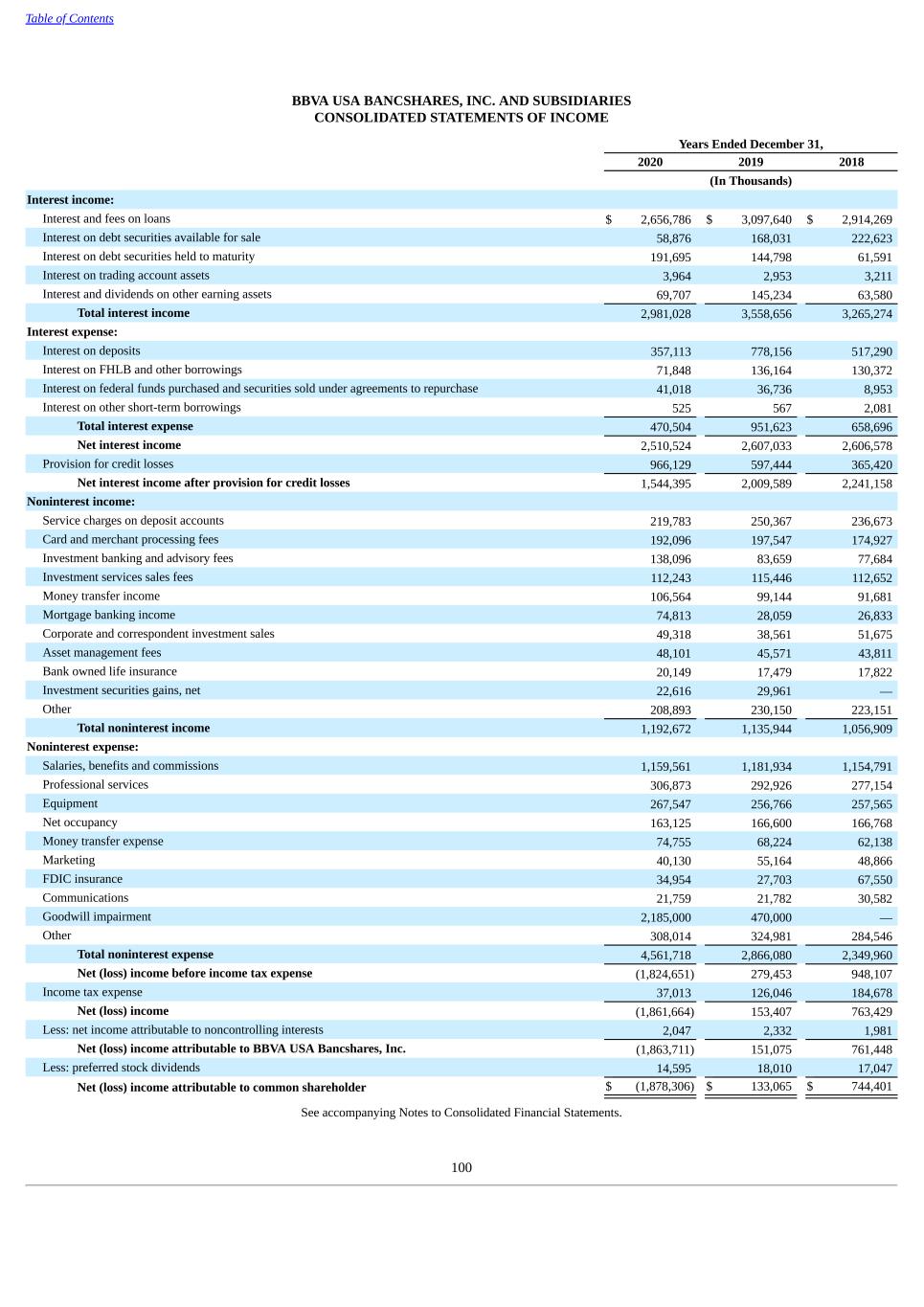
Table of Contents BBVA USA BANCSHARES, INC. AND SUBSIDIARIES CONSOLIDATED STATEMENTS OF INCOME Years Ended December 31, 2020 2019 2018 (In Thousands) Interest income: Interest and fees on loans $ 2,656,786 $ 3,097,640 $ 2,914,269 Interest on debt securities available for sale 58,876 168,031 222,623 Interest on debt securities held to maturity 191,695 144,798 61,591 Interest on trading account assets 3,964 2,953 3,211 Interest and dividends on other earning assets 69,707 145,234 63,580 Total interest income 2,981,028 3,558,656 3,265,274 Interest expense: Interest on deposits 357,113 778,156 517,290 Interest on FHLB and other borrowings 71,848 136,164 130,372 Interest on federal funds purchased and securities sold under agreements to repurchase 41,018 36,736 8,953 Interest on other short-term borrowings 525 567 2,081 Total interest expense 470,504 951,623 658,696 Net interest income 2,510,524 2,607,033 2,606,578 Provision for credit losses 966,129 597,444 365,420 Net interest income after provision for credit losses 1,544,395 2,009,589 2,241,158 Noninterest income: Service charges on deposit accounts 219,783 250,367 236,673 Card and merchant processing fees 192,096 197,547 174,927 Investment banking and advisory fees 138,096 83,659 77,684 Investment services sales fees 112,243 115,446 112,652 Money transfer income 106,564 99,144 91,681 Mortgage banking income 74,813 28,059 26,833 Corporate and correspondent investment sales 49,318 38,561 51,675 Asset management fees 48,101 45,571 43,811 Bank owned life insurance 20,149 17,479 17,822 Investment securities gains, net 22,616 29,961 — Other 208,893 230,150 223,151 Total noninterest income 1,192,672 1,135,944 1,056,909 Noninterest expense: Salaries, benefits and commissions 1,159,561 1,181,934 1,154,791 Professional services 306,873 292,926 277,154 Equipment 267,547 256,766 257,565 Net occupancy 163,125 166,600 166,768 Money transfer expense 74,755 68,224 62,138 Marketing 40,130 55,164 48,866 FDIC insurance 34,954 27,703 67,550 Communications 21,759 21,782 30,582 Goodwill impairment 2,185,000 470,000 — Other 308,014 324,981 284,546 Total noninterest expense 4,561,718 2,866,080 2,349,960 Net (loss) income before income tax expense (1,824,651) 279,453 948,107 Income tax expense 37,013 126,046 184,678 Net (loss) income (1,861,664) 153,407 763,429 Less: net income attributable to noncontrolling interests 2,047 2,332 1,981 Net (loss) income attributable to BBVA USA Bancshares, Inc. (1,863,711) 151,075 761,448 Less: preferred stock dividends 14,595 18,010 17,047 Net (loss) income attributable to common shareholder $ (1,878,306) $ 133,065 $ 744,401 See accompanying Notes to Consolidated Financial Statements. 100
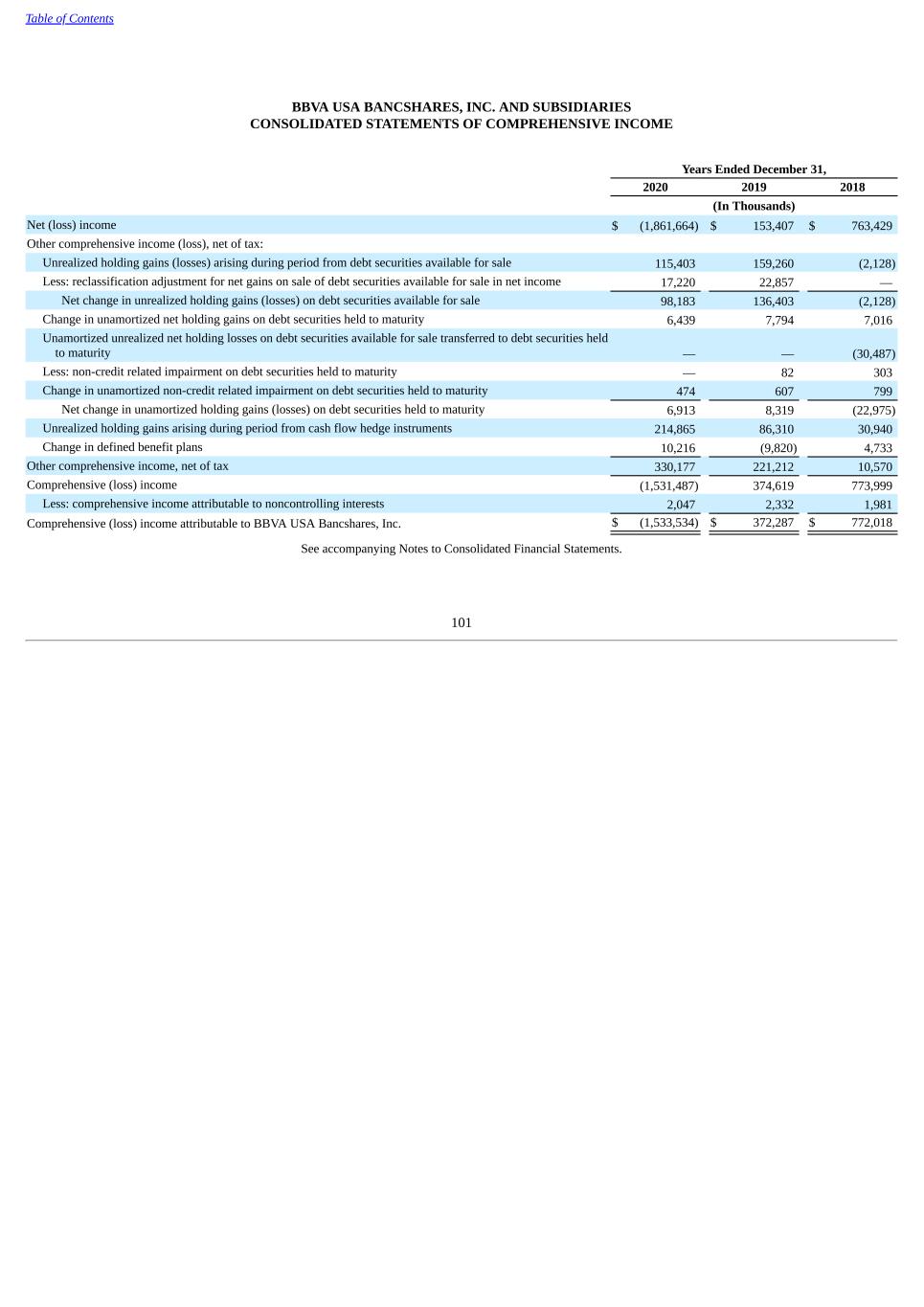
Table of Contents BBVA USA BANCSHARES, INC. AND SUBSIDIARIES CONSOLIDATED STATEMENTS OF COMPREHENSIVE INCOME Years Ended December 31, 2020 2019 2018 (In Thousands) Net (loss) income $ (1,861,664) $ 153,407 $ 763,429 Other comprehensive income (loss), net of tax: Unrealized holding gains (losses) arising during period from debt securities available for sale 115,403 159,260 (2,128) Less: reclassification adjustment for net gains on sale of debt securities available for sale in net income 17,220 22,857 — Net change in unrealized holding gains (losses) on debt securities available for sale 98,183 136,403 (2,128) Change in unamortized net holding gains on debt securities held to maturity 6,439 7,794 7,016 Unamortized unrealized net holding losses on debt securities available for sale transferred to debt securities held to maturity — — (30,487) Less: non-credit related impairment on debt securities held to maturity — 82 303 Change in unamortized non-credit related impairment on debt securities held to maturity 474 607 799 Net change in unamortized holding gains (losses) on debt securities held to maturity 6,913 8,319 (22,975) Unrealized holding gains arising during period from cash flow hedge instruments 214,865 86,310 30,940 Change in defined benefit plans 10,216 (9,820) 4,733 Other comprehensive income, net of tax 330,177 221,212 10,570 Comprehensive (loss) income (1,531,487) 374,619 773,999 Less: comprehensive income attributable to noncontrolling interests 2,047 2,332 1,981 Comprehensive (loss) income attributable to BBVA USA Bancshares, Inc. $ (1,533,534) $ 372,287 $ 772,018 See accompanying Notes to Consolidated Financial Statements. 101
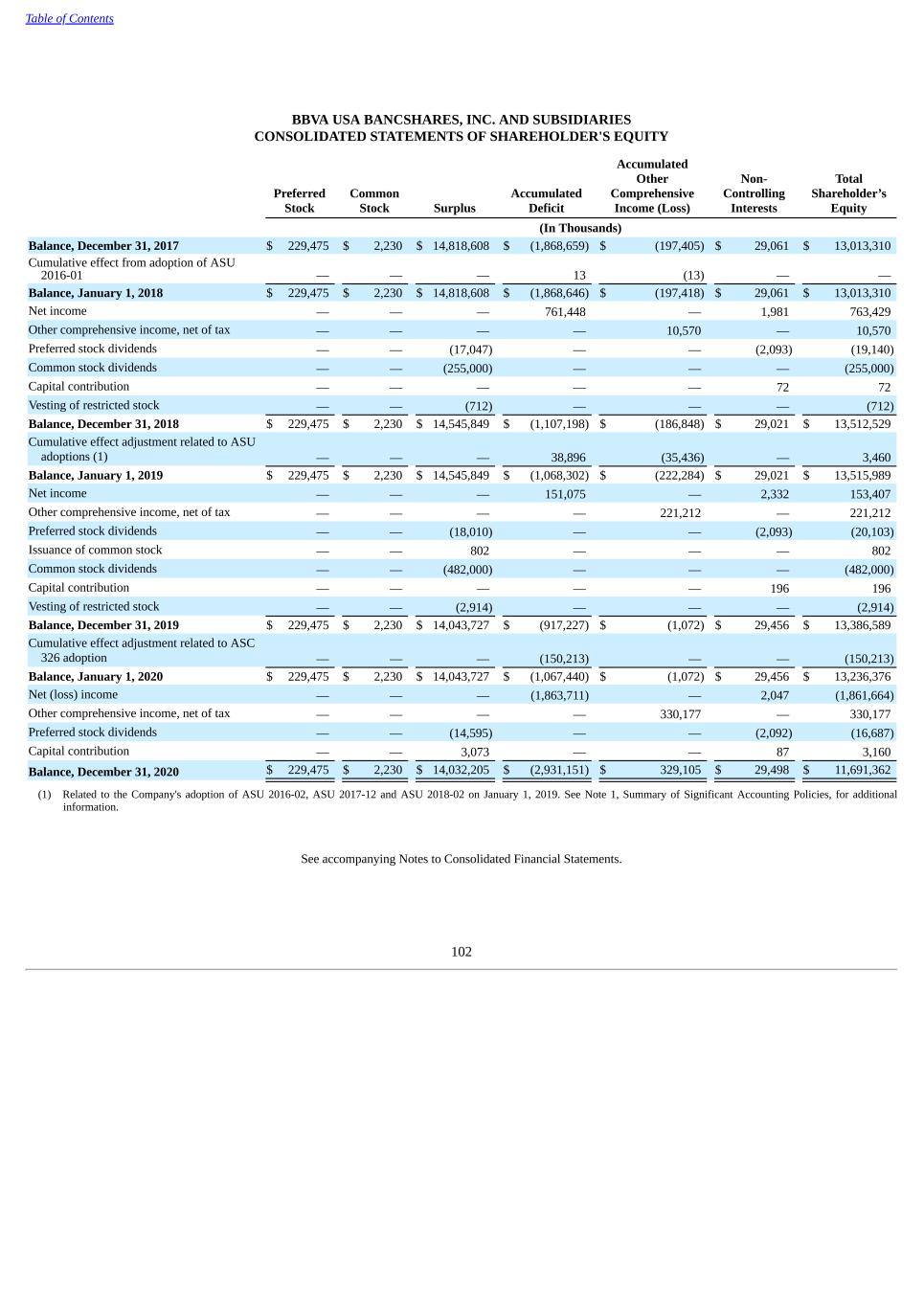
Table of Contents BBVA USA BANCSHARES, INC. AND SUBSIDIARIES CONSOLIDATED STATEMENTS OF SHAREHOLDER'S EQUITY Preferred Stock Common Stock Surplus Accumulated Deficit Accumulated Other Comprehensive Income (Loss) Non- Controlling Interests Total Shareholder’s Equity (In Thousands) Balance, December 31, 2017 $ 229,475 $ 2,230 $ 14,818,608 $ (1,868,659) $ (197,405) $ 29,061 $ 13,013,310 Cumulative effect from adoption of ASU 2016-01 — — — 13 (13) — — Balance, January 1, 2018 $ 229,475 $ 2,230 $ 14,818,608 $ (1,868,646) $ (197,418) $ 29,061 $ 13,013,310 Net income — — — 761,448 — 1,981 763,429 Other comprehensive income, net of tax — — — — 10,570 — 10,570 Preferred stock dividends — — (17,047) — — (2,093) (19,140) Common stock dividends — — (255,000) — — — (255,000) Capital contribution — — — — — 72 72 Vesting of restricted stock — — (712) — — — (712) Balance, December 31, 2018 $ 229,475 $ 2,230 $ 14,545,849 $ (1,107,198) $ (186,848) $ 29,021 $ 13,512,529 Cumulative effect adjustment related to ASU adoptions (1) — — — 38,896 (35,436) — 3,460 Balance, January 1, 2019 $ 229,475 $ 2,230 $ 14,545,849 $ (1,068,302) $ (222,284) $ 29,021 $ 13,515,989 Net income — — — 151,075 — 2,332 153,407 Other comprehensive income, net of tax — — — — 221,212 — 221,212 Preferred stock dividends — — (18,010) — — (2,093) (20,103) Issuance of common stock — — 802 — — — 802 Common stock dividends — — (482,000) — — — (482,000) Capital contribution — — — — — 196 196 Vesting of restricted stock — — (2,914) — — — (2,914) Balance, December 31, 2019 $ 229,475 $ 2,230 $ 14,043,727 $ (917,227) $ (1,072) $ 29,456 $ 13,386,589 Cumulative effect adjustment related to ASC 326 adoption — — — (150,213) — — (150,213) Balance, January 1, 2020 $ 229,475 $ 2,230 $ 14,043,727 $ (1,067,440) $ (1,072) $ 29,456 $ 13,236,376 Net (loss) income — — — (1,863,711) — 2,047 (1,861,664) Other comprehensive income, net of tax — — — — 330,177 — 330,177 Preferred stock dividends — — (14,595) — — (2,092) (16,687) Capital contribution — — 3,073 — — 87 3,160 Balance, December 31, 2020 $ 229,475 $ 2,230 $ 14,032,205 $ (2,931,151) $ 329,105 $ 29,498 $ 11,691,362 (1) Related to the Company's adoption of ASU 2016-02, ASU 2017-12 and ASU 2018-02 on January 1, 2019. See Note 1, Summary of Significant Accounting Policies, for additional information. See accompanying Notes to Consolidated Financial Statements. 102
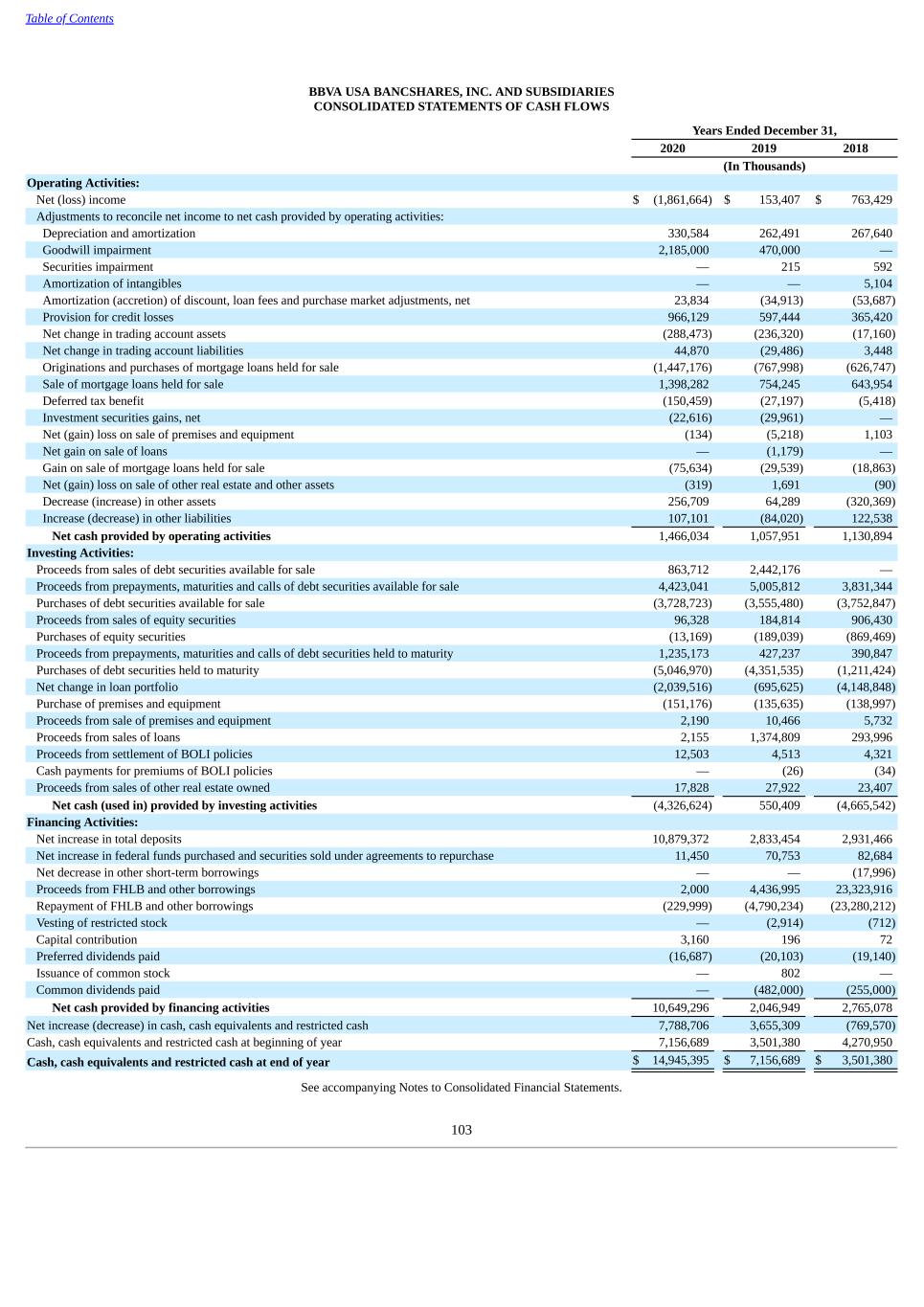
Table of Contents BBVA USA BANCSHARES, INC. AND SUBSIDIARIES CONSOLIDATED STATEMENTS OF CASH FLOWS Years Ended December 31, 2020 2019 2018 (In Thousands) Operating Activities: Net (loss) income $ (1,861,664) $ 153,407 $ 763,429 Adjustments to reconcile net income to net cash provided by operating activities: Depreciation and amortization 330,584 262,491 267,640 Goodwill impairment 2,185,000 470,000 — Securities impairment — 215 592 Amortization of intangibles — — 5,104 Amortization (accretion) of discount, loan fees and purchase market adjustments, net 23,834 (34,913) (53,687) Provision for credit losses 966,129 597,444 365,420 Net change in trading account assets (288,473) (236,320) (17,160) Net change in trading account liabilities 44,870 (29,486) 3,448 Originations and purchases of mortgage loans held for sale (1,447,176) (767,998) (626,747) Sale of mortgage loans held for sale 1,398,282 754,245 643,954 Deferred tax benefit (150,459) (27,197) (5,418) Investment securities gains, net (22,616) (29,961) — Net (gain) loss on sale of premises and equipment (134) (5,218) 1,103 Net gain on sale of loans — (1,179) — Gain on sale of mortgage loans held for sale (75,634) (29,539) (18,863) Net (gain) loss on sale of other real estate and other assets (319) 1,691 (90) Decrease (increase) in other assets 256,709 64,289 (320,369) Increase (decrease) in other liabilities 107,101 (84,020) 122,538 Net cash provided by operating activities 1,466,034 1,057,951 1,130,894 Investing Activities: Proceeds from sales of debt securities available for sale 863,712 2,442,176 — Proceeds from prepayments, maturities and calls of debt securities available for sale 4,423,041 5,005,812 3,831,344 Purchases of debt securities available for sale (3,728,723) (3,555,480) (3,752,847) Proceeds from sales of equity securities 96,328 184,814 906,430 Purchases of equity securities (13,169) (189,039) (869,469) Proceeds from prepayments, maturities and calls of debt securities held to maturity 1,235,173 427,237 390,847 Purchases of debt securities held to maturity (5,046,970) (4,351,535) (1,211,424) Net change in loan portfolio (2,039,516) (695,625) (4,148,848) Purchase of premises and equipment (151,176) (135,635) (138,997) Proceeds from sale of premises and equipment 2,190 10,466 5,732 Proceeds from sales of loans 2,155 1,374,809 293,996 Proceeds from settlement of BOLI policies 12,503 4,513 4,321 Cash payments for premiums of BOLI policies — (26) (34) Proceeds from sales of other real estate owned 17,828 27,922 23,407 Net cash (used in) provided by investing activities (4,326,624) 550,409 (4,665,542) Financing Activities: Net increase in total deposits 10,879,372 2,833,454 2,931,466 Net increase in federal funds purchased and securities sold under agreements to repurchase 11,450 70,753 82,684 Net decrease in other short-term borrowings — — (17,996) Proceeds from FHLB and other borrowings 2,000 4,436,995 23,323,916 Repayment of FHLB and other borrowings (229,999) (4,790,234) (23,280,212) Vesting of restricted stock — (2,914) (712) Capital contribution 3,160 196 72 Preferred dividends paid (16,687) (20,103) (19,140) Issuance of common stock — 802 — Common dividends paid — (482,000) (255,000) Net cash provided by financing activities 10,649,296 2,046,949 2,765,078 Net increase (decrease) in cash, cash equivalents and restricted cash 7,788,706 3,655,309 (769,570) Cash, cash equivalents and restricted cash at beginning of year 7,156,689 3,501,380 4,270,950 Cash, cash equivalents and restricted cash at end of year $ 14,945,395 $ 7,156,689 $ 3,501,380 See accompanying Notes to Consolidated Financial Statements. 103

BBVA USA BANCSHARES, INC. AND SUBSIDIARIES NOTES TO CONSOLIDATED FINANCIAL STATEMENTS (1) Summary of Significant Accounting Policies Nature of Operations BBVA USA Bancshares, Inc., headquartered in Houston, Texas, is a wholly owned subsidiary of BBVA. The Bank, the Company's largest subsidiary, headquartered in Birmingham, Alabama, operates banking centers in Alabama, Arizona, California, Colorado, Florida, New Mexico and Texas. The Bank operates under the brand name BBVA USA, which is a trade name and trademark of BBVA USA Bancshares, Inc. The Bank performs banking services customary for full service banks of similar size and character. Such services include receiving demand and time deposits, making personal and commercial loans and furnishing personal and commercial checking accounts. The Bank offers, either directly or through its subsidiaries and affiliates, a variety of services, including portfolio management and administration and investment services to estates and trusts; term life insurance, variable annuities, property and casualty insurance and other insurance products; investment advisory services; a variety of investment services and products to institutional and individual investors; discount brokerage services, mutual funds and fixed-rate annuities; and lease financing services. Proposed Acquisition by PNC On November 15, 2020, PNC entered into a Stock Purchase Agreement with BBVA for the purchase by PNC of 100% of the issued and outstanding shares of the Company for $11.6 billion in cash on hand in a fixed price structure. PNC is not acquiring BSI, Propel Venture Partners Fund I, L.P. and BBVA Processing Services, Inc. Immediately following the closing of the stock purchase, PNC intends to merge the Parent with and into PNC, with PNC continuing as the surviving entity. Post-closing, PNC intends to merge BBVA USA with and into PNC Bank, National Association, an indirect wholly owned subsidiary of PNC, with PNC Bank continuing as the surviving entity. The transaction is subject to regulatory approvals and certain other customary closing conditions. Basis of Presentation The accompanying Consolidated Financial Statements include the accounts of the Company and its subsidiaries for the years ended December 31, 2020, 2019 and 2018. All intercompany accounts and transactions and balances have been eliminated in consolidation. The Company has evaluated subsequent events through the filing date of this Annual Report on Form 10-K, to determine if either recognition or disclosure of significant events or transactions is required. The accounting policies followed by the Company and its subsidiaries and the methods of applying these policies conform with U.S. GAAP and with practices generally accepted within the banking industry. Certain policies that significantly affect the determination of financial position, results of operations and cash flows are summarized below. Use of Estimates The preparation of the Consolidated Financial Statements in conformity with generally accepted accounting principles in the United States requires management to make estimates and assumptions that affect the reported amounts of assets and liabilities, the disclosure of contingent assets and liabilities at the date of the financial statements and the reported amounts of revenues and expenses during the reporting period, the most significant of which relate to the allowance for loan losses and goodwill impairment. Actual results could differ from those estimates. Correction of Immaterial Accounting Error During the year ended December 31, 2018, income tax expense included $11.4 million of income tax expense related to the correction of an error in prior periods that resulted from an incorrect calculation of the proportional amortization of the Company's Low Income Housing Tax Credit investments. This error primarily related to 2017 and was corrected in the second quarter of 2018. 104
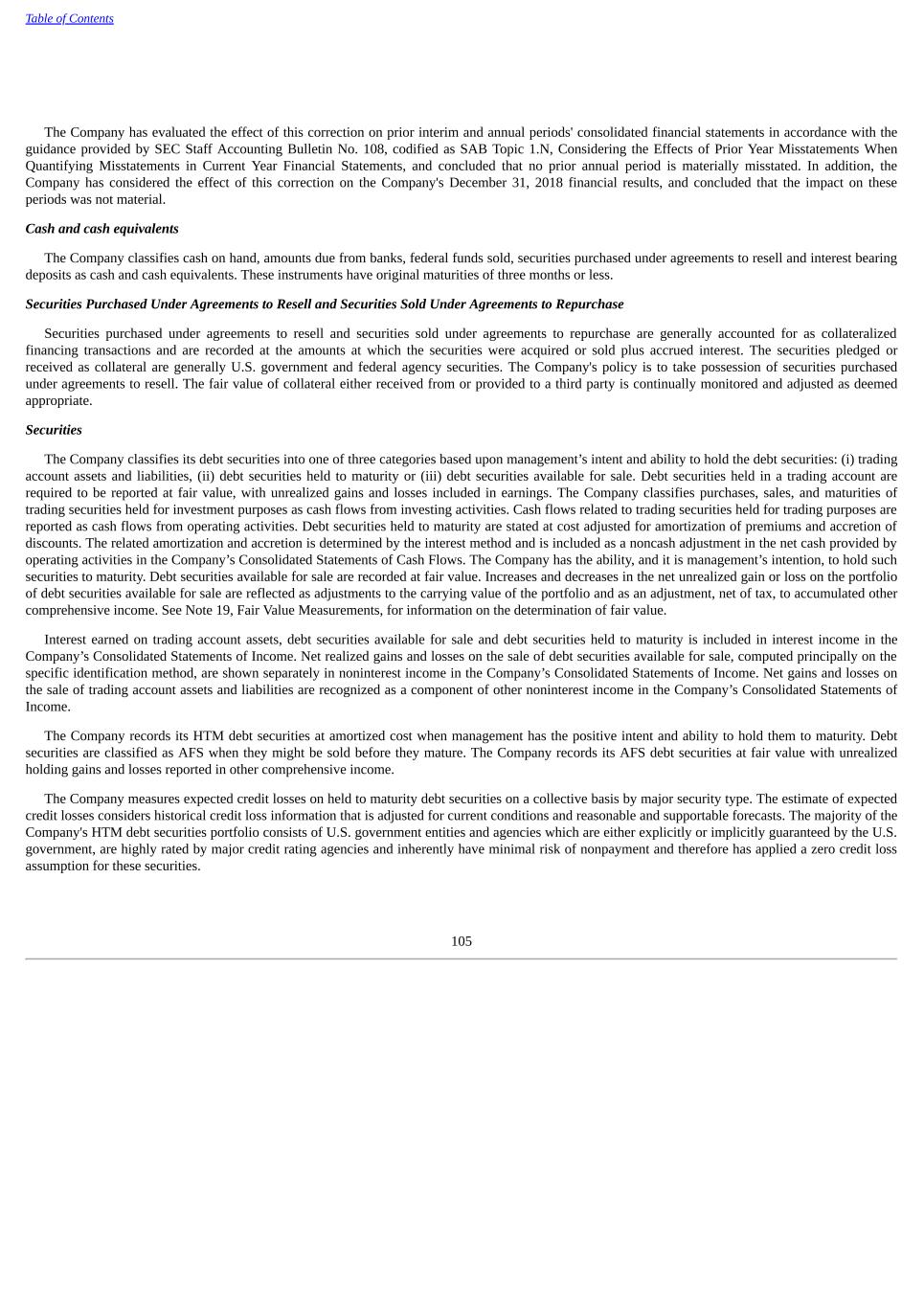
Table of Contents The Company has evaluated the effect of this correction on prior interim and annual periods' consolidated financial statements in accordance with the guidance provided by SEC Staff Accounting Bulletin No. 108, codified as SAB Topic 1.N, Considering the Effects of Prior Year Misstatements When Quantifying Misstatements in Current Year Financial Statements, and concluded that no prior annual period is materially misstated. In addition, the Company has considered the effect of this correction on the Company's December 31, 2018 financial results, and concluded that the impact on these periods was not material. Cash and cash equivalents The Company classifies cash on hand, amounts due from banks, federal funds sold, securities purchased under agreements to resell and interest bearing deposits as cash and cash equivalents. These instruments have original maturities of three months or less. Securities Purchased Under Agreements to Resell and Securities Sold Under Agreements to Repurchase Securities purchased under agreements to resell and securities sold under agreements to repurchase are generally accounted for as collateralized financing transactions and are recorded at the amounts at which the securities were acquired or sold plus accrued interest. The securities pledged or received as collateral are generally U.S. government and federal agency securities. The Company's policy is to take possession of securities purchased under agreements to resell. The fair value of collateral either received from or provided to a third party is continually monitored and adjusted as deemed appropriate. Securities The Company classifies its debt securities into one of three categories based upon management’s intent and ability to hold the debt securities: (i) trading account assets and liabilities, (ii) debt securities held to maturity or (iii) debt securities available for sale. Debt securities held in a trading account are required to be reported at fair value, with unrealized gains and losses included in earnings. The Company classifies purchases, sales, and maturities of trading securities held for investment purposes as cash flows from investing activities. Cash flows related to trading securities held for trading purposes are reported as cash flows from operating activities. Debt securities held to maturity are stated at cost adjusted for amortization of premiums and accretion of discounts. The related amortization and accretion is determined by the interest method and is included as a noncash adjustment in the net cash provided by operating activities in the Company’s Consolidated Statements of Cash Flows. The Company has the ability, and it is management’s intention, to hold such securities to maturity. Debt securities available for sale are recorded at fair value. Increases and decreases in the net unrealized gain or loss on the portfolio of debt securities available for sale are reflected as adjustments to the carrying value of the portfolio and as an adjustment, net of tax, to accumulated other comprehensive income. See Note 19, Fair Value Measurements, for information on the determination of fair value. Interest earned on trading account assets, debt securities available for sale and debt securities held to maturity is included in interest income in the Company’s Consolidated Statements of Income. Net realized gains and losses on the sale of debt securities available for sale, computed principally on the specific identification method, are shown separately in noninterest income in the Company’s Consolidated Statements of Income. Net gains and losses on the sale of trading account assets and liabilities are recognized as a component of other noninterest income in the Company’s Consolidated Statements of Income. The Company records its HTM debt securities at amortized cost when management has the positive intent and ability to hold them to maturity. Debt securities are classified as AFS when they might be sold before they mature. The Company records its AFS debt securities at fair value with unrealized holding gains and losses reported in other comprehensive income. The Company measures expected credit losses on held to maturity debt securities on a collective basis by major security type. The estimate of expected credit losses considers historical credit loss information that is adjusted for current conditions and reasonable and supportable forecasts. The majority of the Company's HTM debt securities portfolio consists of U.S. government entities and agencies which are either explicitly or implicitly guaranteed by the U.S. government, are highly rated by major credit rating agencies and inherently have minimal risk of nonpayment and therefore has applied a zero credit loss assumption for these securities. 105

Table of Contents Under the revised guidance of ASC 326, if the fair value of a security falls below the amortized cost basis, the security will be evaluated to determine if any of the decline in value is attributable to credit losses or other factors. In making this assessment, the Company considers the extent to which fair value is less than amortized cost, any changes to the rating of the security, and adverse conditions specially related to the security, among other factors. If it is determined that a credit loss exists then an allowance for credit losses is recorded for the credit loss, limited by the amount that the fair value is less than the amortized cost basis. If the credit subsequently improves, the allowance is reversed. When the Company intends to sell an impaired AFS debt security or it is more likely than not that the security will be required to be sold prior to recovering the amortized cost basis, the security's amortized cost basis is written down to fair value through income. A debt security is placed on nonaccrual status at the time any principal or interest payments become 90 days delinquent. The Company has elected to not measure an allowance on its accrued interest receivable as a result of the timely reversal of interest receivable deemed uncollectible. Interest accrued but not received for a security placed on nonaccrual is reversed against interest income. Loans Held for Sale Loans held for sale are recorded at either estimated fair value, if the fair value option is elected, or the lower of cost or estimated fair value. The Company applies the fair value option accounting guidance codified under the FASB's ASC Topic 825, Financial Instruments, for single family real estate mortgage loans originated for sale in the secondary market. Under the fair value option, all changes in the applicable loans’ fair value, which includes the value attributable to the servicing of the loan, are recorded in earnings. Loans classified as held for sale that were not originated for resale in the secondary market are accounted for under the lower of cost or fair value method and are evaluated on an individual basis. Loans Loans that management has the intent and ability to hold for the foreseeable future or until maturity or pay-off are considered held-for-investment. Loans are stated at amortized cost, net of the allowance for loan losses. Amortized cost, or the recorded investment, is the principal balance outstanding, adjusted for charge-offs, deferred loan fees and direct costs on originated loans and unamortized premiums or discounts on purchased loans. Accrued interest receivable is reported in other assets on the Company’s Consolidated Balance Sheets. Interest income is accrued on the principal balance outstanding and is recognized on the interest method. Loan fees, net of direct costs and unamortized premiums and discounts are deferred and amortized as an adjustment to the yield of the related loan over the term of the loan and are included as a noncash adjustment in the net cash provided by operating activities in the Company’s Consolidated Statement of Cash Flows. The Company has elected to not measure an allowance on its accrued interest receivable as a result of the timely reversal of interest receivable deemed uncollectible. It is the general policy of the Company to stop accruing interest income and apply subsequent interest payments as principal reductions when any commercial, industrial, commercial real estate or construction loan is 90 days or more past due as to principal or interest and/or the ultimate collection of either is in doubt, unless collection of both principal and interest is assured by way of collateralization, guarantees or other security. Accrual of interest income on consumer loans, including residential real estate loans, is generally suspended when any payment of principal or interest is more than 90 days delinquent or when foreclosure proceedings have been initiated or repossession of the underlying collateral has occurred. When a loan is placed on a nonaccrual status, any interest previously accrued but not collected is reversed against current interest income unless the fair value of the collateral for the loan is sufficient to cover the accrued interest. In general, a loan is returned to accrual status when none of its principal and interest is due and unpaid and the Company expects repayments of the remaining contractual principal and interest or when it is determined to be well secured and in the process of collection. Charge-offs on commercial loans are recognized when available information confirms that some or all of the balance is uncollectible. Consumer loans are subject to mandatory charge-off at a specified delinquency date consistent with regulatory guidelines. In general, charge-offs on consumer loans are recognized at the earlier of the month of liquidation or the month the loan becomes 120 days past due; residential loan deficiencies are charged off in the month the loan becomes 180 days past due; and credit card loans are charged off before the end of the month when the loan becomes 180 days past due with the related interest 106
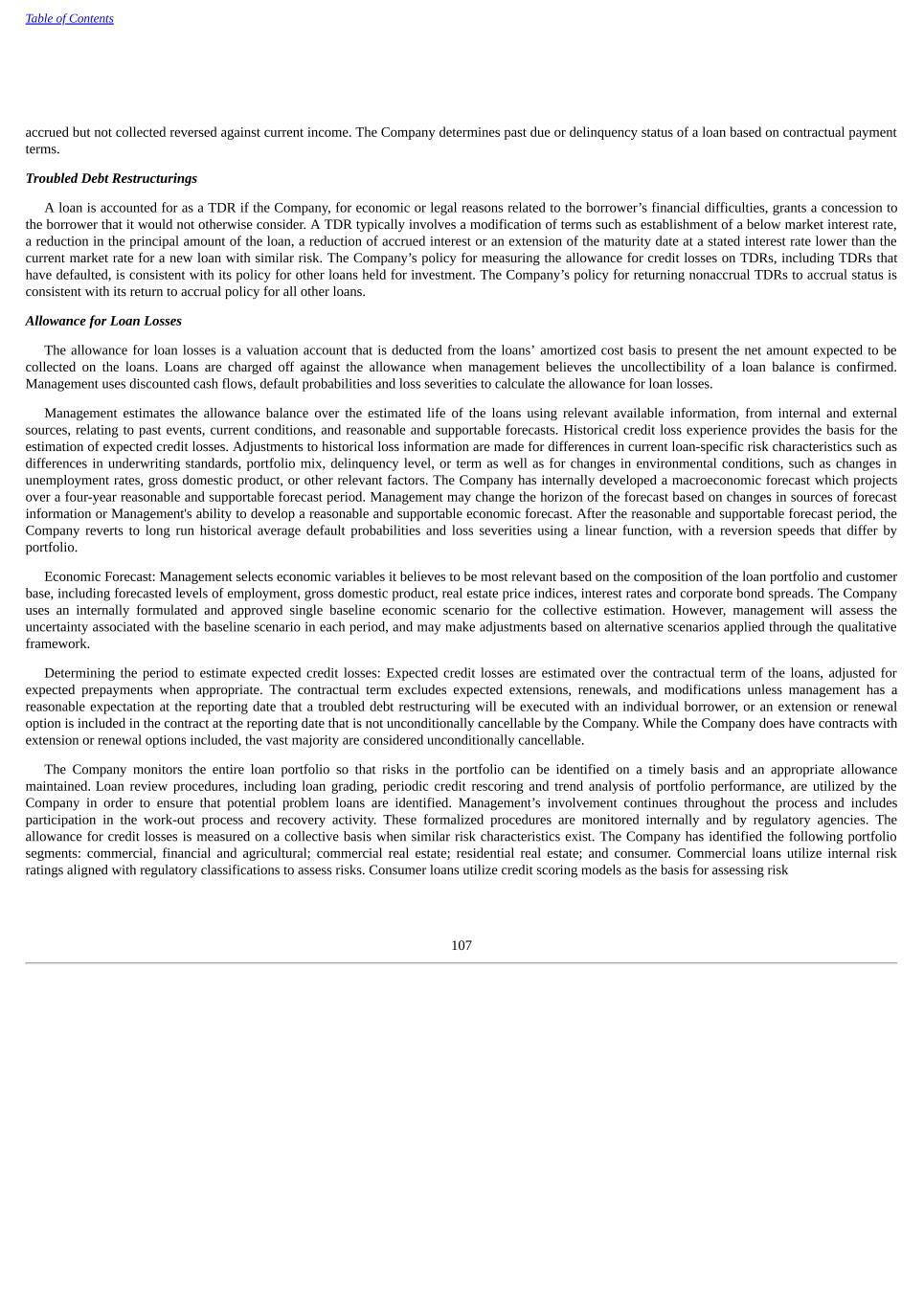
Table of Contents accrued but not collected reversed against current income. The Company determines past due or delinquency status of a loan based on contractual payment terms. Troubled Debt Restructurings A loan is accounted for as a TDR if the Company, for economic or legal reasons related to the borrower’s financial difficulties, grants a concession to the borrower that it would not otherwise consider. A TDR typically involves a modification of terms such as establishment of a below market interest rate, a reduction in the principal amount of the loan, a reduction of accrued interest or an extension of the maturity date at a stated interest rate lower than the current market rate for a new loan with similar risk. The Company’s policy for measuring the allowance for credit losses on TDRs, including TDRs that have defaulted, is consistent with its policy for other loans held for investment. The Company’s policy for returning nonaccrual TDRs to accrual status is consistent with its return to accrual policy for all other loans. Allowance for Loan Losses The allowance for loan losses is a valuation account that is deducted from the loans’ amortized cost basis to present the net amount expected to be collected on the loans. Loans are charged off against the allowance when management believes the uncollectibility of a loan balance is confirmed. Management uses discounted cash flows, default probabilities and loss severities to calculate the allowance for loan losses. Management estimates the allowance balance over the estimated life of the loans using relevant available information, from internal and external sources, relating to past events, current conditions, and reasonable and supportable forecasts. Historical credit loss experience provides the basis for the estimation of expected credit losses. Adjustments to historical loss information are made for differences in current loan-specific risk characteristics such as differences in underwriting standards, portfolio mix, delinquency level, or term as well as for changes in environmental conditions, such as changes in unemployment rates, gross domestic product, or other relevant factors. The Company has internally developed a macroeconomic forecast which projects over a four-year reasonable and supportable forecast period. Management may change the horizon of the forecast based on changes in sources of forecast information or Management's ability to develop a reasonable and supportable economic forecast. After the reasonable and supportable forecast period, the Company reverts to long run historical average default probabilities and loss severities using a linear function, with a reversion speeds that differ by portfolio. Economic Forecast: Management selects economic variables it believes to be most relevant based on the composition of the loan portfolio and customer base, including forecasted levels of employment, gross domestic product, real estate price indices, interest rates and corporate bond spreads. The Company uses an internally formulated and approved single baseline economic scenario for the collective estimation. However, management will assess the uncertainty associated with the baseline scenario in each period, and may make adjustments based on alternative scenarios applied through the qualitative framework. Determining the period to estimate expected credit losses: Expected credit losses are estimated over the contractual term of the loans, adjusted for expected prepayments when appropriate. The contractual term excludes expected extensions, renewals, and modifications unless management has a reasonable expectation at the reporting date that a troubled debt restructuring will be executed with an individual borrower, or an extension or renewal option is included in the contract at the reporting date that is not unconditionally cancellable by the Company. While the Company does have contracts with extension or renewal options included, the vast majority are considered unconditionally cancellable. The Company monitors the entire loan portfolio so that risks in the portfolio can be identified on a timely basis and an appropriate allowance maintained. Loan review procedures, including loan grading, periodic credit rescoring and trend analysis of portfolio performance, are utilized by the Company in order to ensure that potential problem loans are identified. Management’s involvement continues throughout the process and includes participation in the work-out process and recovery activity. These formalized procedures are monitored internally and by regulatory agencies. The allowance for credit losses is measured on a collective basis when similar risk characteristics exist. The Company has identified the following portfolio segments: commercial, financial and agricultural; commercial real estate; residential real estate; and consumer. Commercial loans utilize internal risk ratings aligned with regulatory classifications to assess risks. Consumer loans utilize credit scoring models as the basis for assessing risk 107
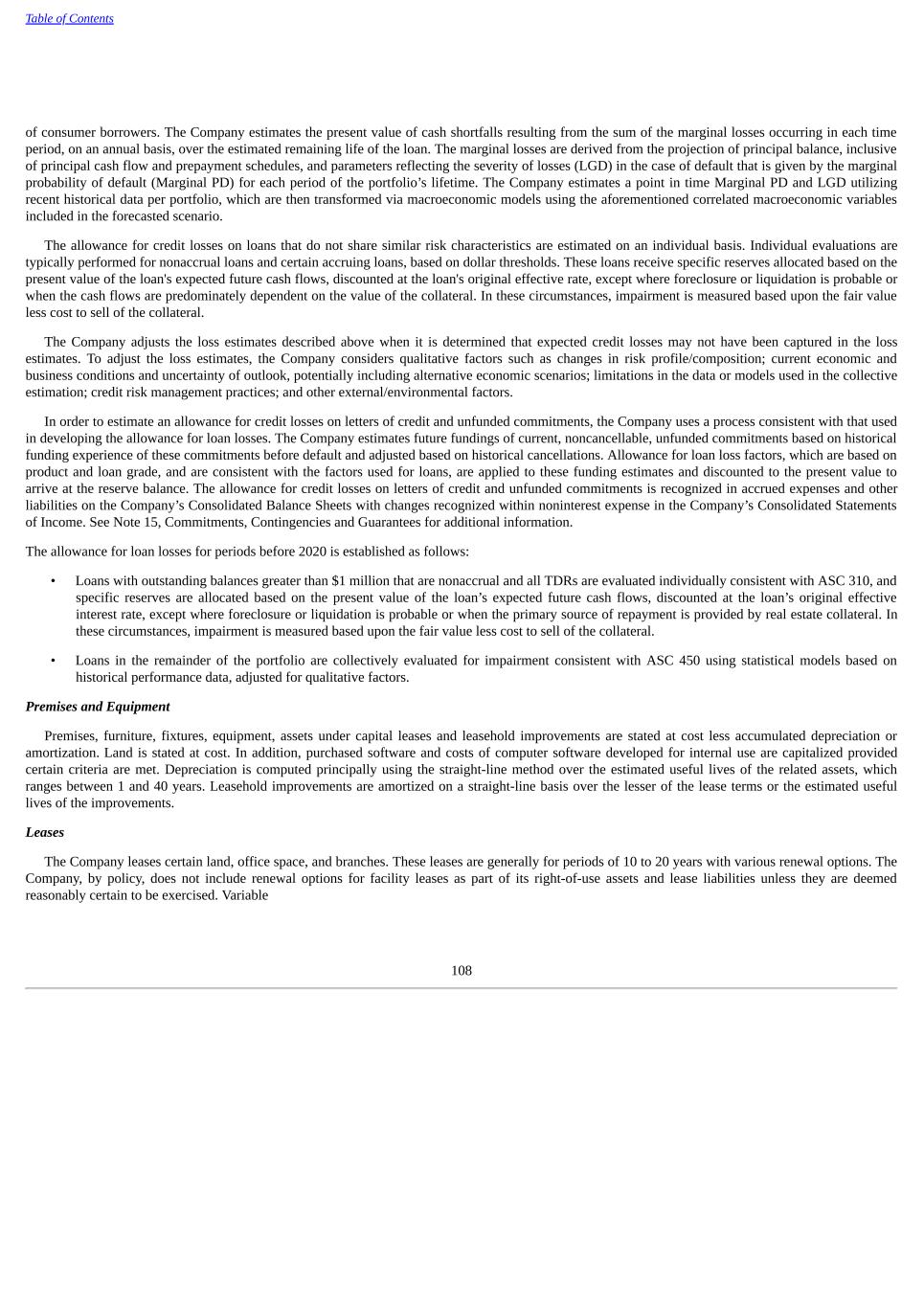
Table of Contents of consumer borrowers. The Company estimates the present value of cash shortfalls resulting from the sum of the marginal losses occurring in each time period, on an annual basis, over the estimated remaining life of the loan. The marginal losses are derived from the projection of principal balance, inclusive of principal cash flow and prepayment schedules, and parameters reflecting the severity of losses (LGD) in the case of default that is given by the marginal probability of default (Marginal PD) for each period of the portfolio’s lifetime. The Company estimates a point in time Marginal PD and LGD utilizing recent historical data per portfolio, which are then transformed via macroeconomic models using the aforementioned correlated macroeconomic variables included in the forecasted scenario. The allowance for credit losses on loans that do not share similar risk characteristics are estimated on an individual basis. Individual evaluations are typically performed for nonaccrual loans and certain accruing loans, based on dollar thresholds. These loans receive specific reserves allocated based on the present value of the loan's expected future cash flows, discounted at the loan's original effective rate, except where foreclosure or liquidation is probable or when the cash flows are predominately dependent on the value of the collateral. In these circumstances, impairment is measured based upon the fair value less cost to sell of the collateral. The Company adjusts the loss estimates described above when it is determined that expected credit losses may not have been captured in the loss estimates. To adjust the loss estimates, the Company considers qualitative factors such as changes in risk profile/composition; current economic and business conditions and uncertainty of outlook, potentially including alternative economic scenarios; limitations in the data or models used in the collective estimation; credit risk management practices; and other external/environmental factors. In order to estimate an allowance for credit losses on letters of credit and unfunded commitments, the Company uses a process consistent with that used in developing the allowance for loan losses. The Company estimates future fundings of current, noncancellable, unfunded commitments based on historical funding experience of these commitments before default and adjusted based on historical cancellations. Allowance for loan loss factors, which are based on product and loan grade, and are consistent with the factors used for loans, are applied to these funding estimates and discounted to the present value to arrive at the reserve balance. The allowance for credit losses on letters of credit and unfunded commitments is recognized in accrued expenses and other liabilities on the Company’s Consolidated Balance Sheets with changes recognized within noninterest expense in the Company’s Consolidated Statements of Income. See Note 15, Commitments, Contingencies and Guarantees for additional information. The allowance for loan losses for periods before 2020 is established as follows: • Loans with outstanding balances greater than $1 million that are nonaccrual and all TDRs are evaluated individually consistent with ASC 310, and specific reserves are allocated based on the present value of the loan’s expected future cash flows, discounted at the loan’s original effective interest rate, except where foreclosure or liquidation is probable or when the primary source of repayment is provided by real estate collateral. In these circumstances, impairment is measured based upon the fair value less cost to sell of the collateral. • Loans in the remainder of the portfolio are collectively evaluated for impairment consistent with ASC 450 using statistical models based on historical performance data, adjusted for qualitative factors. Premises and Equipment Premises, furniture, fixtures, equipment, assets under capital leases and leasehold improvements are stated at cost less accumulated depreciation or amortization. Land is stated at cost. In addition, purchased software and costs of computer software developed for internal use are capitalized provided certain criteria are met. Depreciation is computed principally using the straight-line method over the estimated useful lives of the related assets, which ranges between 1 and 40 years. Leasehold improvements are amortized on a straight-line basis over the lesser of the lease terms or the estimated useful lives of the improvements. Leases The Company leases certain land, office space, and branches. These leases are generally for periods of 10 to 20 years with various renewal options. The Company, by policy, does not include renewal options for facility leases as part of its right-of-use assets and lease liabilities unless they are deemed reasonably certain to be exercised. Variable 108
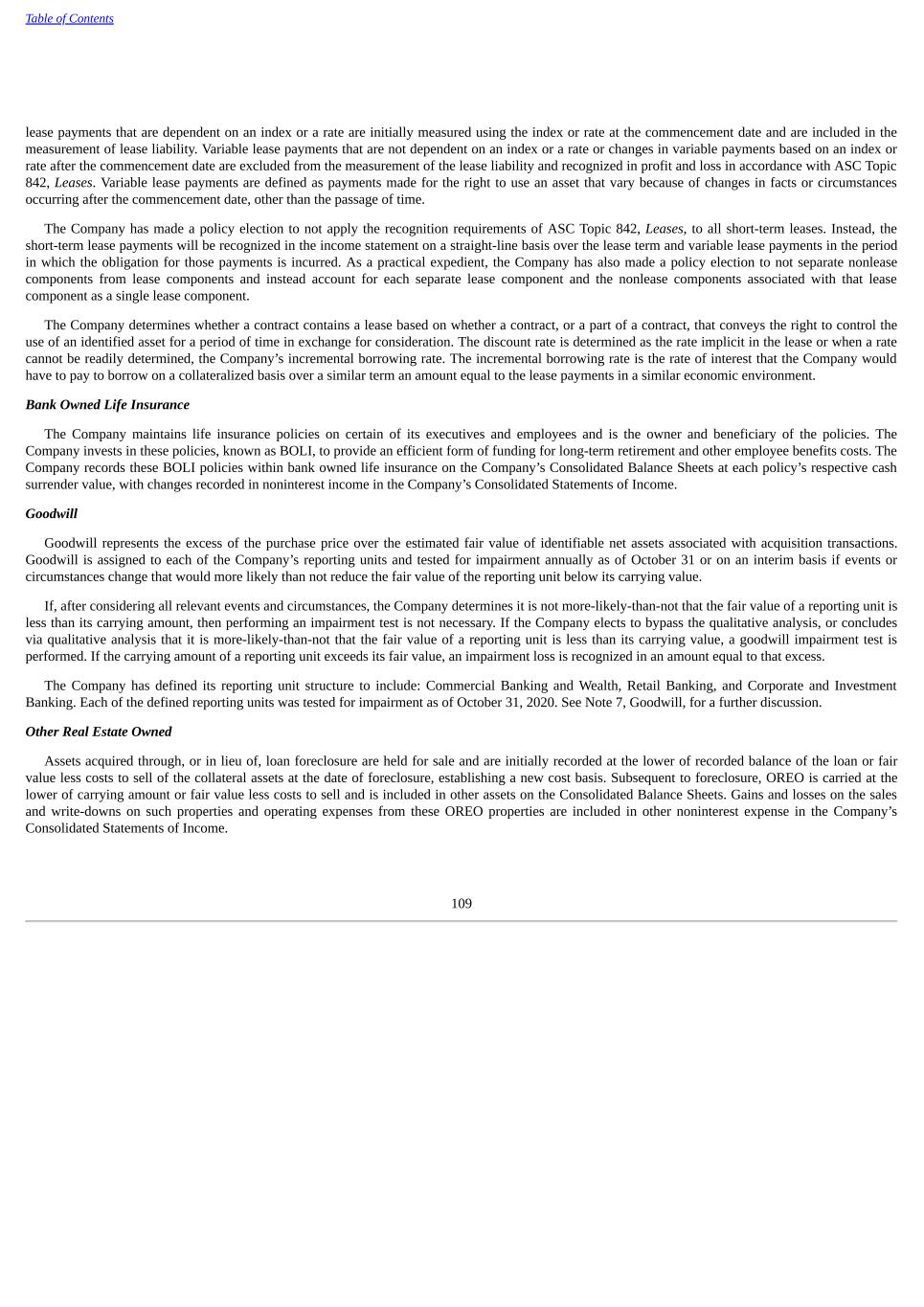
Table of Contents lease payments that are dependent on an index or a rate are initially measured using the index or rate at the commencement date and are included in the measurement of lease liability. Variable lease payments that are not dependent on an index or a rate or changes in variable payments based on an index or rate after the commencement date are excluded from the measurement of the lease liability and recognized in profit and loss in accordance with ASC Topic 842, Leases. Variable lease payments are defined as payments made for the right to use an asset that vary because of changes in facts or circumstances occurring after the commencement date, other than the passage of time. The Company has made a policy election to not apply the recognition requirements of ASC Topic 842, Leases, to all short-term leases. Instead, the short-term lease payments will be recognized in the income statement on a straight-line basis over the lease term and variable lease payments in the period in which the obligation for those payments is incurred. As a practical expedient, the Company has also made a policy election to not separate nonlease components from lease components and instead account for each separate lease component and the nonlease components associated with that lease component as a single lease component. The Company determines whether a contract contains a lease based on whether a contract, or a part of a contract, that conveys the right to control the use of an identified asset for a period of time in exchange for consideration. The discount rate is determined as the rate implicit in the lease or when a rate cannot be readily determined, the Company’s incremental borrowing rate. The incremental borrowing rate is the rate of interest that the Company would have to pay to borrow on a collateralized basis over a similar term an amount equal to the lease payments in a similar economic environment. Bank Owned Life Insurance The Company maintains life insurance policies on certain of its executives and employees and is the owner and beneficiary of the policies. The Company invests in these policies, known as BOLI, to provide an efficient form of funding for long-term retirement and other employee benefits costs. The Company records these BOLI policies within bank owned life insurance on the Company’s Consolidated Balance Sheets at each policy’s respective cash surrender value, with changes recorded in noninterest income in the Company’s Consolidated Statements of Income. Goodwill Goodwill represents the excess of the purchase price over the estimated fair value of identifiable net assets associated with acquisition transactions. Goodwill is assigned to each of the Company’s reporting units and tested for impairment annually as of October 31 or on an interim basis if events or circumstances change that would more likely than not reduce the fair value of the reporting unit below its carrying value. If, after considering all relevant events and circumstances, the Company determines it is not more-likely-than-not that the fair value of a reporting unit is less than its carrying amount, then performing an impairment test is not necessary. If the Company elects to bypass the qualitative analysis, or concludes via qualitative analysis that it is more-likely-than-not that the fair value of a reporting unit is less than its carrying value, a goodwill impairment test is performed. If the carrying amount of a reporting unit exceeds its fair value, an impairment loss is recognized in an amount equal to that excess. The Company has defined its reporting unit structure to include: Commercial Banking and Wealth, Retail Banking, and Corporate and Investment Banking. Each of the defined reporting units was tested for impairment as of October 31, 2020. See Note 7, Goodwill, for a further discussion. Other Real Estate Owned Assets acquired through, or in lieu of, loan foreclosure are held for sale and are initially recorded at the lower of recorded balance of the loan or fair value less costs to sell of the collateral assets at the date of foreclosure, establishing a new cost basis. Subsequent to foreclosure, OREO is carried at the lower of carrying amount or fair value less costs to sell and is included in other assets on the Consolidated Balance Sheets. Gains and losses on the sales and write-downs on such properties and operating expenses from these OREO properties are included in other noninterest expense in the Company’s Consolidated Statements of Income. 109

Table of Contents Accounting for Transfers and Servicing of Financial Assets The Company accounts for transfers of financial assets as sales when control over the transferred assets is surrendered. Control is generally considered to have been surrendered when (1) the transferred assets are legally isolated from the Company, even in bankruptcy or other receivership, (2) the transferee has the right to pledge or exchange the assets with no conditions that constrain the transferee and provide more than a trivial benefit to the Company, and (3) the Company does not maintain the obligation or unilateral ability to reclaim or repurchase the assets. If these sale criteria are met, the transferred assets are removed from the Company's balance sheet and a gain or loss on sale is recognized. If not met, the transfer is recorded as a secured borrowing, and the assets remain on the Company's balance sheet, the proceeds from the transaction are recognized as a liability, and gain or loss on sale is deferred until the sale criterion are achieved. The Company has one primary class of MSR related to residential real estate mortgages. These mortgage servicing rights are recorded in other assets on the Consolidated Balance Sheets at fair value with changes in fair value recorded as a component of mortgage banking income in the Company’s Consolidated Statements of Income. See Note 4, Loan Sales and Servicing, for a further discussion. Revenue from Contracts with Customers The following is a discussion of key revenues within the scope of ASC 606, Revenue from Contracts with Customers: • Service charges on deposit accounts - Revenue from service charges on deposit accounts is earned through cash management, wire transfer, and other deposit-related services; as well as overdraft, non-sufficient funds, account management and other deposit-related fees. Revenue is recognized for these services either over time, corresponding with deposit accounts’ monthly cycle, or at a point in time for transactional related services and fees. • Card and merchant processing fees - Card and merchant processing fees consists of interchange fees from consumer credit and debit cards processed by card association networks, merchant services, and other card related services. Interchange rates are generally set by the credit card associations and based on purchase volumes and other factors. Interchange fees are recognized as transactions occur. Merchant services income represents account management fees and transaction fees charged to merchants for the processing of card association transactions. Merchant services revenue is recognized as transactions occur, or as services are performed. • Investment banking and advisory fees - Investment banking and advisory fees primarily represent revenues earned by the Company for various corporate services including advisory, debt placement and underwriting. Revenues for these services are recorded at a point in time or upon completion of a contractually identified transaction. Underwriting costs are presented gross against underwriting revenues. • Money transfer income - Money transfer income represents income from the Parent’s wholly owned subsidiary, BBVA Transfer Holdings, Inc., which engages in money transfer services, including money transmission and foreign exchange services. Money transfer income is recognized as transactions occur. • Asset management, retail investment, and commissions fees - Asset management, retail investment, and commissions fees consists of fees generated from money management transactions and treasury management services, along with mutual fund and annuity sales fee income. Revenue from trade execution and brokerage services is earned through commissions from trade execution on behalf of clients. Revenue from these transactions is recognized at the trade date. Any ongoing service fees are recognized on a monthly basis as services are performed. Trust and asset management services include asset custody and investment management services provided to individual and institutional customers. Revenue is recognized monthly based on a minimum annual fee, and the market value of assets in custody. Additional fees are recognized for transactional activity. Insurance revenue is earned through commissions on insurance sales and earned at a point in time. These revenues are recorded in asset management fees and investment services sales fees within non-interest income in the Company's Consolidated Statements of Income. 110
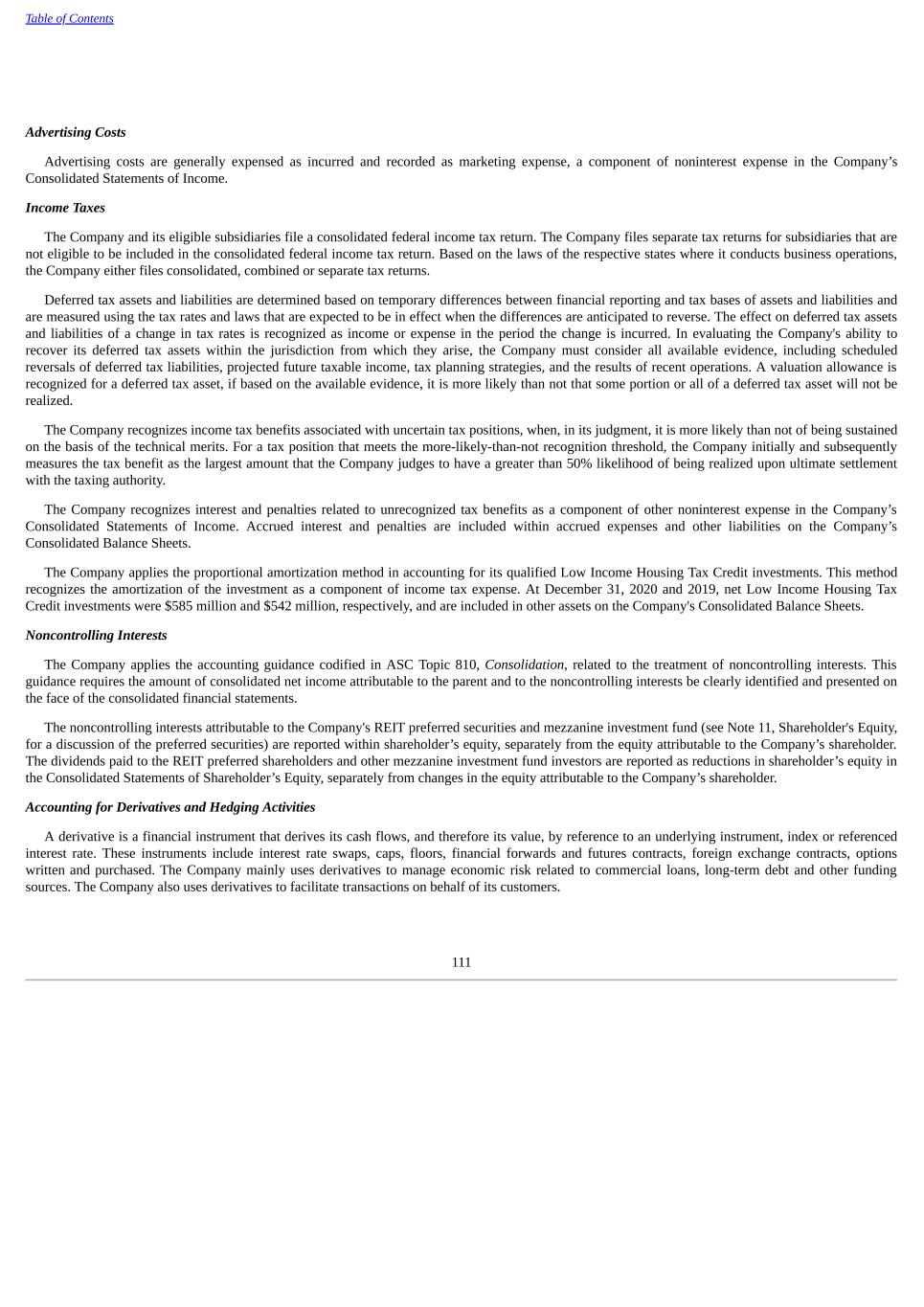
Table of Contents Advertising Costs Advertising costs are generally expensed as incurred and recorded as marketing expense, a component of noninterest expense in the Company’s Consolidated Statements of Income. Income Taxes The Company and its eligible subsidiaries file a consolidated federal income tax return. The Company files separate tax returns for subsidiaries that are not eligible to be included in the consolidated federal income tax return. Based on the laws of the respective states where it conducts business operations, the Company either files consolidated, combined or separate tax returns. Deferred tax assets and liabilities are determined based on temporary differences between financial reporting and tax bases of assets and liabilities and are measured using the tax rates and laws that are expected to be in effect when the differences are anticipated to reverse. The effect on deferred tax assets and liabilities of a change in tax rates is recognized as income or expense in the period the change is incurred. In evaluating the Company's ability to recover its deferred tax assets within the jurisdiction from which they arise, the Company must consider all available evidence, including scheduled reversals of deferred tax liabilities, projected future taxable income, tax planning strategies, and the results of recent operations. A valuation allowance is recognized for a deferred tax asset, if based on the available evidence, it is more likely than not that some portion or all of a deferred tax asset will not be realized. The Company recognizes income tax benefits associated with uncertain tax positions, when, in its judgment, it is more likely than not of being sustained on the basis of the technical merits. For a tax position that meets the more-likely-than-not recognition threshold, the Company initially and subsequently measures the tax benefit as the largest amount that the Company judges to have a greater than 50% likelihood of being realized upon ultimate settlement with the taxing authority. The Company recognizes interest and penalties related to unrecognized tax benefits as a component of other noninterest expense in the Company’s Consolidated Statements of Income. Accrued interest and penalties are included within accrued expenses and other liabilities on the Company’s Consolidated Balance Sheets. The Company applies the proportional amortization method in accounting for its qualified Low Income Housing Tax Credit investments. This method recognizes the amortization of the investment as a component of income tax expense. At December 31, 2020 and 2019, net Low Income Housing Tax Credit investments were $585 million and $542 million, respectively, and are included in other assets on the Company's Consolidated Balance Sheets. Noncontrolling Interests The Company applies the accounting guidance codified in ASC Topic 810, Consolidation, related to the treatment of noncontrolling interests. This guidance requires the amount of consolidated net income attributable to the parent and to the noncontrolling interests be clearly identified and presented on the face of the consolidated financial statements. The noncontrolling interests attributable to the Company's REIT preferred securities and mezzanine investment fund (see Note 11, Shareholder's Equity, for a discussion of the preferred securities) are reported within shareholder’s equity, separately from the equity attributable to the Company’s shareholder. The dividends paid to the REIT preferred shareholders and other mezzanine investment fund investors are reported as reductions in shareholder’s equity in the Consolidated Statements of Shareholder’s Equity, separately from changes in the equity attributable to the Company’s shareholder. Accounting for Derivatives and Hedging Activities A derivative is a financial instrument that derives its cash flows, and therefore its value, by reference to an underlying instrument, index or referenced interest rate. These instruments include interest rate swaps, caps, floors, financial forwards and futures contracts, foreign exchange contracts, options written and purchased. The Company mainly uses derivatives to manage economic risk related to commercial loans, long-term debt and other funding sources. The Company also uses derivatives to facilitate transactions on behalf of its customers. 111
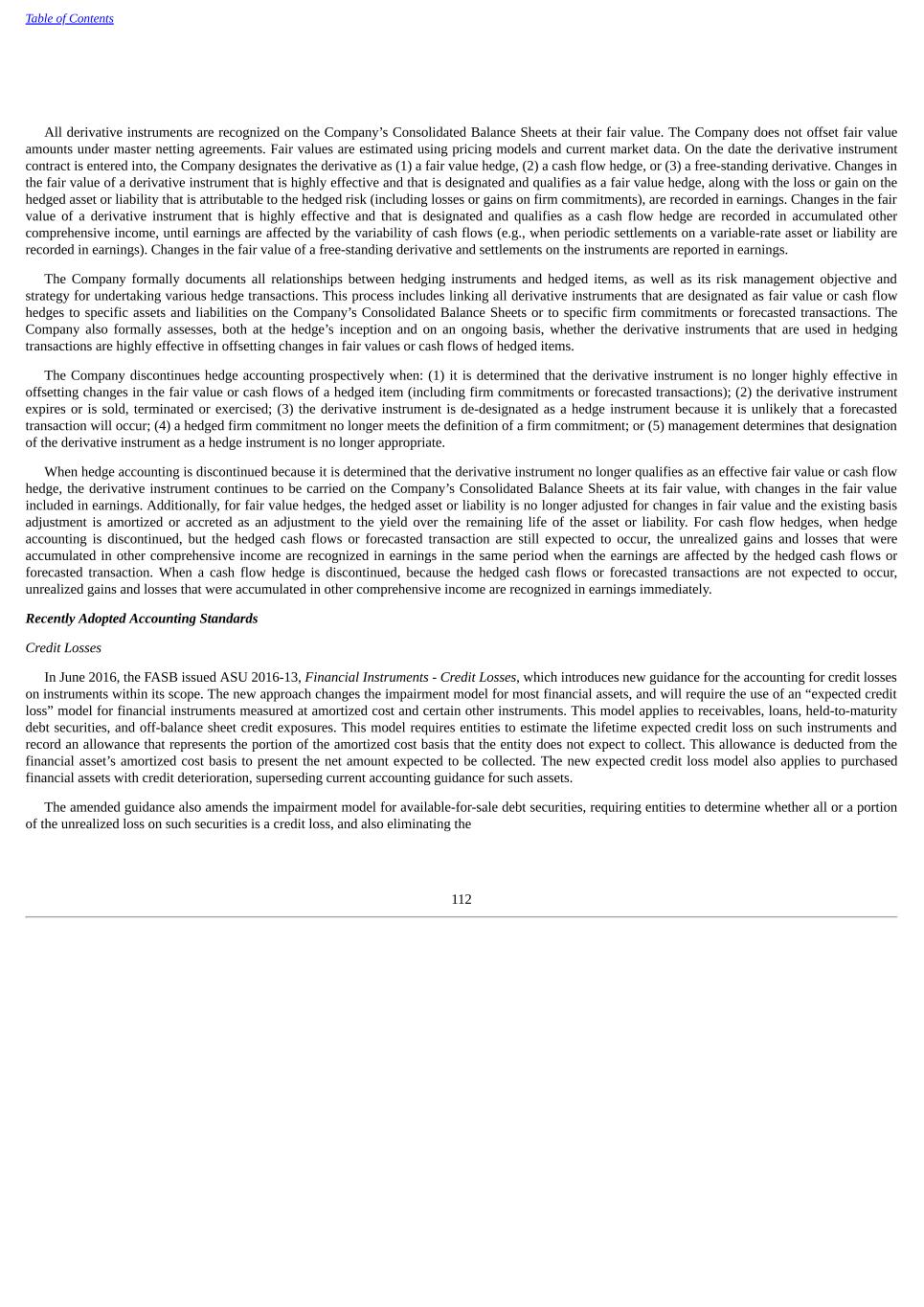
Table of Contents All derivative instruments are recognized on the Company’s Consolidated Balance Sheets at their fair value. The Company does not offset fair value amounts under master netting agreements. Fair values are estimated using pricing models and current market data. On the date the derivative instrument contract is entered into, the Company designates the derivative as (1) a fair value hedge, (2) a cash flow hedge, or (3) a free-standing derivative. Changes in the fair value of a derivative instrument that is highly effective and that is designated and qualifies as a fair value hedge, along with the loss or gain on the hedged asset or liability that is attributable to the hedged risk (including losses or gains on firm commitments), are recorded in earnings. Changes in the fair value of a derivative instrument that is highly effective and that is designated and qualifies as a cash flow hedge are recorded in accumulated other comprehensive income, until earnings are affected by the variability of cash flows (e.g., when periodic settlements on a variable-rate asset or liability are recorded in earnings). Changes in the fair value of a free-standing derivative and settlements on the instruments are reported in earnings. The Company formally documents all relationships between hedging instruments and hedged items, as well as its risk management objective and strategy for undertaking various hedge transactions. This process includes linking all derivative instruments that are designated as fair value or cash flow hedges to specific assets and liabilities on the Company’s Consolidated Balance Sheets or to specific firm commitments or forecasted transactions. The Company also formally assesses, both at the hedge’s inception and on an ongoing basis, whether the derivative instruments that are used in hedging transactions are highly effective in offsetting changes in fair values or cash flows of hedged items. The Company discontinues hedge accounting prospectively when: (1) it is determined that the derivative instrument is no longer highly effective in offsetting changes in the fair value or cash flows of a hedged item (including firm commitments or forecasted transactions); (2) the derivative instrument expires or is sold, terminated or exercised; (3) the derivative instrument is de-designated as a hedge instrument because it is unlikely that a forecasted transaction will occur; (4) a hedged firm commitment no longer meets the definition of a firm commitment; or (5) management determines that designation of the derivative instrument as a hedge instrument is no longer appropriate. When hedge accounting is discontinued because it is determined that the derivative instrument no longer qualifies as an effective fair value or cash flow hedge, the derivative instrument continues to be carried on the Company’s Consolidated Balance Sheets at its fair value, with changes in the fair value included in earnings. Additionally, for fair value hedges, the hedged asset or liability is no longer adjusted for changes in fair value and the existing basis adjustment is amortized or accreted as an adjustment to the yield over the remaining life of the asset or liability. For cash flow hedges, when hedge accounting is discontinued, but the hedged cash flows or forecasted transaction are still expected to occur, the unrealized gains and losses that were accumulated in other comprehensive income are recognized in earnings in the same period when the earnings are affected by the hedged cash flows or forecasted transaction. When a cash flow hedge is discontinued, because the hedged cash flows or forecasted transactions are not expected to occur, unrealized gains and losses that were accumulated in other comprehensive income are recognized in earnings immediately. Recently Adopted Accounting Standards Credit Losses In June 2016, the FASB issued ASU 2016-13, Financial Instruments - Credit Losses, which introduces new guidance for the accounting for credit losses on instruments within its scope. The new approach changes the impairment model for most financial assets, and will require the use of an “expected credit loss” model for financial instruments measured at amortized cost and certain other instruments. This model applies to receivables, loans, held-to-maturity debt securities, and off-balance sheet credit exposures. This model requires entities to estimate the lifetime expected credit loss on such instruments and record an allowance that represents the portion of the amortized cost basis that the entity does not expect to collect. This allowance is deducted from the financial asset’s amortized cost basis to present the net amount expected to be collected. The new expected credit loss model also applies to purchased financial assets with credit deterioration, superseding current accounting guidance for such assets. The amended guidance also amends the impairment model for available-for-sale debt securities, requiring entities to determine whether all or a portion of the unrealized loss on such securities is a credit loss, and also eliminating the 112
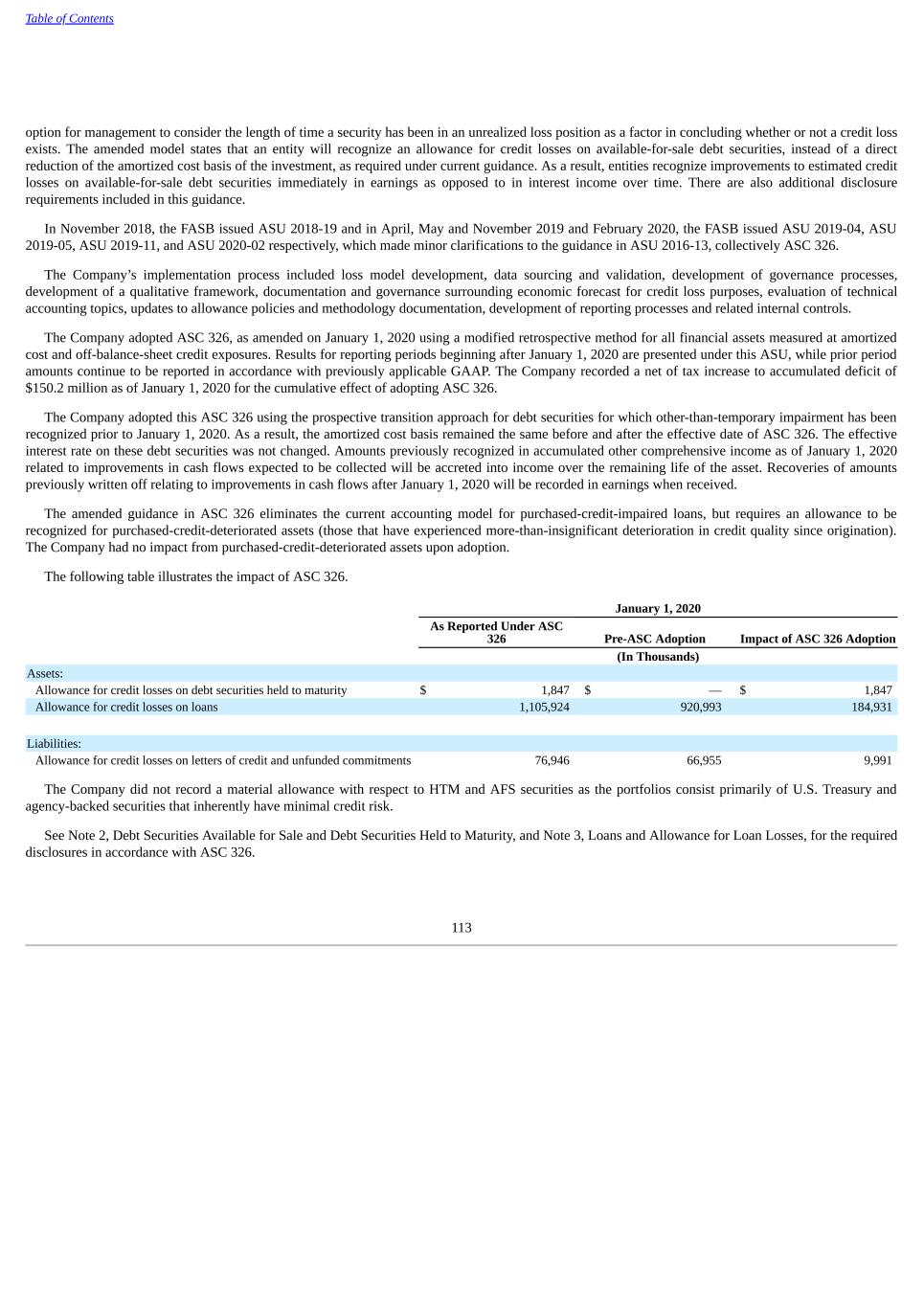
Table of Contents option for management to consider the length of time a security has been in an unrealized loss position as a factor in concluding whether or not a credit loss exists. The amended model states that an entity will recognize an allowance for credit losses on available-for-sale debt securities, instead of a direct reduction of the amortized cost basis of the investment, as required under current guidance. As a result, entities recognize improvements to estimated credit losses on available-for-sale debt securities immediately in earnings as opposed to in interest income over time. There are also additional disclosure requirements included in this guidance. In November 2018, the FASB issued ASU 2018-19 and in April, May and November 2019 and February 2020, the FASB issued ASU 2019-04, ASU 2019-05, ASU 2019-11, and ASU 2020-02 respectively, which made minor clarifications to the guidance in ASU 2016-13, collectively ASC 326. The Company’s implementation process included loss model development, data sourcing and validation, development of governance processes, development of a qualitative framework, documentation and governance surrounding economic forecast for credit loss purposes, evaluation of technical accounting topics, updates to allowance policies and methodology documentation, development of reporting processes and related internal controls. The Company adopted ASC 326, as amended on January 1, 2020 using a modified retrospective method for all financial assets measured at amortized cost and off-balance-sheet credit exposures. Results for reporting periods beginning after January 1, 2020 are presented under this ASU, while prior period amounts continue to be reported in accordance with previously applicable GAAP. The Company recorded a net of tax increase to accumulated deficit of $150.2 million as of January 1, 2020 for the cumulative effect of adopting ASC 326. The Company adopted this ASC 326 using the prospective transition approach for debt securities for which other-than-temporary impairment has been recognized prior to January 1, 2020. As a result, the amortized cost basis remained the same before and after the effective date of ASC 326. The effective interest rate on these debt securities was not changed. Amounts previously recognized in accumulated other comprehensive income as of January 1, 2020 related to improvements in cash flows expected to be collected will be accreted into income over the remaining life of the asset. Recoveries of amounts previously written off relating to improvements in cash flows after January 1, 2020 will be recorded in earnings when received. The amended guidance in ASC 326 eliminates the current accounting model for purchased-credit-impaired loans, but requires an allowance to be recognized for purchased-credit-deteriorated assets (those that have experienced more-than-insignificant deterioration in credit quality since origination). The Company had no impact from purchased-credit-deteriorated assets upon adoption. The following table illustrates the impact of ASC 326. January 1, 2020 As Reported Under ASC 326 Pre-ASC Adoption Impact of ASC 326 Adoption (In Thousands) Assets: Allowance for credit losses on debt securities held to maturity $ 1,847 $ — $ 1,847 Allowance for credit losses on loans 1,105,924 920,993 184,931 Liabilities: Allowance for credit losses on letters of credit and unfunded commitments 76,946 66,955 9,991 The Company did not record a material allowance with respect to HTM and AFS securities as the portfolios consist primarily of U.S. Treasury and agency-backed securities that inherently have minimal credit risk. See Note 2, Debt Securities Available for Sale and Debt Securities Held to Maturity, and Note 3, Loans and Allowance for Loan Losses, for the required disclosures in accordance with ASC 326. 113
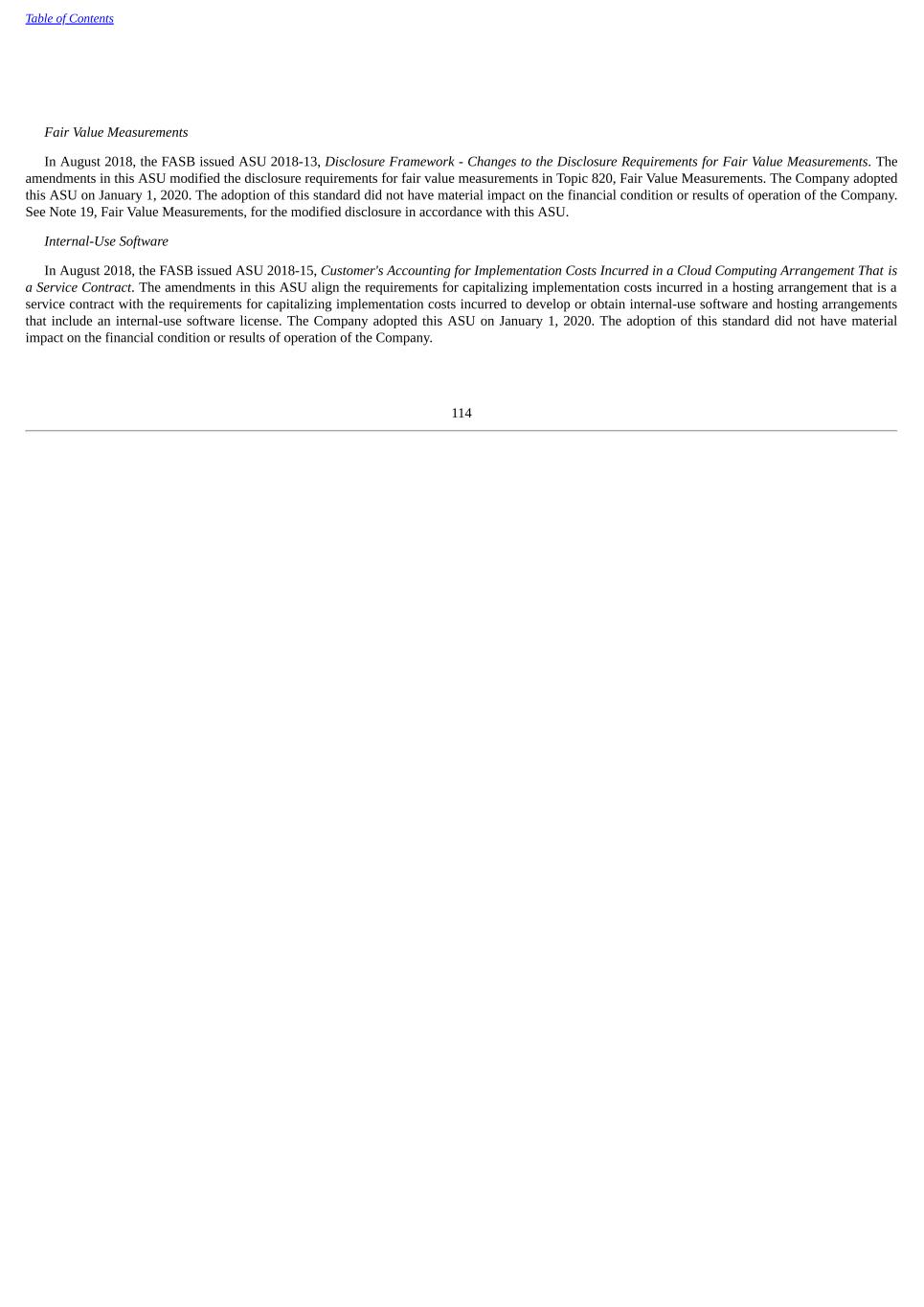
Table of Contents Fair Value Measurements In August 2018, the FASB issued ASU 2018-13, Disclosure Framework - Changes to the Disclosure Requirements for Fair Value Measurements. The amendments in this ASU modified the disclosure requirements for fair value measurements in Topic 820, Fair Value Measurements. The Company adopted this ASU on January 1, 2020. The adoption of this standard did not have material impact on the financial condition or results of operation of the Company. See Note 19, Fair Value Measurements, for the modified disclosure in accordance with this ASU. Internal-Use Software In August 2018, the FASB issued ASU 2018-15, Customer's Accounting for Implementation Costs Incurred in a Cloud Computing Arrangement That is a Service Contract. The amendments in this ASU align the requirements for capitalizing implementation costs incurred in a hosting arrangement that is a service contract with the requirements for capitalizing implementation costs incurred to develop or obtain internal-use software and hosting arrangements that include an internal-use software license. The Company adopted this ASU on January 1, 2020. The adoption of this standard did not have material impact on the financial condition or results of operation of the Company. 114

Table of Contents (2) Debt Securities Available for Sale and Debt Securities Held to Maturity The following table presents the adjusted cost and approximate fair value of debt securities available for sale and debt securities held to maturity. As noted in Note 1, Summary of Significant Accounting Policies, the Company adopted ASC 326 on January 1, 2020, which had an immaterial impact on the Company's available for sale debt securities and held to maturity debt securities. December 31, 2020 Gross Unrealized Amortized Cost Gains Losses Fair Value (In Thousands) Debt securities available for sale: U.S. Treasury and other U.S. government agencies $ 2,115,915 $ 45,168 $ 14,179 $ 2,146,904 Agency mortgage-backed securities 834,640 32,103 1,095 865,648 Agency collateralized mortgage obligations 2,681,210 50,811 290 2,731,731 States and political subdivisions 617 19 — 636 Total $ 5,632,382 $ 128,101 $ 15,564 $ 5,744,919 Debt securities held to maturity: U.S. Treasury and other U.S. government agencies $ 1,291,900 $ 112,968 $ — $ 1,404,868 Agency mortgage-backed securities 570,115 2,491 — 572,606 Collateralized mortgage obligations: Agency 8,144,522 147,176 27,234 8,264,464 Non-agency 29,186 5,972 209 34,949 Asset-backed securities and other 48,790 1,217 2,681 47,326 States and political subdivisions (1) 467,610 21,047 3,409 485,248 Total $ 10,552,123 $ 290,871 $ 33,533 $ 10,809,461 (1) The Company recorded an allowance of $2 million, at December 31, 2020, related to state and political subdivisions, which is not included in the table above. December 31, 2019 Gross Unrealized Amortized Cost Gains Losses Fair Value (In Thousands) Debt securities available for sale: U.S. Treasury and other U.S. government agencies $ 3,145,331 $ 16,888 $ 34,694 $ 3,127,525 Agency mortgage-backed securities 1,322,432 12,444 9,019 1,325,857 Agency collateralized mortgage obligations 2,783,003 7,744 9,622 2,781,125 States and political subdivisions 757 41 — 798 Total $ 7,251,523 $ 37,117 $ 53,335 $ 7,235,305 Debt securities held to maturity: U.S. Treasury and other U.S. government agencies $ 1,287,049 $ 53,399 $ — $ 1,340,448 Collateralized mortgage obligations: Agency 4,846,862 82,105 16,568 4,912,399 Non-agency 37,705 5,923 1,154 42,474 Asset-backed securities and other 52,355 1,266 2,017 51,604 States and political subdivisions 573,075 8,652 7,494 574,233 Total $ 6,797,046 $ 151,345 $ 27,233 $ 6,921,158 The investments held within the states and political subdivision caption of debt securities held to maturity relate to private placement transactions underwritten as loans by the Company but meet the definition of a debt security within ASC Topic 320, Investments – Debt Securities. 115
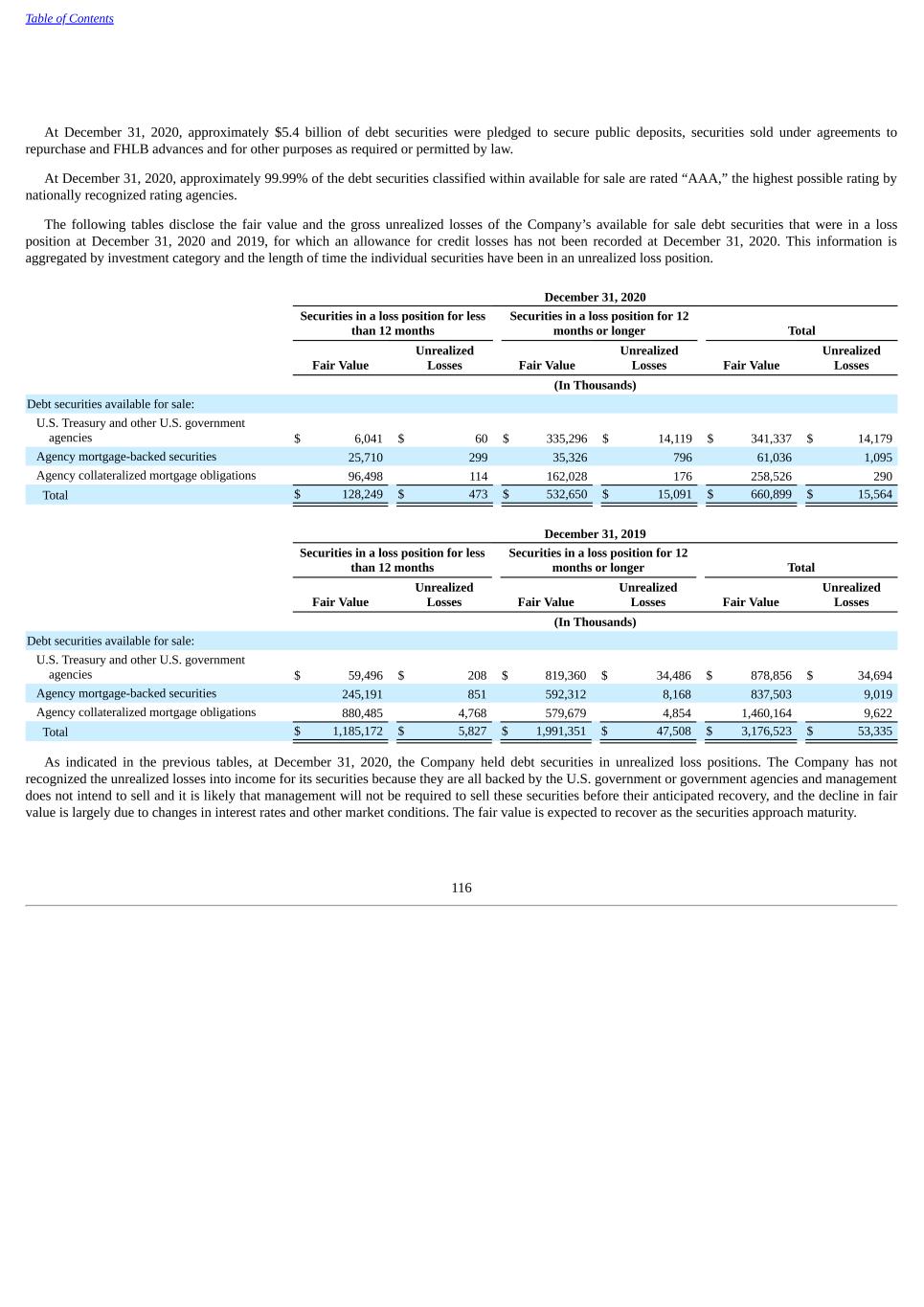
Table of Contents At December 31, 2020, approximately $5.4 billion of debt securities were pledged to secure public deposits, securities sold under agreements to repurchase and FHLB advances and for other purposes as required or permitted by law. At December 31, 2020, approximately 99.99% of the debt securities classified within available for sale are rated “AAA,” the highest possible rating by nationally recognized rating agencies. The following tables disclose the fair value and the gross unrealized losses of the Company’s available for sale debt securities that were in a loss position at December 31, 2020 and 2019, for which an allowance for credit losses has not been recorded at December 31, 2020. This information is aggregated by investment category and the length of time the individual securities have been in an unrealized loss position. December 31, 2020 Securities in a loss position for less than 12 months Securities in a loss position for 12 months or longer Total Fair Value Unrealized Losses Fair Value Unrealized Losses Fair Value Unrealized Losses (In Thousands) Debt securities available for sale: U.S. Treasury and other U.S. government agencies $ 6,041 $ 60 $ 335,296 $ 14,119 $ 341,337 $ 14,179 Agency mortgage-backed securities 25,710 299 35,326 796 61,036 1,095 Agency collateralized mortgage obligations 96,498 114 162,028 176 258,526 290 Total $ 128,249 $ 473 $ 532,650 $ 15,091 $ 660,899 $ 15,564 December 31, 2019 Securities in a loss position for less than 12 months Securities in a loss position for 12 months or longer Total Fair Value Unrealized Losses Fair Value Unrealized Losses Fair Value Unrealized Losses (In Thousands) Debt securities available for sale: U.S. Treasury and other U.S. government agencies $ 59,496 $ 208 $ 819,360 $ 34,486 $ 878,856 $ 34,694 Agency mortgage-backed securities 245,191 851 592,312 8,168 837,503 9,019 Agency collateralized mortgage obligations 880,485 4,768 579,679 4,854 1,460,164 9,622 Total $ 1,185,172 $ 5,827 $ 1,991,351 $ 47,508 $ 3,176,523 $ 53,335 As indicated in the previous tables, at December 31, 2020, the Company held debt securities in unrealized loss positions. The Company has not recognized the unrealized losses into income for its securities because they are all backed by the U.S. government or government agencies and management does not intend to sell and it is likely that management will not be required to sell these securities before their anticipated recovery, and the decline in fair value is largely due to changes in interest rates and other market conditions. The fair value is expected to recover as the securities approach maturity. 116
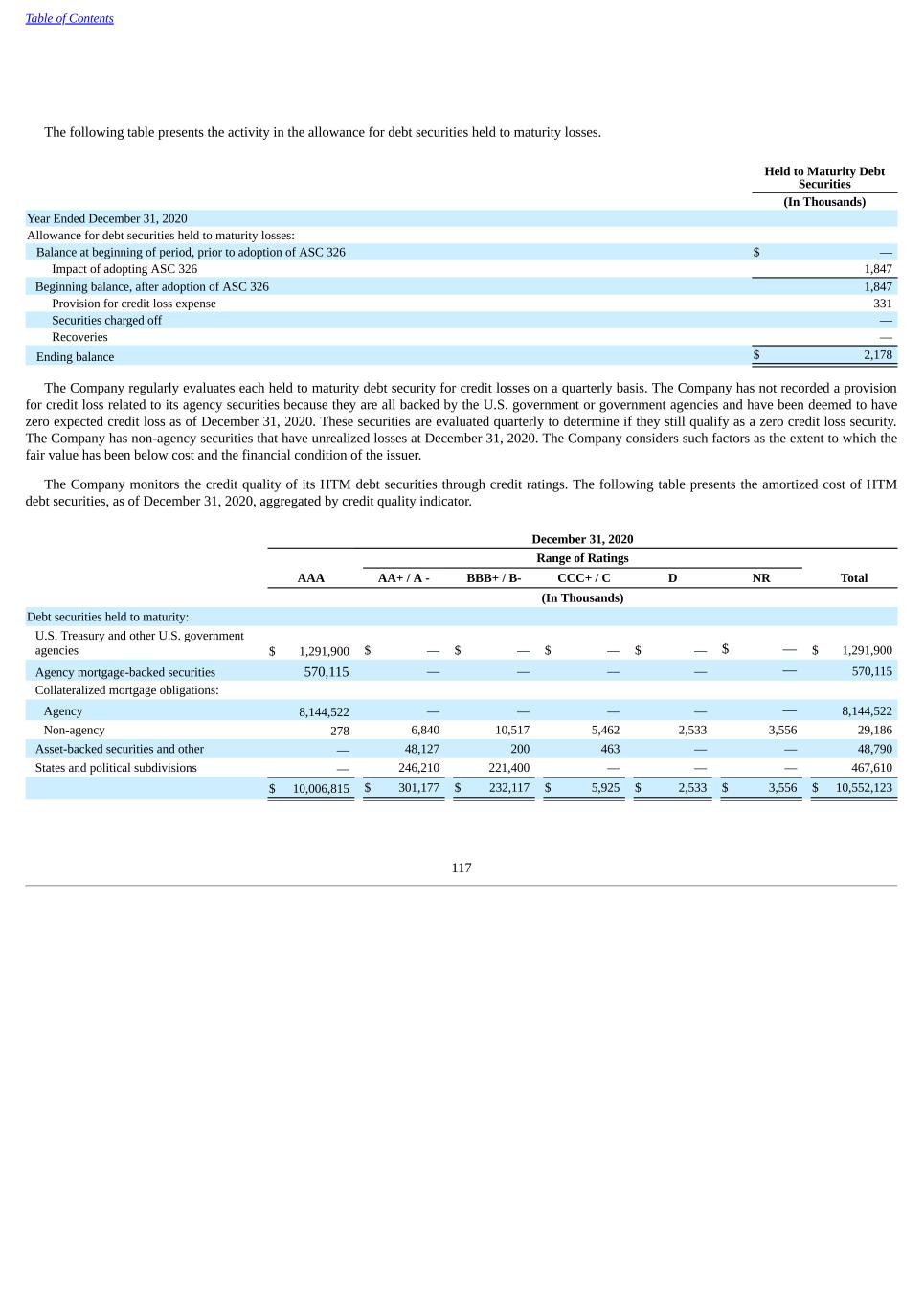
Table of Contents The following table presents the activity in the allowance for debt securities held to maturity losses. Held to Maturity Debt Securities (In Thousands) Year Ended December 31, 2020 Allowance for debt securities held to maturity losses: Balance at beginning of period, prior to adoption of ASC 326 $ — Impact of adopting ASC 326 1,847 Beginning balance, after adoption of ASC 326 1,847 Provision for credit loss expense 331 Securities charged off — Recoveries — Ending balance $ 2,178 The Company regularly evaluates each held to maturity debt security for credit losses on a quarterly basis. The Company has not recorded a provision for credit loss related to its agency securities because they are all backed by the U.S. government or government agencies and have been deemed to have zero expected credit loss as of December 31, 2020. These securities are evaluated quarterly to determine if they still qualify as a zero credit loss security. The Company has non-agency securities that have unrealized losses at December 31, 2020. The Company considers such factors as the extent to which the fair value has been below cost and the financial condition of the issuer. The Company monitors the credit quality of its HTM debt securities through credit ratings. The following table presents the amortized cost of HTM debt securities, as of December 31, 2020, aggregated by credit quality indicator. December 31, 2020 Range of Ratings AAA AA+ / A - BBB+ / B- CCC+ / C D NR Total (In Thousands) Debt securities held to maturity: U.S. Treasury and other U.S. government agencies $ 1,291,900 $ — $ — $ — $ — $ — $ 1,291,900 Agency mortgage-backed securities 570,115 — — — — — 570,115 Collateralized mortgage obligations: Agency 8,144,522 — — — — — 8,144,522 Non-agency 278 6,840 10,517 5,462 2,533 3,556 29,186 Asset-backed securities and other — 48,127 200 463 — — 48,790 States and political subdivisions — 246,210 221,400 — — — 467,610 $ 10,006,815 $ 301,177 $ 232,117 $ 5,925 $ 2,533 $ 3,556 $ 10,552,123 117

Table of Contents The following table discloses activity related to credit losses for debt securities where a portion of the OTTI was recognized in other comprehensive income. Years Ended December 31, 2019 2018 (In Thousands) Balance, at beginning of year $ 23,416 $ 22,824 Reductions for securities paid off during the period (realized) — — Additions for the credit component on debt securities in which OTTI was not previously recognized — — Additions for the credit component on debt securities in which OTTI was previously recognized 215 592 Balance, at end of year $ 23,631 $ 23,416 During the years ended December 31, 2019 and 2018, OTTI recognized on held to maturity debt securities totaled $215 thousand and $592 thousand, respectively. The debt securities impacted by credit impairment consisted of held to maturity non-agency collateralized mortgage obligations. The contractual maturities of the securities portfolios are presented in the following table. Amortized Cost Fair Value December 31, 2020 (In Thousands) Debt securities available for sale: Maturing within one year $ 300,014 $ 300,073 Maturing after one but within five years 1,400,824 1,443,878 Maturing after five but within ten years 5,694 5,783 Maturing after ten years 410,000 397,806 2,116,532 2,147,540 Agency mortgage-backed securities and agency collateralized mortgage obligations 3,515,850 3,597,379 Total $ 5,632,382 $ 5,744,919 Debt securities held to maturity: Maturing within one year $ 20,224 $ 20,196 Maturing after one but within five years 1,401,764 1,514,760 Maturing after five but within ten years 272,972 289,908 Maturing after ten years 113,340 112,578 1,808,300 1,937,442 Agency mortgage-backed securities and agency and non-agency collateralized mortgage obligations 8,743,823 8,872,019 Total $ 10,552,123 $ 10,809,461 The gross realized gains and losses recognized on sales of debt securities available for sale are shown in the table below. Years Ended December 31, 2020 2019 2018 (In Thousands) Gross gains $ 22,616 $ 29,961 $ — Gross losses — — — Net realized gains $ 22,616 $ 29,961 $ — At December 31, 2020 and 2019 there were $21 million and $28 million, respectively, of unrealized losses, net of tax related to debt securities transferred from available for sale to held to maturity in accumulated other comprehensive income, which are being amortized over the remaining life of those securities. 118
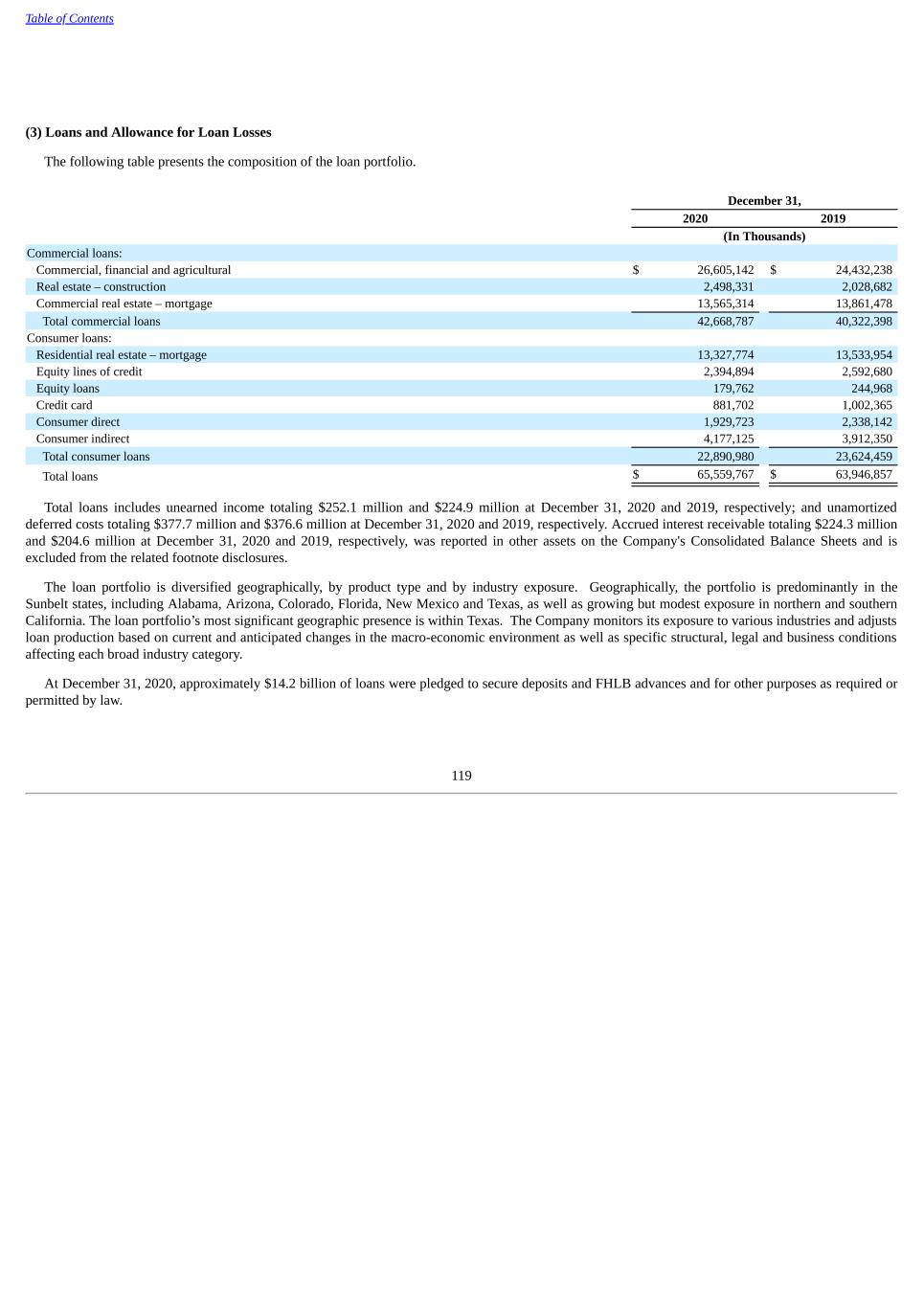
Table of Contents (3) Loans and Allowance for Loan Losses The following table presents the composition of the loan portfolio. December 31, 2020 2019 (In Thousands) Commercial loans: Commercial, financial and agricultural $ 26,605,142 $ 24,432,238 Real estate – construction 2,498,331 2,028,682 Commercial real estate – mortgage 13,565,314 13,861,478 Total commercial loans 42,668,787 40,322,398 Consumer loans: Residential real estate – mortgage 13,327,774 13,533,954 Equity lines of credit 2,394,894 2,592,680 Equity loans 179,762 244,968 Credit card 881,702 1,002,365 Consumer direct 1,929,723 2,338,142 Consumer indirect 4,177,125 3,912,350 Total consumer loans 22,890,980 23,624,459 Total loans $ 65,559,767 $ 63,946,857 Total loans includes unearned income totaling $252.1 million and $224.9 million at December 31, 2020 and 2019, respectively; and unamortized deferred costs totaling $377.7 million and $376.6 million at December 31, 2020 and 2019, respectively. Accrued interest receivable totaling $224.3 million and $204.6 million at December 31, 2020 and 2019, respectively, was reported in other assets on the Company's Consolidated Balance Sheets and is excluded from the related footnote disclosures. The loan portfolio is diversified geographically, by product type and by industry exposure. Geographically, the portfolio is predominantly in the Sunbelt states, including Alabama, Arizona, Colorado, Florida, New Mexico and Texas, as well as growing but modest exposure in northern and southern California. The loan portfolio’s most significant geographic presence is within Texas. The Company monitors its exposure to various industries and adjusts loan production based on current and anticipated changes in the macro-economic environment as well as specific structural, legal and business conditions affecting each broad industry category. At December 31, 2020, approximately $14.2 billion of loans were pledged to secure deposits and FHLB advances and for other purposes as required or permitted by law. 119
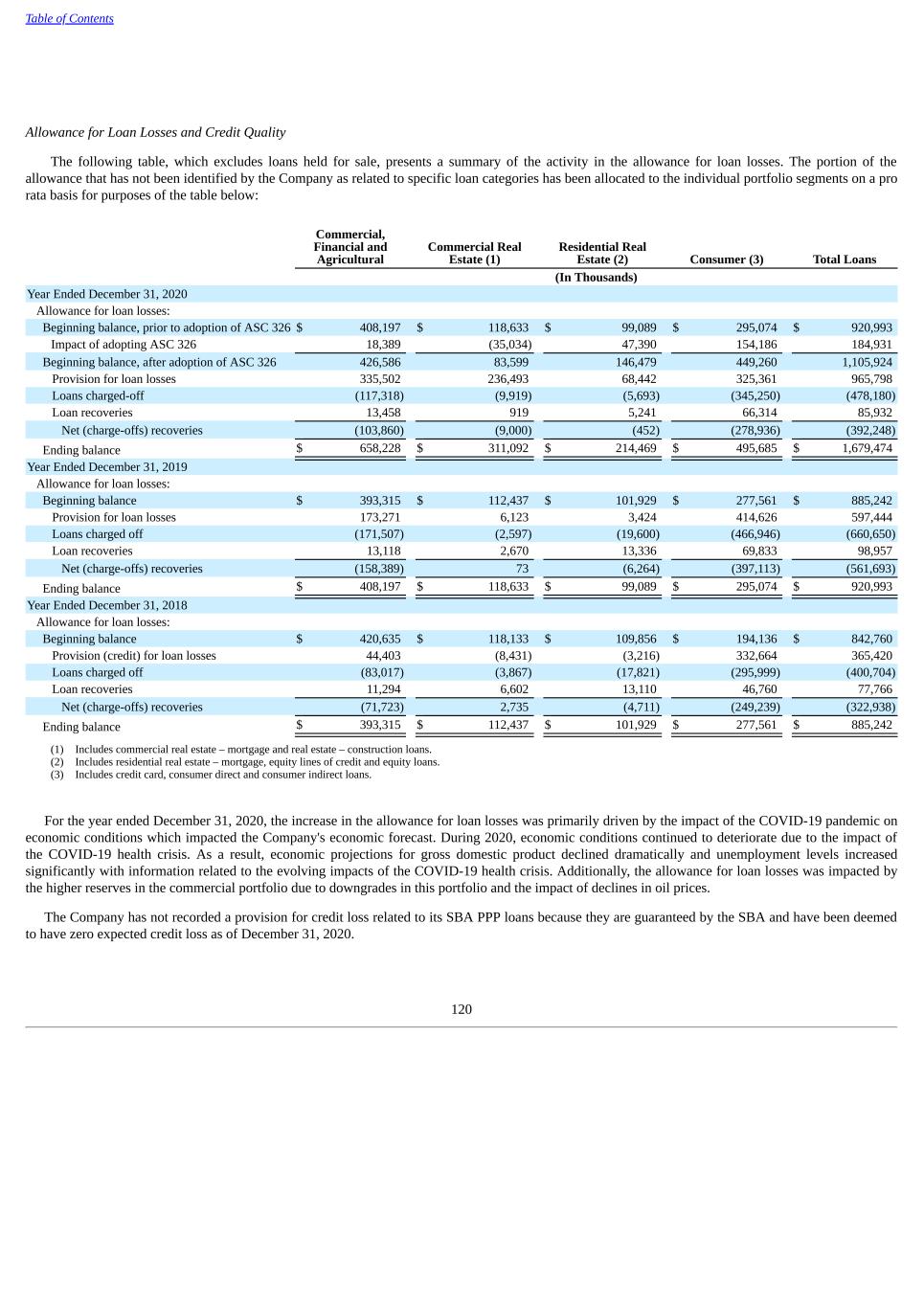
Table of Contents Allowance for Loan Losses and Credit Quality The following table, which excludes loans held for sale, presents a summary of the activity in the allowance for loan losses. The portion of the allowance that has not been identified by the Company as related to specific loan categories has been allocated to the individual portfolio segments on a pro rata basis for purposes of the table below: Commercial, Financial and Agricultural Commercial Real Estate (1) Residential Real Estate (2) Consumer (3) Total Loans (In Thousands) Year Ended December 31, 2020 Allowance for loan losses: Beginning balance, prior to adoption of ASC 326 $ 408,197 $ 118,633 $ 99,089 $ 295,074 $ 920,993 Impact of adopting ASC 326 18,389 (35,034) 47,390 154,186 184,931 Beginning balance, after adoption of ASC 326 426,586 83,599 146,479 449,260 1,105,924 Provision for loan losses 335,502 236,493 68,442 325,361 965,798 Loans charged-off (117,318) (9,919) (5,693) (345,250) (478,180) Loan recoveries 13,458 919 5,241 66,314 85,932 Net (charge-offs) recoveries (103,860) (9,000) (452) (278,936) (392,248) Ending balance $ 658,228 $ 311,092 $ 214,469 $ 495,685 $ 1,679,474 Year Ended December 31, 2019 Allowance for loan losses: Beginning balance $ 393,315 $ 112,437 $ 101,929 $ 277,561 $ 885,242 Provision for loan losses 173,271 6,123 3,424 414,626 597,444 Loans charged off (171,507) (2,597) (19,600) (466,946) (660,650) Loan recoveries 13,118 2,670 13,336 69,833 98,957 Net (charge-offs) recoveries (158,389) 73 (6,264) (397,113) (561,693) Ending balance $ 408,197 $ 118,633 $ 99,089 $ 295,074 $ 920,993 Year Ended December 31, 2018 Allowance for loan losses: Beginning balance $ 420,635 $ 118,133 $ 109,856 $ 194,136 $ 842,760 Provision (credit) for loan losses 44,403 (8,431) (3,216) 332,664 365,420 Loans charged off (83,017) (3,867) (17,821) (295,999) (400,704) Loan recoveries 11,294 6,602 13,110 46,760 77,766 Net (charge-offs) recoveries (71,723) 2,735 (4,711) (249,239) (322,938) Ending balance $ 393,315 $ 112,437 $ 101,929 $ 277,561 $ 885,242 (1) Includes commercial real estate – mortgage and real estate – construction loans. (2) Includes residential real estate – mortgage, equity lines of credit and equity loans. (3) Includes credit card, consumer direct and consumer indirect loans. For the year ended December 31, 2020, the increase in the allowance for loan losses was primarily driven by the impact of the COVID-19 pandemic on economic conditions which impacted the Company's economic forecast. During 2020, economic conditions continued to deteriorate due to the impact of the COVID-19 health crisis. As a result, economic projections for gross domestic product declined dramatically and unemployment levels increased significantly with information related to the evolving impacts of the COVID-19 health crisis. Additionally, the allowance for loan losses was impacted by the higher reserves in the commercial portfolio due to downgrades in this portfolio and the impact of declines in oil prices. The Company has not recorded a provision for credit loss related to its SBA PPP loans because they are guaranteed by the SBA and have been deemed to have zero expected credit loss as of December 31, 2020. 120

Table of Contents The table below provides a summary of the allowance for loan losses and related loan balances by portfolio at December 31, 2019. Commercial, Financial and Agricultural Commercial Real Estate (1) Residential Real Estate (2) Consumer (3) Total Loans (In Thousands) December 31, 2019 Ending balance of allowance attributable to loans: Individually evaluated for impairment $ 88,164 $ 13,255 $ 22,775 $ 2,638 $ 126,832 Collectively evaluated for impairment 320,033 105,378 76,314 292,436 794,161 Total allowance for loan losses $ 408,197 $ 118,633 $ 99,089 $ 295,074 $ 920,993 Loans: Ending balance of loans: Individually evaluated for impairment $ 238,653 $ 78,301 $ 155,728 $ 13,362 $ 486,044 Collectively evaluated for impairment 24,193,585 15,811,859 16,215,874 7,239,495 63,460,813 Total loans $ 24,432,238 $ 15,890,160 $ 16,371,602 $ 7,252,857 $ 63,946,857 (1) Includes commercial real estate – mortgage and real estate – construction loans. (2) Includes residential real estate – mortgage, equity lines of credit and equity loans. (3) Includes credit card, consumer direct and consumer indirect loans. 121
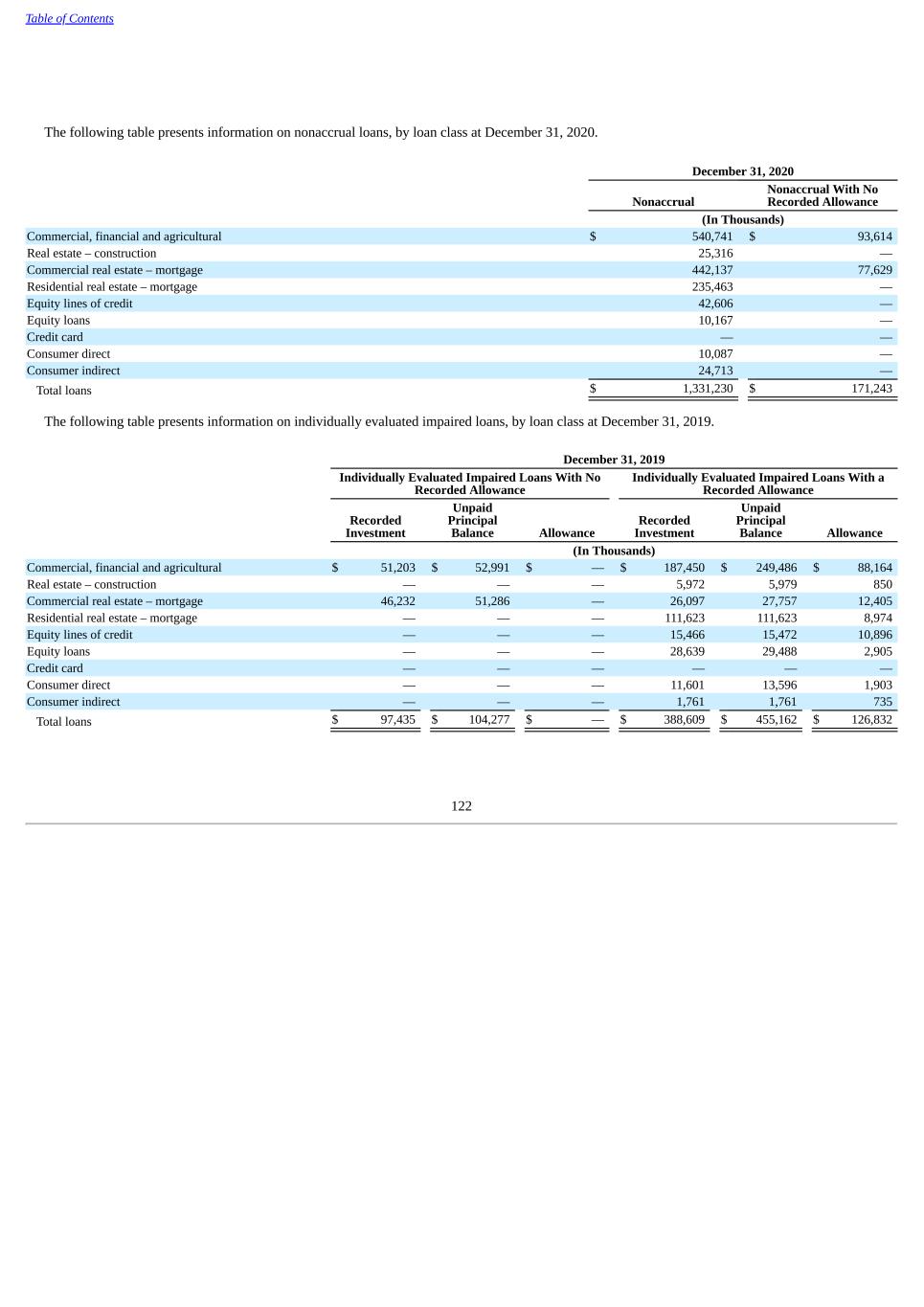
Table of Contents The following table presents information on nonaccrual loans, by loan class at December 31, 2020. December 31, 2020 Nonaccrual Nonaccrual With No Recorded Allowance (In Thousands) Commercial, financial and agricultural $ 540,741 $ 93,614 Real estate – construction 25,316 — Commercial real estate – mortgage 442,137 77,629 Residential real estate – mortgage 235,463 — Equity lines of credit 42,606 — Equity loans 10,167 — Credit card — — Consumer direct 10,087 — Consumer indirect 24,713 — Total loans $ 1,331,230 $ 171,243 The following table presents information on individually evaluated impaired loans, by loan class at December 31, 2019. December 31, 2019 Individually Evaluated Impaired Loans With No Recorded Allowance Individually Evaluated Impaired Loans With a Recorded Allowance Recorded Investment Unpaid Principal Balance Allowance Recorded Investment Unpaid Principal Balance Allowance (In Thousands) Commercial, financial and agricultural $ 51,203 $ 52,991 $ — $ 187,450 $ 249,486 $ 88,164 Real estate – construction — — — 5,972 5,979 850 Commercial real estate – mortgage 46,232 51,286 — 26,097 27,757 12,405 Residential real estate – mortgage — — — 111,623 111,623 8,974 Equity lines of credit — — — 15,466 15,472 10,896 Equity loans — — — 28,639 29,488 2,905 Credit card — — — — — — Consumer direct — — — 11,601 13,596 1,903 Consumer indirect — — — 1,761 1,761 735 Total loans $ 97,435 $ 104,277 $ — $ 388,609 $ 455,162 $ 126,832 122
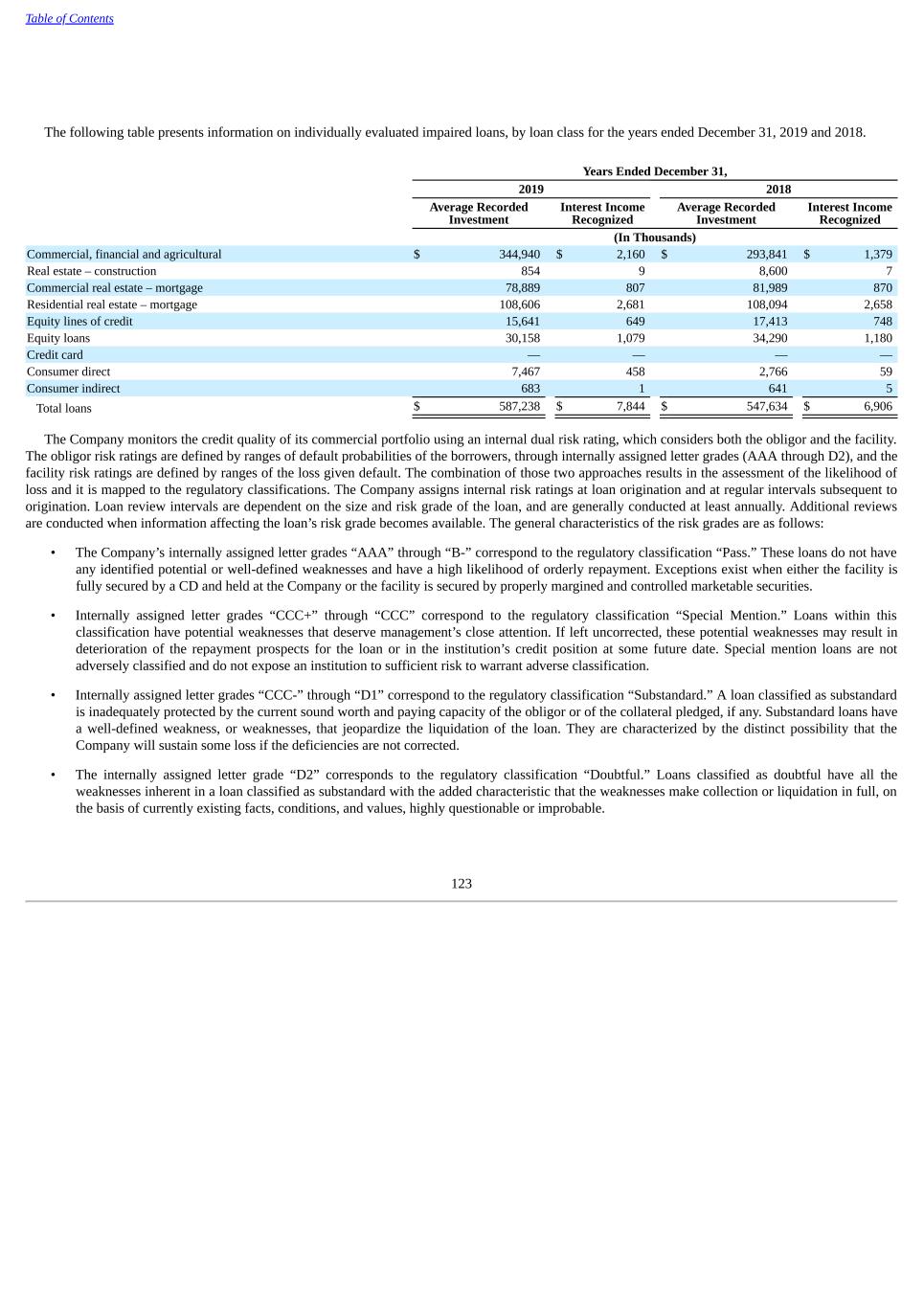
Table of Contents The following table presents information on individually evaluated impaired loans, by loan class for the years ended December 31, 2019 and 2018. Years Ended December 31, 2019 2018 Average Recorded Investment Interest Income Recognized Average Recorded Investment Interest Income Recognized (In Thousands) Commercial, financial and agricultural $ 344,940 $ 2,160 $ 293,841 $ 1,379 Real estate – construction 854 9 8,600 7 Commercial real estate – mortgage 78,889 807 81,989 870 Residential real estate – mortgage 108,606 2,681 108,094 2,658 Equity lines of credit 15,641 649 17,413 748 Equity loans 30,158 1,079 34,290 1,180 Credit card — — — — Consumer direct 7,467 458 2,766 59 Consumer indirect 683 1 641 5 Total loans $ 587,238 $ 7,844 $ 547,634 $ 6,906 The Company monitors the credit quality of its commercial portfolio using an internal dual risk rating, which considers both the obligor and the facility. The obligor risk ratings are defined by ranges of default probabilities of the borrowers, through internally assigned letter grades (AAA through D2), and the facility risk ratings are defined by ranges of the loss given default. The combination of those two approaches results in the assessment of the likelihood of loss and it is mapped to the regulatory classifications. The Company assigns internal risk ratings at loan origination and at regular intervals subsequent to origination. Loan review intervals are dependent on the size and risk grade of the loan, and are generally conducted at least annually. Additional reviews are conducted when information affecting the loan’s risk grade becomes available. The general characteristics of the risk grades are as follows: • The Company’s internally assigned letter grades “AAA” through “B-” correspond to the regulatory classification “Pass.” These loans do not have any identified potential or well-defined weaknesses and have a high likelihood of orderly repayment. Exceptions exist when either the facility is fully secured by a CD and held at the Company or the facility is secured by properly margined and controlled marketable securities. • Internally assigned letter grades “CCC+” through “CCC” correspond to the regulatory classification “Special Mention.” Loans within this classification have potential weaknesses that deserve management’s close attention. If left uncorrected, these potential weaknesses may result in deterioration of the repayment prospects for the loan or in the institution’s credit position at some future date. Special mention loans are not adversely classified and do not expose an institution to sufficient risk to warrant adverse classification. • Internally assigned letter grades “CCC-” through “D1” correspond to the regulatory classification “Substandard.” A loan classified as substandard is inadequately protected by the current sound worth and paying capacity of the obligor or of the collateral pledged, if any. Substandard loans have a well-defined weakness, or weaknesses, that jeopardize the liquidation of the loan. They are characterized by the distinct possibility that the Company will sustain some loss if the deficiencies are not corrected. • The internally assigned letter grade “D2” corresponds to the regulatory classification “Doubtful.” Loans classified as doubtful have all the weaknesses inherent in a loan classified as substandard with the added characteristic that the weaknesses make collection or liquidation in full, on the basis of currently existing facts, conditions, and values, highly questionable or improbable. 123
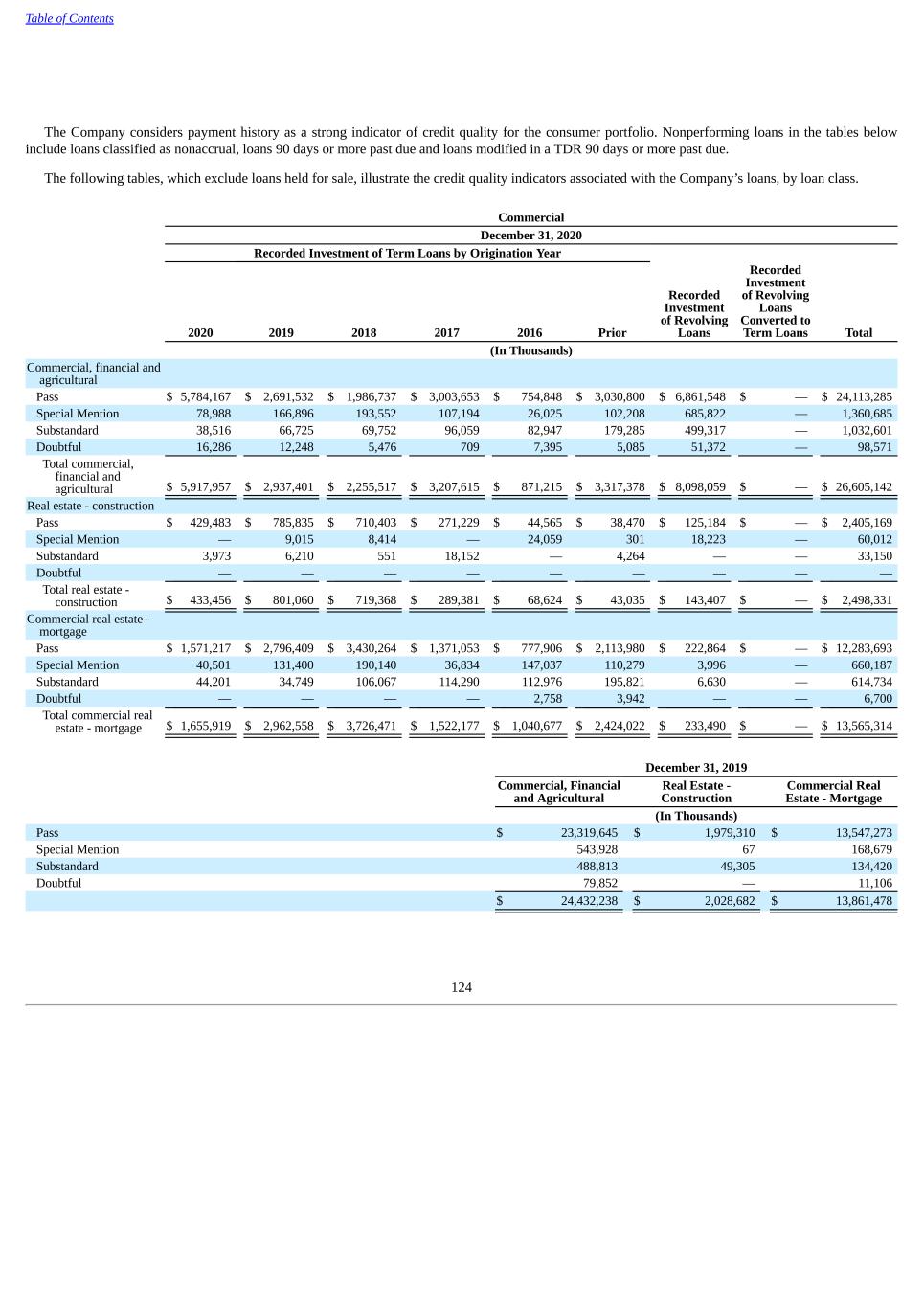
Table of Contents The Company considers payment history as a strong indicator of credit quality for the consumer portfolio. Nonperforming loans in the tables below include loans classified as nonaccrual, loans 90 days or more past due and loans modified in a TDR 90 days or more past due. The following tables, which exclude loans held for sale, illustrate the credit quality indicators associated with the Company’s loans, by loan class. Commercial December 31, 2020 Recorded Investment of Term Loans by Origination Year 2020 2019 2018 2017 2016 Prior Recorded Investment of Revolving Loans Recorded Investment of Revolving Loans Converted to Term Loans Total (In Thousands) Commercial, financial and agricultural Pass $ 5,784,167 $ 2,691,532 $ 1,986,737 $ 3,003,653 $ 754,848 $ 3,030,800 $ 6,861,548 $ — $ 24,113,285 Special Mention 78,988 166,896 193,552 107,194 26,025 102,208 685,822 — 1,360,685 Substandard 38,516 66,725 69,752 96,059 82,947 179,285 499,317 — 1,032,601 Doubtful 16,286 12,248 5,476 709 7,395 5,085 51,372 — 98,571 Total commercial, financial and agricultural $ 5,917,957 $ 2,937,401 $ 2,255,517 $ 3,207,615 $ 871,215 $ 3,317,378 $ 8,098,059 $ — $ 26,605,142 Real estate - construction Pass $ 429,483 $ 785,835 $ 710,403 $ 271,229 $ 44,565 $ 38,470 $ 125,184 $ — $ 2,405,169 Special Mention — 9,015 8,414 — 24,059 301 18,223 — 60,012 Substandard 3,973 6,210 551 18,152 — 4,264 — — 33,150 Doubtful — — — — — — — — — Total real estate - construction $ 433,456 $ 801,060 $ 719,368 $ 289,381 $ 68,624 $ 43,035 $ 143,407 $ — $ 2,498,331 Commercial real estate - mortgage Pass $ 1,571,217 $ 2,796,409 $ 3,430,264 $ 1,371,053 $ 777,906 $ 2,113,980 $ 222,864 $ — $ 12,283,693 Special Mention 40,501 131,400 190,140 36,834 147,037 110,279 3,996 — 660,187 Substandard 44,201 34,749 106,067 114,290 112,976 195,821 6,630 — 614,734 Doubtful — — — — 2,758 3,942 — — 6,700 Total commercial real estate - mortgage $ 1,655,919 $ 2,962,558 $ 3,726,471 $ 1,522,177 $ 1,040,677 $ 2,424,022 $ 233,490 $ — $ 13,565,314 December 31, 2019 Commercial, Financial and Agricultural Real Estate - Construction Commercial Real Estate - Mortgage (In Thousands) Pass $ 23,319,645 $ 1,979,310 $ 13,547,273 Special Mention 543,928 67 168,679 Substandard 488,813 49,305 134,420 Doubtful 79,852 — 11,106 $ 24,432,238 $ 2,028,682 $ 13,861,478 124
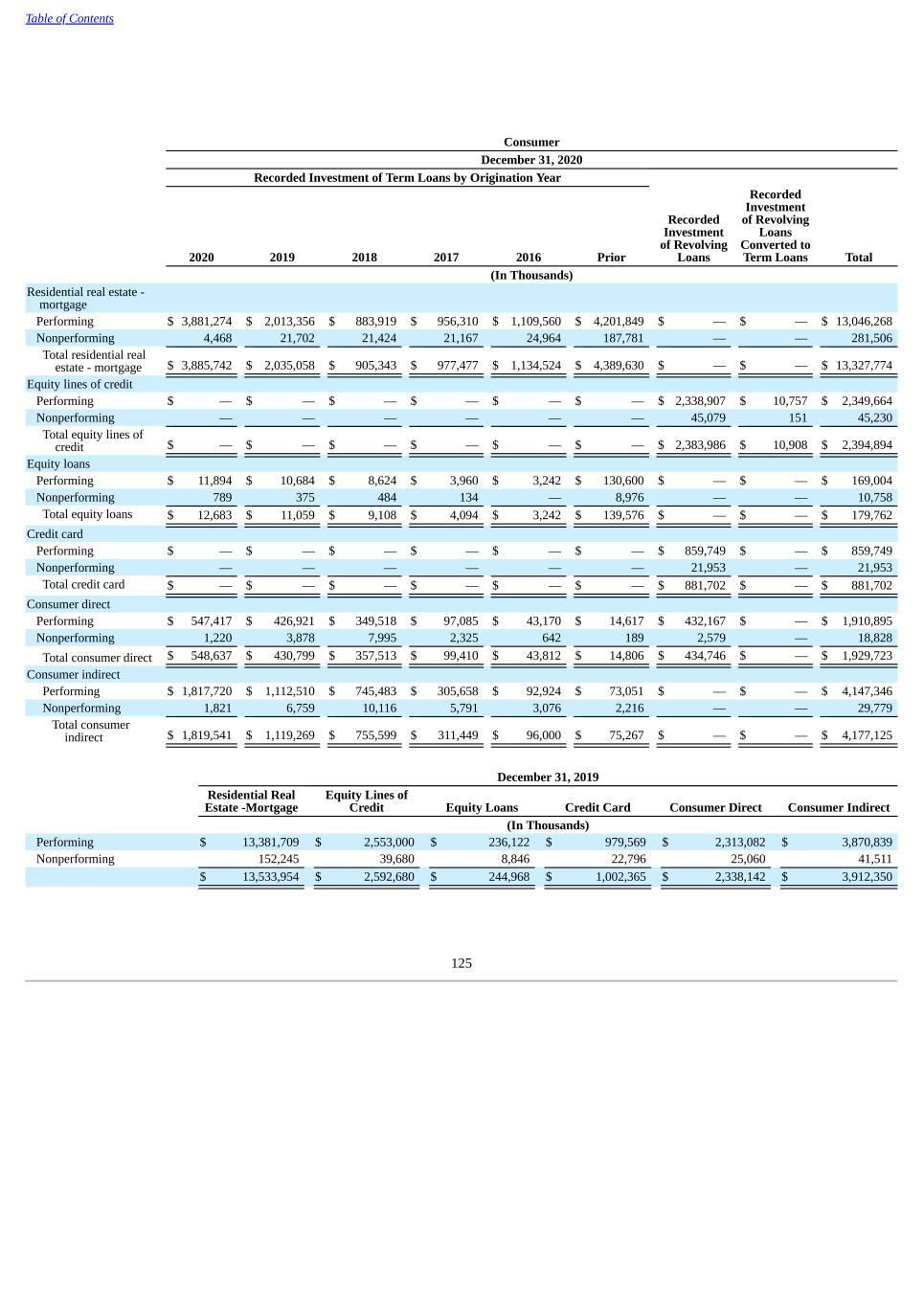
Table of Contents Consumer December 31, 2020 Recorded Investment of Term Loans by Origination Year 2020 2019 2018 2017 2016 Prior Recorded Investment of Revolving Loans Recorded Investment of Revolving Loans Converted to Term Loans Total (In Thousands) Residential real estate - mortgage Performing $ 3,881,274 $ 2,013,356 $ 883,919 $ 956,310 $ 1,109,560 $ 4,201,849 $ — $ — $ 13,046,268 Nonperforming 4,468 21,702 21,424 21,167 24,964 187,781 — — 281,506 Total residential real estate - mortgage $ 3,885,742 $ 2,035,058 $ 905,343 $ 977,477 $ 1,134,524 $ 4,389,630 $ — $ — $ 13,327,774 Equity lines of credit Performing $ — $ — $ — $ — $ — $ — $ 2,338,907 $ 10,757 $ 2,349,664 Nonperforming — — — — — — 45,079 151 45,230 Total equity lines of credit $ — $ — $ — $ — $ — $ — $ 2,383,986 $ 10,908 $ 2,394,894 Equity loans Performing $ 11,894 $ 10,684 $ 8,624 $ 3,960 $ 3,242 $ 130,600 $ — $ — $ 169,004 Nonperforming 789 375 484 134 — 8,976 — — 10,758 Total equity loans $ 12,683 $ 11,059 $ 9,108 $ 4,094 $ 3,242 $ 139,576 $ — $ — $ 179,762 Credit card Performing $ — $ — $ — $ — $ — $ — $ 859,749 $ — $ 859,749 Nonperforming — — — — — — 21,953 — 21,953 Total credit card $ — $ — $ — $ — $ — $ — $ 881,702 $ — $ 881,702 Consumer direct Performing $ 547,417 $ 426,921 $ 349,518 $ 97,085 $ 43,170 $ 14,617 $ 432,167 $ — $ 1,910,895 Nonperforming 1,220 3,878 7,995 2,325 642 189 2,579 — 18,828 Total consumer direct $ 548,637 $ 430,799 $ 357,513 $ 99,410 $ 43,812 $ 14,806 $ 434,746 $ — $ 1,929,723 Consumer indirect Performing $ 1,817,720 $ 1,112,510 $ 745,483 $ 305,658 $ 92,924 $ 73,051 $ — $ — $ 4,147,346 Nonperforming 1,821 6,759 10,116 5,791 3,076 2,216 — — 29,779 Total consumer indirect $ 1,819,541 $ 1,119,269 $ 755,599 $ 311,449 $ 96,000 $ 75,267 $ — $ — $ 4,177,125 December 31, 2019 Residential Real Estate -Mortgage Equity Lines of Credit Equity Loans Credit Card Consumer Direct Consumer Indirect (In Thousands) Performing $ 13,381,709 $ 2,553,000 $ 236,122 $ 979,569 $ 2,313,082 $ 3,870,839 Nonperforming 152,245 39,680 8,846 22,796 25,060 41,511 $ 13,533,954 $ 2,592,680 $ 244,968 $ 1,002,365 $ 2,338,142 $ 3,912,350 125
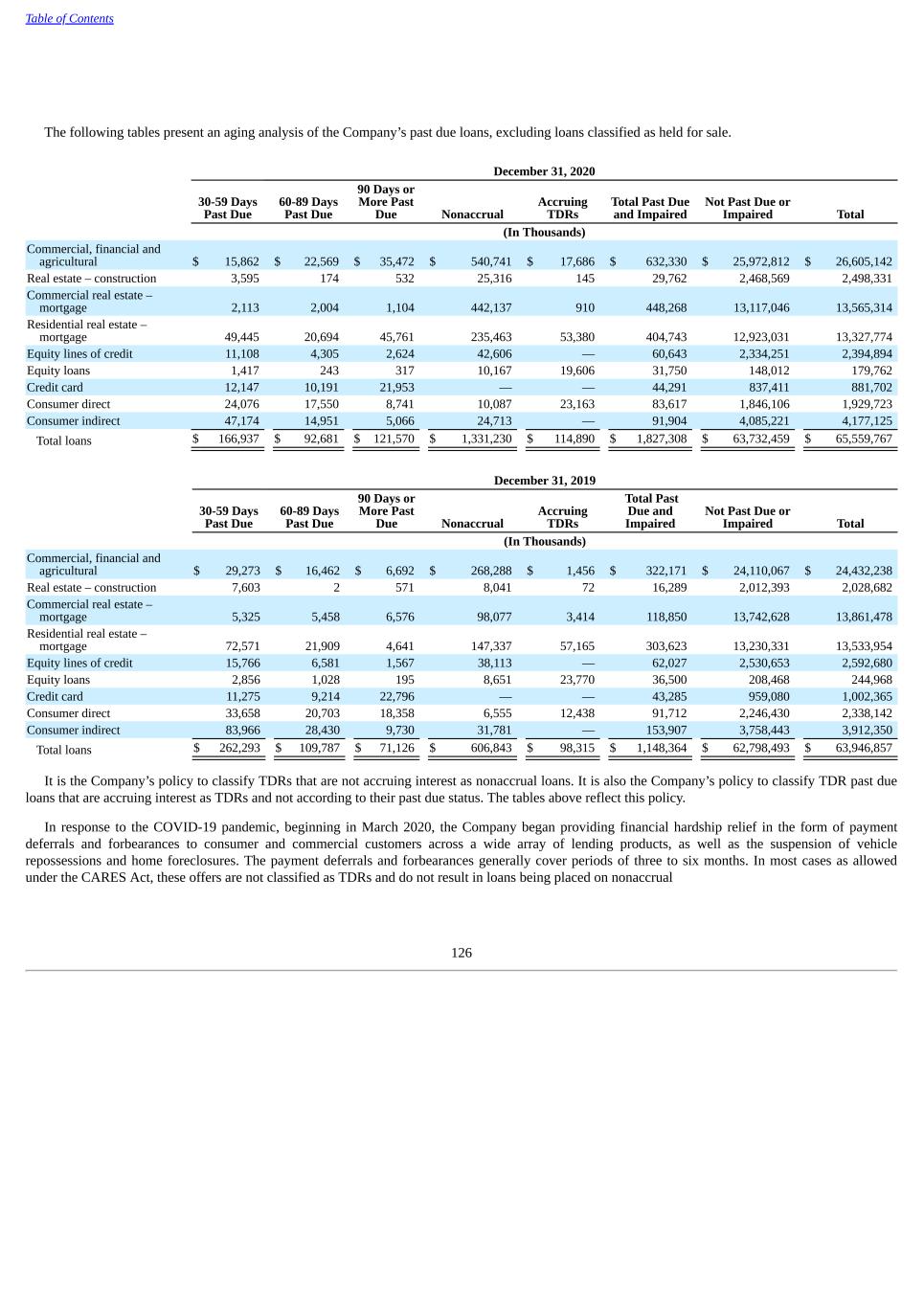
Table of Contents The following tables present an aging analysis of the Company’s past due loans, excluding loans classified as held for sale. December 31, 2020 30-59 Days Past Due 60-89 Days Past Due 90 Days or More Past Due Nonaccrual Accruing TDRs Total Past Due and Impaired Not Past Due or Impaired Total (In Thousands) Commercial, financial and agricultural $ 15,862 $ 22,569 $ 35,472 $ 540,741 $ 17,686 $ 632,330 $ 25,972,812 $ 26,605,142 Real estate – construction 3,595 174 532 25,316 145 29,762 2,468,569 2,498,331 Commercial real estate – mortgage 2,113 2,004 1,104 442,137 910 448,268 13,117,046 13,565,314 Residential real estate – mortgage 49,445 20,694 45,761 235,463 53,380 404,743 12,923,031 13,327,774 Equity lines of credit 11,108 4,305 2,624 42,606 — 60,643 2,334,251 2,394,894 Equity loans 1,417 243 317 10,167 19,606 31,750 148,012 179,762 Credit card 12,147 10,191 21,953 — — 44,291 837,411 881,702 Consumer direct 24,076 17,550 8,741 10,087 23,163 83,617 1,846,106 1,929,723 Consumer indirect 47,174 14,951 5,066 24,713 — 91,904 4,085,221 4,177,125 Total loans $ 166,937 $ 92,681 $ 121,570 $ 1,331,230 $ 114,890 $ 1,827,308 $ 63,732,459 $ 65,559,767 December 31, 2019 30-59 Days Past Due 60-89 Days Past Due 90 Days or More Past Due Nonaccrual Accruing TDRs Total Past Due and Impaired Not Past Due or Impaired Total (In Thousands) Commercial, financial and agricultural $ 29,273 $ 16,462 $ 6,692 $ 268,288 $ 1,456 $ 322,171 $ 24,110,067 $ 24,432,238 Real estate – construction 7,603 2 571 8,041 72 16,289 2,012,393 2,028,682 Commercial real estate – mortgage 5,325 5,458 6,576 98,077 3,414 118,850 13,742,628 13,861,478 Residential real estate – mortgage 72,571 21,909 4,641 147,337 57,165 303,623 13,230,331 13,533,954 Equity lines of credit 15,766 6,581 1,567 38,113 — 62,027 2,530,653 2,592,680 Equity loans 2,856 1,028 195 8,651 23,770 36,500 208,468 244,968 Credit card 11,275 9,214 22,796 — — 43,285 959,080 1,002,365 Consumer direct 33,658 20,703 18,358 6,555 12,438 91,712 2,246,430 2,338,142 Consumer indirect 83,966 28,430 9,730 31,781 — 153,907 3,758,443 3,912,350 Total loans $ 262,293 $ 109,787 $ 71,126 $ 606,843 $ 98,315 $ 1,148,364 $ 62,798,493 $ 63,946,857 It is the Company’s policy to classify TDRs that are not accruing interest as nonaccrual loans. It is also the Company’s policy to classify TDR past due loans that are accruing interest as TDRs and not according to their past due status. The tables above reflect this policy. In response to the COVID-19 pandemic, beginning in March 2020, the Company began providing financial hardship relief in the form of payment deferrals and forbearances to consumer and commercial customers across a wide array of lending products, as well as the suspension of vehicle repossessions and home foreclosures. The payment deferrals and forbearances generally cover periods of three to six months. In most cases as allowed under the CARES Act, these offers are not classified as TDRs and do not result in loans being placed on nonaccrual 126
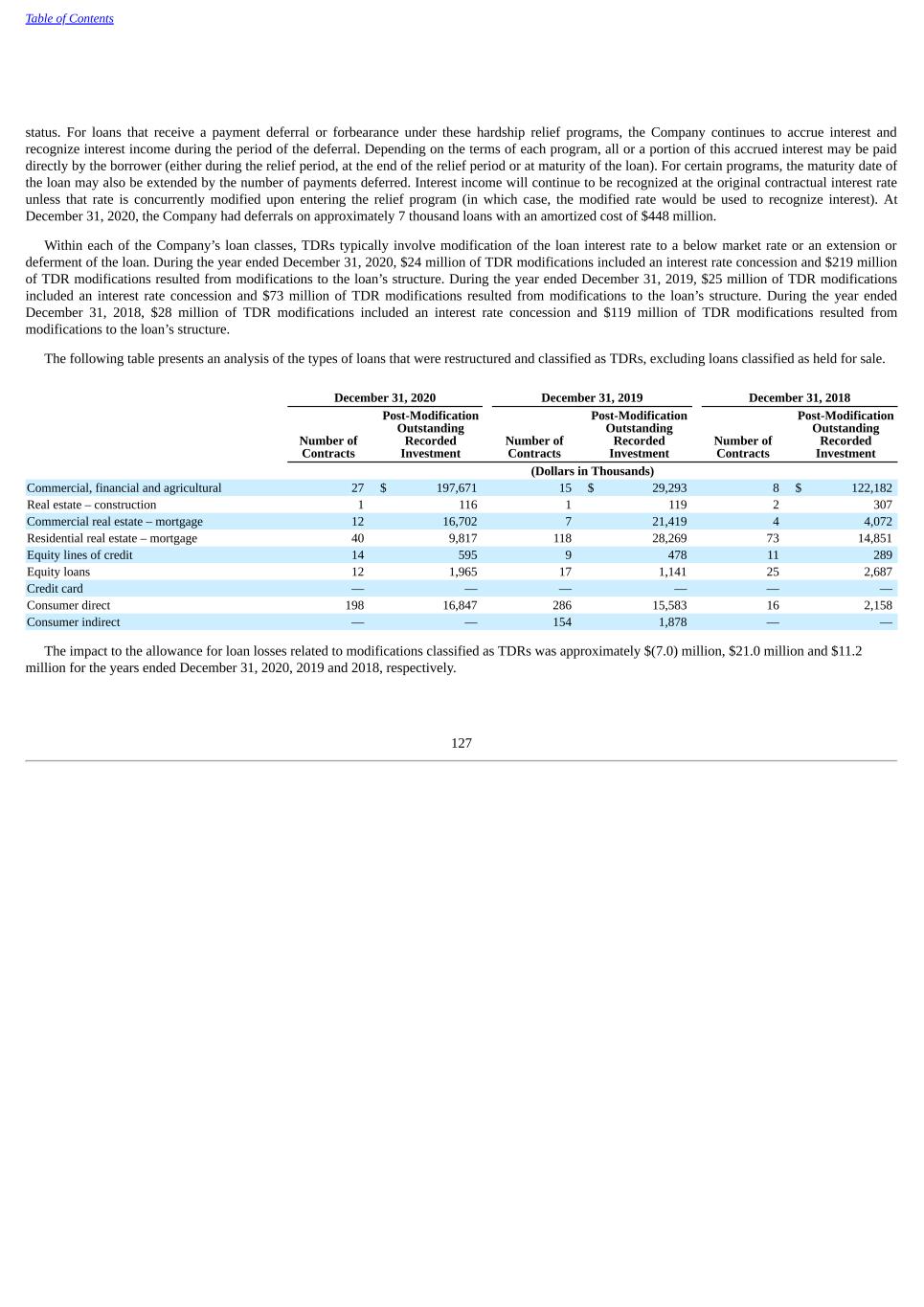
Table of Contents status. For loans that receive a payment deferral or forbearance under these hardship relief programs, the Company continues to accrue interest and recognize interest income during the period of the deferral. Depending on the terms of each program, all or a portion of this accrued interest may be paid directly by the borrower (either during the relief period, at the end of the relief period or at maturity of the loan). For certain programs, the maturity date of the loan may also be extended by the number of payments deferred. Interest income will continue to be recognized at the original contractual interest rate unless that rate is concurrently modified upon entering the relief program (in which case, the modified rate would be used to recognize interest). At December 31, 2020, the Company had deferrals on approximately 7 thousand loans with an amortized cost of $448 million. Within each of the Company’s loan classes, TDRs typically involve modification of the loan interest rate to a below market rate or an extension or deferment of the loan. During the year ended December 31, 2020, $24 million of TDR modifications included an interest rate concession and $219 million of TDR modifications resulted from modifications to the loan’s structure. During the year ended December 31, 2019, $25 million of TDR modifications included an interest rate concession and $73 million of TDR modifications resulted from modifications to the loan’s structure. During the year ended December 31, 2018, $28 million of TDR modifications included an interest rate concession and $119 million of TDR modifications resulted from modifications to the loan’s structure. The following table presents an analysis of the types of loans that were restructured and classified as TDRs, excluding loans classified as held for sale. December 31, 2020 December 31, 2019 December 31, 2018 Number of Contracts Post-Modification Outstanding Recorded Investment Number of Contracts Post-Modification Outstanding Recorded Investment Number of Contracts Post-Modification Outstanding Recorded Investment (Dollars in Thousands) Commercial, financial and agricultural 27 $ 197,671 15 $ 29,293 8 $ 122,182 Real estate – construction 1 116 1 119 2 307 Commercial real estate – mortgage 12 16,702 7 21,419 4 4,072 Residential real estate – mortgage 40 9,817 118 28,269 73 14,851 Equity lines of credit 14 595 9 478 11 289 Equity loans 12 1,965 17 1,141 25 2,687 Credit card — — — — — — Consumer direct 198 16,847 286 15,583 16 2,158 Consumer indirect — — 154 1,878 — — The impact to the allowance for loan losses related to modifications classified as TDRs was approximately $(7.0) million, $21.0 million and $11.2 million for the years ended December 31, 2020, 2019 and 2018, respectively. 127
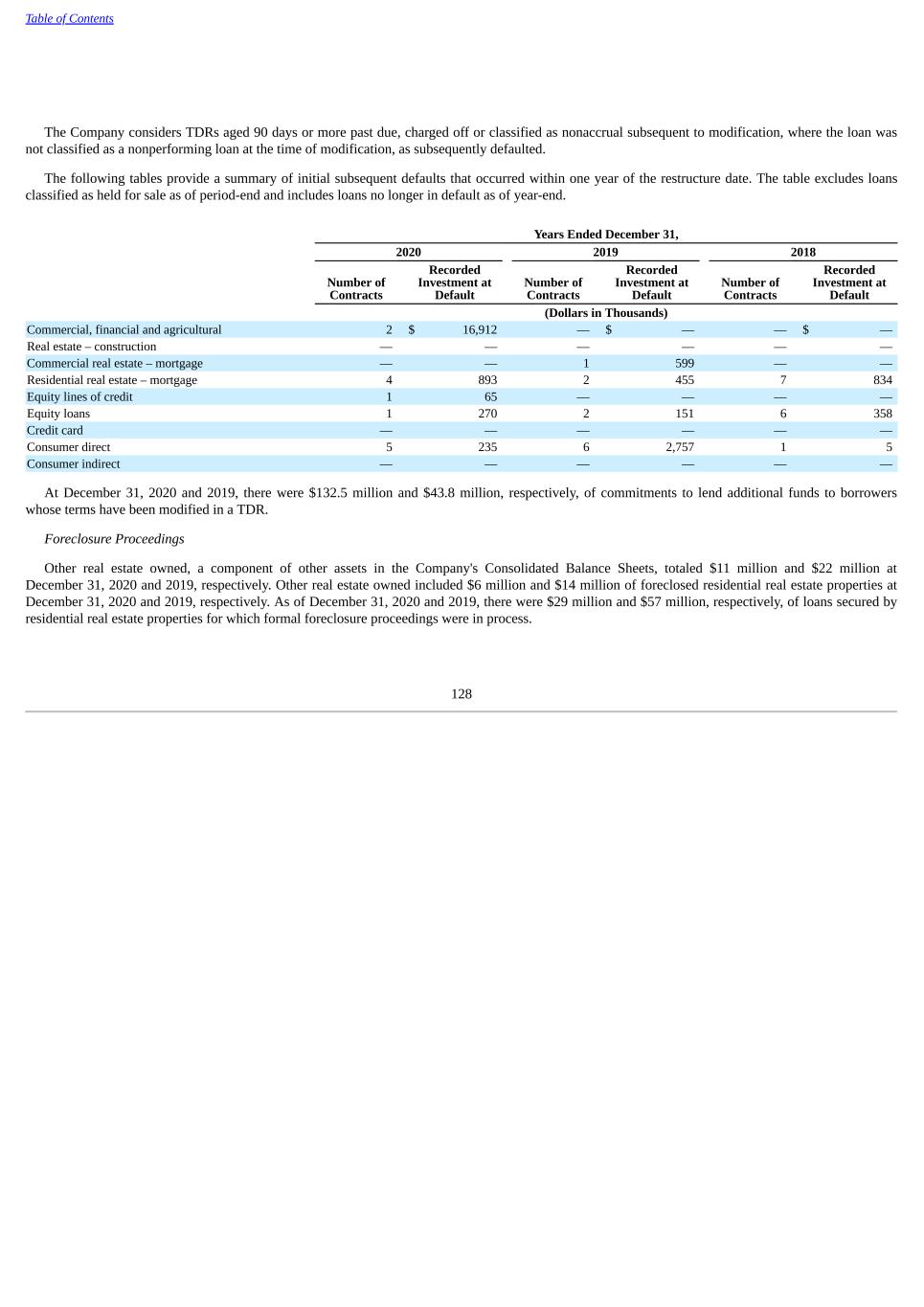
Table of Contents The Company considers TDRs aged 90 days or more past due, charged off or classified as nonaccrual subsequent to modification, where the loan was not classified as a nonperforming loan at the time of modification, as subsequently defaulted. The following tables provide a summary of initial subsequent defaults that occurred within one year of the restructure date. The table excludes loans classified as held for sale as of period-end and includes loans no longer in default as of year-end. Years Ended December 31, 2020 2019 2018 Number of Contracts Recorded Investment at Default Number of Contracts Recorded Investment at Default Number of Contracts Recorded Investment at Default (Dollars in Thousands) Commercial, financial and agricultural 2 $ 16,912 — $ — — $ — Real estate – construction — — — — — — Commercial real estate – mortgage — — 1 599 — — Residential real estate – mortgage 4 893 2 455 7 834 Equity lines of credit 1 65 — — — — Equity loans 1 270 2 151 6 358 Credit card — — — — — — Consumer direct 5 235 6 2,757 1 5 Consumer indirect — — — — — — At December 31, 2020 and 2019, there were $132.5 million and $43.8 million, respectively, of commitments to lend additional funds to borrowers whose terms have been modified in a TDR. Foreclosure Proceedings Other real estate owned, a component of other assets in the Company's Consolidated Balance Sheets, totaled $11 million and $22 million at December 31, 2020 and 2019, respectively. Other real estate owned included $6 million and $14 million of foreclosed residential real estate properties at December 31, 2020 and 2019, respectively. As of December 31, 2020 and 2019, there were $29 million and $57 million, respectively, of loans secured by residential real estate properties for which formal foreclosure proceedings were in process. 128
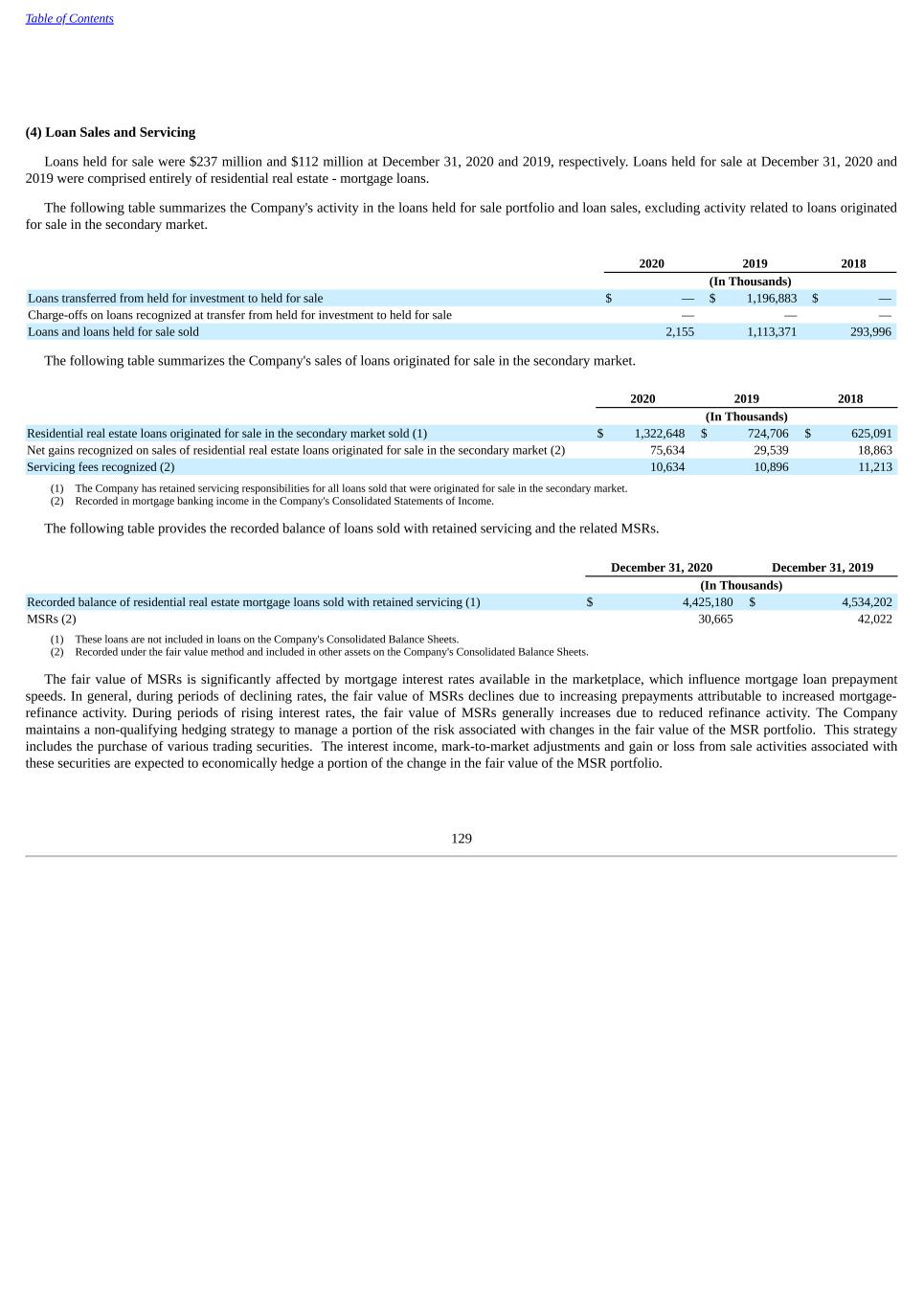
Table of Contents (4) Loan Sales and Servicing Loans held for sale were $237 million and $112 million at December 31, 2020 and 2019, respectively. Loans held for sale at December 31, 2020 and 2019 were comprised entirely of residential real estate - mortgage loans. The following table summarizes the Company's activity in the loans held for sale portfolio and loan sales, excluding activity related to loans originated for sale in the secondary market. 2020 2019 2018 (In Thousands) Loans transferred from held for investment to held for sale $ — $ 1,196,883 $ — Charge-offs on loans recognized at transfer from held for investment to held for sale — — — Loans and loans held for sale sold 2,155 1,113,371 293,996 The following table summarizes the Company's sales of loans originated for sale in the secondary market. 2020 2019 2018 (In Thousands) Residential real estate loans originated for sale in the secondary market sold (1) $ 1,322,648 $ 724,706 $ 625,091 Net gains recognized on sales of residential real estate loans originated for sale in the secondary market (2) 75,634 29,539 18,863 Servicing fees recognized (2) 10,634 10,896 11,213 (1) The Company has retained servicing responsibilities for all loans sold that were originated for sale in the secondary market. (2) Recorded in mortgage banking income in the Company's Consolidated Statements of Income. The following table provides the recorded balance of loans sold with retained servicing and the related MSRs. December 31, 2020 December 31, 2019 (In Thousands) Recorded balance of residential real estate mortgage loans sold with retained servicing (1) $ 4,425,180 $ 4,534,202 MSRs (2) 30,665 42,022 (1) These loans are not included in loans on the Company's Consolidated Balance Sheets. (2) Recorded under the fair value method and included in other assets on the Company's Consolidated Balance Sheets. The fair value of MSRs is significantly affected by mortgage interest rates available in the marketplace, which influence mortgage loan prepayment speeds. In general, during periods of declining rates, the fair value of MSRs declines due to increasing prepayments attributable to increased mortgage- refinance activity. During periods of rising interest rates, the fair value of MSRs generally increases due to reduced refinance activity. The Company maintains a non-qualifying hedging strategy to manage a portion of the risk associated with changes in the fair value of the MSR portfolio. This strategy includes the purchase of various trading securities. The interest income, mark-to-market adjustments and gain or loss from sale activities associated with these securities are expected to economically hedge a portion of the change in the fair value of the MSR portfolio. 129
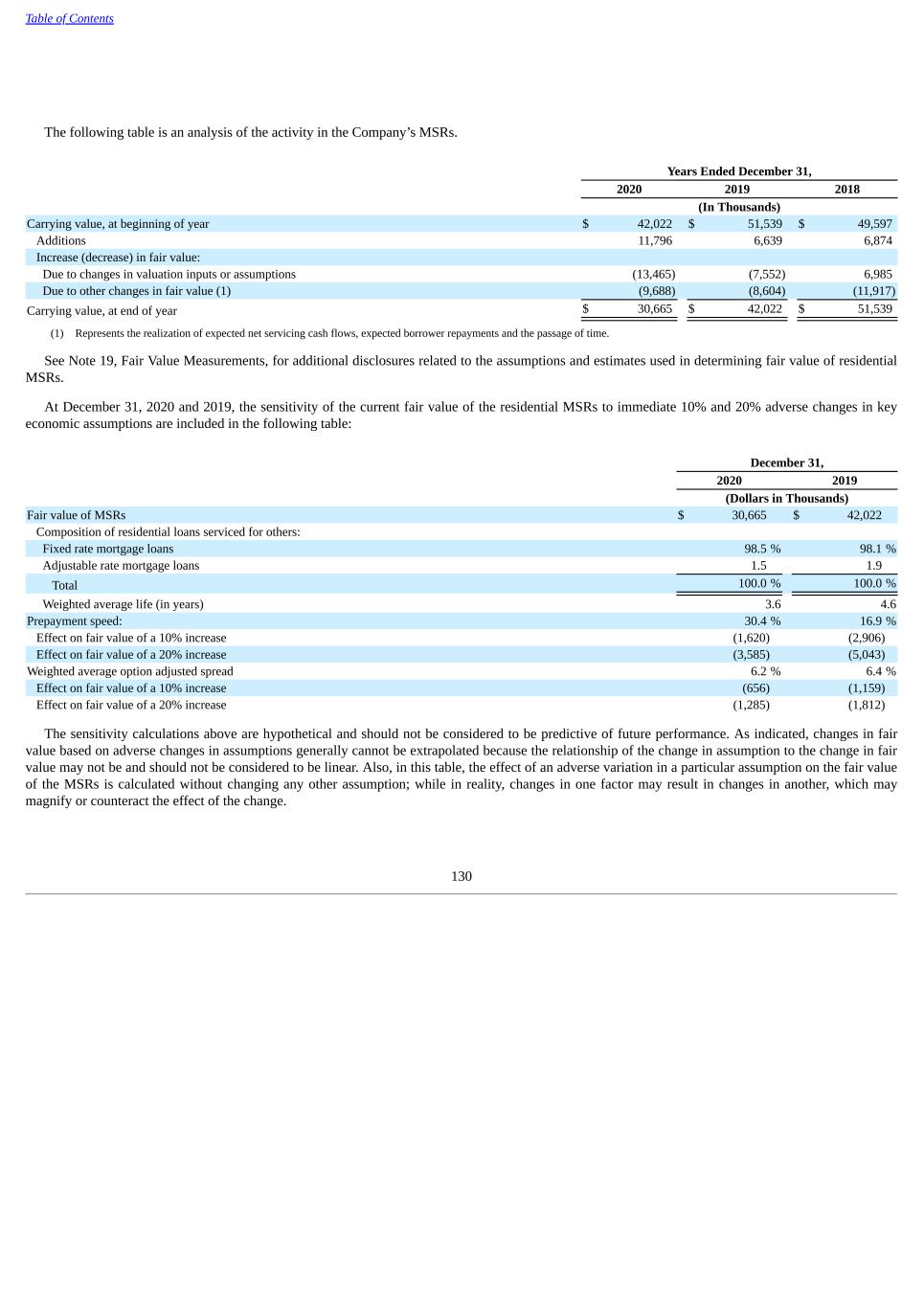
Table of Contents The following table is an analysis of the activity in the Company’s MSRs. Years Ended December 31, 2020 2019 2018 (In Thousands) Carrying value, at beginning of year $ 42,022 $ 51,539 $ 49,597 Additions 11,796 6,639 6,874 Increase (decrease) in fair value: Due to changes in valuation inputs or assumptions (13,465) (7,552) 6,985 Due to other changes in fair value (1) (9,688) (8,604) (11,917) Carrying value, at end of year $ 30,665 $ 42,022 $ 51,539 (1) Represents the realization of expected net servicing cash flows, expected borrower repayments and the passage of time. See Note 19, Fair Value Measurements, for additional disclosures related to the assumptions and estimates used in determining fair value of residential MSRs. At December 31, 2020 and 2019, the sensitivity of the current fair value of the residential MSRs to immediate 10% and 20% adverse changes in key economic assumptions are included in the following table: December 31, 2020 2019 (Dollars in Thousands) Fair value of MSRs $ 30,665 $ 42,022 Composition of residential loans serviced for others: Fixed rate mortgage loans 98.5 % 98.1 % Adjustable rate mortgage loans 1.5 1.9 Total 100.0 % 100.0 % Weighted average life (in years) 3.6 4.6 Prepayment speed: 30.4 % 16.9 % Effect on fair value of a 10% increase (1,620) (2,906) Effect on fair value of a 20% increase (3,585) (5,043) Weighted average option adjusted spread 6.2 % 6.4 % Effect on fair value of a 10% increase (656) (1,159) Effect on fair value of a 20% increase (1,285) (1,812) The sensitivity calculations above are hypothetical and should not be considered to be predictive of future performance. As indicated, changes in fair value based on adverse changes in assumptions generally cannot be extrapolated because the relationship of the change in assumption to the change in fair value may not be and should not be considered to be linear. Also, in this table, the effect of an adverse variation in a particular assumption on the fair value of the MSRs is calculated without changing any other assumption; while in reality, changes in one factor may result in changes in another, which may magnify or counteract the effect of the change. 130

Table of Contents (5) Premises and Equipment A summary of the Company’s premises and equipment is presented below. December 31, 2020 2019 (In Thousands) Land $ 295,915 $ 297,039 Buildings 588,031 580,911 Furniture, fixtures and equipment 460,987 425,794 Software 1,142,740 1,035,892 Leasehold improvements 205,865 203,776 Construction / projects in progress 117,154 128,816 2,810,692 2,672,228 Less: Accumulated depreciation and amortization 1,755,167 1,584,530 Total premises and equipment $ 1,055,525 $ 1,087,698 The Company recognized $184.2 million, $189.0 million and $198.4 million of depreciation expense related to the above premises and equipment for the years ended December 31, 2020, 2019 and 2018, respectively. (6) Leases The following table summarizes the Company’s lease portfolio classification and respective right-of-use asset balances and lease liability balances which are included in other assets and accrued expenses and other liabilities, respectively, on the Company’s Consolidated Balance Sheets. Finance Operating Total (In Thousands) December 31, 2020 Right-of-use asset $ 7,243 $ 264,111 $ 271,354 Lease liability balance 10,635 305,802 316,437 December 31, 2019 Right-of-use asset $ 8,566 $ 272,279 $ 280,845 Lease liability balance 12,339 313,398 325,737 The table below presents information about the Company's total lease costs which include amounts recognized on the Company’s Consolidated Statements of Income during the period. December 31, 2020 2019 (In Thousands) Interest on lease liabilities $ 529 $ 608 Amortization of right-of-use assets 1,323 1,323 Finance lease cost 1,852 1,931 Operating lease cost 48,418 48,316 Variable lease cost 16,757 16,537 Sublease income (6,764) (6,812) Total lease cost $ 60,263 59,972 The Company incurred lease expense of $86.8 million for the year ended December 31, 2018. The Company received lease income of $7.7 million for the year December 31, 2018 related to space leased to third parties. 131
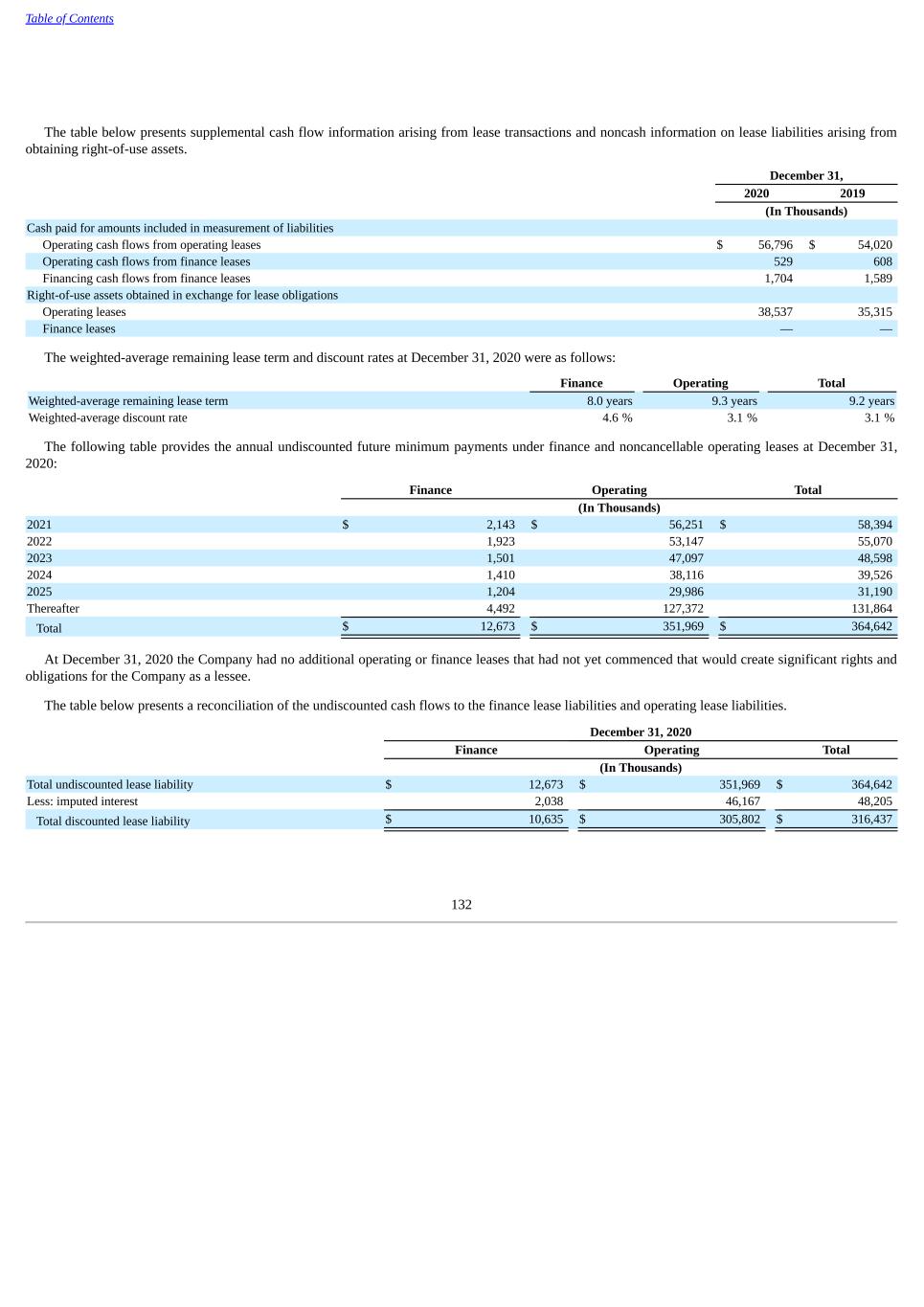
Table of Contents The table below presents supplemental cash flow information arising from lease transactions and noncash information on lease liabilities arising from obtaining right-of-use assets. December 31, 2020 2019 (In Thousands) Cash paid for amounts included in measurement of liabilities Operating cash flows from operating leases $ 56,796 $ 54,020 Operating cash flows from finance leases 529 608 Financing cash flows from finance leases 1,704 1,589 Right-of-use assets obtained in exchange for lease obligations Operating leases 38,537 35,315 Finance leases — — The weighted-average remaining lease term and discount rates at December 31, 2020 were as follows: Finance Operating Total Weighted-average remaining lease term 8.0 years 9.3 years 9.2 years Weighted-average discount rate 4.6 % 3.1 % 3.1 % The following table provides the annual undiscounted future minimum payments under finance and noncancellable operating leases at December 31, 2020: Finance Operating Total (In Thousands) 2021 $ 2,143 $ 56,251 $ 58,394 2022 1,923 53,147 55,070 2023 1,501 47,097 48,598 2024 1,410 38,116 39,526 2025 1,204 29,986 31,190 Thereafter 4,492 127,372 131,864 Total $ 12,673 $ 351,969 $ 364,642 At December 31, 2020 the Company had no additional operating or finance leases that had not yet commenced that would create significant rights and obligations for the Company as a lessee. The table below presents a reconciliation of the undiscounted cash flows to the finance lease liabilities and operating lease liabilities. December 31, 2020 Finance Operating Total (In Thousands) Total undiscounted lease liability $ 12,673 $ 351,969 $ 364,642 Less: imputed interest 2,038 46,167 48,205 Total discounted lease liability $ 10,635 $ 305,802 $ 316,437 132
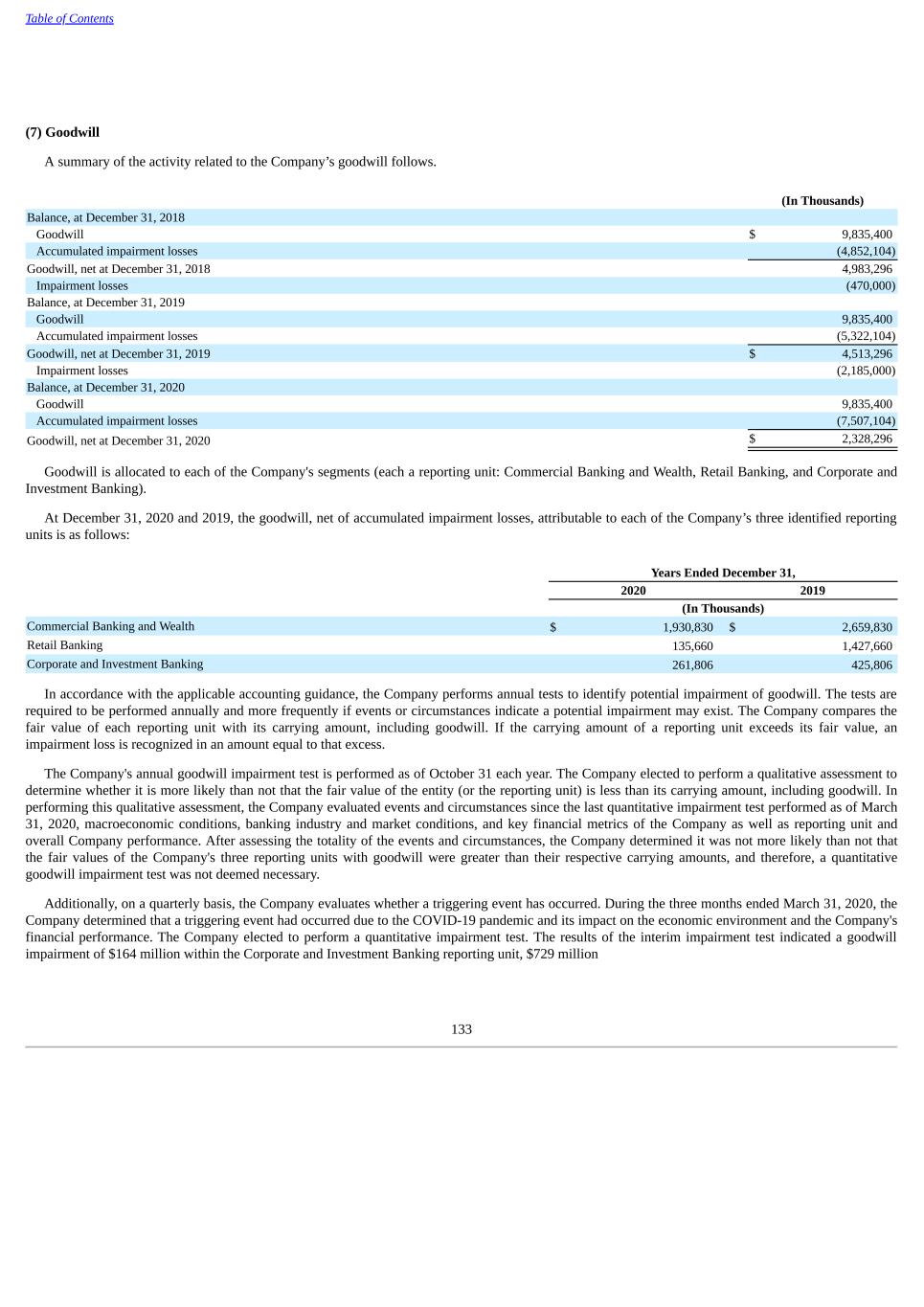
Table of Contents (7) Goodwill A summary of the activity related to the Company’s goodwill follows. (In Thousands) Balance, at December 31, 2018 Goodwill $ 9,835,400 Accumulated impairment losses (4,852,104) Goodwill, net at December 31, 2018 4,983,296 Impairment losses (470,000) Balance, at December 31, 2019 Goodwill 9,835,400 Accumulated impairment losses (5,322,104) Goodwill, net at December 31, 2019 $ 4,513,296 Impairment losses (2,185,000) Balance, at December 31, 2020 Goodwill 9,835,400 Accumulated impairment losses (7,507,104) Goodwill, net at December 31, 2020 $ 2,328,296 Goodwill is allocated to each of the Company's segments (each a reporting unit: Commercial Banking and Wealth, Retail Banking, and Corporate and Investment Banking). At December 31, 2020 and 2019, the goodwill, net of accumulated impairment losses, attributable to each of the Company’s three identified reporting units is as follows: Years Ended December 31, 2020 2019 (In Thousands) Commercial Banking and Wealth $ 1,930,830 $ 2,659,830 Retail Banking 135,660 1,427,660 Corporate and Investment Banking 261,806 425,806 In accordance with the applicable accounting guidance, the Company performs annual tests to identify potential impairment of goodwill. The tests are required to be performed annually and more frequently if events or circumstances indicate a potential impairment may exist. The Company compares the fair value of each reporting unit with its carrying amount, including goodwill. If the carrying amount of a reporting unit exceeds its fair value, an impairment loss is recognized in an amount equal to that excess. The Company's annual goodwill impairment test is performed as of October 31 each year. The Company elected to perform a qualitative assessment to determine whether it is more likely than not that the fair value of the entity (or the reporting unit) is less than its carrying amount, including goodwill. In performing this qualitative assessment, the Company evaluated events and circumstances since the last quantitative impairment test performed as of March 31, 2020, macroeconomic conditions, banking industry and market conditions, and key financial metrics of the Company as well as reporting unit and overall Company performance. After assessing the totality of the events and circumstances, the Company determined it was not more likely than not that the fair values of the Company's three reporting units with goodwill were greater than their respective carrying amounts, and therefore, a quantitative goodwill impairment test was not deemed necessary. Additionally, on a quarterly basis, the Company evaluates whether a triggering event has occurred. During the three months ended March 31, 2020, the Company determined that a triggering event had occurred due to the COVID-19 pandemic and its impact on the economic environment and the Company's financial performance. The Company elected to perform a quantitative impairment test. The results of the interim impairment test indicated a goodwill impairment of $164 million within the Corporate and Investment Banking reporting unit, $729 million 133

Table of Contents within the Commercial Banking and Wealth reporting unit, and $1.3 billion within the Retail Banking reporting unit resulting in the Company recording a goodwill impairment charge of $2.2 billion for the three months ended March 31, 2020. The primary causes of the goodwill impairment were economic and industry conditions, volatility in the market capitalization of U.S. banks, and management's downward revisions to financial projections that resulted in the fair value of the reporting units being less than the carrying value of the reporting units. The estimated fair value of the reporting units were determined using a blend of both income and market approaches. For the income approach, estimated future cash flows and terminal values are discounted. In estimating future cash flows, a balance sheet as of the test date and a statement of income for the last 12 months of activity for each reporting unit is compiled. From that point, future balance sheets and statements of income are projected based on the inputs. Due to the economic uncertainty due to the COVID-19 pandemic, at March 31, 2020, the Company projected multiple scenarios and then probability weighted those scenarios. The Company uses the guideline public company method and the guideline transaction method as the market approaches. The public company method applies valuation multiples derived from each reporting unit's peer group to tangible book value or earnings and an implied control premium to the respective reporting unit. The control premium is evaluated and compared to similar financial services transactions considering the absolute and relative potential revenue synergies and cost savings. The guideline transaction method applies valuation multiples to a financial metric of the reporting unit based on comparable observed purchase transactions in the financial services industry for the reporting unit, where available. The Company recognized goodwill impairment of $470 million within the Corporate and Investment Banking reporting unit during the year ended December 31, 2019 and no impairment in the year ended December 31, 2018. Through December 31, 2020, the Company had recognized accumulated goodwill impairment losses of $3.2 billion, $2.7 billion, and $883 million within the Commercial Banking and Wealth, Retail Banking, and Corporate and Investment Banking reporting units, respectively. In addition, the Company has previously recognized $784 million of accumulated goodwill impairment losses from reporting units that no longer have a goodwill balance. For the quarters ended June 30, 2020 and September 30, 2020, the Company concluded that a trigger event had not occurred as events or circumstances had not changed that indicated that the fair value of the entity (or the reporting unit) may be below its carrying amount since March 31, 2020 based on those contemplated when impairment was recorded. Consideration of events or circumstances are similar to those evaluated in the qualitative assessment described above. The fair values of the reporting units are based upon management’s estimates and assumptions. Although management has used the estimates and assumptions it believes to be most appropriate in the circumstances, it should be noted that even relatively minor changes in certain valuation assumptions used in management’s calculations could result in significant differences in the results of the impairment tests. (8) Deposits Time deposits of $250,000 or less totaled $3.1 billion at December 31, 2020, while time deposits of more than $250,000 totaled $1.6 billion. At December 31, 2020, the scheduled maturities of time deposits were as follows. (In Thousands) 2021 $ 4,193,411 2022 334,089 2023 97,390 2024 29,570 2025 25,869 Thereafter 4,700 Total $ 4,685,029 At December 31, 2020 and 2019, demand deposit overdrafts reclassified to loans totaled $13 million and $17 million, respectively. In addition to the securities and loans the Company has pledged as collateral to secure public 134
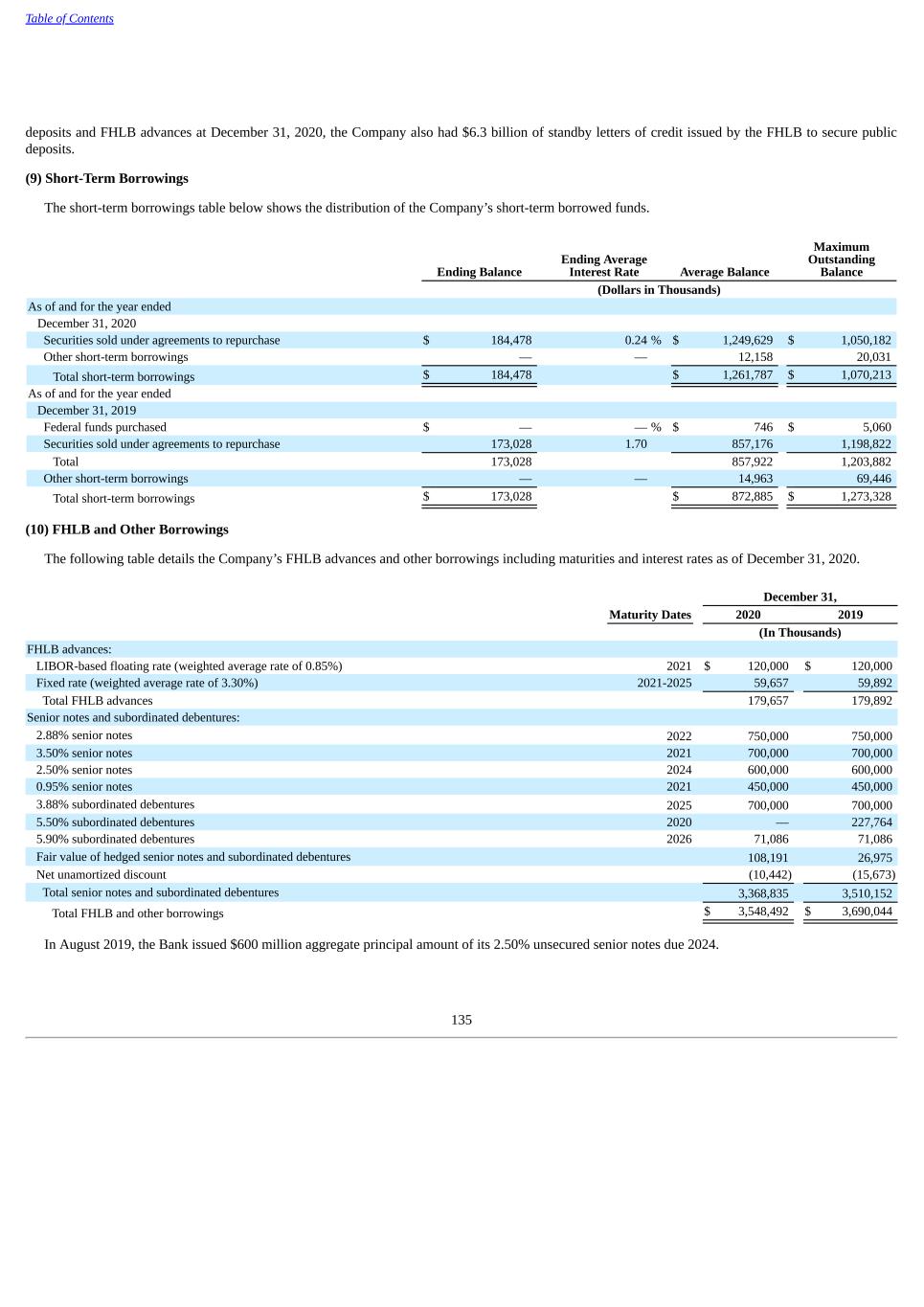
Table of Contents deposits and FHLB advances at December 31, 2020, the Company also had $6.3 billion of standby letters of credit issued by the FHLB to secure public deposits. (9) Short-Term Borrowings The short-term borrowings table below shows the distribution of the Company’s short-term borrowed funds. Ending Balance Ending Average Interest Rate Average Balance Maximum Outstanding Balance (Dollars in Thousands) As of and for the year ended December 31, 2020 Securities sold under agreements to repurchase $ 184,478 0.24 % $ 1,249,629 $ 1,050,182 Other short-term borrowings — — 12,158 20,031 Total short-term borrowings $ 184,478 $ 1,261,787 $ 1,070,213 As of and for the year ended December 31, 2019 Federal funds purchased $ — — % $ 746 $ 5,060 Securities sold under agreements to repurchase 173,028 1.70 857,176 1,198,822 Total 173,028 857,922 1,203,882 Other short-term borrowings — — 14,963 69,446 Total short-term borrowings $ 173,028 $ 872,885 $ 1,273,328 (10) FHLB and Other Borrowings The following table details the Company’s FHLB advances and other borrowings including maturities and interest rates as of December 31, 2020. December 31, Maturity Dates 2020 2019 (In Thousands) FHLB advances: LIBOR-based floating rate (weighted average rate of 0.85%) 2021 $ 120,000 $ 120,000 Fixed rate (weighted average rate of 3.30%) 2021-2025 59,657 59,892 Total FHLB advances 179,657 179,892 Senior notes and subordinated debentures: 2.88% senior notes 2022 750,000 750,000 3.50% senior notes 2021 700,000 700,000 2.50% senior notes 2024 600,000 600,000 0.95% senior notes 2021 450,000 450,000 3.88% subordinated debentures 2025 700,000 700,000 5.50% subordinated debentures 2020 — 227,764 5.90% subordinated debentures 2026 71,086 71,086 Fair value of hedged senior notes and subordinated debentures 108,191 26,975 Net unamortized discount (10,442) (15,673) Total senior notes and subordinated debentures 3,368,835 3,510,152 Total FHLB and other borrowings $ 3,548,492 $ 3,690,044 In August 2019, the Bank issued $600 million aggregate principal amount of its 2.50% unsecured senior notes due 2024. 135
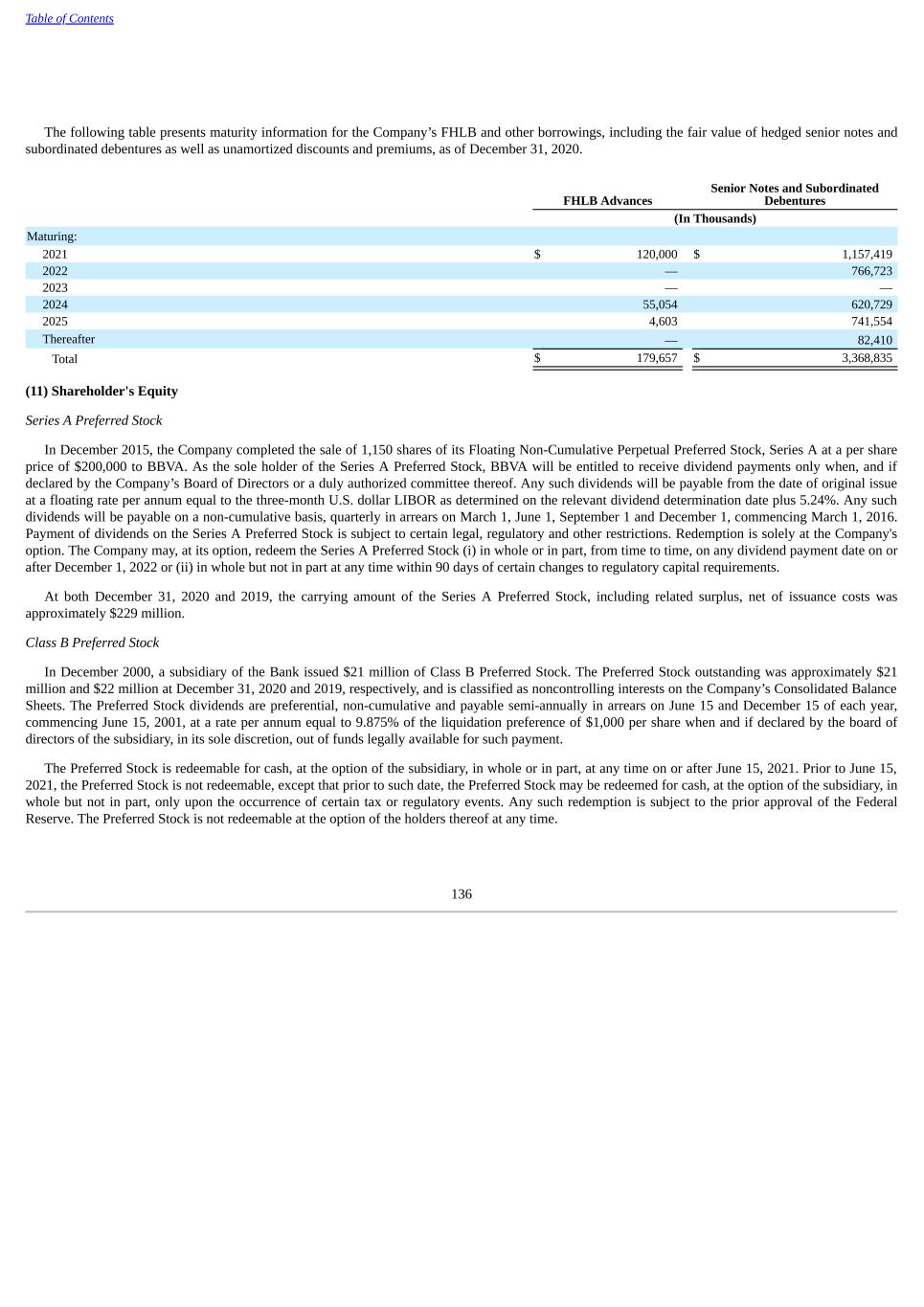
Table of Contents The following table presents maturity information for the Company’s FHLB and other borrowings, including the fair value of hedged senior notes and subordinated debentures as well as unamortized discounts and premiums, as of December 31, 2020. FHLB Advances Senior Notes and Subordinated Debentures (In Thousands) Maturing: 2021 $ 120,000 $ 1,157,419 2022 — 766,723 2023 — — 2024 55,054 620,729 2025 4,603 741,554 Thereafter — 82,410 Total $ 179,657 $ 3,368,835 (11) Shareholder's Equity Series A Preferred Stock In December 2015, the Company completed the sale of 1,150 shares of its Floating Non-Cumulative Perpetual Preferred Stock, Series A at a per share price of $200,000 to BBVA. As the sole holder of the Series A Preferred Stock, BBVA will be entitled to receive dividend payments only when, and if declared by the Company’s Board of Directors or a duly authorized committee thereof. Any such dividends will be payable from the date of original issue at a floating rate per annum equal to the three-month U.S. dollar LIBOR as determined on the relevant dividend determination date plus 5.24%. Any such dividends will be payable on a non-cumulative basis, quarterly in arrears on March 1, June 1, September 1 and December 1, commencing March 1, 2016. Payment of dividends on the Series A Preferred Stock is subject to certain legal, regulatory and other restrictions. Redemption is solely at the Company's option. The Company may, at its option, redeem the Series A Preferred Stock (i) in whole or in part, from time to time, on any dividend payment date on or after December 1, 2022 or (ii) in whole but not in part at any time within 90 days of certain changes to regulatory capital requirements. At both December 31, 2020 and 2019, the carrying amount of the Series A Preferred Stock, including related surplus, net of issuance costs was approximately $229 million. Class B Preferred Stock In December 2000, a subsidiary of the Bank issued $21 million of Class B Preferred Stock. The Preferred Stock outstanding was approximately $21 million and $22 million at December 31, 2020 and 2019, respectively, and is classified as noncontrolling interests on the Company’s Consolidated Balance Sheets. The Preferred Stock dividends are preferential, non-cumulative and payable semi-annually in arrears on June 15 and December 15 of each year, commencing June 15, 2001, at a rate per annum equal to 9.875% of the liquidation preference of $1,000 per share when and if declared by the board of directors of the subsidiary, in its sole discretion, out of funds legally available for such payment. The Preferred Stock is redeemable for cash, at the option of the subsidiary, in whole or in part, at any time on or after June 15, 2021. Prior to June 15, 2021, the Preferred Stock is not redeemable, except that prior to such date, the Preferred Stock may be redeemed for cash, at the option of the subsidiary, in whole but not in part, only upon the occurrence of certain tax or regulatory events. Any such redemption is subject to the prior approval of the Federal Reserve. The Preferred Stock is not redeemable at the option of the holders thereof at any time. 136
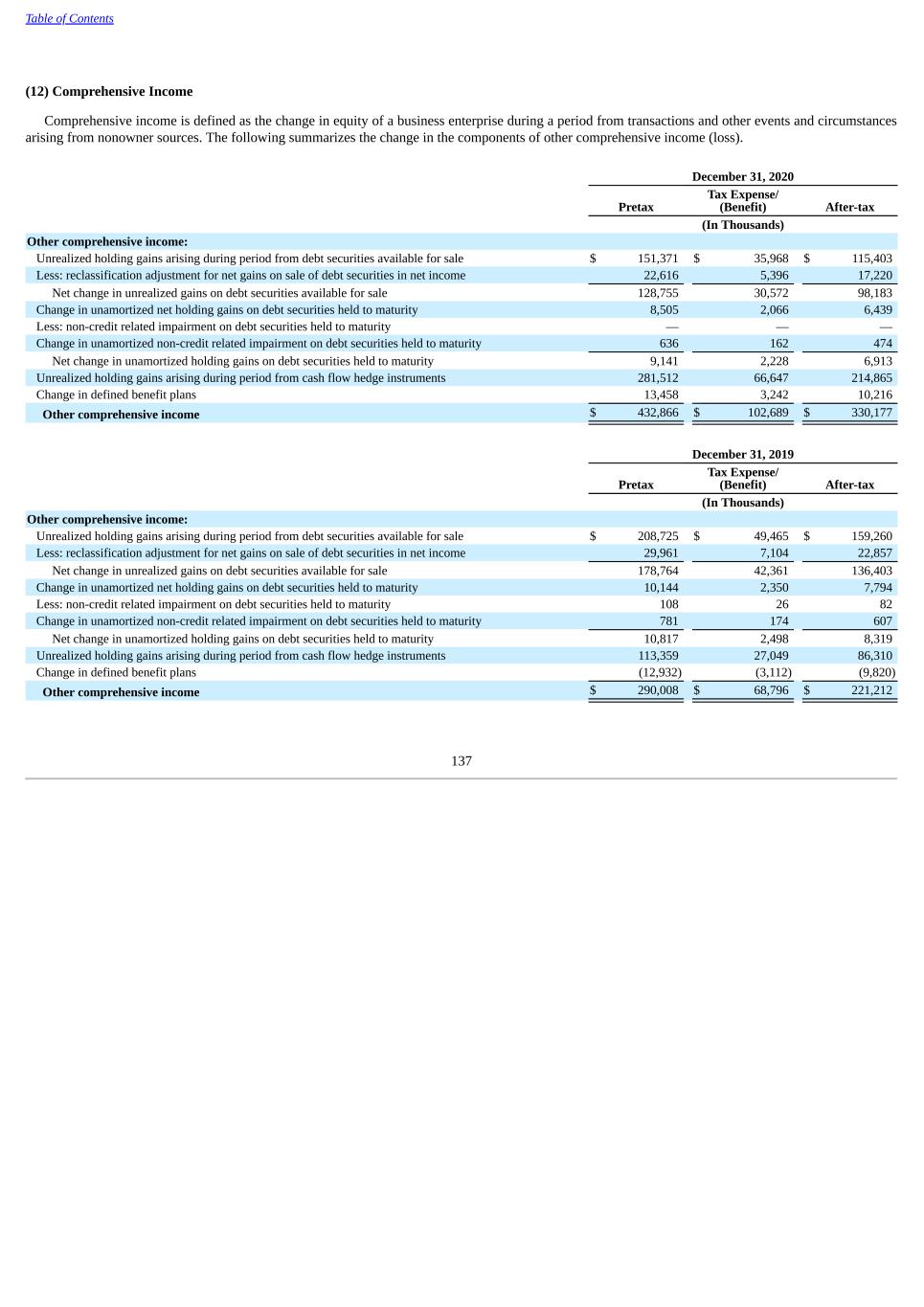
Table of Contents (12) Comprehensive Income Comprehensive income is defined as the change in equity of a business enterprise during a period from transactions and other events and circumstances arising from nonowner sources. The following summarizes the change in the components of other comprehensive income (loss). December 31, 2020 Pretax Tax Expense/ (Benefit) After-tax (In Thousands) Other comprehensive income: Unrealized holding gains arising during period from debt securities available for sale $ 151,371 $ 35,968 $ 115,403 Less: reclassification adjustment for net gains on sale of debt securities in net income 22,616 5,396 17,220 Net change in unrealized gains on debt securities available for sale 128,755 30,572 98,183 Change in unamortized net holding gains on debt securities held to maturity 8,505 2,066 6,439 Less: non-credit related impairment on debt securities held to maturity — — — Change in unamortized non-credit related impairment on debt securities held to maturity 636 162 474 Net change in unamortized holding gains on debt securities held to maturity 9,141 2,228 6,913 Unrealized holding gains arising during period from cash flow hedge instruments 281,512 66,647 214,865 Change in defined benefit plans 13,458 3,242 10,216 Other comprehensive income $ 432,866 $ 102,689 $ 330,177 December 31, 2019 Pretax Tax Expense/ (Benefit) After-tax (In Thousands) Other comprehensive income: Unrealized holding gains arising during period from debt securities available for sale $ 208,725 $ 49,465 $ 159,260 Less: reclassification adjustment for net gains on sale of debt securities in net income 29,961 7,104 22,857 Net change in unrealized gains on debt securities available for sale 178,764 42,361 136,403 Change in unamortized net holding gains on debt securities held to maturity 10,144 2,350 7,794 Less: non-credit related impairment on debt securities held to maturity 108 26 82 Change in unamortized non-credit related impairment on debt securities held to maturity 781 174 607 Net change in unamortized holding gains on debt securities held to maturity 10,817 2,498 8,319 Unrealized holding gains arising during period from cash flow hedge instruments 113,359 27,049 86,310 Change in defined benefit plans (12,932) (3,112) (9,820) Other comprehensive income $ 290,008 $ 68,796 $ 221,212 137

Table of Contents December 31, 2018 Pretax Tax Expense/ (Benefit) After-tax (In Thousands) Other comprehensive income: Unrealized holding losses arising during period from debt securities available for sale $ (2,925) $ (797) $ (2,128) Less: reclassification adjustment for net gains on sale of debt securities in net income — — — Net change in unrealized losses on debt securities available for sale (2,925) (797) (2,128) Change in unamortized net holding gains on debt securities held to maturity 9,120 2,104 7,016 Unamortized unrealized net holding losses on debt securities available for sale transferred to debt securities held to maturity (39,904) (9,417) (30,487) Less: non-credit related impairment on debt securities held to maturity 397 94 303 Change in unamortized non-credit related impairment on debt securities held to maturity 1,036 237 799 Net change in unamortized holding losses on debt securities held to maturity (30,145) (7,170) (22,975) Unrealized holding gains arising during period from cash flow hedge instruments 46,406 15,466 30,940 Change in defined benefit plans 6,142 1,409 4,733 Other comprehensive income $ 19,478 $ 8,908 $ 10,570 Activity in accumulated other comprehensive income (loss), net of tax, was as follows: Unrealized Gains (Losses) on Debt Securities Available for Sale and Transferred to Held to Maturity Accumulated Gains (Losses) on Cash Flow Hedging Instruments Defined Benefit Plan Adjustment Unamortized Impairment Losses on Debt Securities Held to Maturity Total (In Thousands) Balance, December 31, 2018 $ (158,433) $ 6,175 $ (29,495) $ (5,095) $ (186,848) Cumulative effect of adoption of ASUs (1) (25,844) (1,040) (7,351) (1,201) (35,436) $ (184,277) $ 5,135 $ (36,846) $ (6,296) $ (222,284) Other comprehensive income (loss) before reclassifications 159,260 83,903 — (82) 243,081 Amounts reclassified from accumulated other comprehensive (loss) income (15,063) 2,407 (9,820) 607 (21,869) Net current period other comprehensive income (loss) 144,197 86,310 (9,820) 525 221,212 Balance, December 31, 2019 $ (40,080) $ 91,445 $ (46,666) $ (5,771) $ (1,072) Balance, December 31, 2019 $ (40,080) $ 91,445 $ (46,666) $ (5,771) $ (1,072) Other comprehensive income before reclassifications 115,403 310,170 — — 425,573 Amounts reclassified from accumulated other comprehensive income (loss) (10,781) (95,305) 10,216 474 (95,396) Net current period other comprehensive income 104,622 214,865 10,216 474 330,177 Balance, December 31, 2020 $ 64,542 $ 306,310 $ (36,450) $ (5,297) $ 329,105 (1) Related to the Company's adoption of ASU 2017-12 and ASU 2018-02 on January 1, 2019. See Note 1, Summary of Significant Accounting Policies, for additional information. 138

Table of Contents The following table presents information on reclassifications out of accumulated other comprehensive income. Details About Accumulated Other Comprehensive Income Components Amounts Reclassified From Accumulated Other Comprehensive Income (1) Consolidated Statement of Income Caption December 31, 2020 December 31, 2019 December 31, 2018 (In Thousands) Unrealized Gains (Losses) on Debt Securities Available for Sale and Transferred to Held to Maturity $ 22,616 $ 29,961 $ — Investment securities gains, net (8,505) (10,144) (9,120) Interest on debt securities held to maturity 14,111 19,817 (9,120) (3,330) (4,754) 2,104 Income tax (expense) benefit $ 10,781 $ 15,063 $ (7,016) Net of tax Accumulated Gains (Losses) on Cash Flow Hedging Instruments $ 127,716 $ (2,214) $ (45,027) Interest and fees on loans (2,758) (948) (1,288) Interest on FHLB and other borrowings 124,958 (3,162) (46,315) (29,653) 755 10,981 Income tax (expense) benefit $ 95,305 $ (2,407) $ (35,334) Net of tax Defined Benefit Plan Adjustment $ (13,458) $ 12,932 $ (6,142) (2) 3,242 (3,112) 1,409 Income tax benefit (expense) $ (10,216) $ 9,820 $ (4,733) Net of tax Unamortized Impairment Losses on Debt Securities Held to Maturity $ (636) $ (781) $ (1,036) Interest on debt securities held to maturity 162 174 237 Income tax benefit $ (474) $ (607) $ (799) Net of tax (1) Amounts in parentheses indicate debits to the Consolidated Statements of Income. (2) These accumulated other comprehensive income components are included in the computation of net periodic pension cost (see Note 17, Benefit Plans, for additional details). 139
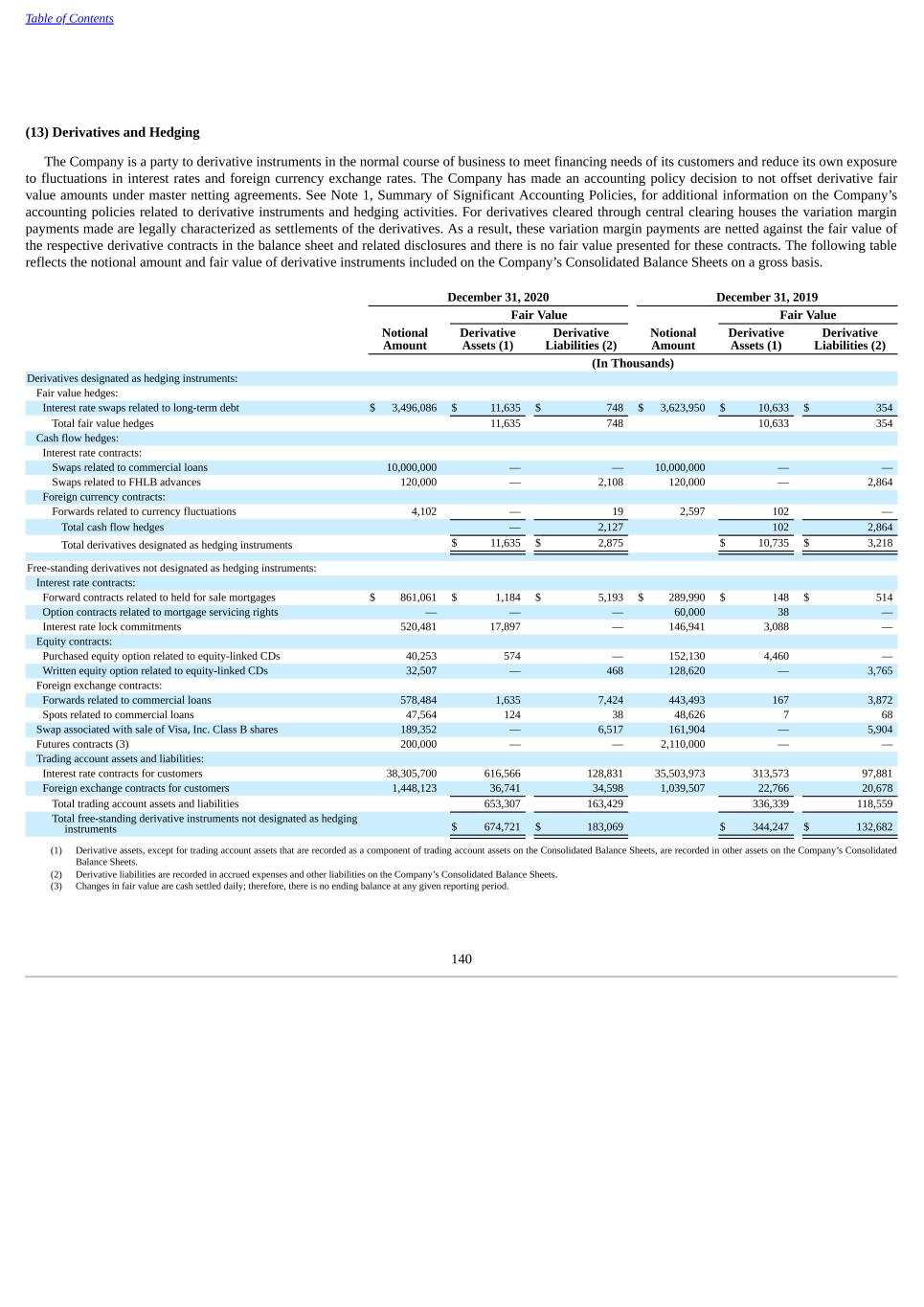
Table of Contents (13) Derivatives and Hedging The Company is a party to derivative instruments in the normal course of business to meet financing needs of its customers and reduce its own exposure to fluctuations in interest rates and foreign currency exchange rates. The Company has made an accounting policy decision to not offset derivative fair value amounts under master netting agreements. See Note 1, Summary of Significant Accounting Policies, for additional information on the Company’s accounting policies related to derivative instruments and hedging activities. For derivatives cleared through central clearing houses the variation margin payments made are legally characterized as settlements of the derivatives. As a result, these variation margin payments are netted against the fair value of the respective derivative contracts in the balance sheet and related disclosures and there is no fair value presented for these contracts. The following table reflects the notional amount and fair value of derivative instruments included on the Company’s Consolidated Balance Sheets on a gross basis. December 31, 2020 December 31, 2019 Fair Value Fair Value Notional Amount Derivative Assets (1) Derivative Liabilities (2) Notional Amount Derivative Assets (1) Derivative Liabilities (2) (In Thousands) Derivatives designated as hedging instruments: Fair value hedges: Interest rate swaps related to long-term debt $ 3,496,086 $ 11,635 $ 748 $ 3,623,950 $ 10,633 $ 354 Total fair value hedges 11,635 748 10,633 354 Cash flow hedges: Interest rate contracts: Swaps related to commercial loans 10,000,000 — — 10,000,000 — — Swaps related to FHLB advances 120,000 — 2,108 120,000 — 2,864 Foreign currency contracts: Forwards related to currency fluctuations 4,102 — 19 2,597 102 — Total cash flow hedges — 2,127 102 2,864 Total derivatives designated as hedging instruments $ 11,635 $ 2,875 $ 10,735 $ 3,218 Free-standing derivatives not designated as hedging instruments: Interest rate contracts: Forward contracts related to held for sale mortgages $ 861,061 $ 1,184 $ 5,193 $ 289,990 $ 148 $ 514 Option contracts related to mortgage servicing rights — — — 60,000 38 — Interest rate lock commitments 520,481 17,897 — 146,941 3,088 — Equity contracts: Purchased equity option related to equity-linked CDs 40,253 574 — 152,130 4,460 — Written equity option related to equity-linked CDs 32,507 — 468 128,620 — 3,765 Foreign exchange contracts: Forwards related to commercial loans 578,484 1,635 7,424 443,493 167 3,872 Spots related to commercial loans 47,564 124 38 48,626 7 68 Swap associated with sale of Visa, Inc. Class B shares 189,352 — 6,517 161,904 — 5,904 Futures contracts (3) 200,000 — — 2,110,000 — — Trading account assets and liabilities: Interest rate contracts for customers 38,305,700 616,566 128,831 35,503,973 313,573 97,881 Foreign exchange contracts for customers 1,448,123 36,741 34,598 1,039,507 22,766 20,678 Total trading account assets and liabilities 653,307 163,429 336,339 118,559 Total free-standing derivative instruments not designated as hedging instruments $ 674,721 $ 183,069 $ 344,247 $ 132,682 (1) Derivative assets, except for trading account assets that are recorded as a component of trading account assets on the Consolidated Balance Sheets, are recorded in other assets on the Company’s Consolidated Balance Sheets. (2) Derivative liabilities are recorded in accrued expenses and other liabilities on the Company’s Consolidated Balance Sheets. (3) Changes in fair value are cash settled daily; therefore, there is no ending balance at any given reporting period. 140
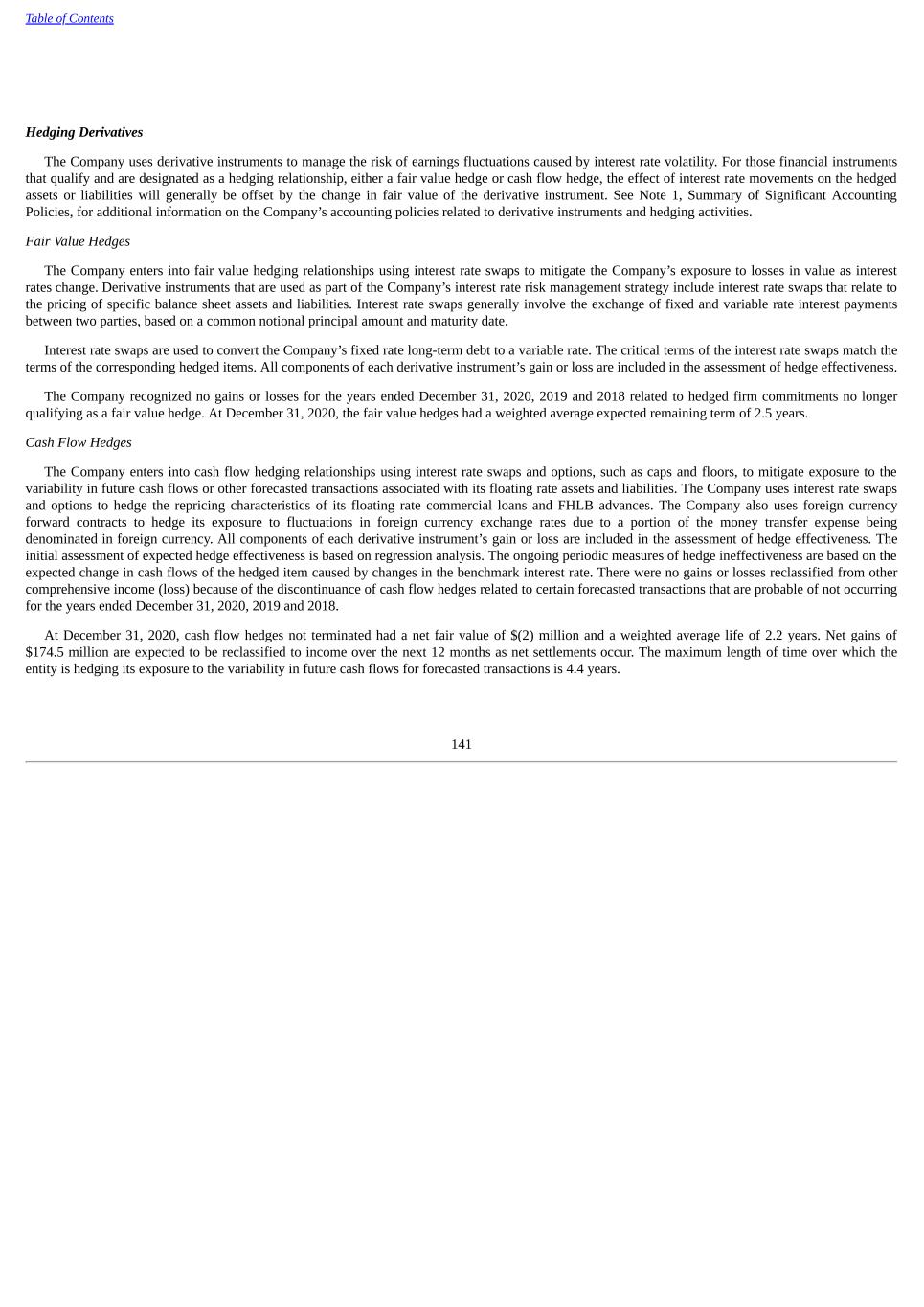
Table of Contents Hedging Derivatives The Company uses derivative instruments to manage the risk of earnings fluctuations caused by interest rate volatility. For those financial instruments that qualify and are designated as a hedging relationship, either a fair value hedge or cash flow hedge, the effect of interest rate movements on the hedged assets or liabilities will generally be offset by the change in fair value of the derivative instrument. See Note 1, Summary of Significant Accounting Policies, for additional information on the Company’s accounting policies related to derivative instruments and hedging activities. Fair Value Hedges The Company enters into fair value hedging relationships using interest rate swaps to mitigate the Company’s exposure to losses in value as interest rates change. Derivative instruments that are used as part of the Company’s interest rate risk management strategy include interest rate swaps that relate to the pricing of specific balance sheet assets and liabilities. Interest rate swaps generally involve the exchange of fixed and variable rate interest payments between two parties, based on a common notional principal amount and maturity date. Interest rate swaps are used to convert the Company’s fixed rate long-term debt to a variable rate. The critical terms of the interest rate swaps match the terms of the corresponding hedged items. All components of each derivative instrument’s gain or loss are included in the assessment of hedge effectiveness. The Company recognized no gains or losses for the years ended December 31, 2020, 2019 and 2018 related to hedged firm commitments no longer qualifying as a fair value hedge. At December 31, 2020, the fair value hedges had a weighted average expected remaining term of 2.5 years. Cash Flow Hedges The Company enters into cash flow hedging relationships using interest rate swaps and options, such as caps and floors, to mitigate exposure to the variability in future cash flows or other forecasted transactions associated with its floating rate assets and liabilities. The Company uses interest rate swaps and options to hedge the repricing characteristics of its floating rate commercial loans and FHLB advances. The Company also uses foreign currency forward contracts to hedge its exposure to fluctuations in foreign currency exchange rates due to a portion of the money transfer expense being denominated in foreign currency. All components of each derivative instrument’s gain or loss are included in the assessment of hedge effectiveness. The initial assessment of expected hedge effectiveness is based on regression analysis. The ongoing periodic measures of hedge ineffectiveness are based on the expected change in cash flows of the hedged item caused by changes in the benchmark interest rate. There were no gains or losses reclassified from other comprehensive income (loss) because of the discontinuance of cash flow hedges related to certain forecasted transactions that are probable of not occurring for the years ended December 31, 2020, 2019 and 2018. At December 31, 2020, cash flow hedges not terminated had a net fair value of $(2) million and a weighted average life of 2.2 years. Net gains of $174.5 million are expected to be reclassified to income over the next 12 months as net settlements occur. The maximum length of time over which the entity is hedging its exposure to the variability in future cash flows for forecasted transactions is 4.4 years. 141
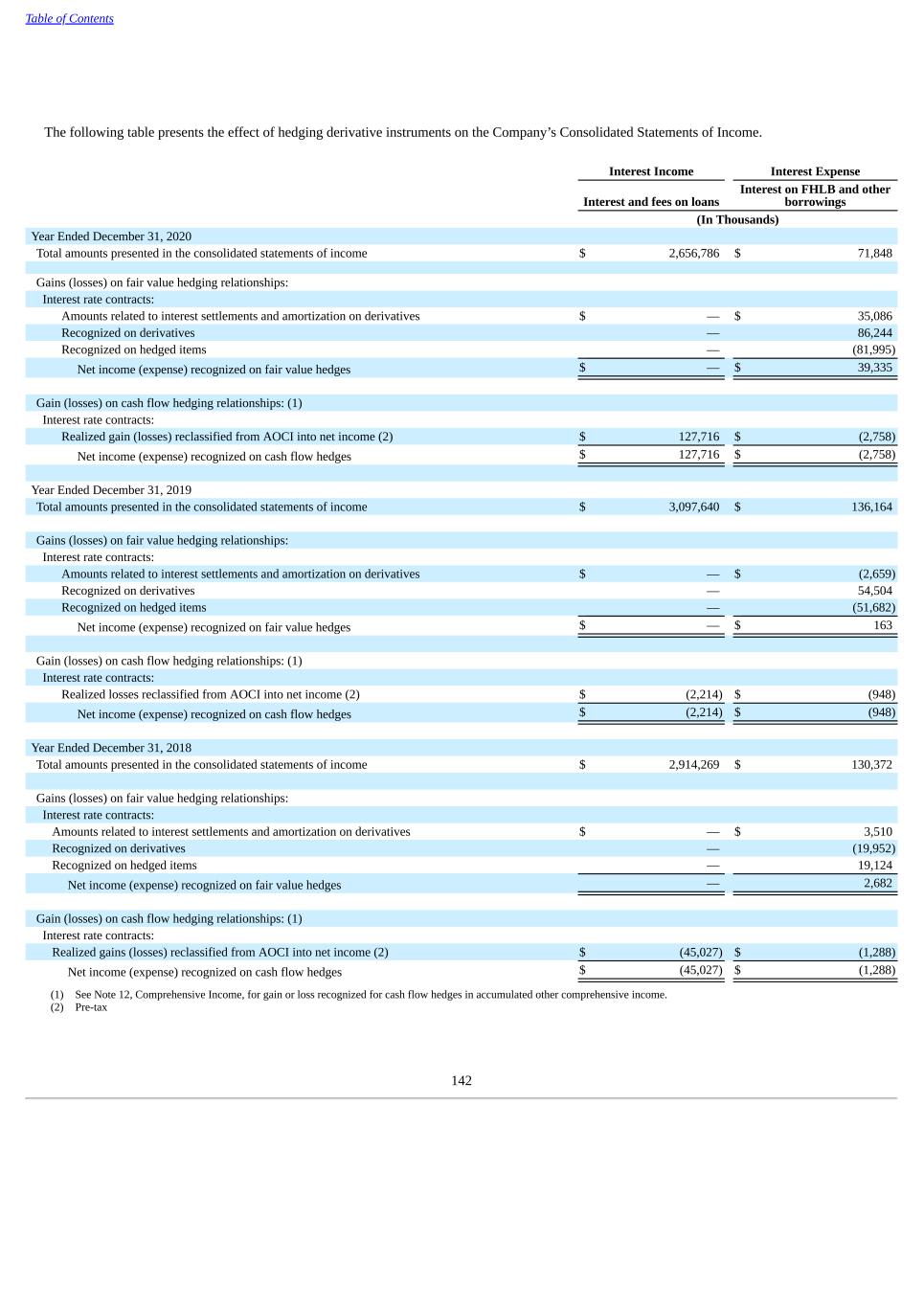
Table of Contents The following table presents the effect of hedging derivative instruments on the Company’s Consolidated Statements of Income. Interest Income Interest Expense Interest and fees on loans Interest on FHLB and other borrowings (In Thousands) Year Ended December 31, 2020 Total amounts presented in the consolidated statements of income $ 2,656,786 $ 71,848 Gains (losses) on fair value hedging relationships: Interest rate contracts: Amounts related to interest settlements and amortization on derivatives $ — $ 35,086 Recognized on derivatives — 86,244 Recognized on hedged items — (81,995) Net income (expense) recognized on fair value hedges $ — $ 39,335 Gain (losses) on cash flow hedging relationships: (1) Interest rate contracts: Realized gain (losses) reclassified from AOCI into net income (2) $ 127,716 $ (2,758) Net income (expense) recognized on cash flow hedges $ 127,716 $ (2,758) Year Ended December 31, 2019 Total amounts presented in the consolidated statements of income $ 3,097,640 $ 136,164 Gains (losses) on fair value hedging relationships: Interest rate contracts: Amounts related to interest settlements and amortization on derivatives $ — $ (2,659) Recognized on derivatives — 54,504 Recognized on hedged items — (51,682) Net income (expense) recognized on fair value hedges $ — $ 163 Gain (losses) on cash flow hedging relationships: (1) Interest rate contracts: Realized losses reclassified from AOCI into net income (2) $ (2,214) $ (948) Net income (expense) recognized on cash flow hedges $ (2,214) $ (948) Year Ended December 31, 2018 Total amounts presented in the consolidated statements of income $ 2,914,269 $ 130,372 Gains (losses) on fair value hedging relationships: Interest rate contracts: Amounts related to interest settlements and amortization on derivatives $ — $ 3,510 Recognized on derivatives — (19,952) Recognized on hedged items — 19,124 Net income (expense) recognized on fair value hedges — 2,682 Gain (losses) on cash flow hedging relationships: (1) Interest rate contracts: Realized gains (losses) reclassified from AOCI into net income (2) $ (45,027) $ (1,288) Net income (expense) recognized on cash flow hedges $ (45,027) $ (1,288) (1) See Note 12, Comprehensive Income, for gain or loss recognized for cash flow hedges in accumulated other comprehensive income. (2) Pre-tax 142
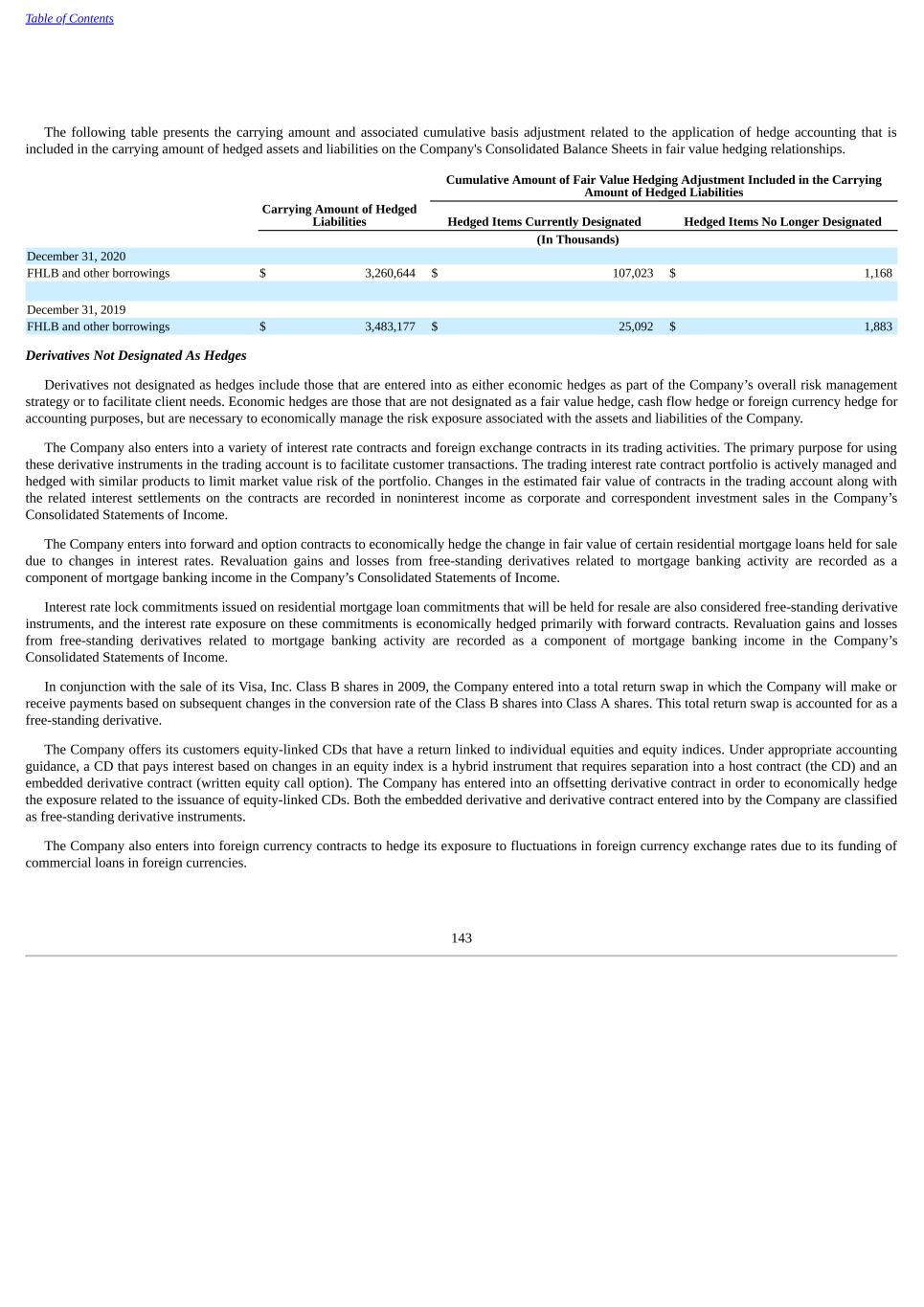
Table of Contents The following table presents the carrying amount and associated cumulative basis adjustment related to the application of hedge accounting that is included in the carrying amount of hedged assets and liabilities on the Company's Consolidated Balance Sheets in fair value hedging relationships. Cumulative Amount of Fair Value Hedging Adjustment Included in the Carrying Amount of Hedged Liabilities Carrying Amount of Hedged Liabilities Hedged Items Currently Designated Hedged Items No Longer Designated (In Thousands) December 31, 2020 FHLB and other borrowings $ 3,260,644 $ 107,023 $ 1,168 December 31, 2019 FHLB and other borrowings $ 3,483,177 $ 25,092 $ 1,883 Derivatives Not Designated As Hedges Derivatives not designated as hedges include those that are entered into as either economic hedges as part of the Company’s overall risk management strategy or to facilitate client needs. Economic hedges are those that are not designated as a fair value hedge, cash flow hedge or foreign currency hedge for accounting purposes, but are necessary to economically manage the risk exposure associated with the assets and liabilities of the Company. The Company also enters into a variety of interest rate contracts and foreign exchange contracts in its trading activities. The primary purpose for using these derivative instruments in the trading account is to facilitate customer transactions. The trading interest rate contract portfolio is actively managed and hedged with similar products to limit market value risk of the portfolio. Changes in the estimated fair value of contracts in the trading account along with the related interest settlements on the contracts are recorded in noninterest income as corporate and correspondent investment sales in the Company’s Consolidated Statements of Income. The Company enters into forward and option contracts to economically hedge the change in fair value of certain residential mortgage loans held for sale due to changes in interest rates. Revaluation gains and losses from free-standing derivatives related to mortgage banking activity are recorded as a component of mortgage banking income in the Company’s Consolidated Statements of Income. Interest rate lock commitments issued on residential mortgage loan commitments that will be held for resale are also considered free-standing derivative instruments, and the interest rate exposure on these commitments is economically hedged primarily with forward contracts. Revaluation gains and losses from free-standing derivatives related to mortgage banking activity are recorded as a component of mortgage banking income in the Company’s Consolidated Statements of Income. In conjunction with the sale of its Visa, Inc. Class B shares in 2009, the Company entered into a total return swap in which the Company will make or receive payments based on subsequent changes in the conversion rate of the Class B shares into Class A shares. This total return swap is accounted for as a free-standing derivative. The Company offers its customers equity-linked CDs that have a return linked to individual equities and equity indices. Under appropriate accounting guidance, a CD that pays interest based on changes in an equity index is a hybrid instrument that requires separation into a host contract (the CD) and an embedded derivative contract (written equity call option). The Company has entered into an offsetting derivative contract in order to economically hedge the exposure related to the issuance of equity-linked CDs. Both the embedded derivative and derivative contract entered into by the Company are classified as free-standing derivative instruments. The Company also enters into foreign currency contracts to hedge its exposure to fluctuations in foreign currency exchange rates due to its funding of commercial loans in foreign currencies. 143
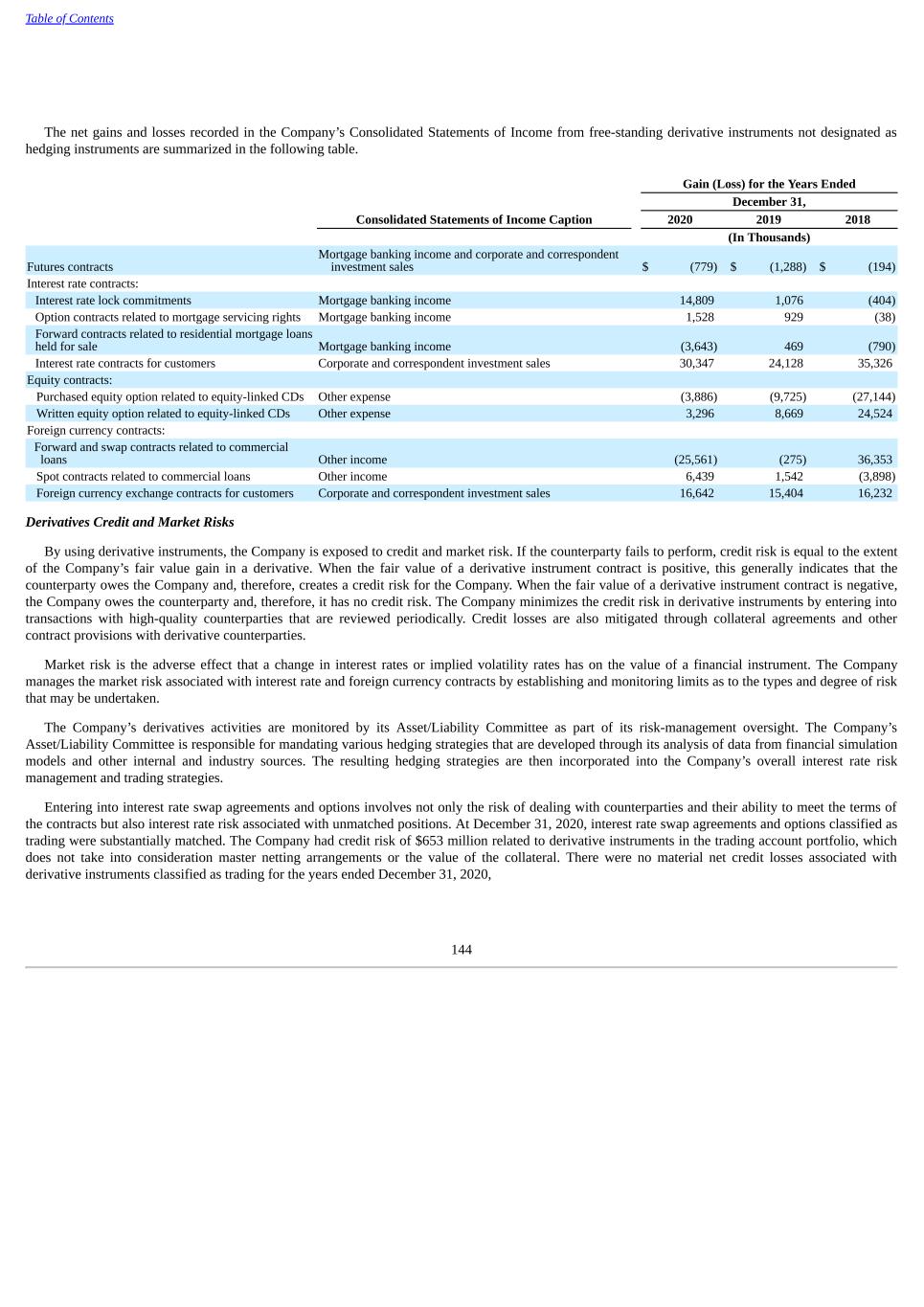
Table of Contents The net gains and losses recorded in the Company’s Consolidated Statements of Income from free-standing derivative instruments not designated as hedging instruments are summarized in the following table. Gain (Loss) for the Years Ended December 31, Consolidated Statements of Income Caption 2020 2019 2018 (In Thousands) Futures contracts Mortgage banking income and corporate and correspondent investment sales $ (779) $ (1,288) $ (194) Interest rate contracts: Interest rate lock commitments Mortgage banking income 14,809 1,076 (404) Option contracts related to mortgage servicing rights Mortgage banking income 1,528 929 (38) Forward contracts related to residential mortgage loans held for sale Mortgage banking income (3,643) 469 (790) Interest rate contracts for customers Corporate and correspondent investment sales 30,347 24,128 35,326 Equity contracts: Purchased equity option related to equity-linked CDs Other expense (3,886) (9,725) (27,144) Written equity option related to equity-linked CDs Other expense 3,296 8,669 24,524 Foreign currency contracts: Forward and swap contracts related to commercial loans Other income (25,561) (275) 36,353 Spot contracts related to commercial loans Other income 6,439 1,542 (3,898) Foreign currency exchange contracts for customers Corporate and correspondent investment sales 16,642 15,404 16,232 Derivatives Credit and Market Risks By using derivative instruments, the Company is exposed to credit and market risk. If the counterparty fails to perform, credit risk is equal to the extent of the Company’s fair value gain in a derivative. When the fair value of a derivative instrument contract is positive, this generally indicates that the counterparty owes the Company and, therefore, creates a credit risk for the Company. When the fair value of a derivative instrument contract is negative, the Company owes the counterparty and, therefore, it has no credit risk. The Company minimizes the credit risk in derivative instruments by entering into transactions with high-quality counterparties that are reviewed periodically. Credit losses are also mitigated through collateral agreements and other contract provisions with derivative counterparties. Market risk is the adverse effect that a change in interest rates or implied volatility rates has on the value of a financial instrument. The Company manages the market risk associated with interest rate and foreign currency contracts by establishing and monitoring limits as to the types and degree of risk that may be undertaken. The Company’s derivatives activities are monitored by its Asset/Liability Committee as part of its risk-management oversight. The Company’s Asset/Liability Committee is responsible for mandating various hedging strategies that are developed through its analysis of data from financial simulation models and other internal and industry sources. The resulting hedging strategies are then incorporated into the Company’s overall interest rate risk management and trading strategies. Entering into interest rate swap agreements and options involves not only the risk of dealing with counterparties and their ability to meet the terms of the contracts but also interest rate risk associated with unmatched positions. At December 31, 2020, interest rate swap agreements and options classified as trading were substantially matched. The Company had credit risk of $653 million related to derivative instruments in the trading account portfolio, which does not take into consideration master netting arrangements or the value of the collateral. There were no material net credit losses associated with derivative instruments classified as trading for the years ended December 31, 2020, 144
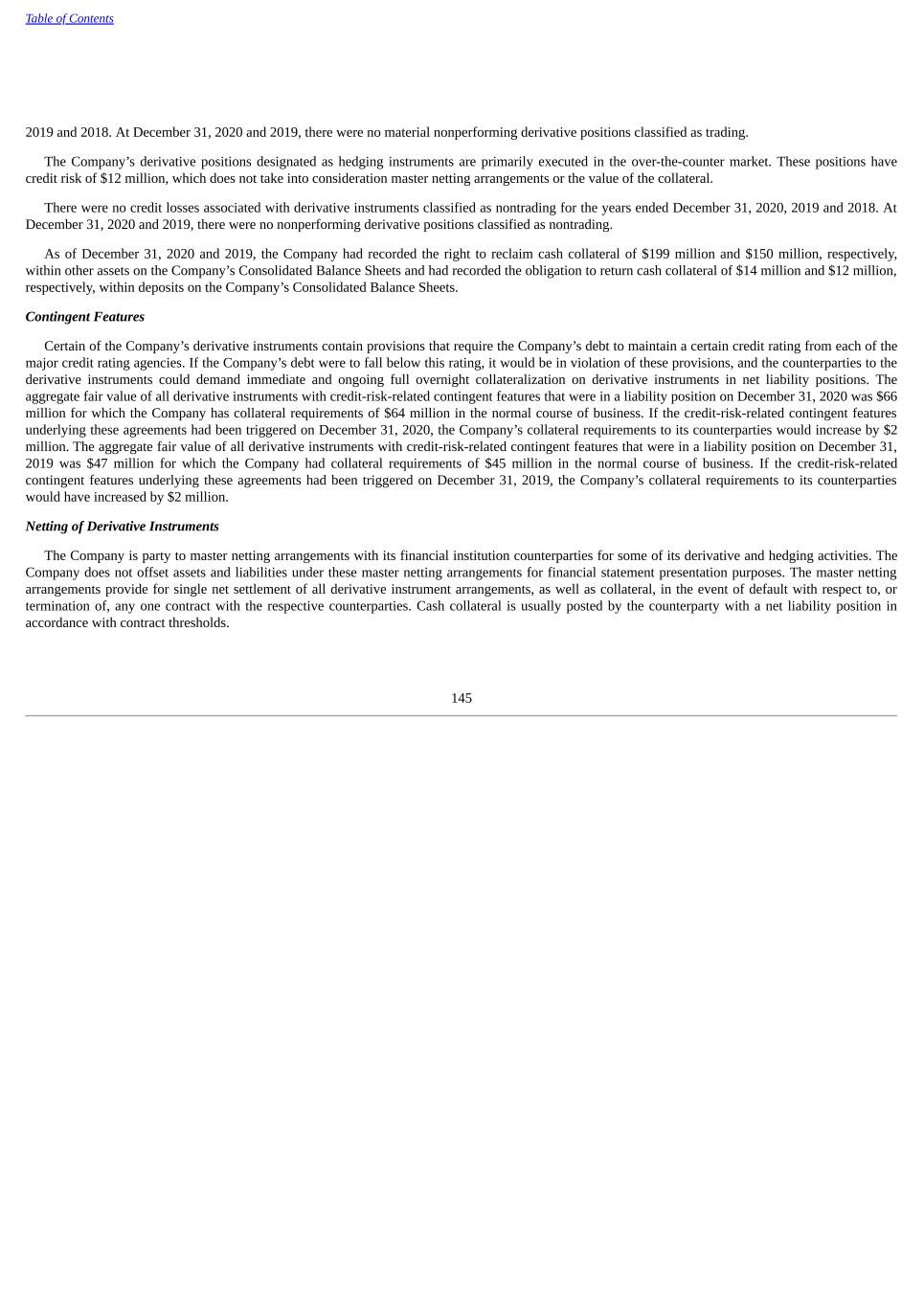
Table of Contents 2019 and 2018. At December 31, 2020 and 2019, there were no material nonperforming derivative positions classified as trading. The Company’s derivative positions designated as hedging instruments are primarily executed in the over-the-counter market. These positions have credit risk of $12 million, which does not take into consideration master netting arrangements or the value of the collateral. There were no credit losses associated with derivative instruments classified as nontrading for the years ended December 31, 2020, 2019 and 2018. At December 31, 2020 and 2019, there were no nonperforming derivative positions classified as nontrading. As of December 31, 2020 and 2019, the Company had recorded the right to reclaim cash collateral of $199 million and $150 million, respectively, within other assets on the Company’s Consolidated Balance Sheets and had recorded the obligation to return cash collateral of $14 million and $12 million, respectively, within deposits on the Company’s Consolidated Balance Sheets. Contingent Features Certain of the Company’s derivative instruments contain provisions that require the Company’s debt to maintain a certain credit rating from each of the major credit rating agencies. If the Company’s debt were to fall below this rating, it would be in violation of these provisions, and the counterparties to the derivative instruments could demand immediate and ongoing full overnight collateralization on derivative instruments in net liability positions. The aggregate fair value of all derivative instruments with credit-risk-related contingent features that were in a liability position on December 31, 2020 was $66 million for which the Company has collateral requirements of $64 million in the normal course of business. If the credit-risk-related contingent features underlying these agreements had been triggered on December 31, 2020, the Company’s collateral requirements to its counterparties would increase by $2 million. The aggregate fair value of all derivative instruments with credit-risk-related contingent features that were in a liability position on December 31, 2019 was $47 million for which the Company had collateral requirements of $45 million in the normal course of business. If the credit-risk-related contingent features underlying these agreements had been triggered on December 31, 2019, the Company’s collateral requirements to its counterparties would have increased by $2 million. Netting of Derivative Instruments The Company is party to master netting arrangements with its financial institution counterparties for some of its derivative and hedging activities. The Company does not offset assets and liabilities under these master netting arrangements for financial statement presentation purposes. The master netting arrangements provide for single net settlement of all derivative instrument arrangements, as well as collateral, in the event of default with respect to, or termination of, any one contract with the respective counterparties. Cash collateral is usually posted by the counterparty with a net liability position in accordance with contract thresholds. 145
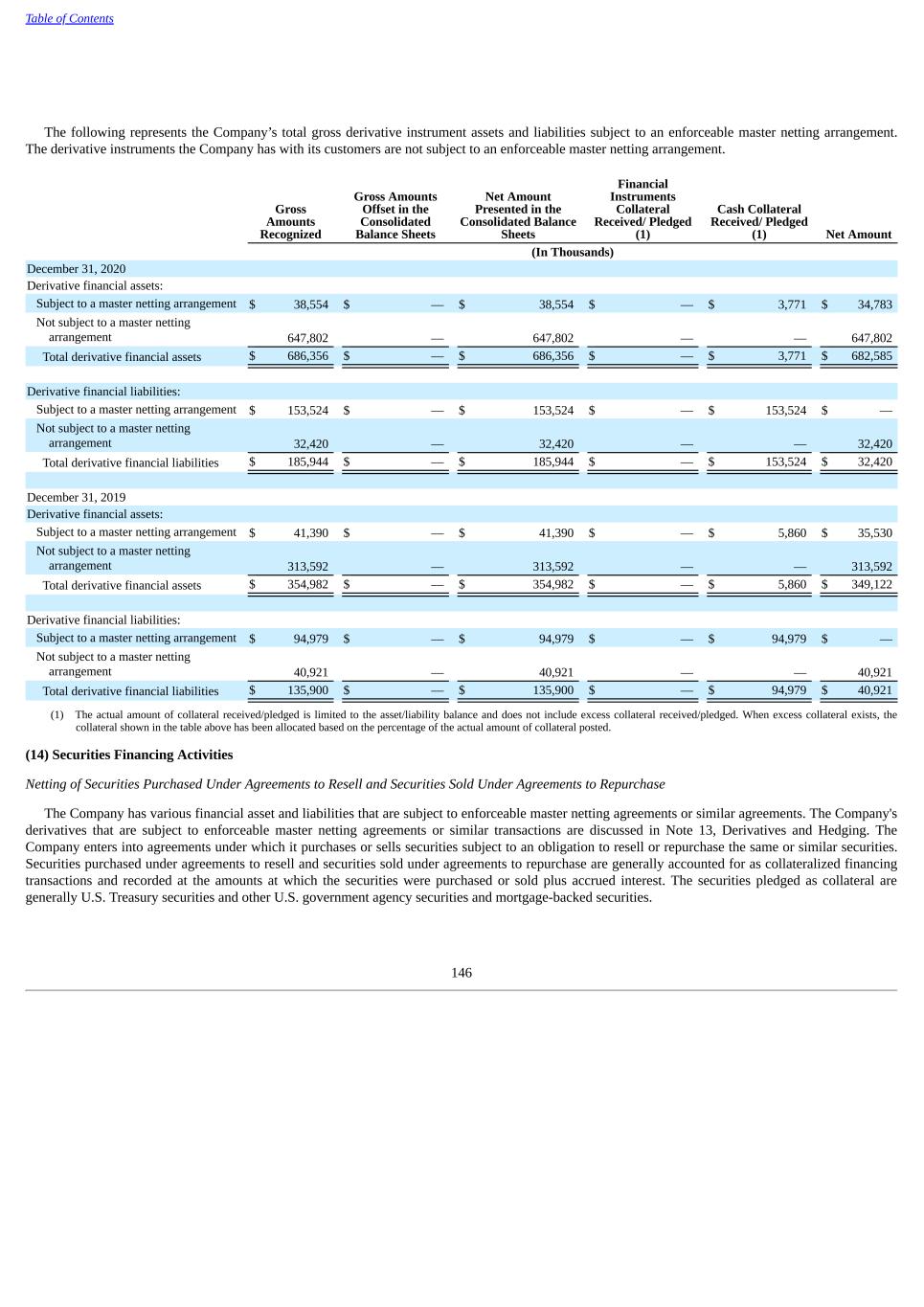
Table of Contents The following represents the Company’s total gross derivative instrument assets and liabilities subject to an enforceable master netting arrangement. The derivative instruments the Company has with its customers are not subject to an enforceable master netting arrangement. Gross Amounts Recognized Gross Amounts Offset in the Consolidated Balance Sheets Net Amount Presented in the Consolidated Balance Sheets Financial Instruments Collateral Received/ Pledged (1) Cash Collateral Received/ Pledged (1) Net Amount (In Thousands) December 31, 2020 Derivative financial assets: Subject to a master netting arrangement $ 38,554 $ — $ 38,554 $ — $ 3,771 $ 34,783 Not subject to a master netting arrangement 647,802 — 647,802 — — 647,802 Total derivative financial assets $ 686,356 $ — $ 686,356 $ — $ 3,771 $ 682,585 Derivative financial liabilities: Subject to a master netting arrangement $ 153,524 $ — $ 153,524 $ — $ 153,524 $ — Not subject to a master netting arrangement 32,420 — 32,420 — — 32,420 Total derivative financial liabilities $ 185,944 $ — $ 185,944 $ — $ 153,524 $ 32,420 December 31, 2019 Derivative financial assets: Subject to a master netting arrangement $ 41,390 $ — $ 41,390 $ — $ 5,860 $ 35,530 Not subject to a master netting arrangement 313,592 — 313,592 — — 313,592 Total derivative financial assets $ 354,982 $ — $ 354,982 $ — $ 5,860 $ 349,122 Derivative financial liabilities: Subject to a master netting arrangement $ 94,979 $ — $ 94,979 $ — $ 94,979 $ — Not subject to a master netting arrangement 40,921 — 40,921 — — 40,921 Total derivative financial liabilities $ 135,900 $ — $ 135,900 $ — $ 94,979 $ 40,921 (1) The actual amount of collateral received/pledged is limited to the asset/liability balance and does not include excess collateral received/pledged. When excess collateral exists, the collateral shown in the table above has been allocated based on the percentage of the actual amount of collateral posted. (14) Securities Financing Activities Netting of Securities Purchased Under Agreements to Resell and Securities Sold Under Agreements to Repurchase The Company has various financial asset and liabilities that are subject to enforceable master netting agreements or similar agreements. The Company's derivatives that are subject to enforceable master netting agreements or similar transactions are discussed in Note 13, Derivatives and Hedging. The Company enters into agreements under which it purchases or sells securities subject to an obligation to resell or repurchase the same or similar securities. Securities purchased under agreements to resell and securities sold under agreements to repurchase are generally accounted for as collateralized financing transactions and recorded at the amounts at which the securities were purchased or sold plus accrued interest. The securities pledged as collateral are generally U.S. Treasury securities and other U.S. government agency securities and mortgage-backed securities. 146
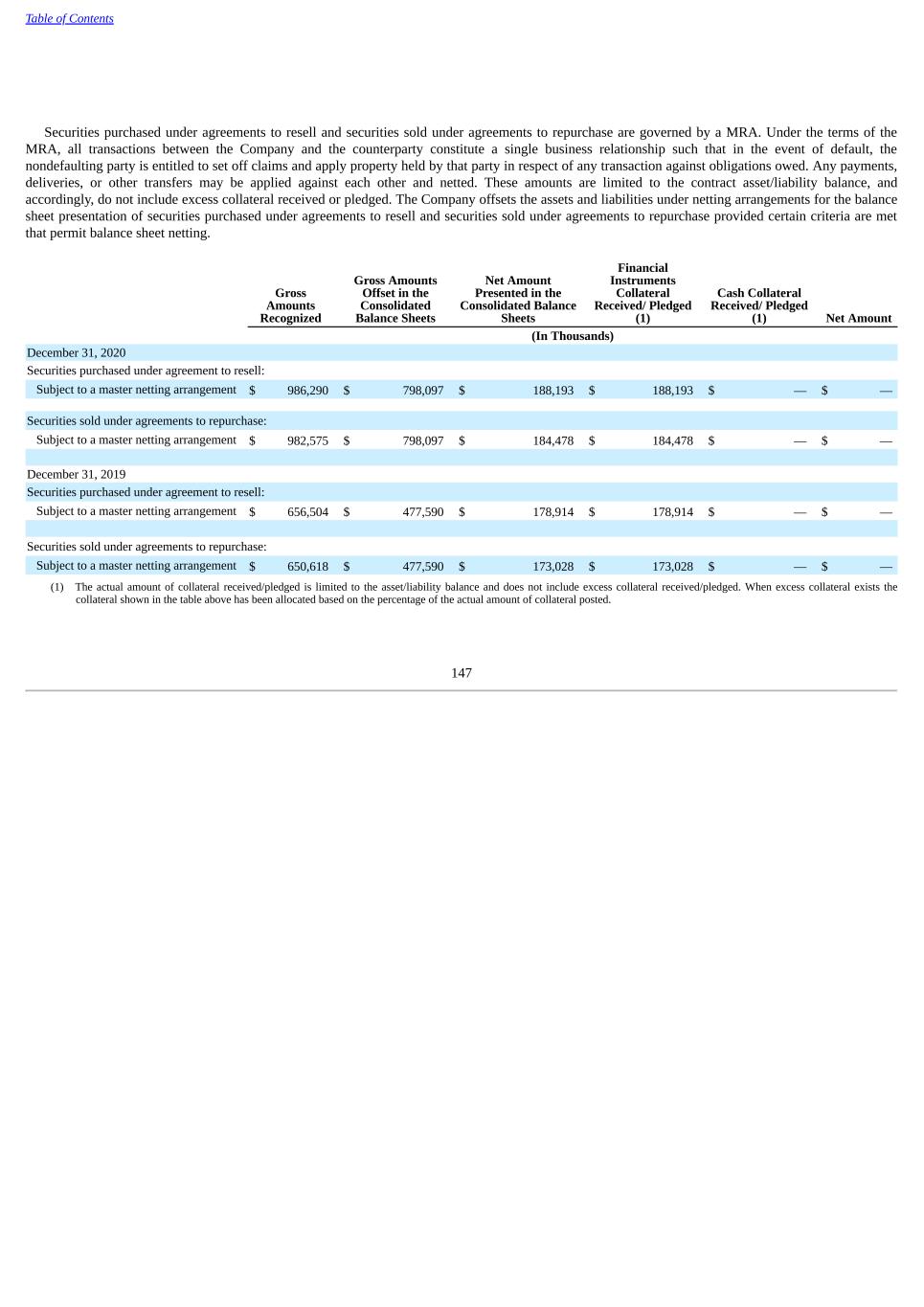
Table of Contents Securities purchased under agreements to resell and securities sold under agreements to repurchase are governed by a MRA. Under the terms of the MRA, all transactions between the Company and the counterparty constitute a single business relationship such that in the event of default, the nondefaulting party is entitled to set off claims and apply property held by that party in respect of any transaction against obligations owed. Any payments, deliveries, or other transfers may be applied against each other and netted. These amounts are limited to the contract asset/liability balance, and accordingly, do not include excess collateral received or pledged. The Company offsets the assets and liabilities under netting arrangements for the balance sheet presentation of securities purchased under agreements to resell and securities sold under agreements to repurchase provided certain criteria are met that permit balance sheet netting. Gross Amounts Recognized Gross Amounts Offset in the Consolidated Balance Sheets Net Amount Presented in the Consolidated Balance Sheets Financial Instruments Collateral Received/ Pledged (1) Cash Collateral Received/ Pledged (1) Net Amount (In Thousands) December 31, 2020 Securities purchased under agreement to resell: Subject to a master netting arrangement $ 986,290 $ 798,097 $ 188,193 $ 188,193 $ — $ — Securities sold under agreements to repurchase: Subject to a master netting arrangement $ 982,575 $ 798,097 $ 184,478 $ 184,478 $ — $ — December 31, 2019 Securities purchased under agreement to resell: Subject to a master netting arrangement $ 656,504 $ 477,590 $ 178,914 $ 178,914 $ — $ — Securities sold under agreements to repurchase: Subject to a master netting arrangement $ 650,618 $ 477,590 $ 173,028 $ 173,028 $ — $ — (1) The actual amount of collateral received/pledged is limited to the asset/liability balance and does not include excess collateral received/pledged. When excess collateral exists the collateral shown in the table above has been allocated based on the percentage of the actual amount of collateral posted. 147

Table of Contents Collateral Associated with Securities Financing Activities Securities sold under agreements to repurchase are accounted for as secured borrowings. The following table presents the Company's related activity, by collateral type and remaining contractual maturity. Remaining Contractual Maturity of the Agreements Overnight and Continuous Up to 30 Days 30 - 90 Days Greater Than 90 Days Total (In Thousands) December 31, 2020 Securities sold under agreements to repurchase: U.S. Treasury and other U.S. government agencies securities $ 880,200 $ — $ 102,375 $ — $ 982,575 Mortgage-backed securities — — — — — Total $ 880,200 $ — $ 102,375 $ — $ 982,575 December 31, 2019 Securities sold under agreements to repurchase: U.S. Treasury and other U.S. government agencies securities $ 321,310 $ — $ — $ 305,750 $ 627,060 Mortgage-backed securities — — 23,558 — 23,558 Total $ 321,310 $ — $ 23,558 $ 305,750 $ 650,618 In the event of a significant decline in fair value of the collateral pledged for the securities sold under agreements to repurchase, the Company would be required to provide additional collateral. The Company mitigates the risk by monitoring the liquidity and credit quality of the collateral, as well as the maturity profile of the transactions. At December 31, 2020, the fair value of collateral received related to securities purchased under agreements to resell was $966 million and the fair value of collateral pledged for securities sold under agreements to repurchase was $960 million. At December 31, 2019, the fair value of collateral received related to securities purchased under agreements to resell was $648 million and the fair value of collateral pledged for securities sold under agreements to repurchase was $644 million. (15) Commitments, Contingencies and Guarantees Commitments to Extend Credit & Standby and Commercial Letters of Credit The following represents the Company’s commitments to extend credit, standby letters of credit and commercial letters of credit. December 31, 2020 2019 (In Thousands) Commitments to extend credit $ 28,251,150 $ 27,725,965 Standby and commercial letters of credit 853,450 996,830 Commitments to extend credit are agreements to lend to customers on certain terms and conditions as long as all conditions are satisfied and there is no violation of any condition established in the contract. Commitments generally have fixed expiration dates or other termination clauses and may require payment of a fee. Since many of the commitments are expected to expire without being drawn upon, the total commitment amounts do not necessarily represent future cash requirements. Standby and commercial letters of credit are commitments issued by the Company to guarantee the performance of a customer to a third party. These guarantees are primarily issued to support public and private borrowing 148
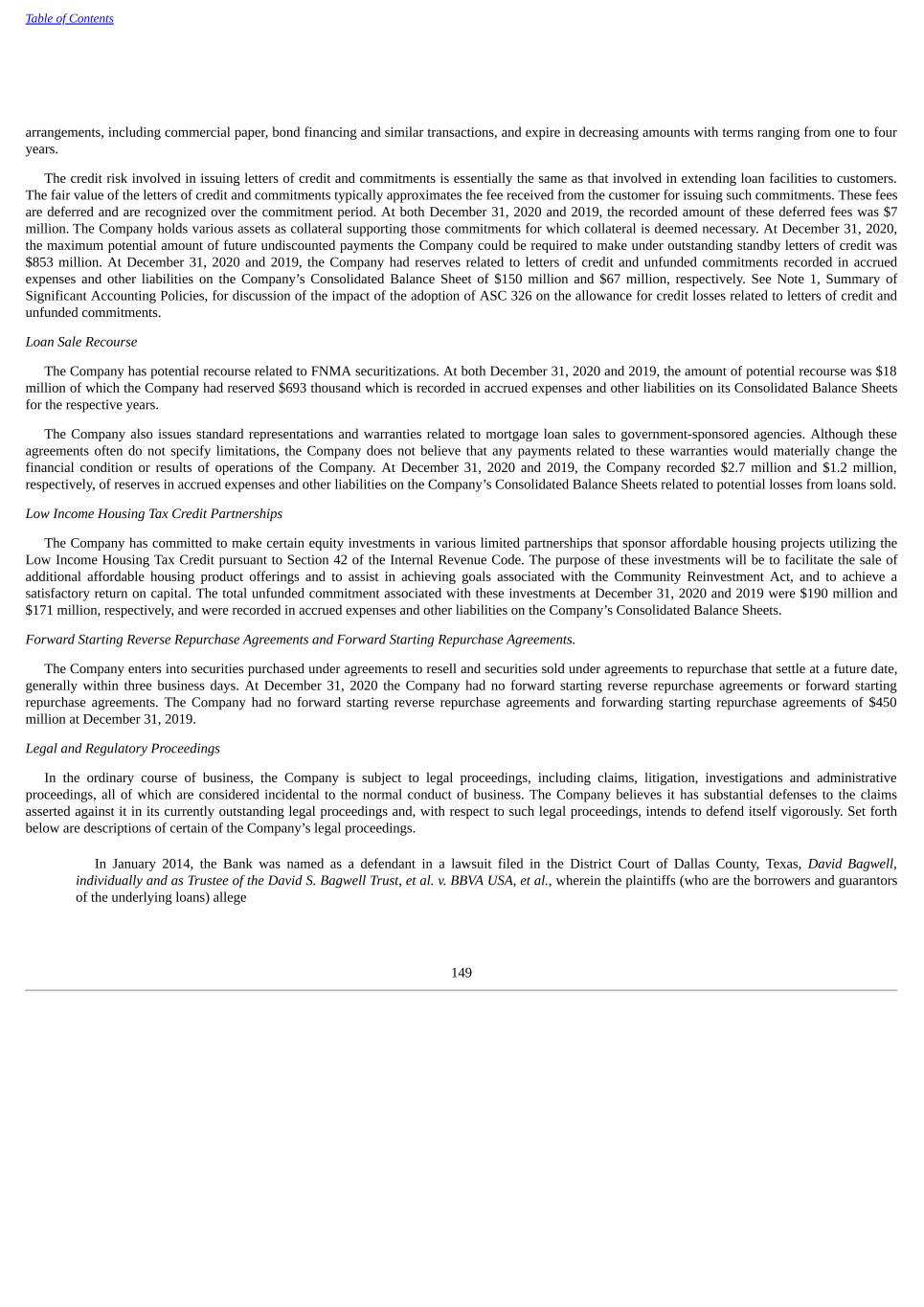
Table of Contents arrangements, including commercial paper, bond financing and similar transactions, and expire in decreasing amounts with terms ranging from one to four years. The credit risk involved in issuing letters of credit and commitments is essentially the same as that involved in extending loan facilities to customers. The fair value of the letters of credit and commitments typically approximates the fee received from the customer for issuing such commitments. These fees are deferred and are recognized over the commitment period. At both December 31, 2020 and 2019, the recorded amount of these deferred fees was $7 million. The Company holds various assets as collateral supporting those commitments for which collateral is deemed necessary. At December 31, 2020, the maximum potential amount of future undiscounted payments the Company could be required to make under outstanding standby letters of credit was $853 million. At December 31, 2020 and 2019, the Company had reserves related to letters of credit and unfunded commitments recorded in accrued expenses and other liabilities on the Company’s Consolidated Balance Sheet of $150 million and $67 million, respectively. See Note 1, Summary of Significant Accounting Policies, for discussion of the impact of the adoption of ASC 326 on the allowance for credit losses related to letters of credit and unfunded commitments. Loan Sale Recourse The Company has potential recourse related to FNMA securitizations. At both December 31, 2020 and 2019, the amount of potential recourse was $18 million of which the Company had reserved $693 thousand which is recorded in accrued expenses and other liabilities on its Consolidated Balance Sheets for the respective years. The Company also issues standard representations and warranties related to mortgage loan sales to government-sponsored agencies. Although these agreements often do not specify limitations, the Company does not believe that any payments related to these warranties would materially change the financial condition or results of operations of the Company. At December 31, 2020 and 2019, the Company recorded $2.7 million and $1.2 million, respectively, of reserves in accrued expenses and other liabilities on the Company’s Consolidated Balance Sheets related to potential losses from loans sold. Low Income Housing Tax Credit Partnerships The Company has committed to make certain equity investments in various limited partnerships that sponsor affordable housing projects utilizing the Low Income Housing Tax Credit pursuant to Section 42 of the Internal Revenue Code. The purpose of these investments will be to facilitate the sale of additional affordable housing product offerings and to assist in achieving goals associated with the Community Reinvestment Act, and to achieve a satisfactory return on capital. The total unfunded commitment associated with these investments at December 31, 2020 and 2019 were $190 million and $171 million, respectively, and were recorded in accrued expenses and other liabilities on the Company’s Consolidated Balance Sheets. Forward Starting Reverse Repurchase Agreements and Forward Starting Repurchase Agreements. The Company enters into securities purchased under agreements to resell and securities sold under agreements to repurchase that settle at a future date, generally within three business days. At December 31, 2020 the Company had no forward starting reverse repurchase agreements or forward starting repurchase agreements. The Company had no forward starting reverse repurchase agreements and forwarding starting repurchase agreements of $450 million at December 31, 2019. Legal and Regulatory Proceedings In the ordinary course of business, the Company is subject to legal proceedings, including claims, litigation, investigations and administrative proceedings, all of which are considered incidental to the normal conduct of business. The Company believes it has substantial defenses to the claims asserted against it in its currently outstanding legal proceedings and, with respect to such legal proceedings, intends to defend itself vigorously. Set forth below are descriptions of certain of the Company’s legal proceedings. In January 2014, the Bank was named as a defendant in a lawsuit filed in the District Court of Dallas County, Texas, David Bagwell, individually and as Trustee of the David S. Bagwell Trust, et al. v. BBVA USA, et al., wherein the plaintiffs (who are the borrowers and guarantors of the underlying loans) allege 149

Table of Contents that BBVA USA wrongfully sold their loans to a third party after representing that it would not do so. The plaintiffs seek unspecified monetary relief. Following trial in December 2017, the jury rendered a verdict in favor of the plaintiffs totaling $98 million. On June 27, 2018, the court entered a judgment in favor of the plaintiffs in the amount of $96 million, which includes prejudgment interest. The Bank appealed and on December 14, 2020, the appellate court issued an opinion reversing the jury verdict and entering a plaintiffs take nothing judgment in the Company’s favor on all claims. Plaintiffs are seeking further review of the appellate court’s decision. The Company believes there are substantial defenses to these claims and intends to defend them vigorously. In October 2016, BSI was named as a defendant in a putative class action lawsuit filed in the District Court of Harris County, Texas, St. Lucie County Fire District Firefighters' Pension Trust, individually and on behalf of all others similarly situated v. Southwestern Energy Company, et al., wherein the plaintiffs allege that Southwestern Energy Company, its officers and directors, and the underwriting defendants (including BSI) made inaccurate and misleading statements in the registration statement and prospectus related to a securities offering. The plaintiffs seek unspecified monetary relief. The Company believes there are substantial defenses to these claims and intends to defend them vigorously. The Company and the Bank have been named in two proceedings involving David L. Powell: one that was filed in January 2017 with the Federal Conciliation and Arbitration Labor Board of Mexico City, Mexico, David Lannon Powell Finneran v. BBVA USA Bancshares, Inc., et al., and one that was filed in April 2018 in the United States District Court for the Northern District of Texas, David L. Powell, et al. v. BBVA USA. Powell alleges discrimination and wrongful termination in both proceedings, and seeks unspecified monetary relief. The Company believes there are substantial defenses to these claims and intends to defend them vigorously. In March 2019, the Company and its subsidiary, Simple Finance Technology Corp., were named as defendants in a putative class action lawsuit filed in the United States District Court for the Northern District of California, Amitahbo Chattopadhyay v. BBVA USA Bancshares, Inc., et al. Plaintiff claims that Simple and the Company only permit United States citizens to open Simple accounts (which are exclusively originated through online channels). Plaintiff later amended the complaint to also take issue with BBVA USA’s practice of directing non-citizen applicants to complete the online account origination processes in a physical branch location. Plaintiff alleges that these practices constitute alienage discrimination and violations of California's Unruh Act. BBVA USA’s motion to dismiss was granted on November 2, 2020 and the plaintiffs are pursuing an appeal of that ruling. The Company believes that there are substantial defenses to these claims and intends to defend them vigorously. In July 2019, the Company was named as a defendant in a putative class action lawsuit filed in the United States District Court for the Northern District of Alabama, Ferguson v. BBVA USA Bancshares, Inc., wherein the plaintiffs allege certain investment options within the Company’s employee retirement plan violate provisions of ERISA. The plaintiffs seek unspecified monetary relief. The Company believes there are substantial defenses to these claims and intends to defend them vigorously. In April 2020, the Bank was named in a putative class action lawsuit filed in the District Court of Bexar County, Texas styled Zamora-Orduna Realty Group LLC v. BBVA USA, wherein plaintiffs allege the Bank tortiously failed to process certain loan requests submitted in connection with the federal Paycheck Protection Program. The plaintiffs seek an amount not less than $10 million along with other demands for unspecified monetary relief. The Company believes there are substantial defenses to these claims and intends to defend them vigorously. In April 2020, BBVA USA was named as a defendant in a lawsuit filed in the United States District Court for the Eastern District of Texas, Marshall Division originally styled Estech Systems, Inc. v. BBVA USA Bancshares, Inc., alleging that BBVA USA has violated intellectual property rights owned by the plaintiff in connection with various patents regarding voice-over-internet protocols (VoIP). The plaintiff alleges that BBVA USA’s use of certain phone systems and technologies violate its claimed patent rights. 150
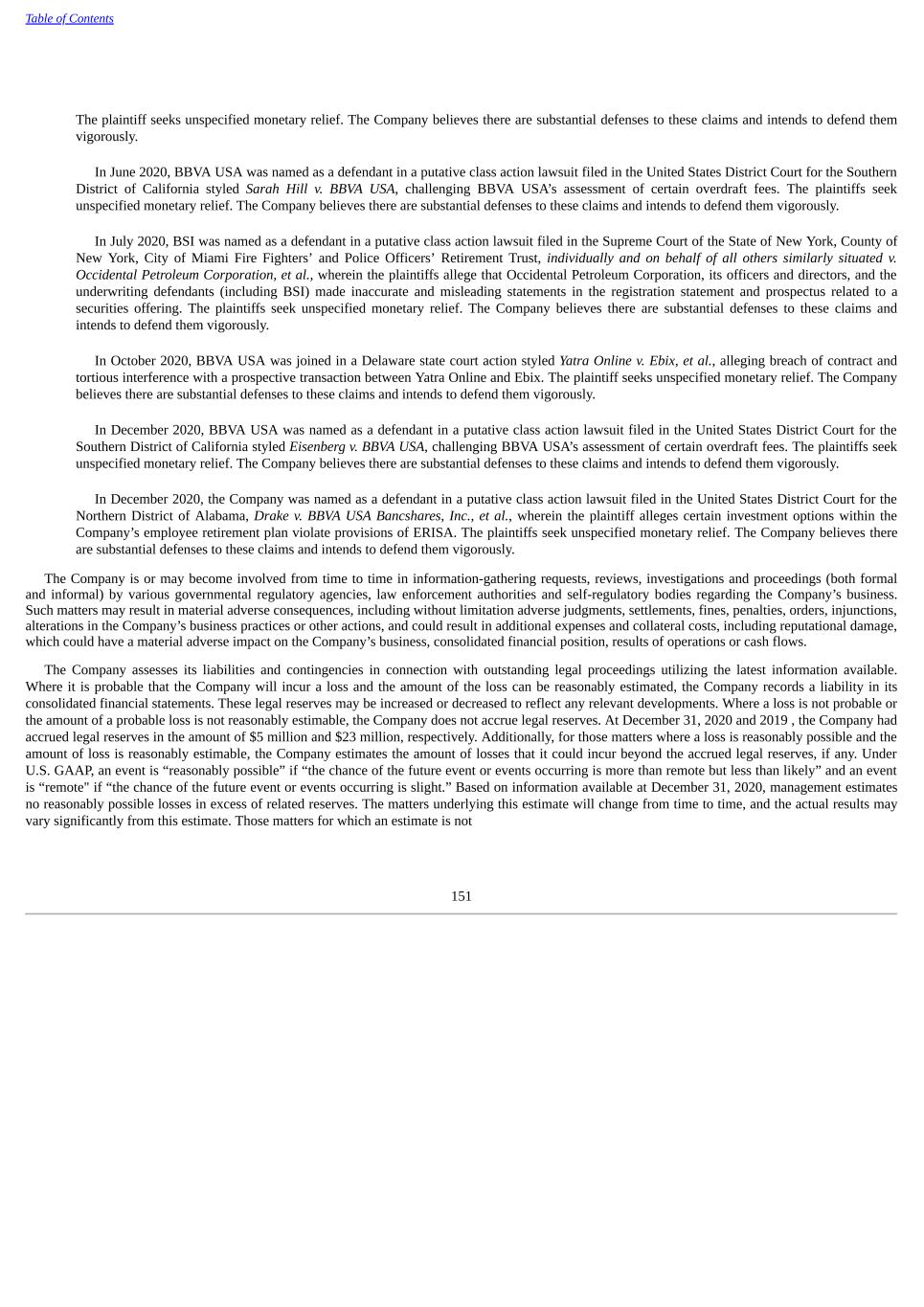
Table of Contents The plaintiff seeks unspecified monetary relief. The Company believes there are substantial defenses to these claims and intends to defend them vigorously. In June 2020, BBVA USA was named as a defendant in a putative class action lawsuit filed in the United States District Court for the Southern District of California styled Sarah Hill v. BBVA USA, challenging BBVA USA’s assessment of certain overdraft fees. The plaintiffs seek unspecified monetary relief. The Company believes there are substantial defenses to these claims and intends to defend them vigorously. In July 2020, BSI was named as a defendant in a putative class action lawsuit filed in the Supreme Court of the State of New York, County of New York, City of Miami Fire Fighters’ and Police Officers’ Retirement Trust, individually and on behalf of all others similarly situated v. Occidental Petroleum Corporation, et al., wherein the plaintiffs allege that Occidental Petroleum Corporation, its officers and directors, and the underwriting defendants (including BSI) made inaccurate and misleading statements in the registration statement and prospectus related to a securities offering. The plaintiffs seek unspecified monetary relief. The Company believes there are substantial defenses to these claims and intends to defend them vigorously. In October 2020, BBVA USA was joined in a Delaware state court action styled Yatra Online v. Ebix, et al., alleging breach of contract and tortious interference with a prospective transaction between Yatra Online and Ebix. The plaintiff seeks unspecified monetary relief. The Company believes there are substantial defenses to these claims and intends to defend them vigorously. In December 2020, BBVA USA was named as a defendant in a putative class action lawsuit filed in the United States District Court for the Southern District of California styled Eisenberg v. BBVA USA, challenging BBVA USA’s assessment of certain overdraft fees. The plaintiffs seek unspecified monetary relief. The Company believes there are substantial defenses to these claims and intends to defend them vigorously. In December 2020, the Company was named as a defendant in a putative class action lawsuit filed in the United States District Court for the Northern District of Alabama, Drake v. BBVA USA Bancshares, Inc., et al., wherein the plaintiff alleges certain investment options within the Company’s employee retirement plan violate provisions of ERISA. The plaintiffs seek unspecified monetary relief. The Company believes there are substantial defenses to these claims and intends to defend them vigorously. The Company is or may become involved from time to time in information-gathering requests, reviews, investigations and proceedings (both formal and informal) by various governmental regulatory agencies, law enforcement authorities and self-regulatory bodies regarding the Company’s business. Such matters may result in material adverse consequences, including without limitation adverse judgments, settlements, fines, penalties, orders, injunctions, alterations in the Company’s business practices or other actions, and could result in additional expenses and collateral costs, including reputational damage, which could have a material adverse impact on the Company’s business, consolidated financial position, results of operations or cash flows. The Company assesses its liabilities and contingencies in connection with outstanding legal proceedings utilizing the latest information available. Where it is probable that the Company will incur a loss and the amount of the loss can be reasonably estimated, the Company records a liability in its consolidated financial statements. These legal reserves may be increased or decreased to reflect any relevant developments. Where a loss is not probable or the amount of a probable loss is not reasonably estimable, the Company does not accrue legal reserves. At December 31, 2020 and 2019 , the Company had accrued legal reserves in the amount of $5 million and $23 million, respectively. Additionally, for those matters where a loss is reasonably possible and the amount of loss is reasonably estimable, the Company estimates the amount of losses that it could incur beyond the accrued legal reserves, if any. Under U.S. GAAP, an event is “reasonably possible” if “the chance of the future event or events occurring is more than remote but less than likely” and an event is “remote" if “the chance of the future event or events occurring is slight.” Based on information available at December 31, 2020, management estimates no reasonably possible losses in excess of related reserves. The matters underlying this estimate will change from time to time, and the actual results may vary significantly from this estimate. Those matters for which an estimate is not 151
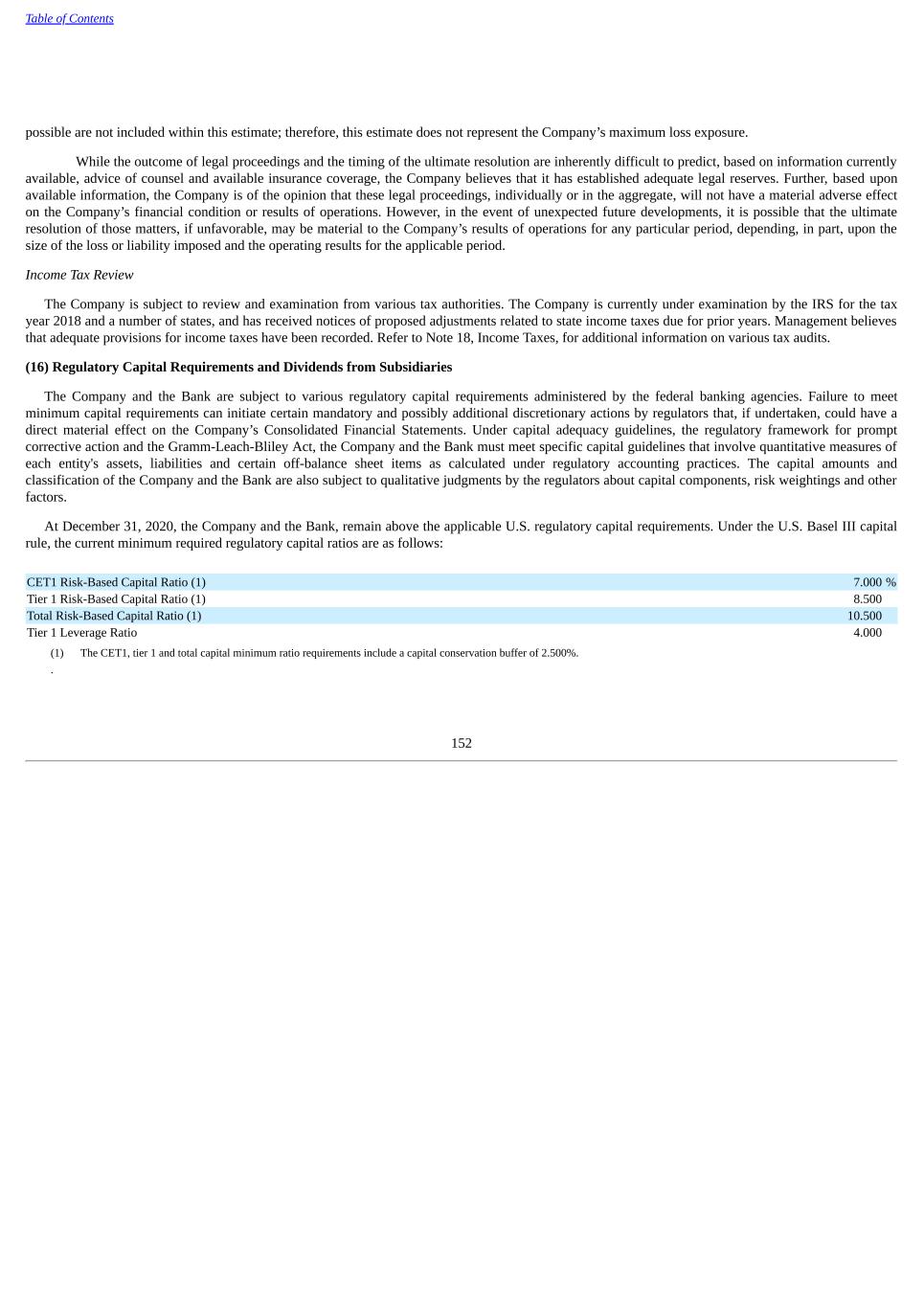
Table of Contents possible are not included within this estimate; therefore, this estimate does not represent the Company’s maximum loss exposure. While the outcome of legal proceedings and the timing of the ultimate resolution are inherently difficult to predict, based on information currently available, advice of counsel and available insurance coverage, the Company believes that it has established adequate legal reserves. Further, based upon available information, the Company is of the opinion that these legal proceedings, individually or in the aggregate, will not have a material adverse effect on the Company’s financial condition or results of operations. However, in the event of unexpected future developments, it is possible that the ultimate resolution of those matters, if unfavorable, may be material to the Company’s results of operations for any particular period, depending, in part, upon the size of the loss or liability imposed and the operating results for the applicable period. Income Tax Review The Company is subject to review and examination from various tax authorities. The Company is currently under examination by the IRS for the tax year 2018 and a number of states, and has received notices of proposed adjustments related to state income taxes due for prior years. Management believes that adequate provisions for income taxes have been recorded. Refer to Note 18, Income Taxes, for additional information on various tax audits. (16) Regulatory Capital Requirements and Dividends from Subsidiaries The Company and the Bank are subject to various regulatory capital requirements administered by the federal banking agencies. Failure to meet minimum capital requirements can initiate certain mandatory and possibly additional discretionary actions by regulators that, if undertaken, could have a direct material effect on the Company’s Consolidated Financial Statements. Under capital adequacy guidelines, the regulatory framework for prompt corrective action and the Gramm-Leach-Bliley Act, the Company and the Bank must meet specific capital guidelines that involve quantitative measures of each entity's assets, liabilities and certain off-balance sheet items as calculated under regulatory accounting practices. The capital amounts and classification of the Company and the Bank are also subject to qualitative judgments by the regulators about capital components, risk weightings and other factors. At December 31, 2020, the Company and the Bank, remain above the applicable U.S. regulatory capital requirements. Under the U.S. Basel III capital rule, the current minimum required regulatory capital ratios are as follows: CET1 Risk-Based Capital Ratio (1) 7.000 % Tier 1 Risk-Based Capital Ratio (1) 8.500 Total Risk-Based Capital Ratio (1) 10.500 Tier 1 Leverage Ratio 4.000 (1) The CET1, tier 1 and total capital minimum ratio requirements include a capital conservation buffer of 2.500%. . 152
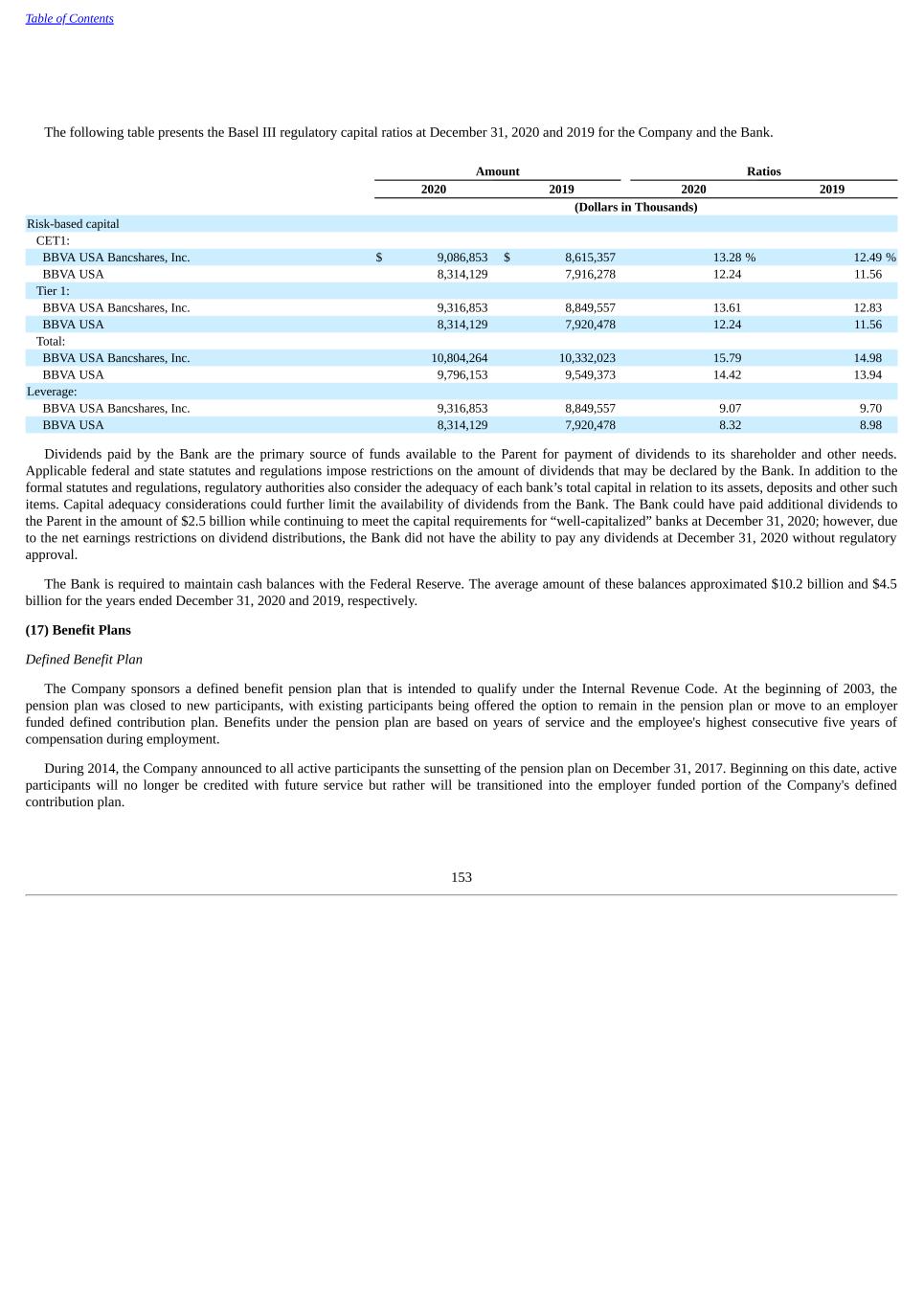
Table of Contents The following table presents the Basel III regulatory capital ratios at December 31, 2020 and 2019 for the Company and the Bank. Amount Ratios 2020 2019 2020 2019 (Dollars in Thousands) Risk-based capital CET1: BBVA USA Bancshares, Inc. $ 9,086,853 $ 8,615,357 13.28 % 12.49 % BBVA USA 8,314,129 7,916,278 12.24 11.56 Tier 1: BBVA USA Bancshares, Inc. 9,316,853 8,849,557 13.61 12.83 BBVA USA 8,314,129 7,920,478 12.24 11.56 Total: BBVA USA Bancshares, Inc. 10,804,264 10,332,023 15.79 14.98 BBVA USA 9,796,153 9,549,373 14.42 13.94 Leverage: BBVA USA Bancshares, Inc. 9,316,853 8,849,557 9.07 9.70 BBVA USA 8,314,129 7,920,478 8.32 8.98 Dividends paid by the Bank are the primary source of funds available to the Parent for payment of dividends to its shareholder and other needs. Applicable federal and state statutes and regulations impose restrictions on the amount of dividends that may be declared by the Bank. In addition to the formal statutes and regulations, regulatory authorities also consider the adequacy of each bank’s total capital in relation to its assets, deposits and other such items. Capital adequacy considerations could further limit the availability of dividends from the Bank. The Bank could have paid additional dividends to the Parent in the amount of $2.5 billion while continuing to meet the capital requirements for “well-capitalized” banks at December 31, 2020; however, due to the net earnings restrictions on dividend distributions, the Bank did not have the ability to pay any dividends at December 31, 2020 without regulatory approval. The Bank is required to maintain cash balances with the Federal Reserve. The average amount of these balances approximated $10.2 billion and $4.5 billion for the years ended December 31, 2020 and 2019, respectively. (17) Benefit Plans Defined Benefit Plan The Company sponsors a defined benefit pension plan that is intended to qualify under the Internal Revenue Code. At the beginning of 2003, the pension plan was closed to new participants, with existing participants being offered the option to remain in the pension plan or move to an employer funded defined contribution plan. Benefits under the pension plan are based on years of service and the employee's highest consecutive five years of compensation during employment. During 2014, the Company announced to all active participants the sunsetting of the pension plan on December 31, 2017. Beginning on this date, active participants will no longer be credited with future service but rather will be transitioned into the employer funded portion of the Company's defined contribution plan. 153
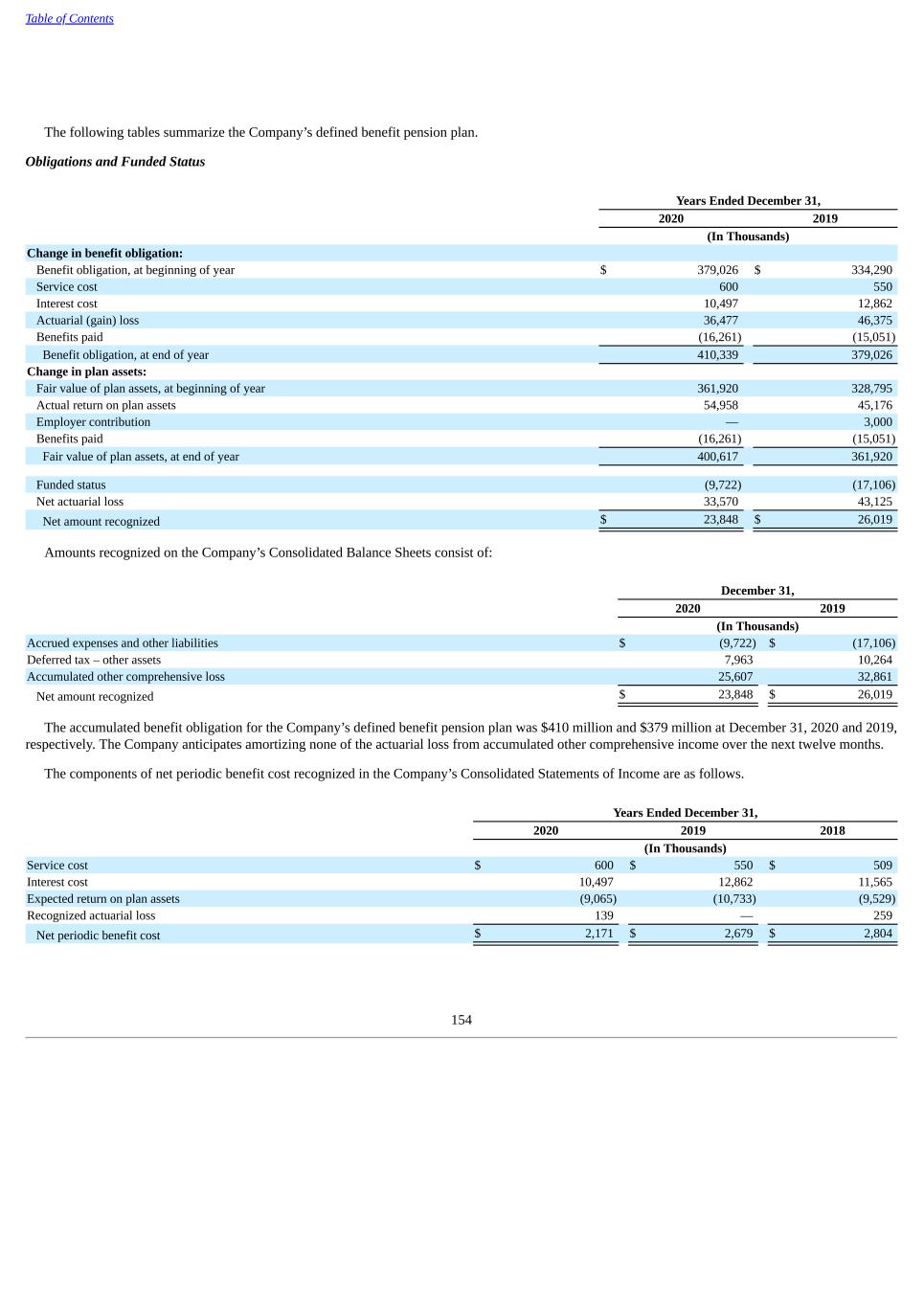
Table of Contents The following tables summarize the Company’s defined benefit pension plan. Obligations and Funded Status Years Ended December 31, 2020 2019 (In Thousands) Change in benefit obligation: Benefit obligation, at beginning of year $ 379,026 $ 334,290 Service cost 600 550 Interest cost 10,497 12,862 Actuarial (gain) loss 36,477 46,375 Benefits paid (16,261) (15,051) Benefit obligation, at end of year 410,339 379,026 Change in plan assets: Fair value of plan assets, at beginning of year 361,920 328,795 Actual return on plan assets 54,958 45,176 Employer contribution — 3,000 Benefits paid (16,261) (15,051) Fair value of plan assets, at end of year 400,617 361,920 Funded status (9,722) (17,106) Net actuarial loss 33,570 43,125 Net amount recognized $ 23,848 $ 26,019 Amounts recognized on the Company’s Consolidated Balance Sheets consist of: December 31, 2020 2019 (In Thousands) Accrued expenses and other liabilities $ (9,722) $ (17,106) Deferred tax – other assets 7,963 10,264 Accumulated other comprehensive loss 25,607 32,861 Net amount recognized $ 23,848 $ 26,019 The accumulated benefit obligation for the Company’s defined benefit pension plan was $410 million and $379 million at December 31, 2020 and 2019, respectively. The Company anticipates amortizing none of the actuarial loss from accumulated other comprehensive income over the next twelve months. The components of net periodic benefit cost recognized in the Company’s Consolidated Statements of Income are as follows. Years Ended December 31, 2020 2019 2018 (In Thousands) Service cost $ 600 $ 550 $ 509 Interest cost 10,497 12,862 11,565 Expected return on plan assets (9,065) (10,733) (9,529) Recognized actuarial loss 139 — 259 Net periodic benefit cost $ 2,171 $ 2,679 $ 2,804 154
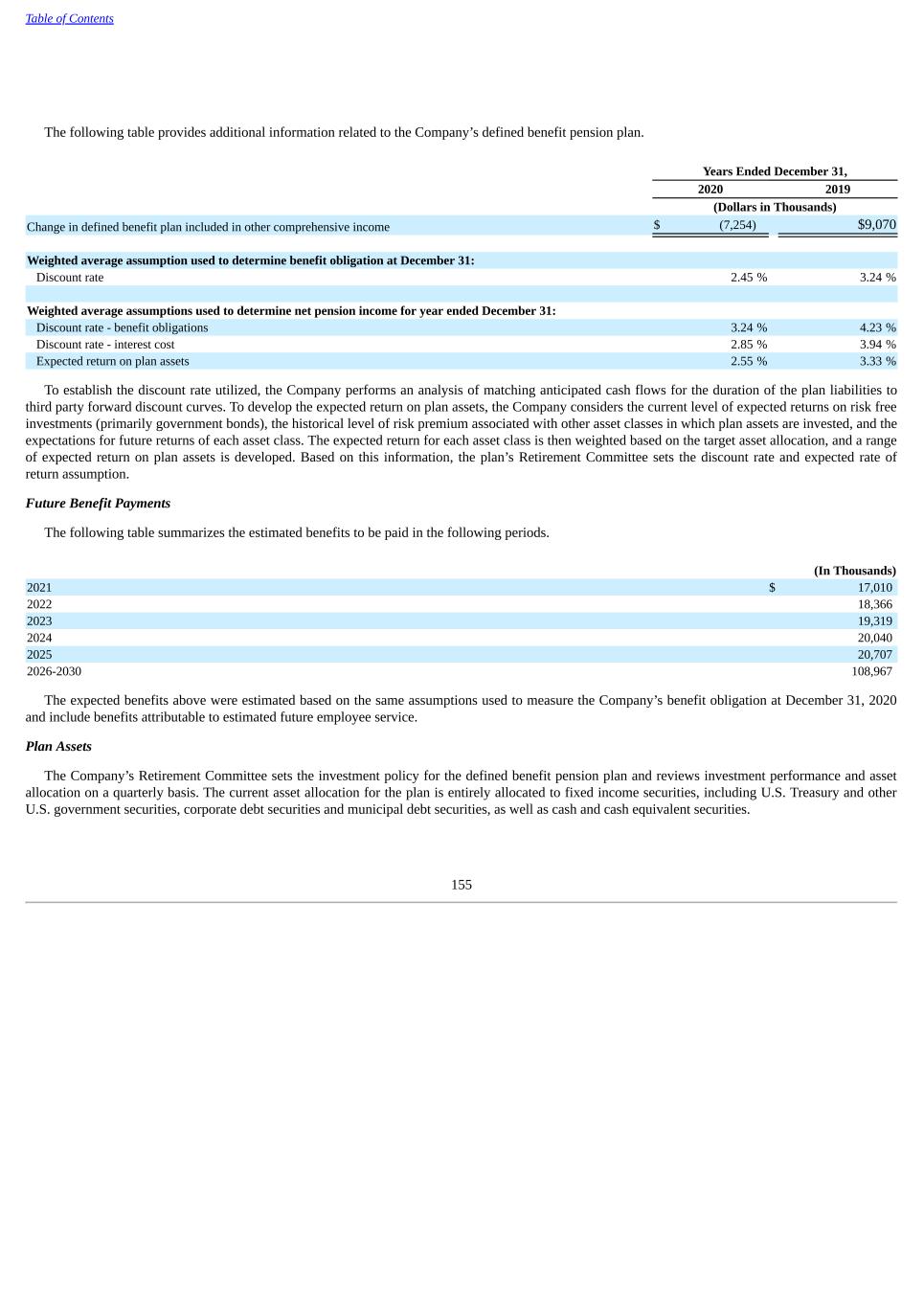
Table of Contents The following table provides additional information related to the Company’s defined benefit pension plan. Years Ended December 31, 2020 2019 (Dollars in Thousands) Change in defined benefit plan included in other comprehensive income $ (7,254) $9,070 Weighted average assumption used to determine benefit obligation at December 31: Discount rate 2.45 % 3.24 % Weighted average assumptions used to determine net pension income for year ended December 31: Discount rate - benefit obligations 3.24 % 4.23 % Discount rate - interest cost 2.85 % 3.94 % Expected return on plan assets 2.55 % 3.33 % To establish the discount rate utilized, the Company performs an analysis of matching anticipated cash flows for the duration of the plan liabilities to third party forward discount curves. To develop the expected return on plan assets, the Company considers the current level of expected returns on risk free investments (primarily government bonds), the historical level of risk premium associated with other asset classes in which plan assets are invested, and the expectations for future returns of each asset class. The expected return for each asset class is then weighted based on the target asset allocation, and a range of expected return on plan assets is developed. Based on this information, the plan’s Retirement Committee sets the discount rate and expected rate of return assumption. Future Benefit Payments The following table summarizes the estimated benefits to be paid in the following periods. (In Thousands) 2021 $ 17,010 2022 18,366 2023 19,319 2024 20,040 2025 20,707 2026-2030 108,967 The expected benefits above were estimated based on the same assumptions used to measure the Company’s benefit obligation at December 31, 2020 and include benefits attributable to estimated future employee service. Plan Assets The Company’s Retirement Committee sets the investment policy for the defined benefit pension plan and reviews investment performance and asset allocation on a quarterly basis. The current asset allocation for the plan is entirely allocated to fixed income securities, including U.S. Treasury and other U.S. government securities, corporate debt securities and municipal debt securities, as well as cash and cash equivalent securities. 155
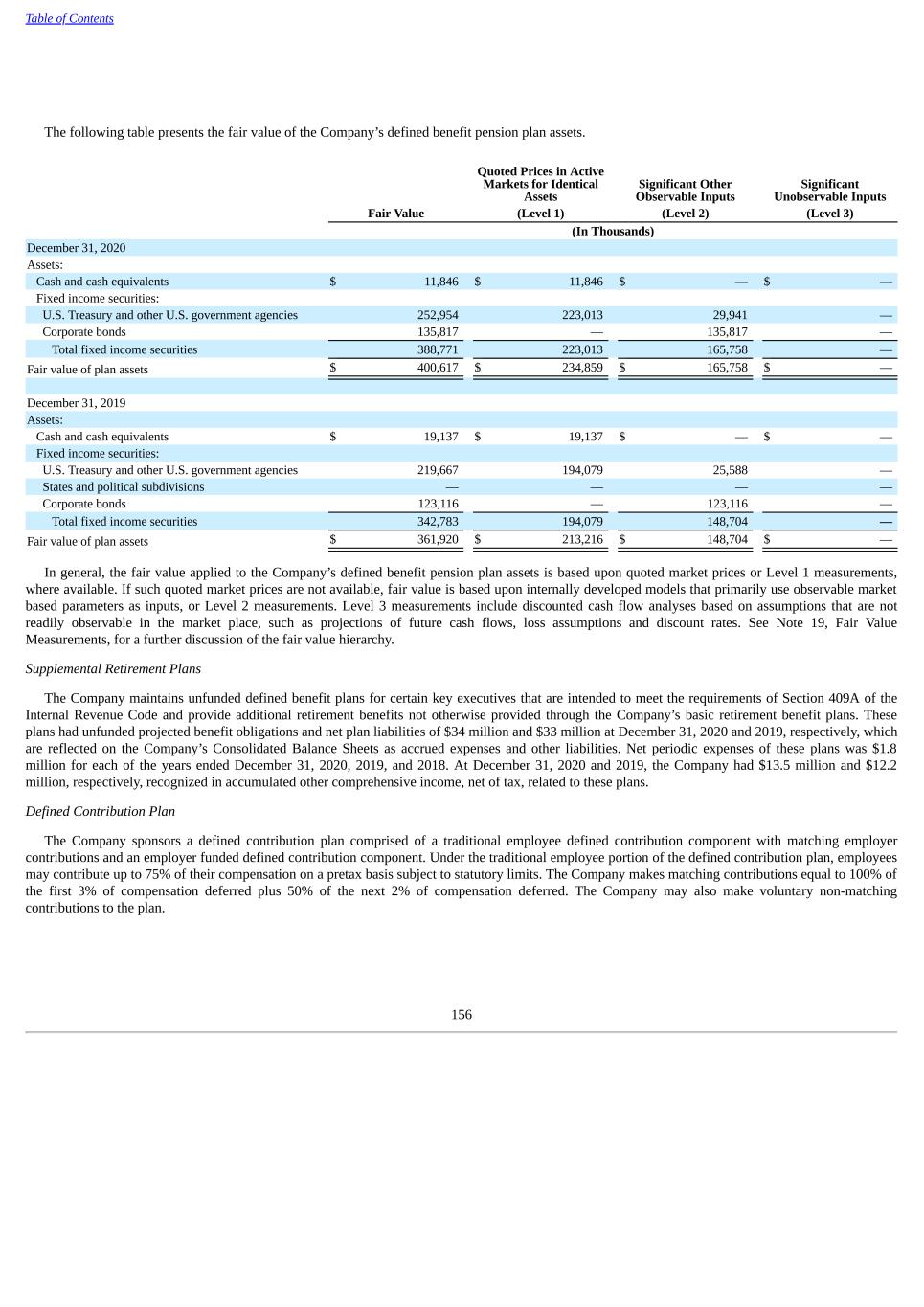
Table of Contents The following table presents the fair value of the Company’s defined benefit pension plan assets. Quoted Prices in Active Markets for Identical Assets Significant Other Observable Inputs Significant Unobservable Inputs Fair Value (Level 1) (Level 2) (Level 3) (In Thousands) December 31, 2020 Assets: Cash and cash equivalents $ 11,846 $ 11,846 $ — $ — Fixed income securities: U.S. Treasury and other U.S. government agencies 252,954 223,013 29,941 — Corporate bonds 135,817 — 135,817 — Total fixed income securities 388,771 223,013 165,758 — Fair value of plan assets $ 400,617 $ 234,859 $ 165,758 $ — December 31, 2019 Assets: Cash and cash equivalents $ 19,137 $ 19,137 $ — $ — Fixed income securities: U.S. Treasury and other U.S. government agencies 219,667 194,079 25,588 — States and political subdivisions — — — — Corporate bonds 123,116 — 123,116 — Total fixed income securities 342,783 194,079 148,704 — Fair value of plan assets $ 361,920 $ 213,216 $ 148,704 $ — In general, the fair value applied to the Company’s defined benefit pension plan assets is based upon quoted market prices or Level 1 measurements, where available. If such quoted market prices are not available, fair value is based upon internally developed models that primarily use observable market based parameters as inputs, or Level 2 measurements. Level 3 measurements include discounted cash flow analyses based on assumptions that are not readily observable in the market place, such as projections of future cash flows, loss assumptions and discount rates. See Note 19, Fair Value Measurements, for a further discussion of the fair value hierarchy. Supplemental Retirement Plans The Company maintains unfunded defined benefit plans for certain key executives that are intended to meet the requirements of Section 409A of the Internal Revenue Code and provide additional retirement benefits not otherwise provided through the Company’s basic retirement benefit plans. These plans had unfunded projected benefit obligations and net plan liabilities of $34 million and $33 million at December 31, 2020 and 2019, respectively, which are reflected on the Company’s Consolidated Balance Sheets as accrued expenses and other liabilities. Net periodic expenses of these plans was $1.8 million for each of the years ended December 31, 2020, 2019, and 2018. At December 31, 2020 and 2019, the Company had $13.5 million and $12.2 million, respectively, recognized in accumulated other comprehensive income, net of tax, related to these plans. Defined Contribution Plan The Company sponsors a defined contribution plan comprised of a traditional employee defined contribution component with matching employer contributions and an employer funded defined contribution component. Under the traditional employee portion of the defined contribution plan, employees may contribute up to 75% of their compensation on a pretax basis subject to statutory limits. The Company makes matching contributions equal to 100% of the first 3% of compensation deferred plus 50% of the next 2% of compensation deferred. The Company may also make voluntary non-matching contributions to the plan. 156
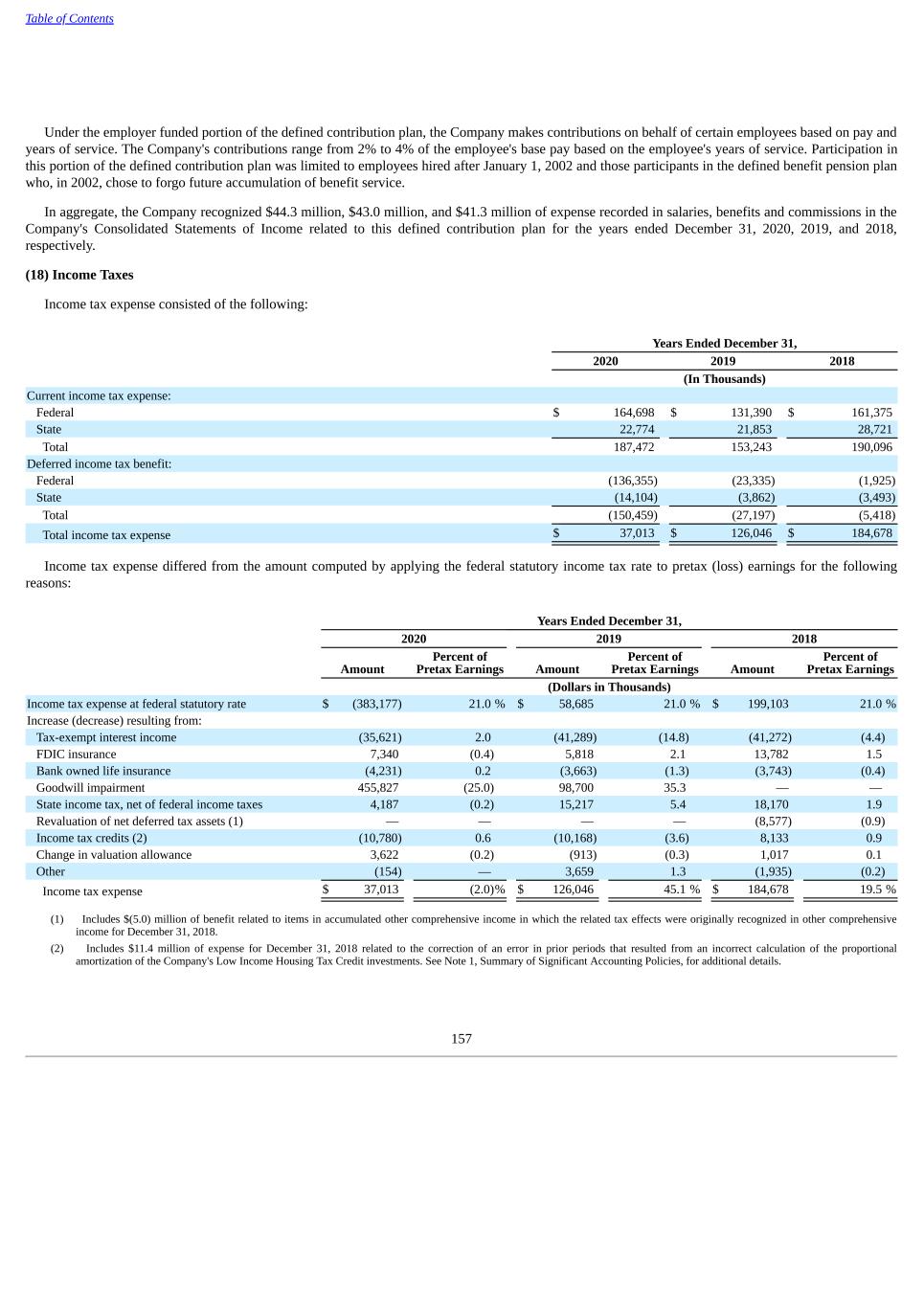
Table of Contents Under the employer funded portion of the defined contribution plan, the Company makes contributions on behalf of certain employees based on pay and years of service. The Company's contributions range from 2% to 4% of the employee's base pay based on the employee's years of service. Participation in this portion of the defined contribution plan was limited to employees hired after January 1, 2002 and those participants in the defined benefit pension plan who, in 2002, chose to forgo future accumulation of benefit service. In aggregate, the Company recognized $44.3 million, $43.0 million, and $41.3 million of expense recorded in salaries, benefits and commissions in the Company's Consolidated Statements of Income related to this defined contribution plan for the years ended December 31, 2020, 2019, and 2018, respectively. (18) Income Taxes Income tax expense consisted of the following: Years Ended December 31, 2020 2019 2018 (In Thousands) Current income tax expense: Federal $ 164,698 $ 131,390 $ 161,375 State 22,774 21,853 28,721 Total 187,472 153,243 190,096 Deferred income tax benefit: Federal (136,355) (23,335) (1,925) State (14,104) (3,862) (3,493) Total (150,459) (27,197) (5,418) Total income tax expense $ 37,013 $ 126,046 $ 184,678 Income tax expense differed from the amount computed by applying the federal statutory income tax rate to pretax (loss) earnings for the following reasons: Years Ended December 31, 2020 2019 2018 Amount Percent of Pretax Earnings Amount Percent of Pretax Earnings Amount Percent of Pretax Earnings (Dollars in Thousands) Income tax expense at federal statutory rate $ (383,177) 21.0 % $ 58,685 21.0 % $ 199,103 21.0 % Increase (decrease) resulting from: Tax-exempt interest income (35,621) 2.0 (41,289) (14.8) (41,272) (4.4) FDIC insurance 7,340 (0.4) 5,818 2.1 13,782 1.5 Bank owned life insurance (4,231) 0.2 (3,663) (1.3) (3,743) (0.4) Goodwill impairment 455,827 (25.0) 98,700 35.3 — — State income tax, net of federal income taxes 4,187 (0.2) 15,217 5.4 18,170 1.9 Revaluation of net deferred tax assets (1) — — — — (8,577) (0.9) Income tax credits (2) (10,780) 0.6 (10,168) (3.6) 8,133 0.9 Change in valuation allowance 3,622 (0.2) (913) (0.3) 1,017 0.1 Other (154) — 3,659 1.3 (1,935) (0.2) Income tax expense $ 37,013 (2.0)% $ 126,046 45.1 % $ 184,678 19.5 % (1) Includes $(5.0) million of benefit related to items in accumulated other comprehensive income in which the related tax effects were originally recognized in other comprehensive income for December 31, 2018. (2) Includes $11.4 million of expense for December 31, 2018 related to the correction of an error in prior periods that resulted from an incorrect calculation of the proportional amortization of the Company's Low Income Housing Tax Credit investments. See Note 1, Summary of Significant Accounting Policies, for additional details. 157
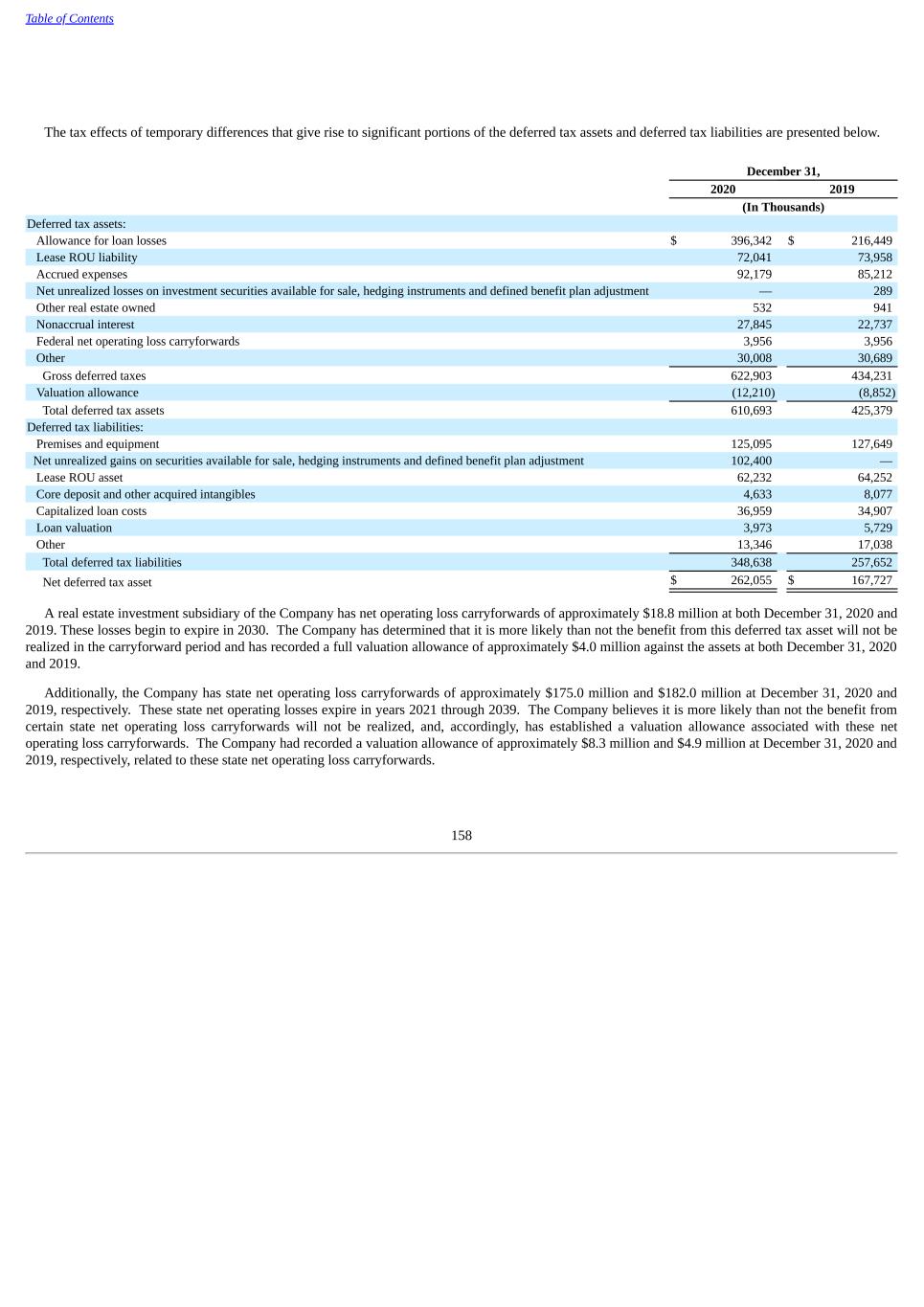
Table of Contents The tax effects of temporary differences that give rise to significant portions of the deferred tax assets and deferred tax liabilities are presented below. December 31, 2020 2019 (In Thousands) Deferred tax assets: Allowance for loan losses $ 396,342 $ 216,449 Lease ROU liability 72,041 73,958 Accrued expenses 92,179 85,212 Net unrealized losses on investment securities available for sale, hedging instruments and defined benefit plan adjustment — 289 Other real estate owned 532 941 Nonaccrual interest 27,845 22,737 Federal net operating loss carryforwards 3,956 3,956 Other 30,008 30,689 Gross deferred taxes 622,903 434,231 Valuation allowance (12,210) (8,852) Total deferred tax assets 610,693 425,379 Deferred tax liabilities: Premises and equipment 125,095 127,649 Net unrealized gains on securities available for sale, hedging instruments and defined benefit plan adjustment 102,400 — Lease ROU asset 62,232 64,252 Core deposit and other acquired intangibles 4,633 8,077 Capitalized loan costs 36,959 34,907 Loan valuation 3,973 5,729 Other 13,346 17,038 Total deferred tax liabilities 348,638 257,652 Net deferred tax asset $ 262,055 $ 167,727 A real estate investment subsidiary of the Company has net operating loss carryforwards of approximately $18.8 million at both December 31, 2020 and 2019. These losses begin to expire in 2030. The Company has determined that it is more likely than not the benefit from this deferred tax asset will not be realized in the carryforward period and has recorded a full valuation allowance of approximately $4.0 million against the assets at both December 31, 2020 and 2019. Additionally, the Company has state net operating loss carryforwards of approximately $175.0 million and $182.0 million at December 31, 2020 and 2019, respectively. These state net operating losses expire in years 2021 through 2039. The Company believes it is more likely than not the benefit from certain state net operating loss carryforwards will not be realized, and, accordingly, has established a valuation allowance associated with these net operating loss carryforwards. The Company had recorded a valuation allowance of approximately $8.3 million and $4.9 million at December 31, 2020 and 2019, respectively, related to these state net operating loss carryforwards. 158
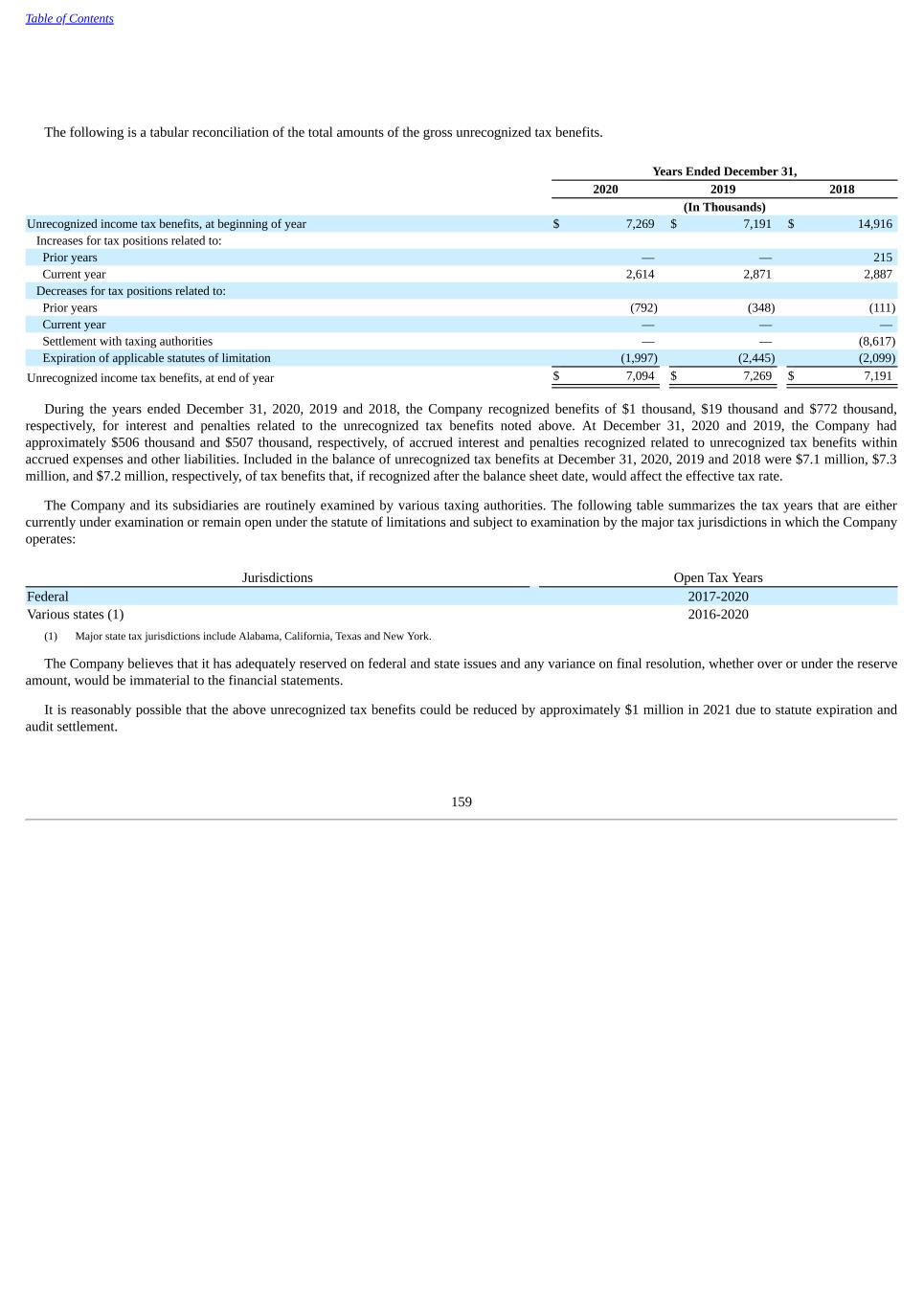
Table of Contents The following is a tabular reconciliation of the total amounts of the gross unrecognized tax benefits. Years Ended December 31, 2020 2019 2018 (In Thousands) Unrecognized income tax benefits, at beginning of year $ 7,269 $ 7,191 $ 14,916 Increases for tax positions related to: Prior years — — 215 Current year 2,614 2,871 2,887 Decreases for tax positions related to: Prior years (792) (348) (111) Current year — — — Settlement with taxing authorities — — (8,617) Expiration of applicable statutes of limitation (1,997) (2,445) (2,099) Unrecognized income tax benefits, at end of year $ 7,094 $ 7,269 $ 7,191 During the years ended December 31, 2020, 2019 and 2018, the Company recognized benefits of $1 thousand, $19 thousand and $772 thousand, respectively, for interest and penalties related to the unrecognized tax benefits noted above. At December 31, 2020 and 2019, the Company had approximately $506 thousand and $507 thousand, respectively, of accrued interest and penalties recognized related to unrecognized tax benefits within accrued expenses and other liabilities. Included in the balance of unrecognized tax benefits at December 31, 2020, 2019 and 2018 were $7.1 million, $7.3 million, and $7.2 million, respectively, of tax benefits that, if recognized after the balance sheet date, would affect the effective tax rate. The Company and its subsidiaries are routinely examined by various taxing authorities. The following table summarizes the tax years that are either currently under examination or remain open under the statute of limitations and subject to examination by the major tax jurisdictions in which the Company operates: Jurisdictions Open Tax Years Federal 2017-2020 Various states (1) 2016-2020 (1) Major state tax jurisdictions include Alabama, California, Texas and New York. The Company believes that it has adequately reserved on federal and state issues and any variance on final resolution, whether over or under the reserve amount, would be immaterial to the financial statements. It is reasonably possible that the above unrecognized tax benefits could be reduced by approximately $1 million in 2021 due to statute expiration and audit settlement. 159

Table of Contents (19) Fair Value Measurements The Company applies the fair value accounting guidance required under ASC Topic 820 which establishes a framework for measuring fair value. This guidance defines fair value as the exchange price that would be received for an asset or paid to transfer a liability in the principal or most advantageous market for the asset or liability in an orderly transaction between market participants at the measurement date. This guidance also establishes a fair value hierarchy which requires an entity to maximize the use of observable inputs and minimize the use of unobservable inputs when measuring fair value. A financial instrument’s categorization within this fair value hierarchy is based upon the lowest level of input that is significant to the instrument’s fair value measurement. The three levels within the fair value hierarchy are described as follows. • Level 1 – Fair value is based on quoted prices in an active market for identical assets or liabilities. • Level 2 – Fair value is based on quoted market prices for similar instruments traded in active markets, quoted prices for identical or similar instruments in markets that are not active and model-based valuation techniques for which all significant assumptions are observable in the market. • Level 3 – Fair value is based on unobservable inputs that are supported by little or no market activity and that are significant to the fair value of the assets or liabilities. Level 3 assets and liabilities would include financial instruments whose value is determined using pricing models, discounted cash flow methodologies, or similar pricing techniques based on the Company’s own assumptions about what market participants would use to price the asset or liability. A description of the valuation methodologies used for instruments measured at fair value, as well as the general classification of such instruments under the fair value hierarchy, is set forth below. These valuation methodologies were applied to the Company’s financial assets and financial liabilities carried at fair value. In general, fair value is based upon quoted market prices, where available. If such quoted market prices are not available, fair value is based upon internally developed models that primarily use observable market based parameters as inputs. Valuation adjustments may be made to ensure that financial instruments are recorded at fair value. These adjustments may include amounts to reflect counterparty credit quality and the Company’s creditworthiness, among other things, as well as other unobservable parameters. Any such valuation adjustments are applied consistently over time. While management believes the Company’s valuation methodologies are appropriate and consistent with other market participants, the use of different methodologies or assumptions to determine the fair value of certain financial instruments could result in a different estimate of fair value at the reporting date. The Company’s valuation methodologies may produce a fair value calculation that may not be indicative of net realizable value or reflective of future fair values. Furthermore, the reported fair value amounts have not been comprehensively revalued since the presentation dates, and, therefore, estimates of fair value after the balance sheet date may differ significantly from the amounts presented herein. Financial Instruments Measured at Fair Value on a Recurring Basis Trading account assets and liabilities, securities available for sale, certain mortgage loans held for sale, derivative assets and liabilities, and mortgage servicing rights are recorded at fair value on a recurring basis. The following is a description of the valuation methodologies for these assets and liabilities. Trading account assets and liabilities and debt securities available for sale – Trading account assets and liabilities and debt securities available for sale consist of U.S. Treasury securities and other U.S. government agency securities, mortgage-backed securities, collateralized mortgage obligations, debt obligations of state and political subdivisions, other debt securities, and derivative contracts. • U.S. Treasury securities and other U.S. government agency securities are valued based on quoted market prices of identical assets on active exchanges (Level 1 measurements) or are valued based on a market approach using observable inputs such as benchmark yields, reported trades, broker/dealer quotes, benchmark securities, and bids/offers of government-sponsored enterprise securities (Level 2 measurements). • Mortgage-backed securities are primarily valued using market-based pricing matrices that are based on observable inputs including benchmark To Be Announced security prices, U.S. Treasury yields, U.S. dollar swap yields, and benchmark floating-rate indices. Mortgage-backed securities pricing may also give consideration to pool-specific data such as prepayment history and collateral characteristics. Valuations for mortgage-backed securities are therefore classified as Level 2 measurements. 160
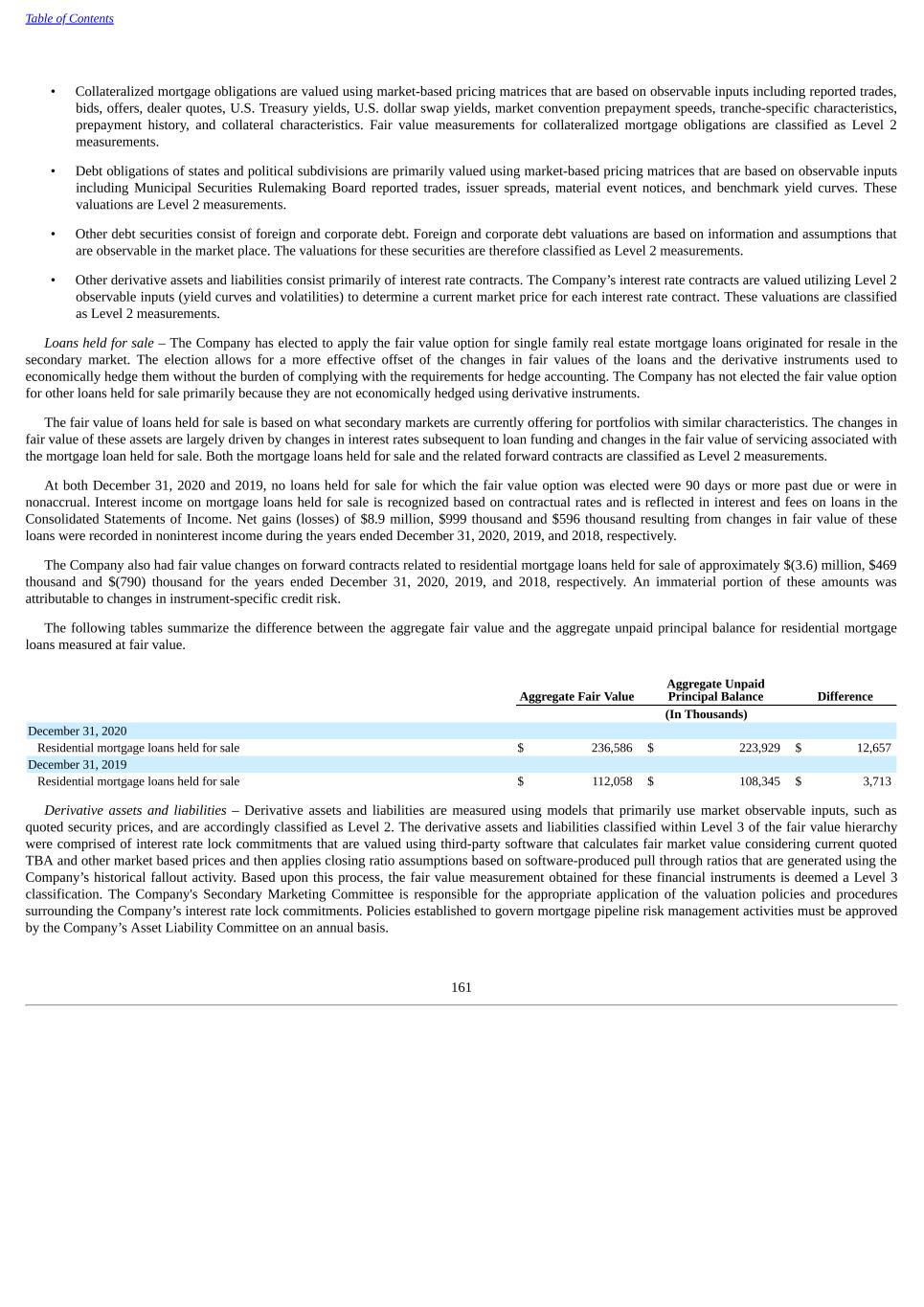
Table of Contents • Collateralized mortgage obligations are valued using market-based pricing matrices that are based on observable inputs including reported trades, bids, offers, dealer quotes, U.S. Treasury yields, U.S. dollar swap yields, market convention prepayment speeds, tranche-specific characteristics, prepayment history, and collateral characteristics. Fair value measurements for collateralized mortgage obligations are classified as Level 2 measurements. • Debt obligations of states and political subdivisions are primarily valued using market-based pricing matrices that are based on observable inputs including Municipal Securities Rulemaking Board reported trades, issuer spreads, material event notices, and benchmark yield curves. These valuations are Level 2 measurements. • Other debt securities consist of foreign and corporate debt. Foreign and corporate debt valuations are based on information and assumptions that are observable in the market place. The valuations for these securities are therefore classified as Level 2 measurements. • Other derivative assets and liabilities consist primarily of interest rate contracts. The Company’s interest rate contracts are valued utilizing Level 2 observable inputs (yield curves and volatilities) to determine a current market price for each interest rate contract. These valuations are classified as Level 2 measurements. Loans held for sale – The Company has elected to apply the fair value option for single family real estate mortgage loans originated for resale in the secondary market. The election allows for a more effective offset of the changes in fair values of the loans and the derivative instruments used to economically hedge them without the burden of complying with the requirements for hedge accounting. The Company has not elected the fair value option for other loans held for sale primarily because they are not economically hedged using derivative instruments. The fair value of loans held for sale is based on what secondary markets are currently offering for portfolios with similar characteristics. The changes in fair value of these assets are largely driven by changes in interest rates subsequent to loan funding and changes in the fair value of servicing associated with the mortgage loan held for sale. Both the mortgage loans held for sale and the related forward contracts are classified as Level 2 measurements. At both December 31, 2020 and 2019, no loans held for sale for which the fair value option was elected were 90 days or more past due or were in nonaccrual. Interest income on mortgage loans held for sale is recognized based on contractual rates and is reflected in interest and fees on loans in the Consolidated Statements of Income. Net gains (losses) of $8.9 million, $999 thousand and $596 thousand resulting from changes in fair value of these loans were recorded in noninterest income during the years ended December 31, 2020, 2019, and 2018, respectively. The Company also had fair value changes on forward contracts related to residential mortgage loans held for sale of approximately $(3.6) million, $469 thousand and $(790) thousand for the years ended December 31, 2020, 2019, and 2018, respectively. An immaterial portion of these amounts was attributable to changes in instrument-specific credit risk. The following tables summarize the difference between the aggregate fair value and the aggregate unpaid principal balance for residential mortgage loans measured at fair value. Aggregate Fair Value Aggregate Unpaid Principal Balance Difference (In Thousands) December 31, 2020 Residential mortgage loans held for sale $ 236,586 $ 223,929 $ 12,657 December 31, 2019 Residential mortgage loans held for sale $ 112,058 $ 108,345 $ 3,713 Derivative assets and liabilities – Derivative assets and liabilities are measured using models that primarily use market observable inputs, such as quoted security prices, and are accordingly classified as Level 2. The derivative assets and liabilities classified within Level 3 of the fair value hierarchy were comprised of interest rate lock commitments that are valued using third-party software that calculates fair market value considering current quoted TBA and other market based prices and then applies closing ratio assumptions based on software-produced pull through ratios that are generated using the Company’s historical fallout activity. Based upon this process, the fair value measurement obtained for these financial instruments is deemed a Level 3 classification. The Company's Secondary Marketing Committee is responsible for the appropriate application of the valuation policies and procedures surrounding the Company’s interest rate lock commitments. Policies established to govern mortgage pipeline risk management activities must be approved by the Company’s Asset Liability Committee on an annual basis. 161
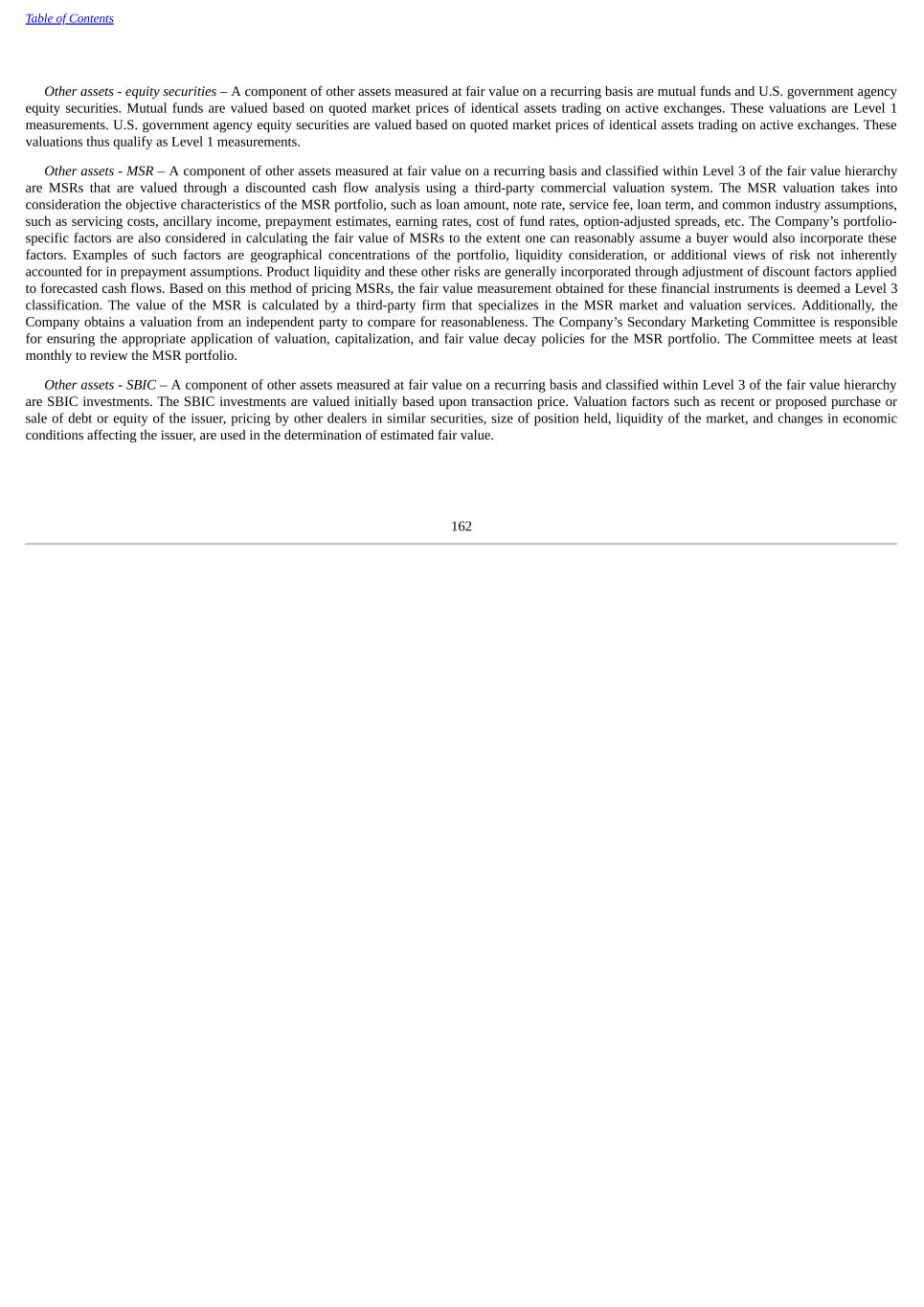
Table of Contents Other assets - equity securities – A component of other assets measured at fair value on a recurring basis are mutual funds and U.S. government agency equity securities. Mutual funds are valued based on quoted market prices of identical assets trading on active exchanges. These valuations are Level 1 measurements. U.S. government agency equity securities are valued based on quoted market prices of identical assets trading on active exchanges. These valuations thus qualify as Level 1 measurements. Other assets - MSR – A component of other assets measured at fair value on a recurring basis and classified within Level 3 of the fair value hierarchy are MSRs that are valued through a discounted cash flow analysis using a third-party commercial valuation system. The MSR valuation takes into consideration the objective characteristics of the MSR portfolio, such as loan amount, note rate, service fee, loan term, and common industry assumptions, such as servicing costs, ancillary income, prepayment estimates, earning rates, cost of fund rates, option-adjusted spreads, etc. The Company’s portfolio- specific factors are also considered in calculating the fair value of MSRs to the extent one can reasonably assume a buyer would also incorporate these factors. Examples of such factors are geographical concentrations of the portfolio, liquidity consideration, or additional views of risk not inherently accounted for in prepayment assumptions. Product liquidity and these other risks are generally incorporated through adjustment of discount factors applied to forecasted cash flows. Based on this method of pricing MSRs, the fair value measurement obtained for these financial instruments is deemed a Level 3 classification. The value of the MSR is calculated by a third-party firm that specializes in the MSR market and valuation services. Additionally, the Company obtains a valuation from an independent party to compare for reasonableness. The Company’s Secondary Marketing Committee is responsible for ensuring the appropriate application of valuation, capitalization, and fair value decay policies for the MSR portfolio. The Committee meets at least monthly to review the MSR portfolio. Other assets - SBIC – A component of other assets measured at fair value on a recurring basis and classified within Level 3 of the fair value hierarchy are SBIC investments. The SBIC investments are valued initially based upon transaction price. Valuation factors such as recent or proposed purchase or sale of debt or equity of the issuer, pricing by other dealers in similar securities, size of position held, liquidity of the market, and changes in economic conditions affecting the issuer, are used in the determination of estimated fair value. 162
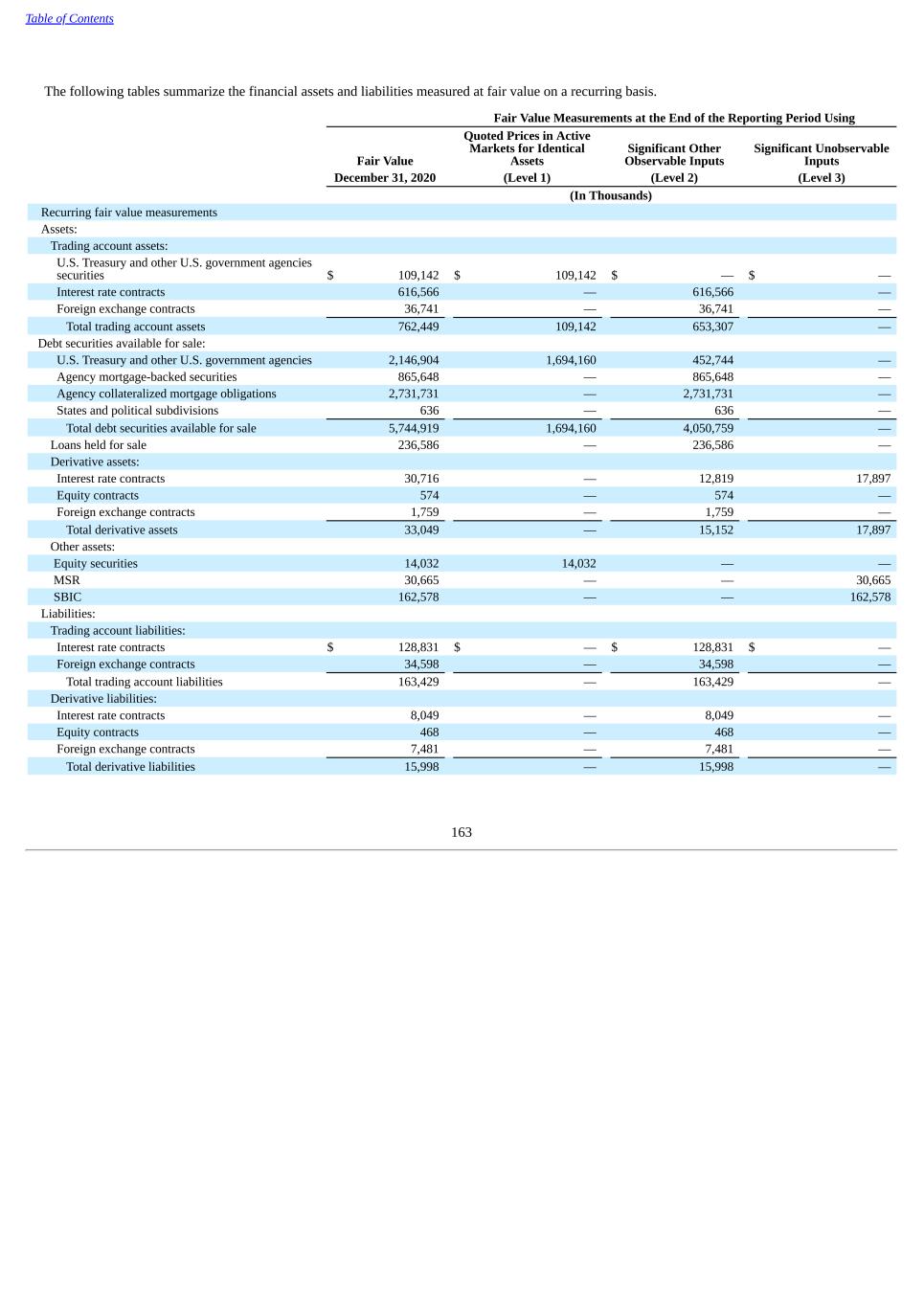
Table of Contents The following tables summarize the financial assets and liabilities measured at fair value on a recurring basis. Fair Value Measurements at the End of the Reporting Period Using Fair Value Quoted Prices in Active Markets for Identical Assets Significant Other Observable Inputs Significant Unobservable Inputs December 31, 2020 (Level 1) (Level 2) (Level 3) (In Thousands) Recurring fair value measurements Assets: Trading account assets: U.S. Treasury and other U.S. government agencies securities $ 109,142 $ 109,142 $ — $ — Interest rate contracts 616,566 — 616,566 — Foreign exchange contracts 36,741 — 36,741 — Total trading account assets 762,449 109,142 653,307 — Debt securities available for sale: U.S. Treasury and other U.S. government agencies 2,146,904 1,694,160 452,744 — Agency mortgage-backed securities 865,648 — 865,648 — Agency collateralized mortgage obligations 2,731,731 — 2,731,731 — States and political subdivisions 636 — 636 — Total debt securities available for sale 5,744,919 1,694,160 4,050,759 — Loans held for sale 236,586 — 236,586 — Derivative assets: Interest rate contracts 30,716 — 12,819 17,897 Equity contracts 574 — 574 — Foreign exchange contracts 1,759 — 1,759 — Total derivative assets 33,049 — 15,152 17,897 Other assets: Equity securities 14,032 14,032 — — MSR 30,665 — — 30,665 SBIC 162,578 — — 162,578 Liabilities: Trading account liabilities: Interest rate contracts $ 128,831 $ — $ 128,831 $ — Foreign exchange contracts 34,598 — 34,598 — Total trading account liabilities 163,429 — 163,429 — Derivative liabilities: Interest rate contracts 8,049 — 8,049 — Equity contracts 468 — 468 — Foreign exchange contracts 7,481 — 7,481 — Total derivative liabilities 15,998 — 15,998 — 163
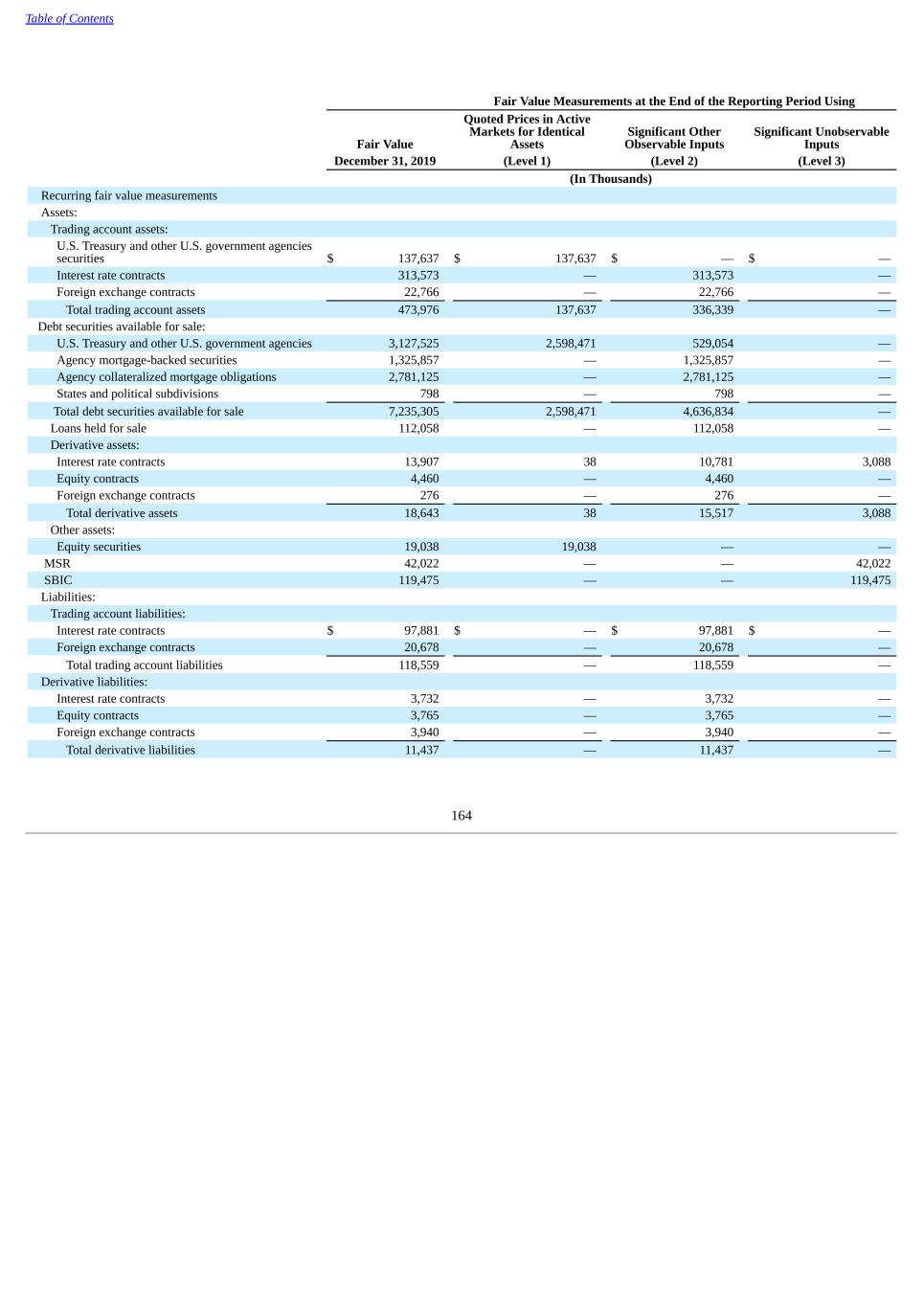
Table of Contents Fair Value Measurements at the End of the Reporting Period Using Fair Value Quoted Prices in Active Markets for Identical Assets Significant Other Observable Inputs Significant Unobservable Inputs December 31, 2019 (Level 1) (Level 2) (Level 3) (In Thousands) Recurring fair value measurements Assets: Trading account assets: U.S. Treasury and other U.S. government agencies securities $ 137,637 $ 137,637 $ — $ — Interest rate contracts 313,573 — 313,573 — Foreign exchange contracts 22,766 — 22,766 — Total trading account assets 473,976 137,637 336,339 — Debt securities available for sale: U.S. Treasury and other U.S. government agencies 3,127,525 2,598,471 529,054 — Agency mortgage-backed securities 1,325,857 — 1,325,857 — Agency collateralized mortgage obligations 2,781,125 — 2,781,125 — States and political subdivisions 798 — 798 — Total debt securities available for sale 7,235,305 2,598,471 4,636,834 — Loans held for sale 112,058 — 112,058 — Derivative assets: Interest rate contracts 13,907 38 10,781 3,088 Equity contracts 4,460 — 4,460 — Foreign exchange contracts 276 — 276 — Total derivative assets 18,643 38 15,517 3,088 Other assets: Equity securities 19,038 19,038 — — MSR 42,022 — — 42,022 SBIC 119,475 — — 119,475 Liabilities: Trading account liabilities: Interest rate contracts $ 97,881 $ — $ 97,881 $ — Foreign exchange contracts 20,678 — 20,678 — Total trading account liabilities 118,559 — 118,559 — Derivative liabilities: Interest rate contracts 3,732 — 3,732 — Equity contracts 3,765 — 3,765 — Foreign exchange contracts 3,940 — 3,940 — Total derivative liabilities 11,437 — 11,437 — 164
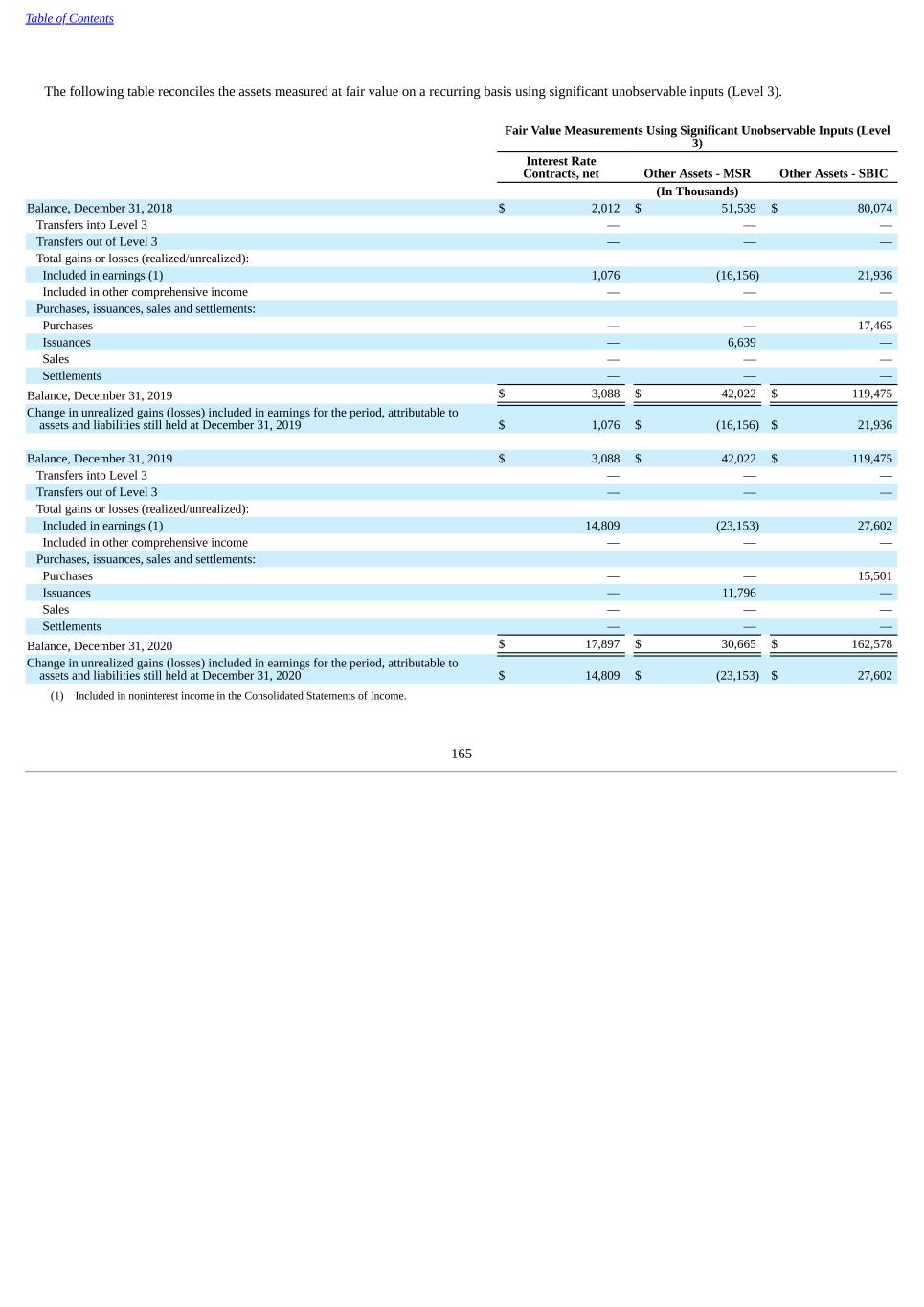
Table of Contents The following table reconciles the assets measured at fair value on a recurring basis using significant unobservable inputs (Level 3). Fair Value Measurements Using Significant Unobservable Inputs (Level 3) Interest Rate Contracts, net Other Assets - MSR Other Assets - SBIC (In Thousands) Balance, December 31, 2018 $ 2,012 $ 51,539 $ 80,074 Transfers into Level 3 — — — Transfers out of Level 3 — — — Total gains or losses (realized/unrealized): Included in earnings (1) 1,076 (16,156) 21,936 Included in other comprehensive income — — — Purchases, issuances, sales and settlements: Purchases — — 17,465 Issuances — 6,639 — Sales — — — Settlements — — — Balance, December 31, 2019 $ 3,088 $ 42,022 $ 119,475 Change in unrealized gains (losses) included in earnings for the period, attributable to assets and liabilities still held at December 31, 2019 $ 1,076 $ (16,156) $ 21,936 Balance, December 31, 2019 $ 3,088 $ 42,022 $ 119,475 Transfers into Level 3 — — — Transfers out of Level 3 — — — Total gains or losses (realized/unrealized): Included in earnings (1) 14,809 (23,153) 27,602 Included in other comprehensive income — — — Purchases, issuances, sales and settlements: Purchases — — 15,501 Issuances — 11,796 — Sales — — — Settlements — — — Balance, December 31, 2020 $ 17,897 $ 30,665 $ 162,578 Change in unrealized gains (losses) included in earnings for the period, attributable to assets and liabilities still held at December 31, 2020 $ 14,809 $ (23,153) $ 27,602 (1) Included in noninterest income in the Consolidated Statements of Income. 165
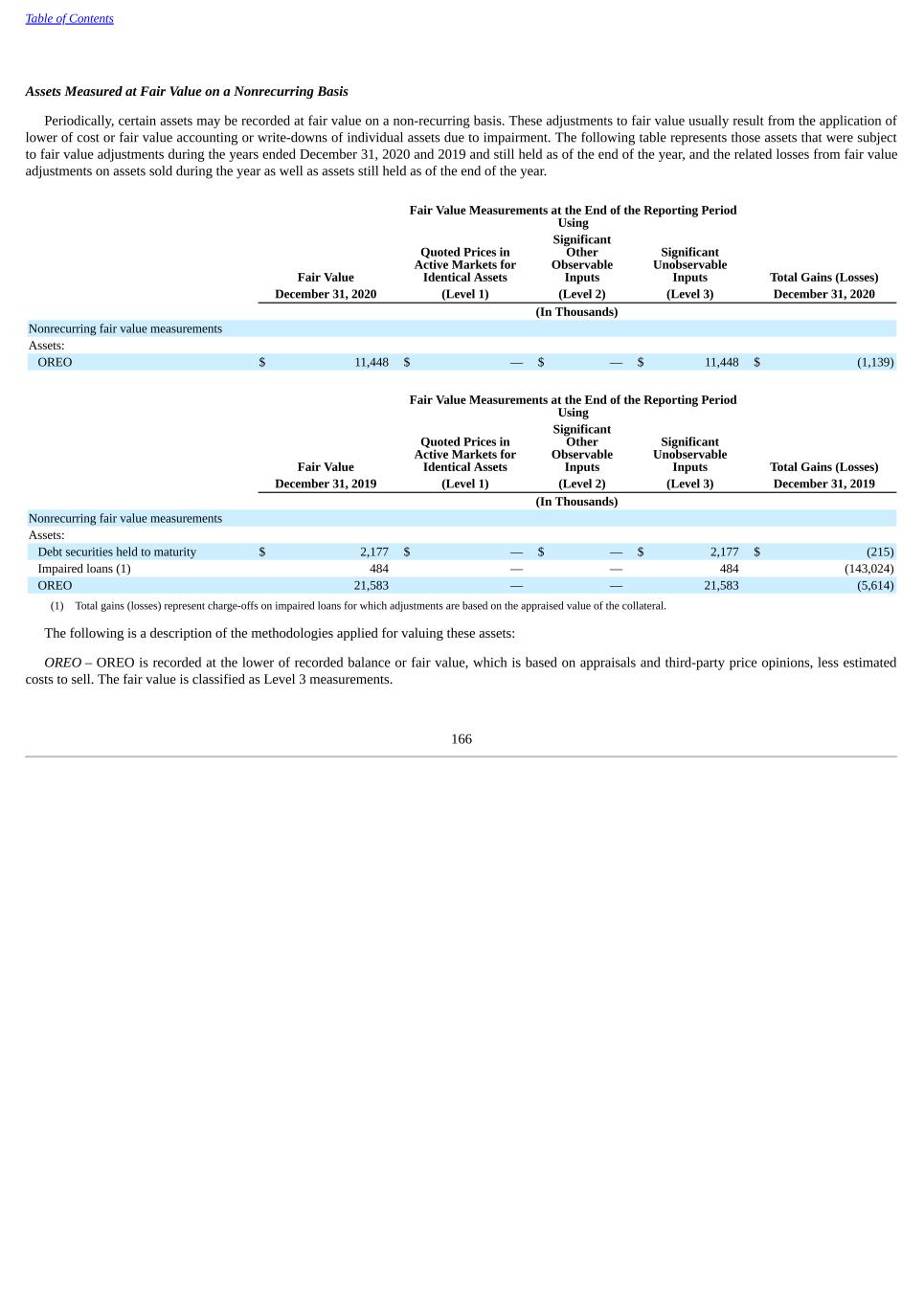
Table of Contents Assets Measured at Fair Value on a Nonrecurring Basis Periodically, certain assets may be recorded at fair value on a non-recurring basis. These adjustments to fair value usually result from the application of lower of cost or fair value accounting or write-downs of individual assets due to impairment. The following table represents those assets that were subject to fair value adjustments during the years ended December 31, 2020 and 2019 and still held as of the end of the year, and the related losses from fair value adjustments on assets sold during the year as well as assets still held as of the end of the year. Fair Value Measurements at the End of the Reporting Period Using Fair Value Quoted Prices in Active Markets for Identical Assets Significant Other Observable Inputs Significant Unobservable Inputs Total Gains (Losses) December 31, 2020 (Level 1) (Level 2) (Level 3) December 31, 2020 (In Thousands) Nonrecurring fair value measurements Assets: OREO $ 11,448 $ — $ — $ 11,448 $ (1,139) Fair Value Measurements at the End of the Reporting Period Using Fair Value Quoted Prices in Active Markets for Identical Assets Significant Other Observable Inputs Significant Unobservable Inputs Total Gains (Losses) December 31, 2019 (Level 1) (Level 2) (Level 3) December 31, 2019 (In Thousands) Nonrecurring fair value measurements Assets: Debt securities held to maturity $ 2,177 $ — $ — $ 2,177 $ (215) Impaired loans (1) 484 — — 484 (143,024) OREO 21,583 — — 21,583 (5,614) (1) Total gains (losses) represent charge-offs on impaired loans for which adjustments are based on the appraised value of the collateral. The following is a description of the methodologies applied for valuing these assets: OREO – OREO is recorded at the lower of recorded balance or fair value, which is based on appraisals and third-party price opinions, less estimated costs to sell. The fair value is classified as Level 3 measurements. 166

Table of Contents The tables below present quantitative information about the significant unobservable inputs for material assets and liabilities measured at fair value using significant unobservable inputs (Level 3) on a recurring and nonrecurring basis. Quantitative Information about Level 3 Fair Value Measurements Fair Value at Range of Unobservable Inputs December 31, 2020 Valuation Technique Unobservable Input(s) (Weighted Average) (In Thousands) Recurring fair value measurements: Interest rate contracts $ 17,897 Discounted cash flow Closing ratios (pull-through) 18.2% - 100.0% (62.5%) Cap grids 0.3% - 2.6% (1.0%) Other assets - MSRs 30,665 Discounted cash flow Option adjusted spread 6.0% - 8.3% (6.2%) Constant prepayment rate or life speed 3.5% - 90.3% (19.9%) Cost to service $65 - $4,000 ($100) Other assets - SBIC investments 162,578 Transaction price Transaction price N/A Nonrecurring fair value measurements: OREO $ 11,448 Appraised value Appraised value 8.0% (1) (1) Represents discounts to appraised value for estimated costs to sell. Quantitative Information about Level 3 Fair Value Measurements Fair Value at Range of Unobservable Inputs December 31, 2019 Valuation Technique Unobservable Input(s) (Weighted Average) (In Thousands) Recurring fair value measurements: Interest rate contracts $ 3,088 Discounted cash flow Closing ratios (pull-through) 16.8% - 100.0% (60.1%) Cap grids 0.5% - 2.5% (0.9%) Other assets - MSRs 42,022 Discounted cash flow Option adjusted spread 6.0% - 9.0% (6.4%) Constant prepayment rate or life speed 0.0% - 80.0% (14.6%) Cost to service $65 - $4,000 ($90) Other assets - SBIC investments 119,475 Transaction price Transaction price N/A Nonrecurring fair value measurements: Debt securities held to maturity $ 2,177 Discounted cash flow Prepayment rate 13.7% - 14.7% (14.2%) Default rate 3.1% - 4.9% (4.0%) Loss severity 50.3% - 61.9% (56.1%) Impaired loans 484 Appraised value Appraised value 0.0% - 70.0% (9.7%) OREO 21,583 Appraised value Appraised value 8.0% (1) (1) Represents discounts to appraised value for estimated costs to sell. The following provides a description of the sensitivity of the valuation technique to changes in unobservable inputs for recurring fair value measurements. Recurring Fair Value Measurements Using Significant Unobservable Inputs Interest Rate Contracts - Interest Rate Lock Commitments Significant unobservable inputs used in the valuation of interest rate contracts are pull-through and cap grids. Increases or decreases in the pull-through or cap grids will have a corresponding impact in the value of interest rate contracts. 167

Table of Contents Other Assets - MSRs The significant unobservable inputs used in the fair value measurement of MSRs are option-adjusted spreads, constant prepayment rate or life speed, and cost to service assumptions. The impact of prepayments and changes in the option-adjusted spread are based on a variety of underlying inputs. Increases or decreases to the underlying cash flow inputs will have a corresponding impact on the value of the MSR asset. The impact of the costs to service assumption will have a directionally opposite change in the fair value of the MSR asset. Other Assets - SBIC Investments The significant unobservable inputs used in the fair value measurement of SBIC Investments are initially based upon transaction price. Increases or decreases in valuation factors such as recent or proposed purchase or sale of debt or equity of the issuer, pricing by other dealers in similar securities, size of position held, liquidity of the market will have a corresponding impact in the value of SBIC investments. Fair Value of Financial Instruments The carrying amounts and estimated fair values, as well as the level within the fair value hierarchy, of the Company’s financial instruments are as follows: December 31, 2020 Carrying Amount Estimated Fair Value Level 1 Level 2 Level 3 (In Thousands) Financial Instruments: Assets: Cash and cash equivalents $ 14,607,908 $ 14,607,908 $ 14,607,908 $ — $ — Debt securities held to maturity 10,552,123 10,809,461 1,404,868 8,837,070 567,523 Loans 65,559,767 64,459,914 — — 64,459,914 Liabilities: Deposits $ 85,858,381 $ 85,872,252 $ — $ 85,872,252 $ — FHLB and other borrowings 3,548,492 3,489,951 — 3,489,951 — Federal funds purchased and securities sold under agreements to repurchase 184,478 184,478 — 184,478 — December 31, 2019 Carrying Amount Estimated Fair Value Level 1 Level 2 Level 3 (In Thousands) Financial Instruments: Assets: Cash and cash equivalents $ 6,938,698 $ 6,938,698 $ 6,938,698 $ — $ — Debt securities held to maturity 6,797,046 6,921,158 1,340,448 4,912,399 668,311 Loans 63,946,857 60,869,662 — — 60,869,662 Liabilities: Deposits $ 74,985,283 $ 75,024,350 $ — $ 75,024,350 $ — FHLB and other borrowings 3,690,044 3,721,949 — 3,721,949 — Federal funds purchased and securities sold under agreements to repurchase 173,028 173,028 — 173,028 — 168
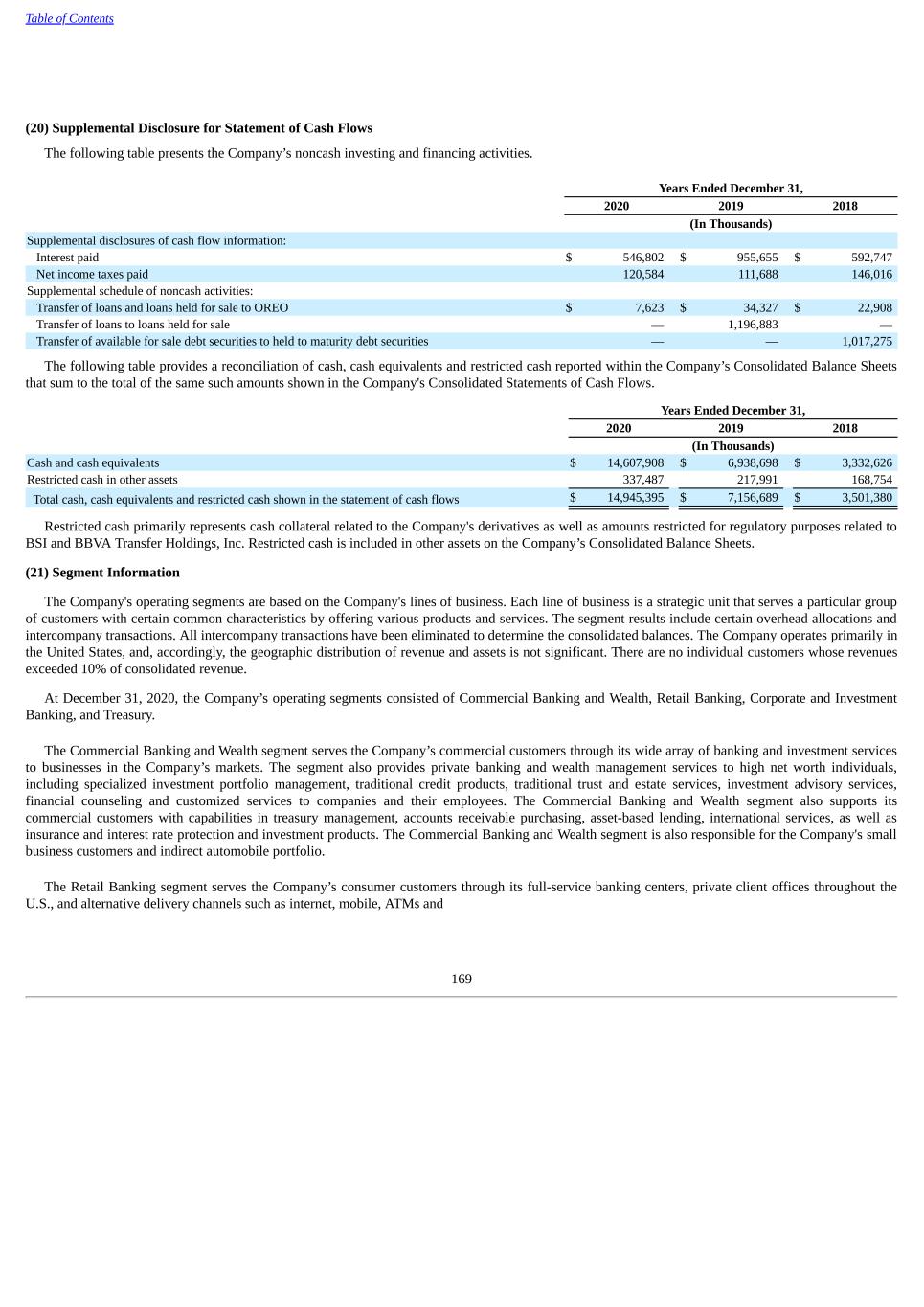
Table of Contents (20) Supplemental Disclosure for Statement of Cash Flows The following table presents the Company’s noncash investing and financing activities. Years Ended December 31, 2020 2019 2018 (In Thousands) Supplemental disclosures of cash flow information: Interest paid $ 546,802 $ 955,655 $ 592,747 Net income taxes paid 120,584 111,688 146,016 Supplemental schedule of noncash activities: Transfer of loans and loans held for sale to OREO $ 7,623 $ 34,327 $ 22,908 Transfer of loans to loans held for sale — 1,196,883 — Transfer of available for sale debt securities to held to maturity debt securities — — 1,017,275 The following table provides a reconciliation of cash, cash equivalents and restricted cash reported within the Company’s Consolidated Balance Sheets that sum to the total of the same such amounts shown in the Company's Consolidated Statements of Cash Flows. Years Ended December 31, 2020 2019 2018 (In Thousands) Cash and cash equivalents $ 14,607,908 $ 6,938,698 $ 3,332,626 Restricted cash in other assets 337,487 217,991 168,754 Total cash, cash equivalents and restricted cash shown in the statement of cash flows $ 14,945,395 $ 7,156,689 $ 3,501,380 Restricted cash primarily represents cash collateral related to the Company's derivatives as well as amounts restricted for regulatory purposes related to BSI and BBVA Transfer Holdings, Inc. Restricted cash is included in other assets on the Company’s Consolidated Balance Sheets. (21) Segment Information The Company's operating segments are based on the Company's lines of business. Each line of business is a strategic unit that serves a particular group of customers with certain common characteristics by offering various products and services. The segment results include certain overhead allocations and intercompany transactions. All intercompany transactions have been eliminated to determine the consolidated balances. The Company operates primarily in the United States, and, accordingly, the geographic distribution of revenue and assets is not significant. There are no individual customers whose revenues exceeded 10% of consolidated revenue. At December 31, 2020, the Company’s operating segments consisted of Commercial Banking and Wealth, Retail Banking, Corporate and Investment Banking, and Treasury. The Commercial Banking and Wealth segment serves the Company’s commercial customers through its wide array of banking and investment services to businesses in the Company’s markets. The segment also provides private banking and wealth management services to high net worth individuals, including specialized investment portfolio management, traditional credit products, traditional trust and estate services, investment advisory services, financial counseling and customized services to companies and their employees. The Commercial Banking and Wealth segment also supports its commercial customers with capabilities in treasury management, accounts receivable purchasing, asset-based lending, international services, as well as insurance and interest rate protection and investment products. The Commercial Banking and Wealth segment is also responsible for the Company's small business customers and indirect automobile portfolio. The Retail Banking segment serves the Company’s consumer customers through its full-service banking centers, private client offices throughout the U.S., and alternative delivery channels such as internet, mobile, ATMs and 169
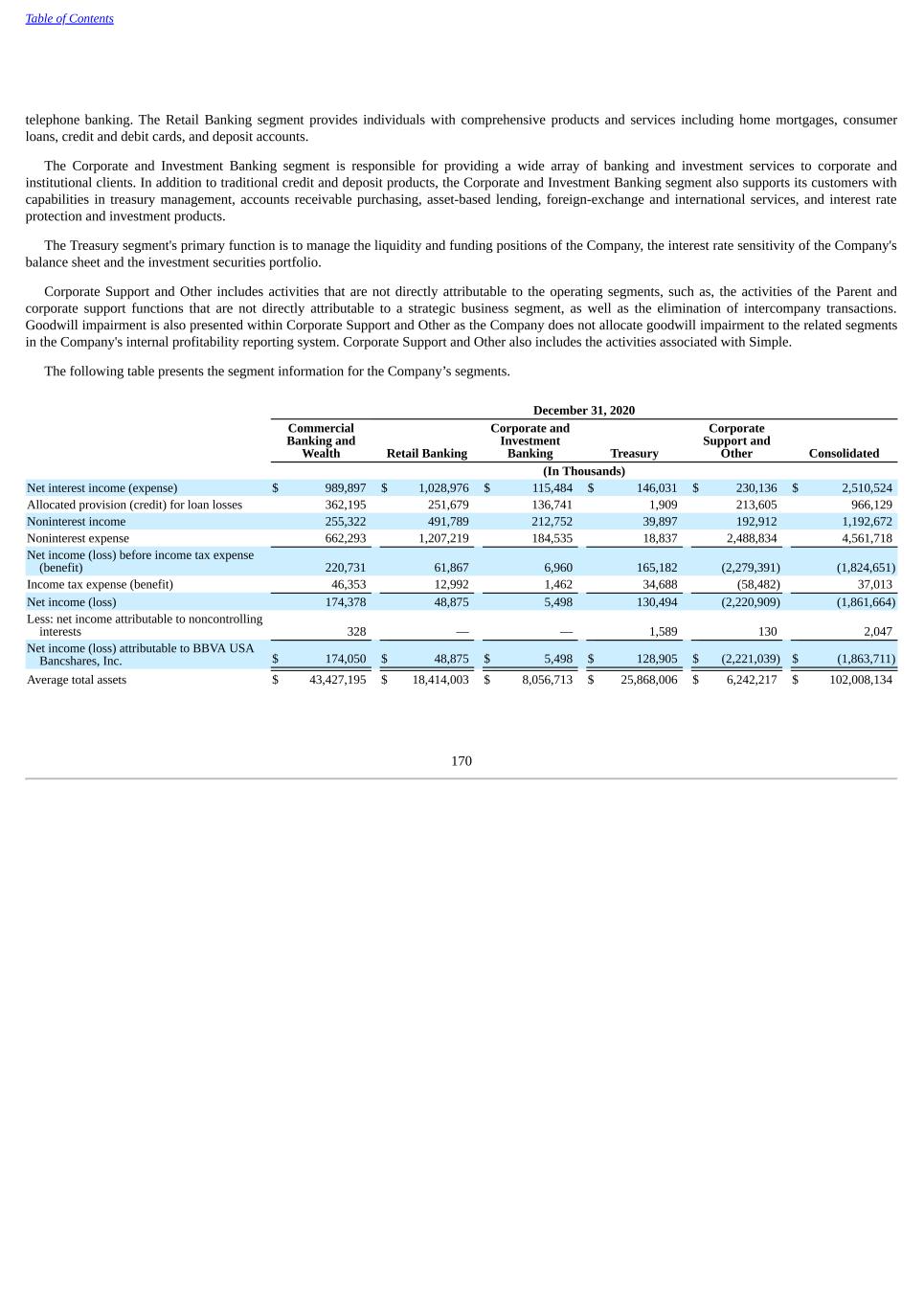
Table of Contents telephone banking. The Retail Banking segment provides individuals with comprehensive products and services including home mortgages, consumer loans, credit and debit cards, and deposit accounts. The Corporate and Investment Banking segment is responsible for providing a wide array of banking and investment services to corporate and institutional clients. In addition to traditional credit and deposit products, the Corporate and Investment Banking segment also supports its customers with capabilities in treasury management, accounts receivable purchasing, asset-based lending, foreign-exchange and international services, and interest rate protection and investment products. The Treasury segment's primary function is to manage the liquidity and funding positions of the Company, the interest rate sensitivity of the Company's balance sheet and the investment securities portfolio. Corporate Support and Other includes activities that are not directly attributable to the operating segments, such as, the activities of the Parent and corporate support functions that are not directly attributable to a strategic business segment, as well as the elimination of intercompany transactions. Goodwill impairment is also presented within Corporate Support and Other as the Company does not allocate goodwill impairment to the related segments in the Company's internal profitability reporting system. Corporate Support and Other also includes the activities associated with Simple. The following table presents the segment information for the Company’s segments. December 31, 2020 Commercial Banking and Wealth Retail Banking Corporate and Investment Banking Treasury Corporate Support and Other Consolidated (In Thousands) Net interest income (expense) $ 989,897 $ 1,028,976 $ 115,484 $ 146,031 $ 230,136 $ 2,510,524 Allocated provision (credit) for loan losses 362,195 251,679 136,741 1,909 213,605 966,129 Noninterest income 255,322 491,789 212,752 39,897 192,912 1,192,672 Noninterest expense 662,293 1,207,219 184,535 18,837 2,488,834 4,561,718 Net income (loss) before income tax expense (benefit) 220,731 61,867 6,960 165,182 (2,279,391) (1,824,651) Income tax expense (benefit) 46,353 12,992 1,462 34,688 (58,482) 37,013 Net income (loss) 174,378 48,875 5,498 130,494 (2,220,909) (1,861,664) Less: net income attributable to noncontrolling interests 328 — — 1,589 130 2,047 Net income (loss) attributable to BBVA USA Bancshares, Inc. $ 174,050 $ 48,875 $ 5,498 $ 128,905 $ (2,221,039) $ (1,863,711) Average total assets $ 43,427,195 $ 18,414,003 $ 8,056,713 $ 25,868,006 $ 6,242,217 $ 102,008,134 170
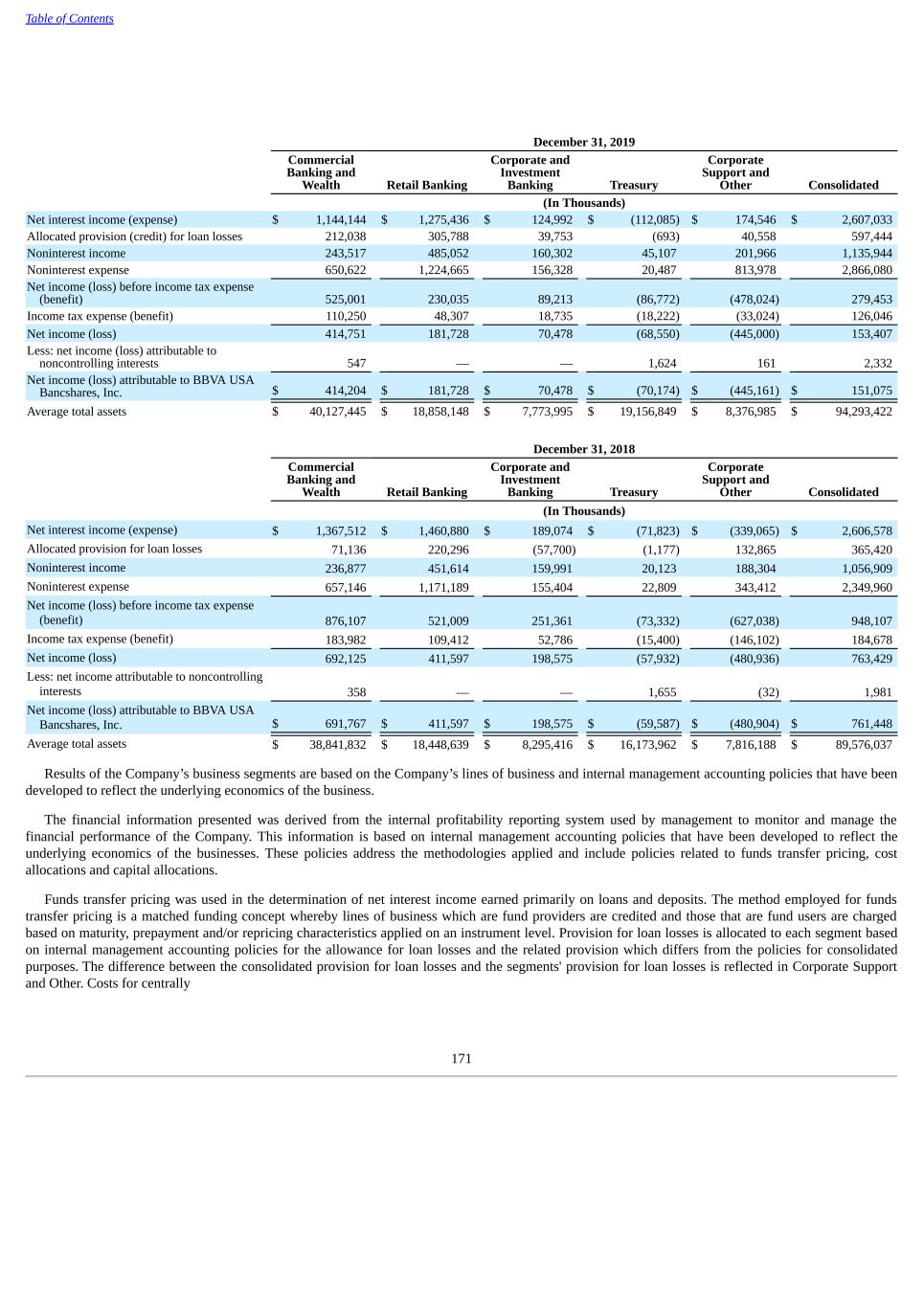
Table of Contents December 31, 2019 Commercial Banking and Wealth Retail Banking Corporate and Investment Banking Treasury Corporate Support and Other Consolidated (In Thousands) Net interest income (expense) $ 1,144,144 $ 1,275,436 $ 124,992 $ (112,085) $ 174,546 $ 2,607,033 Allocated provision (credit) for loan losses 212,038 305,788 39,753 (693) 40,558 597,444 Noninterest income 243,517 485,052 160,302 45,107 201,966 1,135,944 Noninterest expense 650,622 1,224,665 156,328 20,487 813,978 2,866,080 Net income (loss) before income tax expense (benefit) 525,001 230,035 89,213 (86,772) (478,024) 279,453 Income tax expense (benefit) 110,250 48,307 18,735 (18,222) (33,024) 126,046 Net income (loss) 414,751 181,728 70,478 (68,550) (445,000) 153,407 Less: net income (loss) attributable to noncontrolling interests 547 — — 1,624 161 2,332 Net income (loss) attributable to BBVA USA Bancshares, Inc. $ 414,204 $ 181,728 $ 70,478 $ (70,174) $ (445,161) $ 151,075 Average total assets $ 40,127,445 $ 18,858,148 $ 7,773,995 $ 19,156,849 $ 8,376,985 $ 94,293,422 December 31, 2018 Commercial Banking and Wealth Retail Banking Corporate and Investment Banking Treasury Corporate Support and Other Consolidated (In Thousands) Net interest income (expense) $ 1,367,512 $ 1,460,880 $ 189,074 $ (71,823) $ (339,065) $ 2,606,578 Allocated provision for loan losses 71,136 220,296 (57,700) (1,177) 132,865 365,420 Noninterest income 236,877 451,614 159,991 20,123 188,304 1,056,909 Noninterest expense 657,146 1,171,189 155,404 22,809 343,412 2,349,960 Net income (loss) before income tax expense (benefit) 876,107 521,009 251,361 (73,332) (627,038) 948,107 Income tax expense (benefit) 183,982 109,412 52,786 (15,400) (146,102) 184,678 Net income (loss) 692,125 411,597 198,575 (57,932) (480,936) 763,429 Less: net income attributable to noncontrolling interests 358 — — 1,655 (32) 1,981 Net income (loss) attributable to BBVA USA Bancshares, Inc. $ 691,767 $ 411,597 $ 198,575 $ (59,587) $ (480,904) $ 761,448 Average total assets $ 38,841,832 $ 18,448,639 $ 8,295,416 $ 16,173,962 $ 7,816,188 $ 89,576,037 Results of the Company’s business segments are based on the Company’s lines of business and internal management accounting policies that have been developed to reflect the underlying economics of the business. The financial information presented was derived from the internal profitability reporting system used by management to monitor and manage the financial performance of the Company. This information is based on internal management accounting policies that have been developed to reflect the underlying economics of the businesses. These policies address the methodologies applied and include policies related to funds transfer pricing, cost allocations and capital allocations. Funds transfer pricing was used in the determination of net interest income earned primarily on loans and deposits. The method employed for funds transfer pricing is a matched funding concept whereby lines of business which are fund providers are credited and those that are fund users are charged based on maturity, prepayment and/or repricing characteristics applied on an instrument level. Provision for loan losses is allocated to each segment based on internal management accounting policies for the allowance for loan losses and the related provision which differs from the policies for consolidated purposes. The difference between the consolidated provision for loan losses and the segments' provision for loan losses is reflected in Corporate Support and Other. Costs for centrally 171
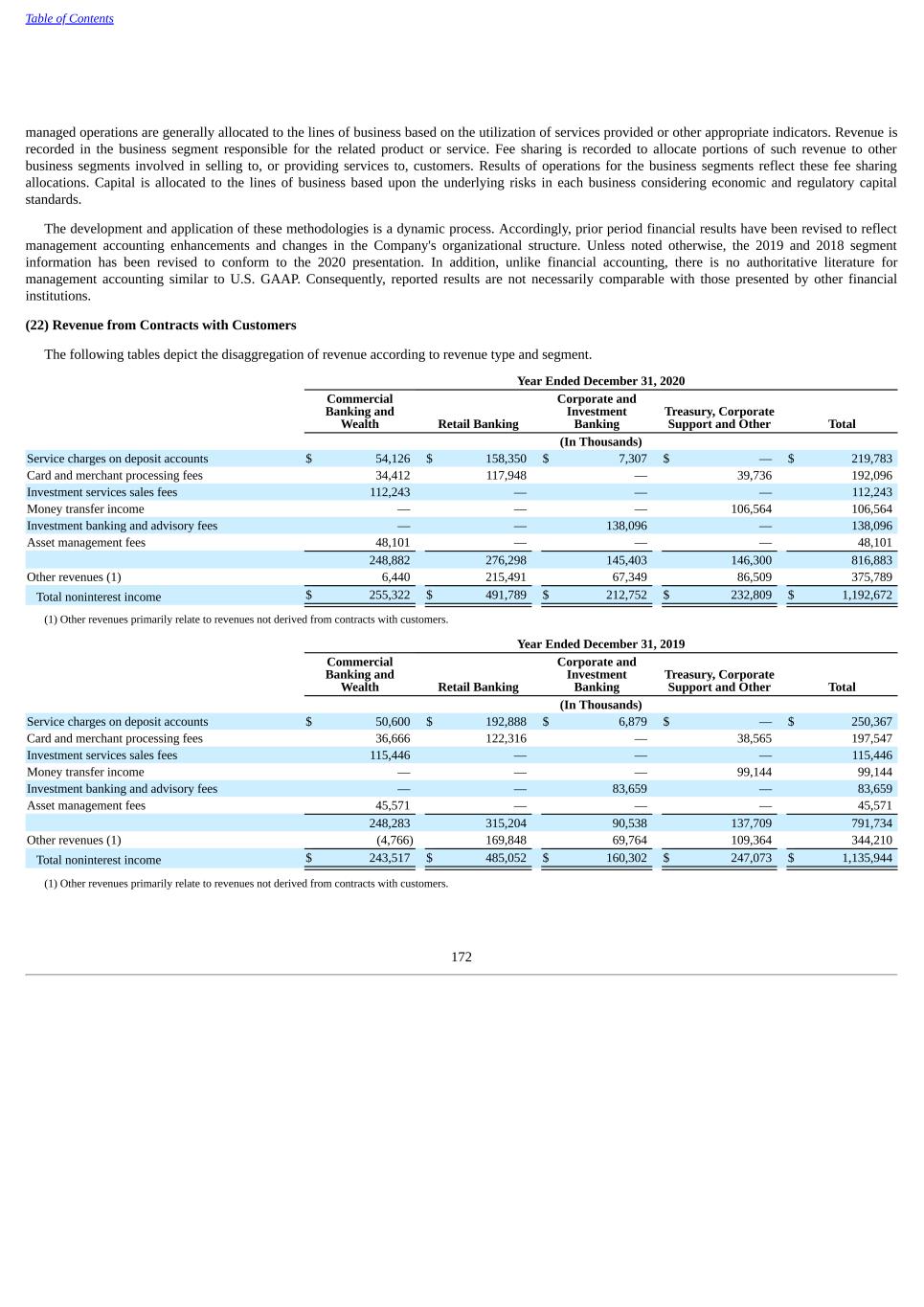
Table of Contents managed operations are generally allocated to the lines of business based on the utilization of services provided or other appropriate indicators. Revenue is recorded in the business segment responsible for the related product or service. Fee sharing is recorded to allocate portions of such revenue to other business segments involved in selling to, or providing services to, customers. Results of operations for the business segments reflect these fee sharing allocations. Capital is allocated to the lines of business based upon the underlying risks in each business considering economic and regulatory capital standards. The development and application of these methodologies is a dynamic process. Accordingly, prior period financial results have been revised to reflect management accounting enhancements and changes in the Company's organizational structure. Unless noted otherwise, the 2019 and 2018 segment information has been revised to conform to the 2020 presentation. In addition, unlike financial accounting, there is no authoritative literature for management accounting similar to U.S. GAAP. Consequently, reported results are not necessarily comparable with those presented by other financial institutions. (22) Revenue from Contracts with Customers The following tables depict the disaggregation of revenue according to revenue type and segment. Year Ended December 31, 2020 Commercial Banking and Wealth Retail Banking Corporate and Investment Banking Treasury, Corporate Support and Other Total (In Thousands) Service charges on deposit accounts $ 54,126 $ 158,350 $ 7,307 $ — $ 219,783 Card and merchant processing fees 34,412 117,948 — 39,736 192,096 Investment services sales fees 112,243 — — — 112,243 Money transfer income — — — 106,564 106,564 Investment banking and advisory fees — — 138,096 — 138,096 Asset management fees 48,101 — — — 48,101 248,882 276,298 145,403 146,300 816,883 Other revenues (1) 6,440 215,491 67,349 86,509 375,789 Total noninterest income $ 255,322 $ 491,789 $ 212,752 $ 232,809 $ 1,192,672 (1) Other revenues primarily relate to revenues not derived from contracts with customers. Year Ended December 31, 2019 Commercial Banking and Wealth Retail Banking Corporate and Investment Banking Treasury, Corporate Support and Other Total (In Thousands) Service charges on deposit accounts $ 50,600 $ 192,888 $ 6,879 $ — $ 250,367 Card and merchant processing fees 36,666 122,316 — 38,565 197,547 Investment services sales fees 115,446 — — — 115,446 Money transfer income — — — 99,144 99,144 Investment banking and advisory fees — — 83,659 — 83,659 Asset management fees 45,571 — — — 45,571 248,283 315,204 90,538 137,709 791,734 Other revenues (1) (4,766) 169,848 69,764 109,364 344,210 Total noninterest income $ 243,517 $ 485,052 $ 160,302 $ 247,073 $ 1,135,944 (1) Other revenues primarily relate to revenues not derived from contracts with customers. 172
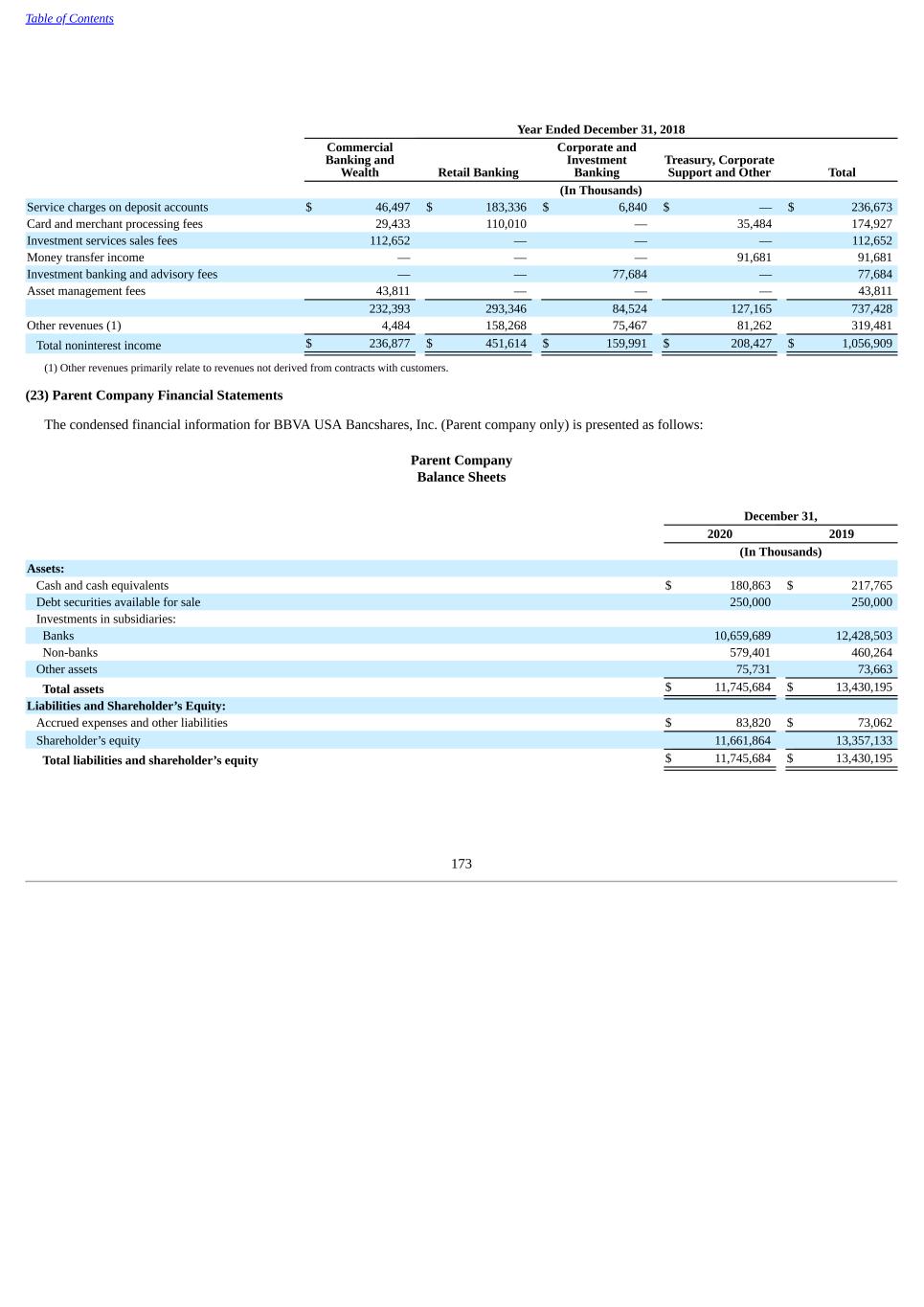
Table of Contents Year Ended December 31, 2018 Commercial Banking and Wealth Retail Banking Corporate and Investment Banking Treasury, Corporate Support and Other Total (In Thousands) Service charges on deposit accounts $ 46,497 $ 183,336 $ 6,840 $ — $ 236,673 Card and merchant processing fees 29,433 110,010 — 35,484 174,927 Investment services sales fees 112,652 — — — 112,652 Money transfer income — — — 91,681 91,681 Investment banking and advisory fees — — 77,684 — 77,684 Asset management fees 43,811 — — — 43,811 232,393 293,346 84,524 127,165 737,428 Other revenues (1) 4,484 158,268 75,467 81,262 319,481 Total noninterest income $ 236,877 $ 451,614 $ 159,991 $ 208,427 $ 1,056,909 (1) Other revenues primarily relate to revenues not derived from contracts with customers. (23) Parent Company Financial Statements The condensed financial information for BBVA USA Bancshares, Inc. (Parent company only) is presented as follows: Parent Company Balance Sheets December 31, 2020 2019 (In Thousands) Assets: Cash and cash equivalents $ 180,863 $ 217,765 Debt securities available for sale 250,000 250,000 Investments in subsidiaries: Banks 10,659,689 12,428,503 Non-banks 579,401 460,264 Other assets 75,731 73,663 Total assets $ 11,745,684 $ 13,430,195 Liabilities and Shareholder’s Equity: Accrued expenses and other liabilities $ 83,820 $ 73,062 Shareholder’s equity 11,661,864 13,357,133 Total liabilities and shareholder’s equity $ 11,745,684 $ 13,430,195 173

Table of Contents Parent Company Statements of Income Years Ended December 31, 2020 2019 2018 (In Thousands) Income: Dividends from banking subsidiaries $ — $ 445,000 $ 305,000 Dividends from non-bank subsidiaries — 13,356 — Other 16,443 5,320 7,731 Total income 16,443 463,676 312,731 Expense: Salaries and employee benefits 5,380 994 3,980 Other 8,312 12,840 8,781 Total expense 13,692 13,834 12,761 Income before income tax benefit and equity in undistributed earnings of subsidiaries 2,751 449,842 299,970 Income tax expense (benefit) 5,946 2,215 (1,255) (Loss) income before equity in undistributed earnings of subsidiaries (3,195) 447,627 301,225 Equity in undistributed (losses) earnings of subsidiaries (1,860,516) (296,552) 460,223 Net (loss) income $ (1,863,711) $ 151,075 $ 761,448 Other comprehensive income (1) 330,177 221,212 10,570 Comprehensive (loss) income $ (1,533,534) $ 372,287 $ 772,018 (1) See Consolidated Statement of Comprehensive Income detail. 174
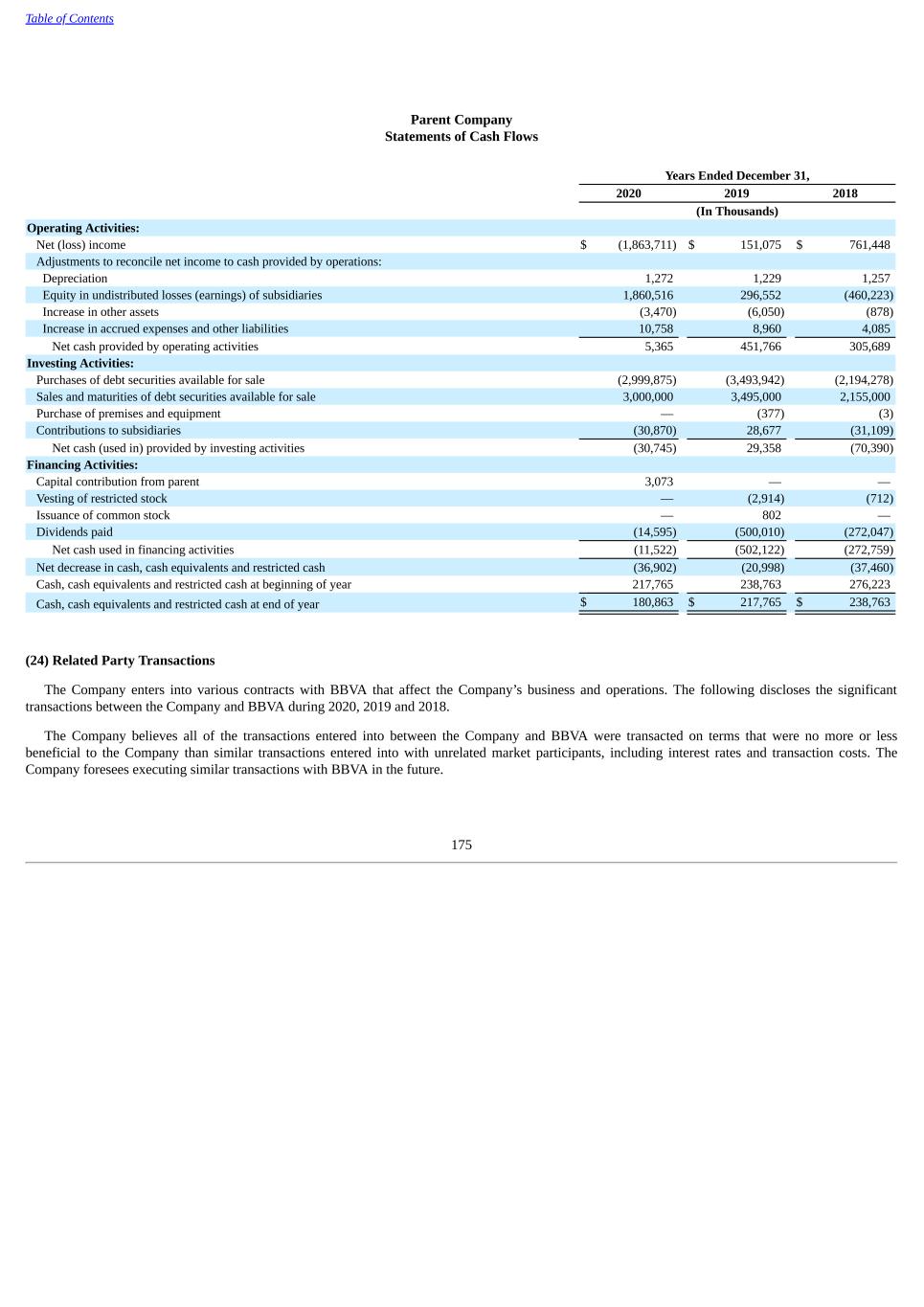
Table of Contents Parent Company Statements of Cash Flows Years Ended December 31, 2020 2019 2018 (In Thousands) Operating Activities: Net (loss) income $ (1,863,711) $ 151,075 $ 761,448 Adjustments to reconcile net income to cash provided by operations: Depreciation 1,272 1,229 1,257 Equity in undistributed losses (earnings) of subsidiaries 1,860,516 296,552 (460,223) Increase in other assets (3,470) (6,050) (878) Increase in accrued expenses and other liabilities 10,758 8,960 4,085 Net cash provided by operating activities 5,365 451,766 305,689 Investing Activities: Purchases of debt securities available for sale (2,999,875) (3,493,942) (2,194,278) Sales and maturities of debt securities available for sale 3,000,000 3,495,000 2,155,000 Purchase of premises and equipment — (377) (3) Contributions to subsidiaries (30,870) 28,677 (31,109) Net cash (used in) provided by investing activities (30,745) 29,358 (70,390) Financing Activities: Capital contribution from parent 3,073 — — Vesting of restricted stock — (2,914) (712) Issuance of common stock — 802 — Dividends paid (14,595) (500,010) (272,047) Net cash used in financing activities (11,522) (502,122) (272,759) Net decrease in cash, cash equivalents and restricted cash (36,902) (20,998) (37,460) Cash, cash equivalents and restricted cash at beginning of year 217,765 238,763 276,223 Cash, cash equivalents and restricted cash at end of year $ 180,863 $ 217,765 $ 238,763 (24) Related Party Transactions The Company enters into various contracts with BBVA that affect the Company’s business and operations. The following discloses the significant transactions between the Company and BBVA during 2020, 2019 and 2018. The Company believes all of the transactions entered into between the Company and BBVA were transacted on terms that were no more or less beneficial to the Company than similar transactions entered into with unrelated market participants, including interest rates and transaction costs. The Company foresees executing similar transactions with BBVA in the future. 175

Table of Contents Derivatives The Company has entered into various derivative contracts as noted below with BBVA as the upstream counterparty. The total notional amount of outstanding derivative contracts between the Company and BBVA are $3.2 billion and $3.4 billion as of December 31, 2020 and 2019, respectively. The net fair value of outstanding derivative contracts between the Company and BBVA are detailed below. December 31, 2020 2019 (In Thousands) Derivative contracts: Fair value hedges $ (748) $ (354) Cash flow hedges (19) 102 Free-standing derivative instruments not designated as hedging instruments (44,958) (9,688) Securities Purchased Under Agreements to Resell/Securities Sold Under Agreements to Repurchase The Company enters into agreements with BBVA as the counterparty under which it purchases/sells securities subject to an obligation to resell/repurchase the same or similar securities. The following represents the amount of securities purchased under agreements to resell and securities sold under agreements to repurchase where BBVA is the counterparty. December 31, 2020 2019 (In Thousands) Securities purchased under agreements to resell $ 186,568 $ 178,914 Securities sold under agreements to repurchase 6,426 16,596 Borrowings BSI, a wholly owned subsidiary of the Company, had a $420 million revolving note and cash subordination agreement with BBVA that was executed on March 16, 2012 with an original maturity date of March 16, 2018. On March 16, 2017, the agreement was amended to increase the available amount to $450 million and the maturity date was extended to March 16, 2023. On March 16, 2017, BSI entered into an uncommitted demand facility agreement with BBVA for a revolving loan facility up to $1 billion to be used for trade settlement purposes. BSI has not drawn against this facility in 2020. At both December 31, 2020 and December 31, 2019 there was no amount outstanding under the revolving note and cash subordination agreement. Interest expense related to these agreements was $99 thousand, $50 thousand, and $309 thousand for the years ended December 31, 2020, 2019 and 2018, respectively, and are included in interest on other short term borrowings within the Company's Consolidated Statements of Income. Service and Referral Agreements The Company and its affiliates entered into or were subject to various service and referral agreements with BBVA and its affiliates. Each of the agreements was done in the ordinary course of business and on market terms. Income associated with these agreements was $17.7 million, $30.1 million, and $49.7 million for the years ended December 31, 2020, 2019 and 2018, respectively, and is recorded as a component of noninterest income within the Company's Consolidated Statements of Income. Expenses associated with these agreements were $48.9 million, $38.6 million, and $31.5 million for the years ended December 31, 2020, 2019 and 2018, respectively, and are recorded as a component of noninterest expense within the Company's Consolidated Statements of Income. 176
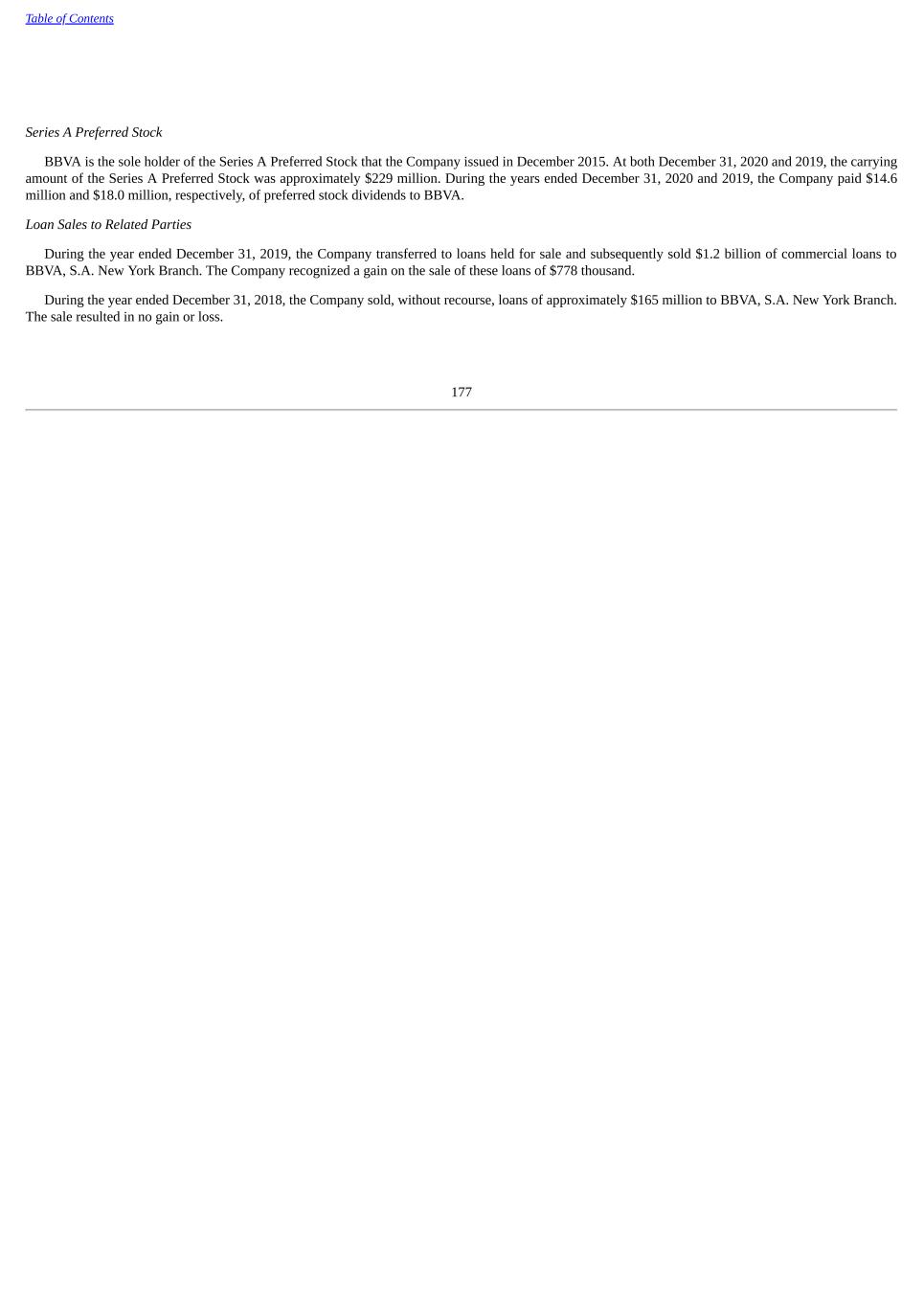
Table of Contents Series A Preferred Stock BBVA is the sole holder of the Series A Preferred Stock that the Company issued in December 2015. At both December 31, 2020 and 2019, the carrying amount of the Series A Preferred Stock was approximately $229 million. During the years ended December 31, 2020 and 2019, the Company paid $14.6 million and $18.0 million, respectively, of preferred stock dividends to BBVA. Loan Sales to Related Parties During the year ended December 31, 2019, the Company transferred to loans held for sale and subsequently sold $1.2 billion of commercial loans to BBVA, S.A. New York Branch. The Company recognized a gain on the sale of these loans of $778 thousand. During the year ended December 31, 2018, the Company sold, without recourse, loans of approximately $165 million to BBVA, S.A. New York Branch. The sale resulted in no gain or loss. 177